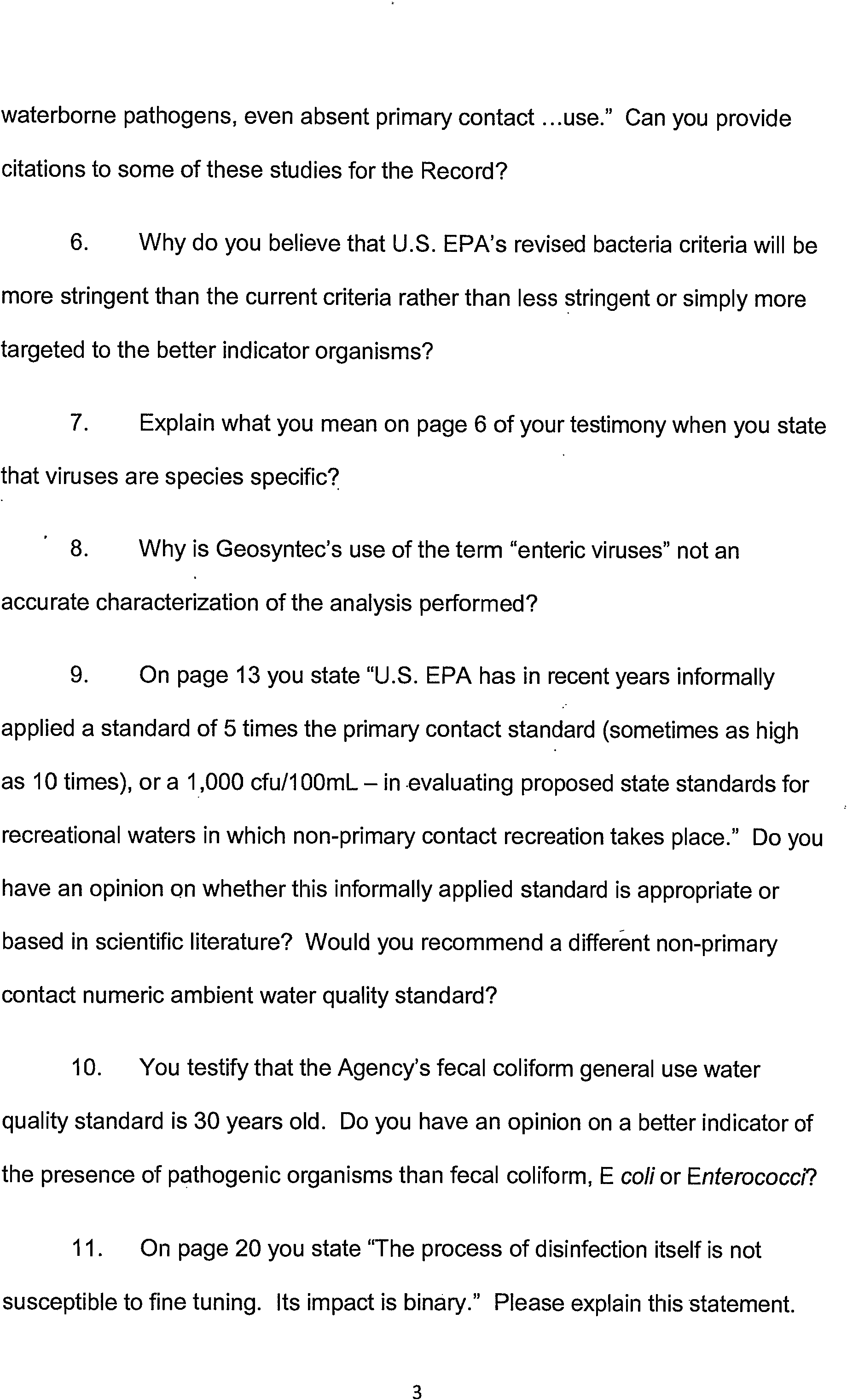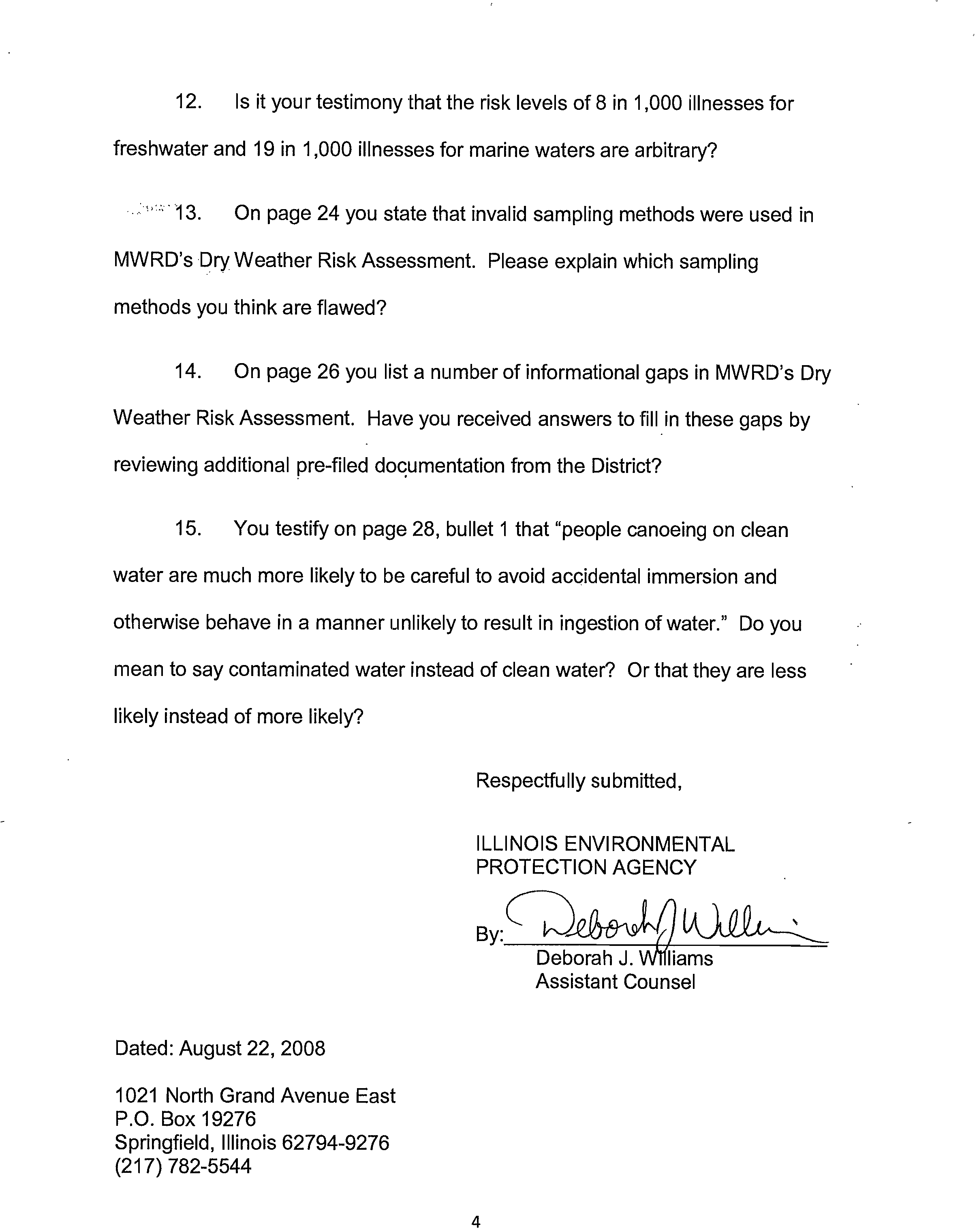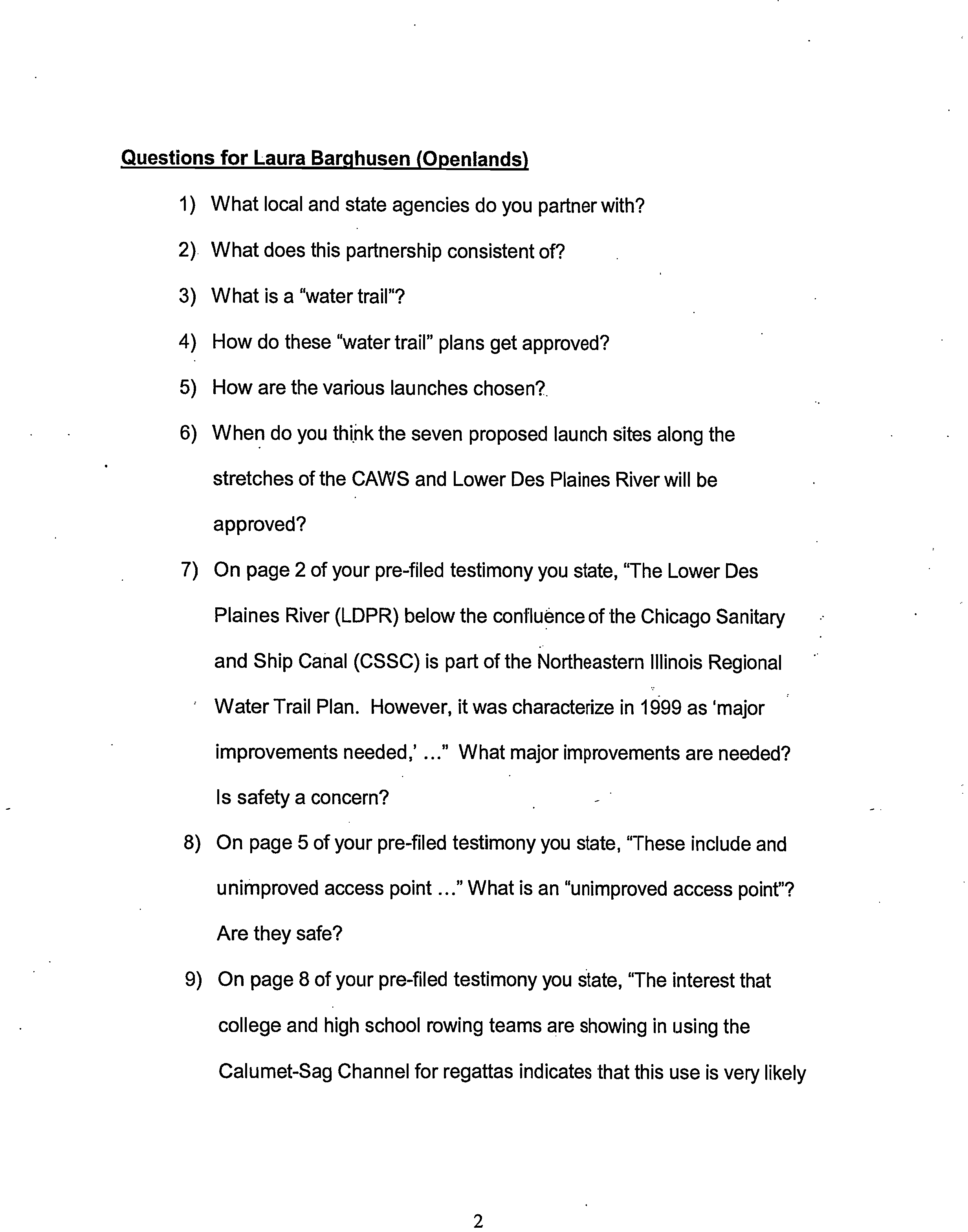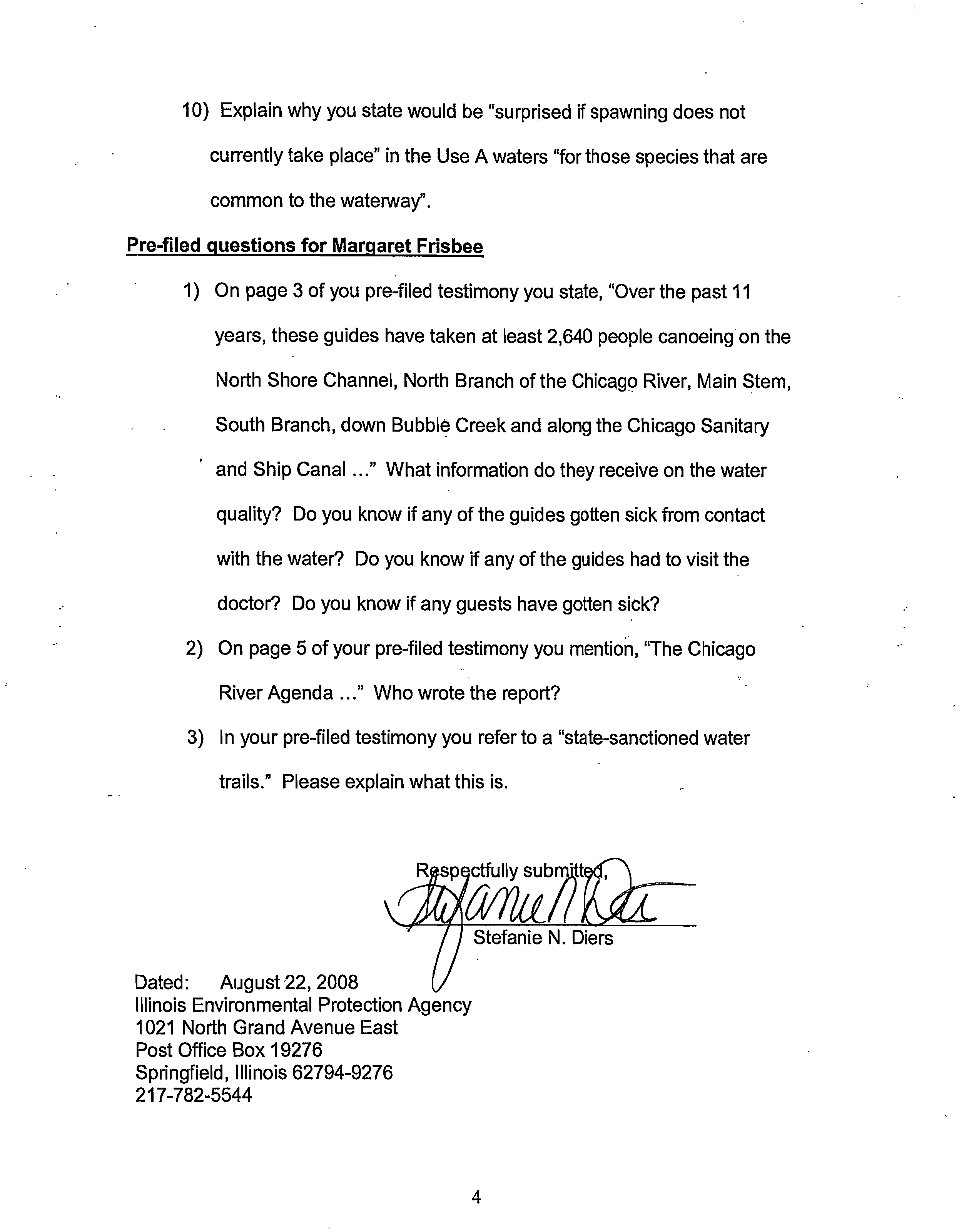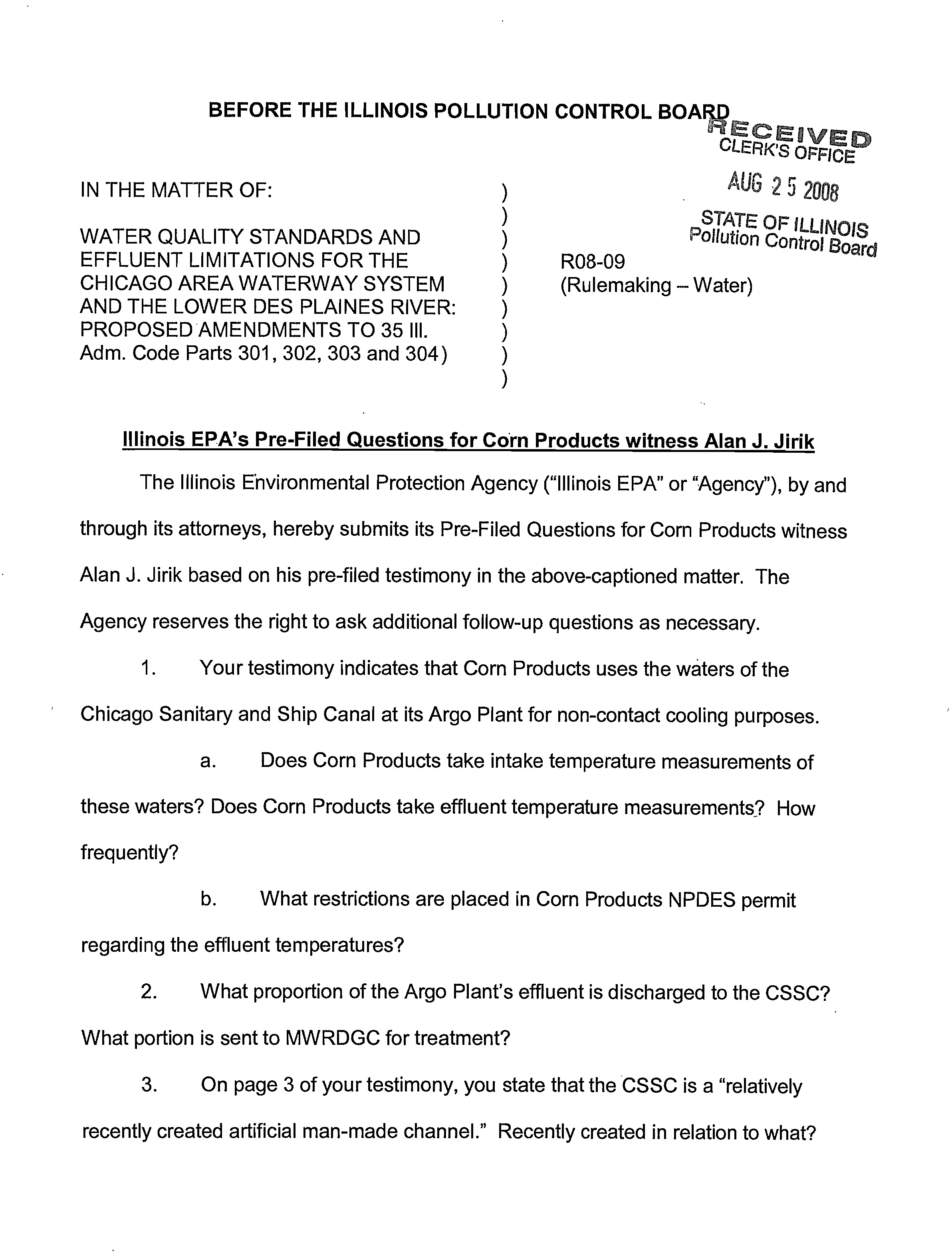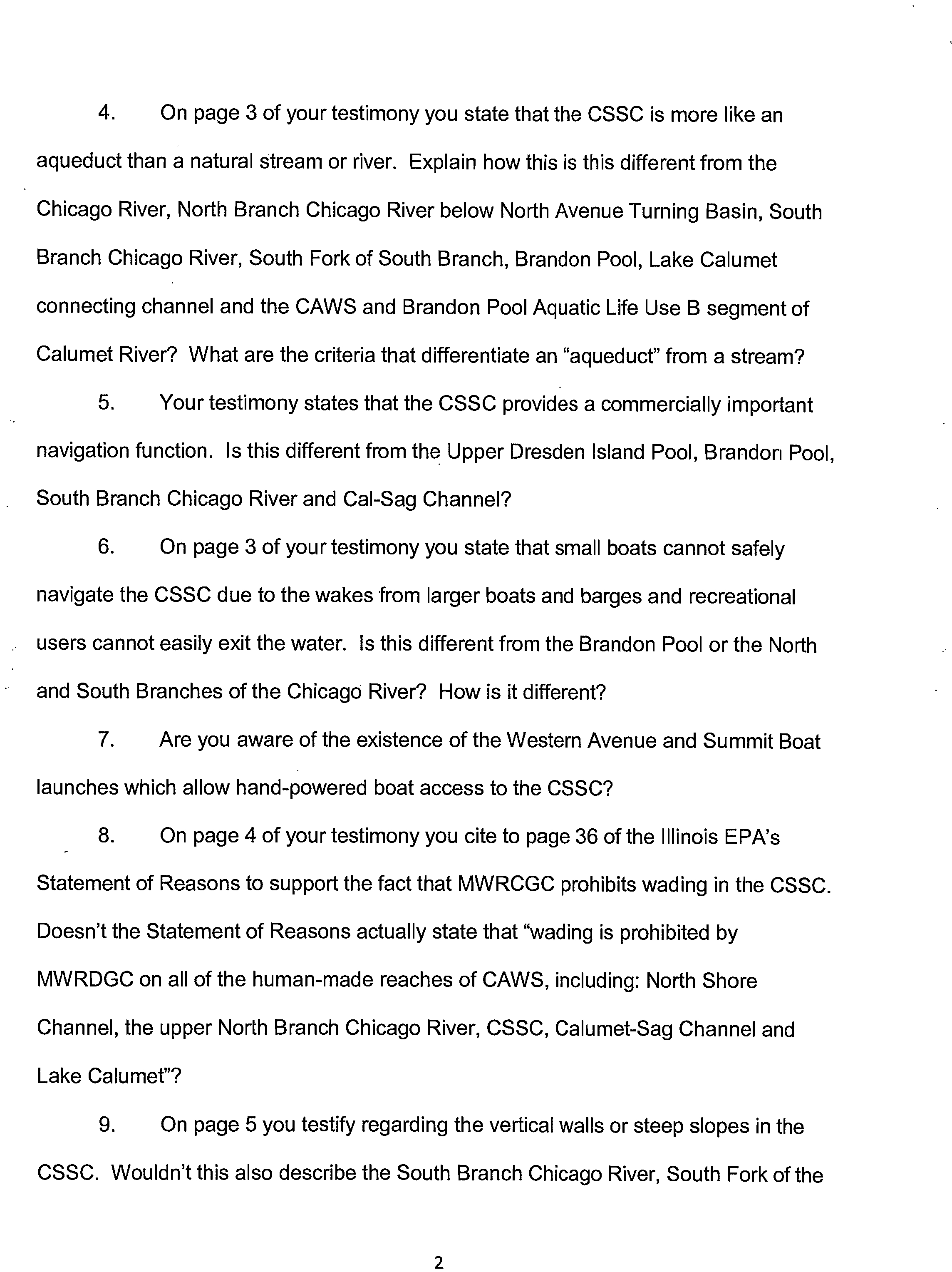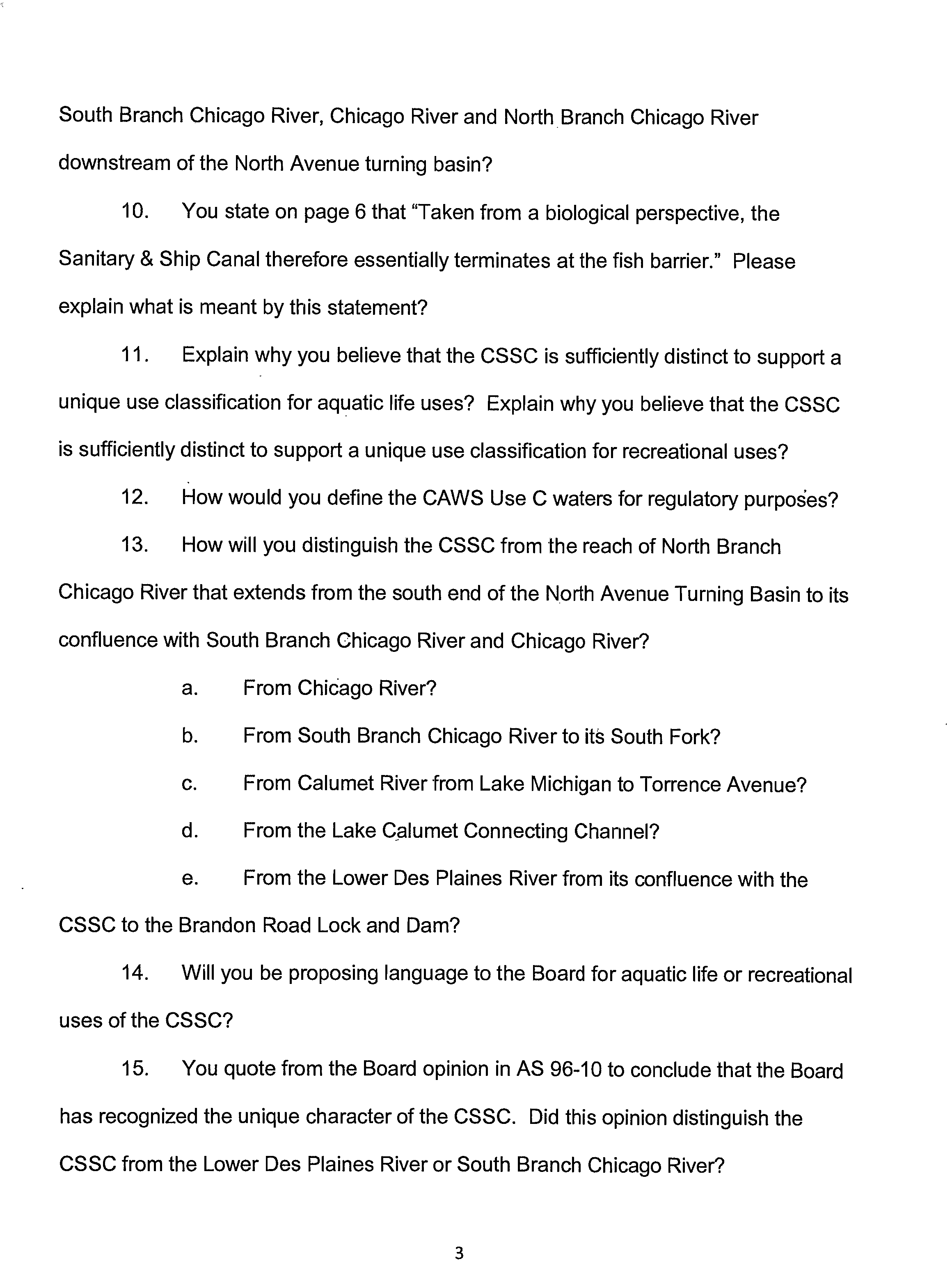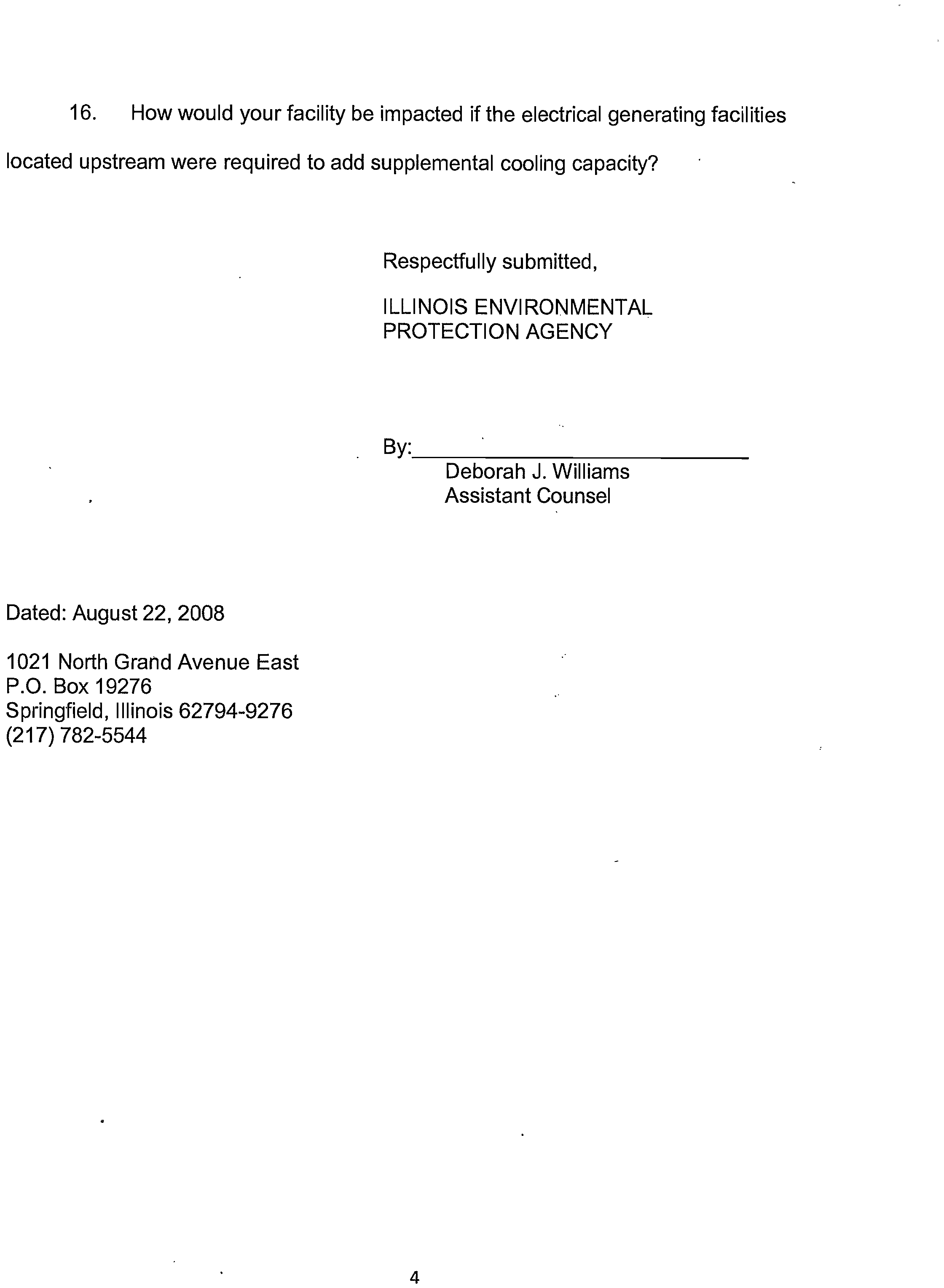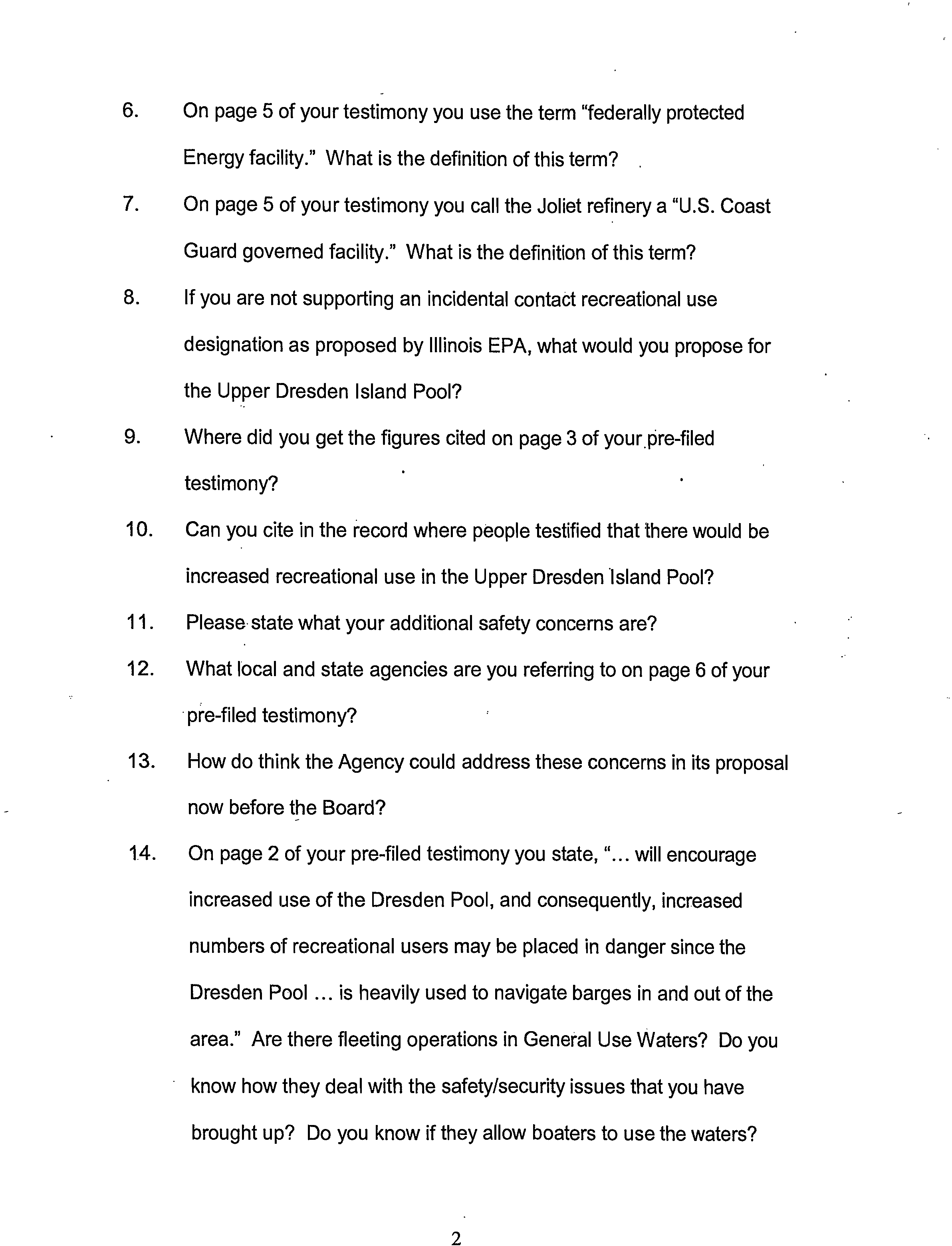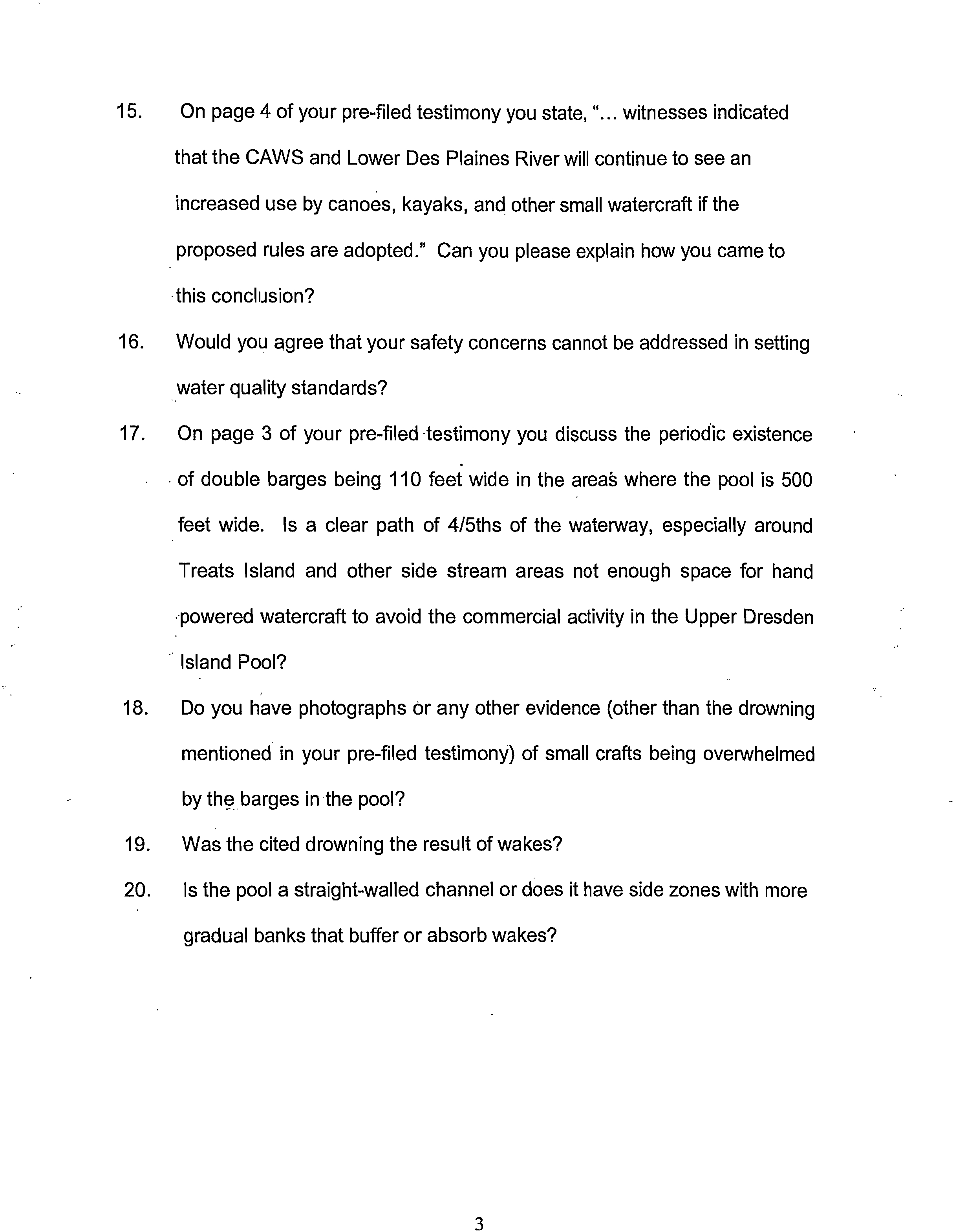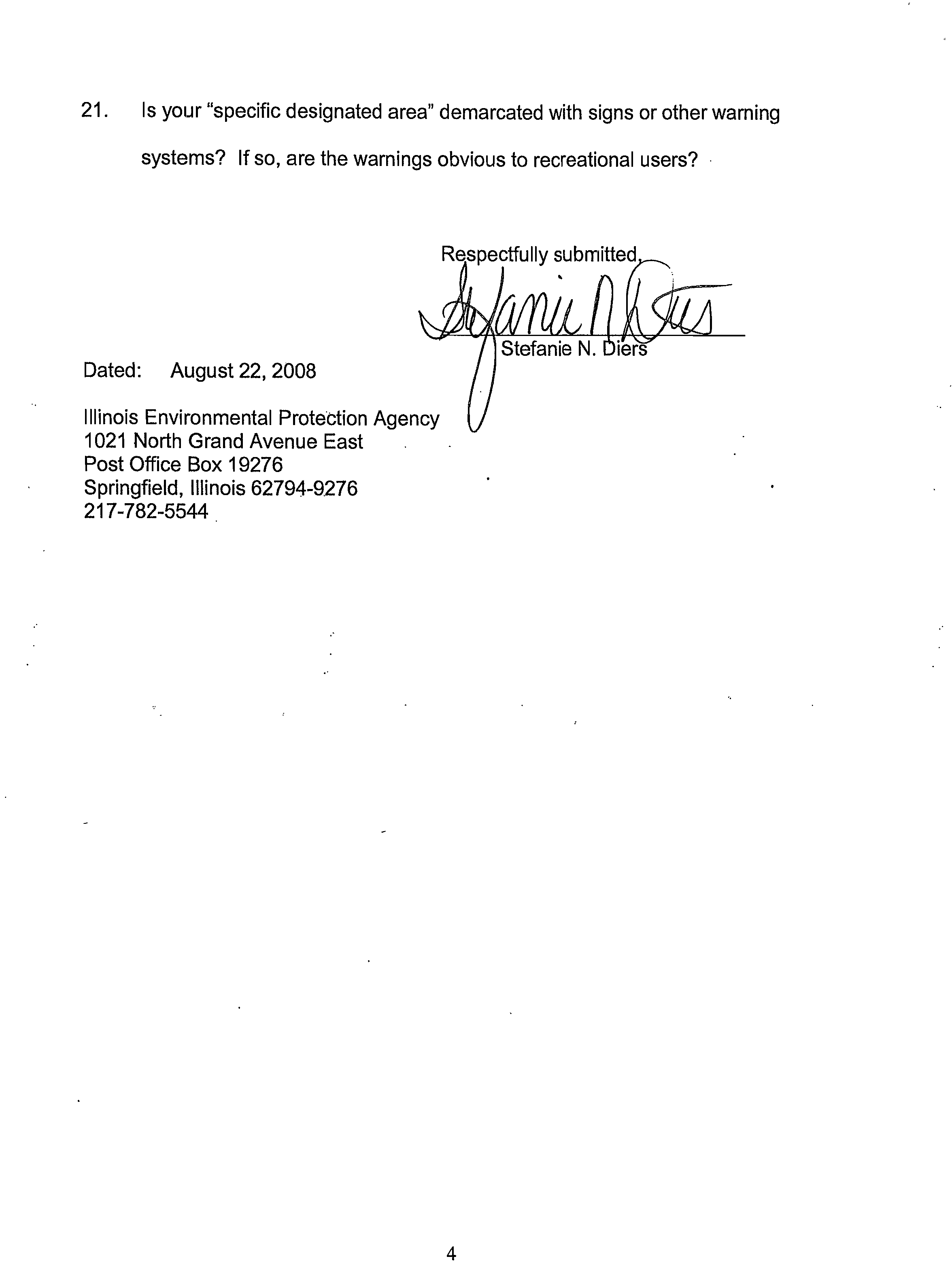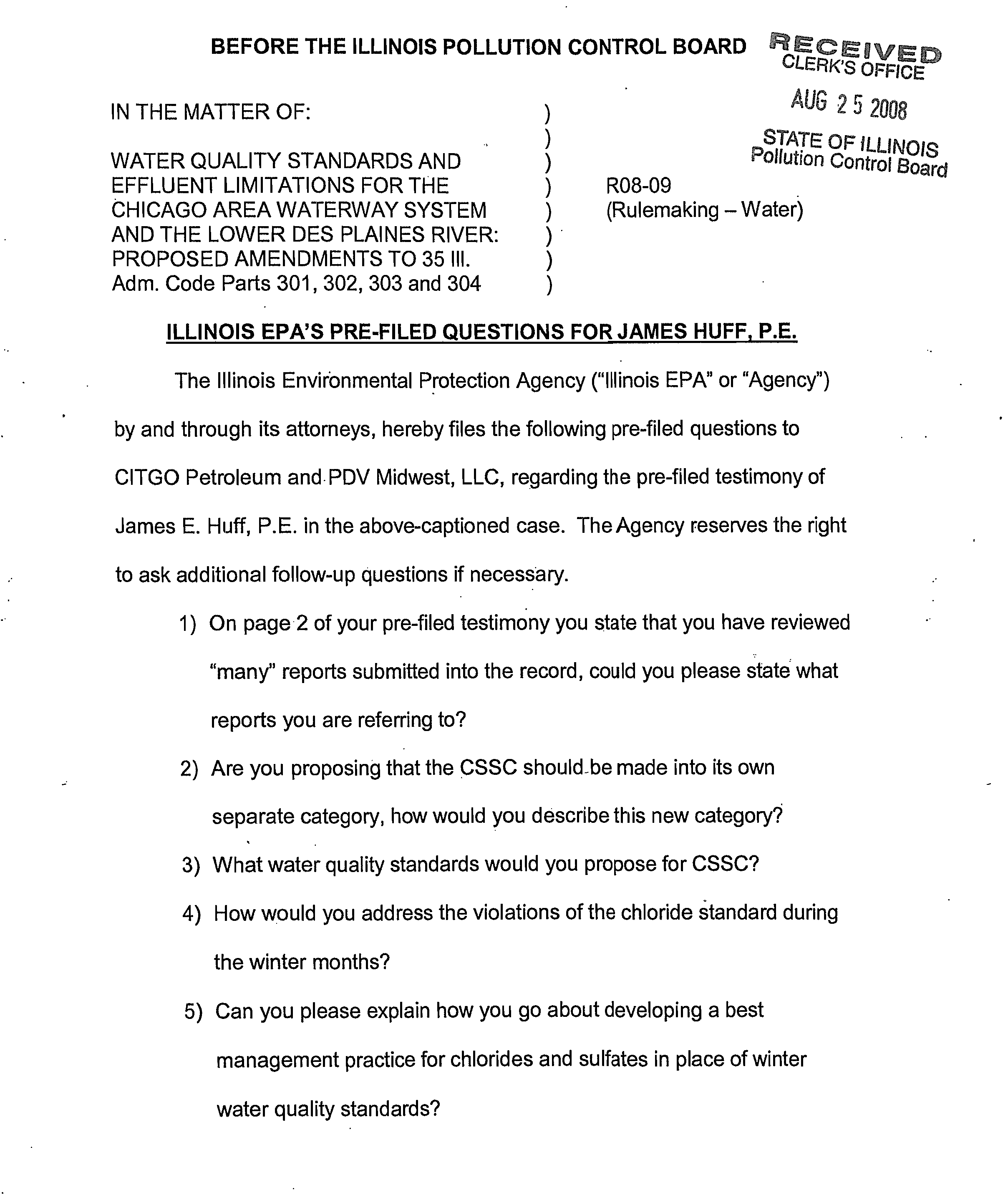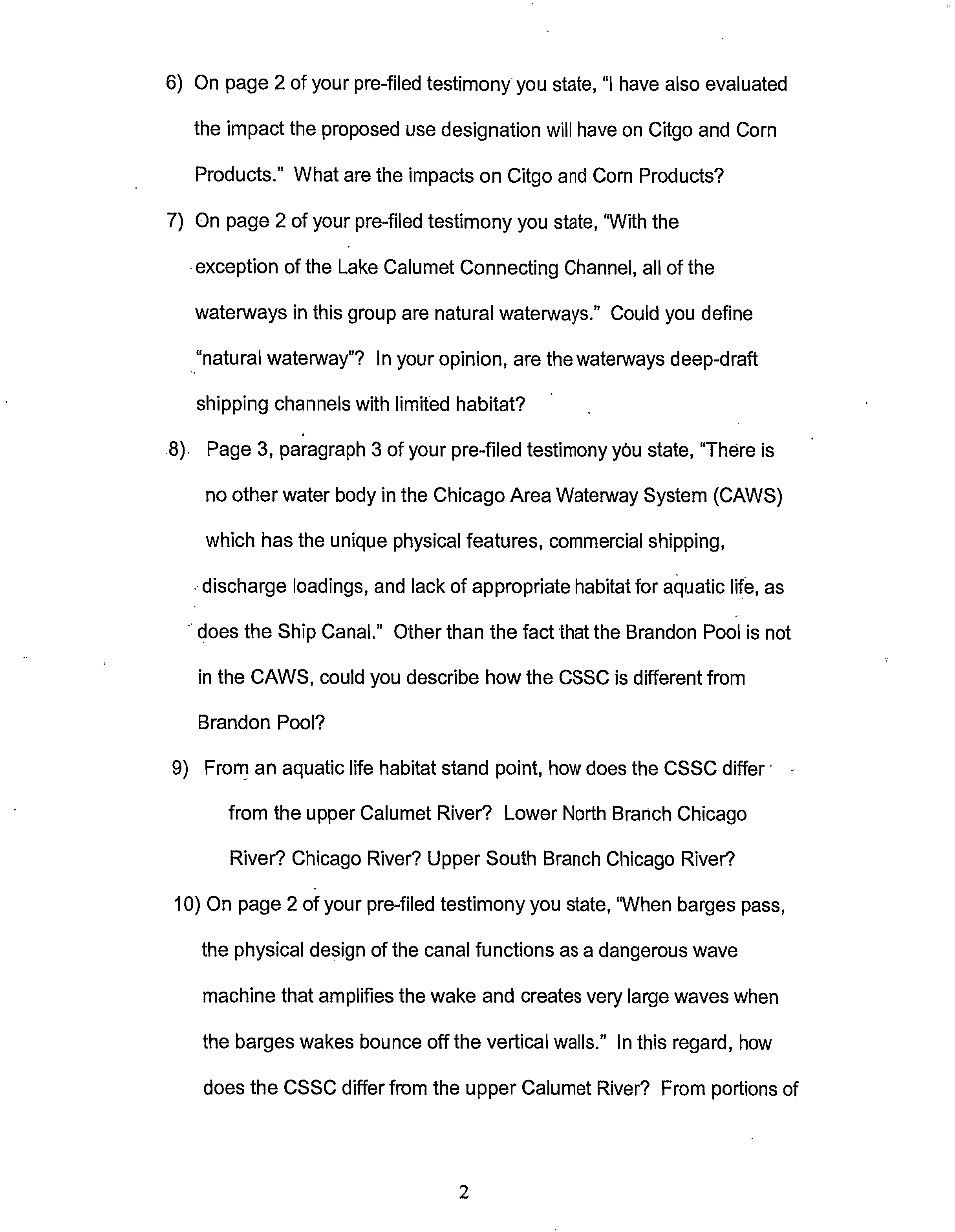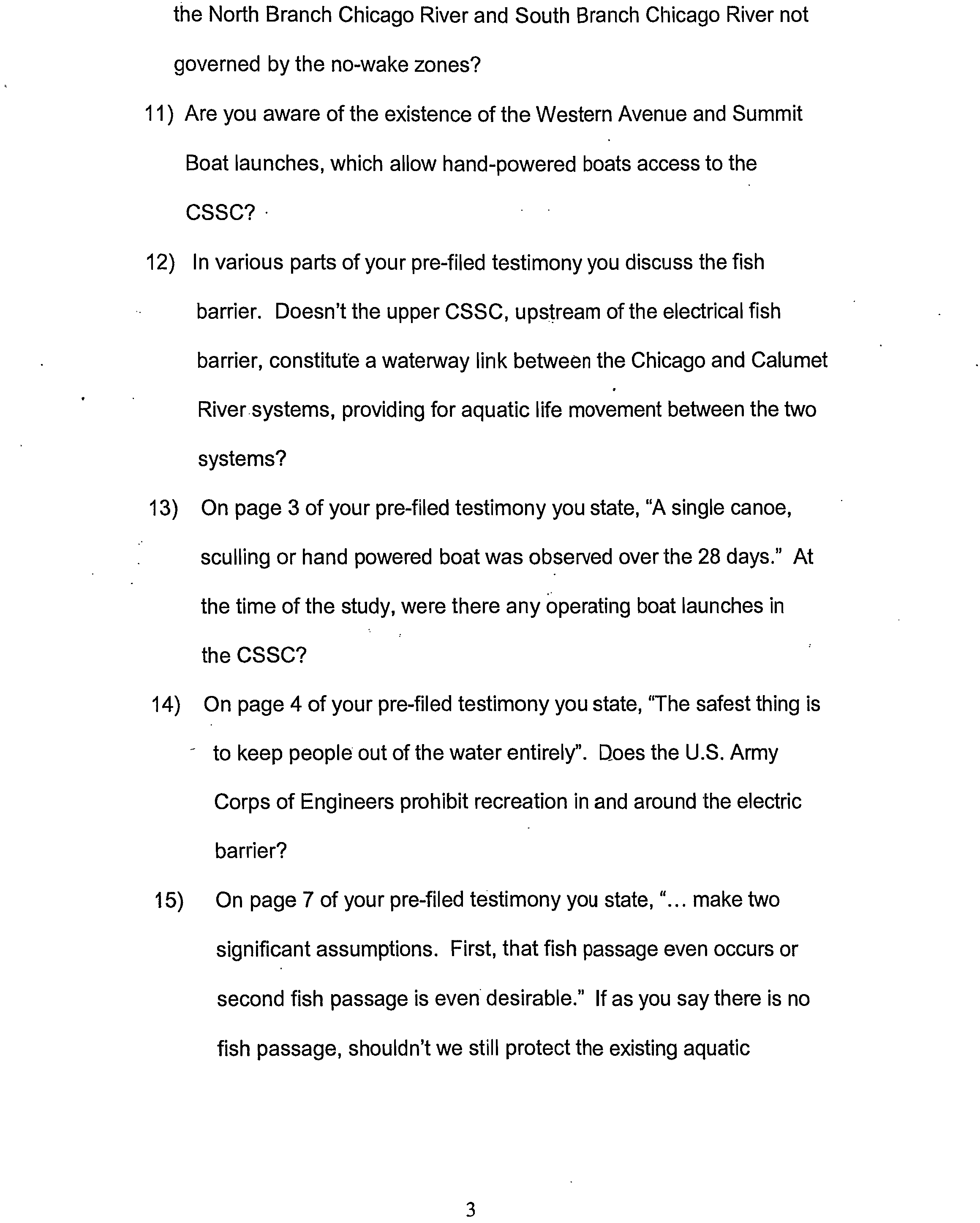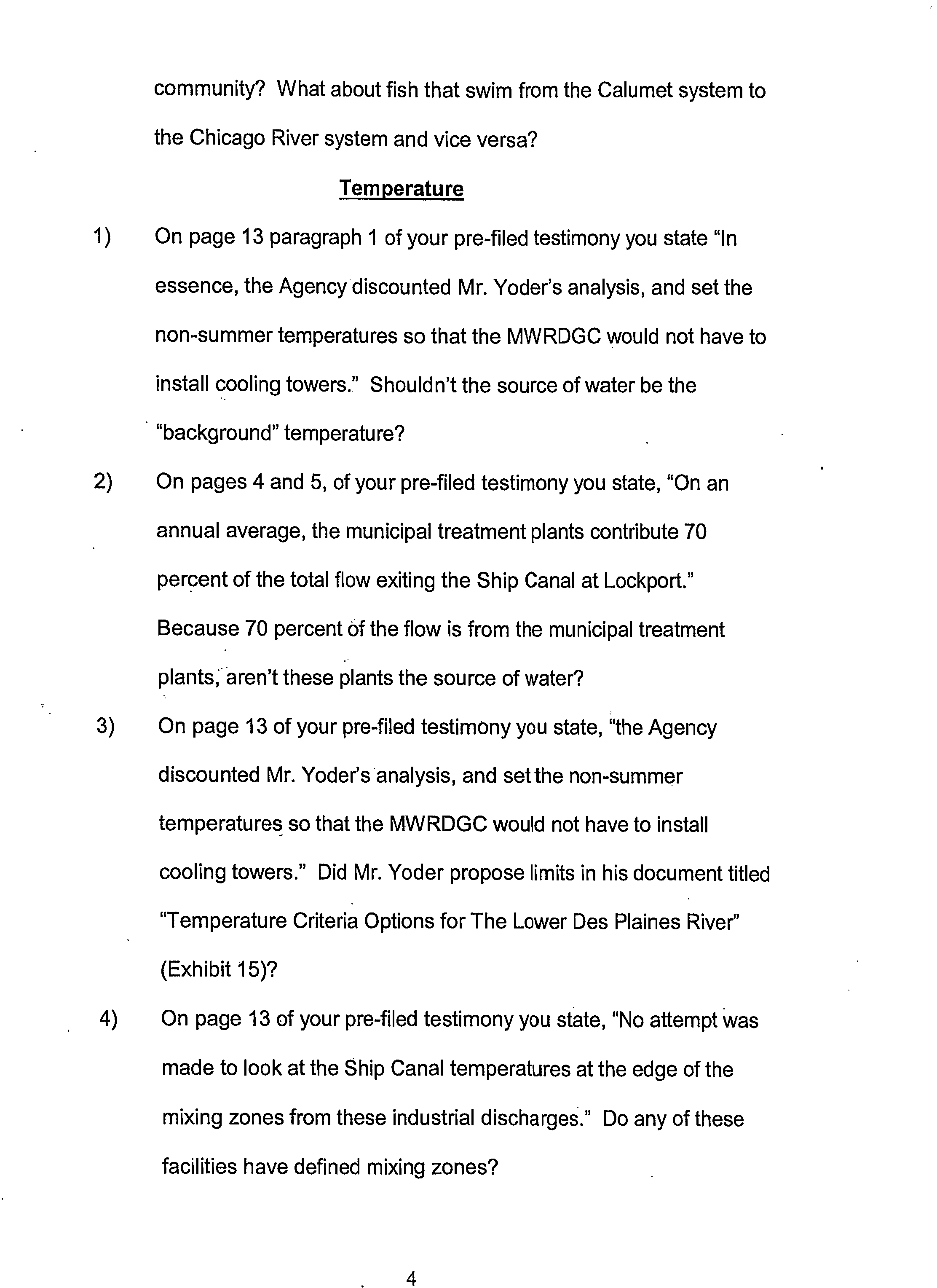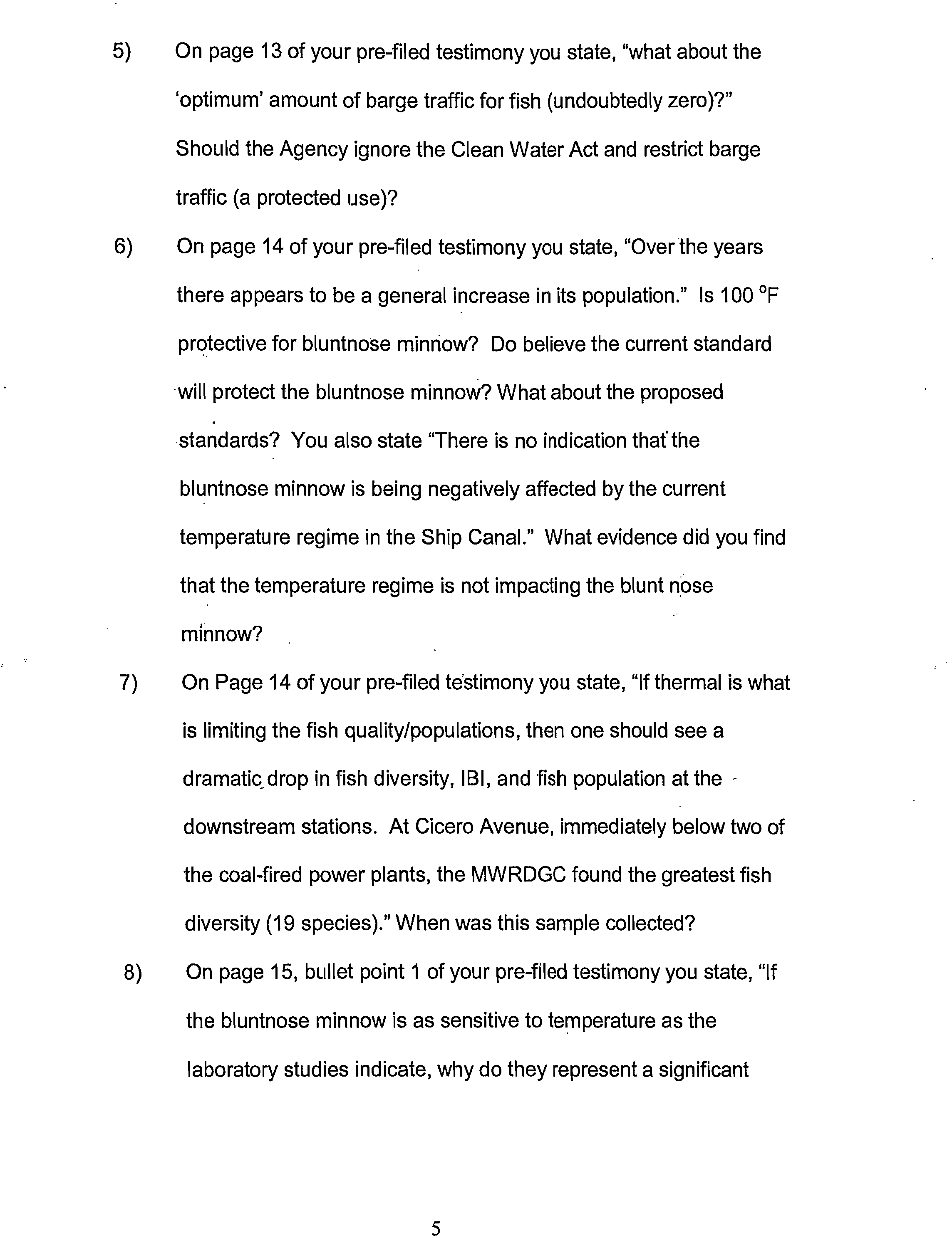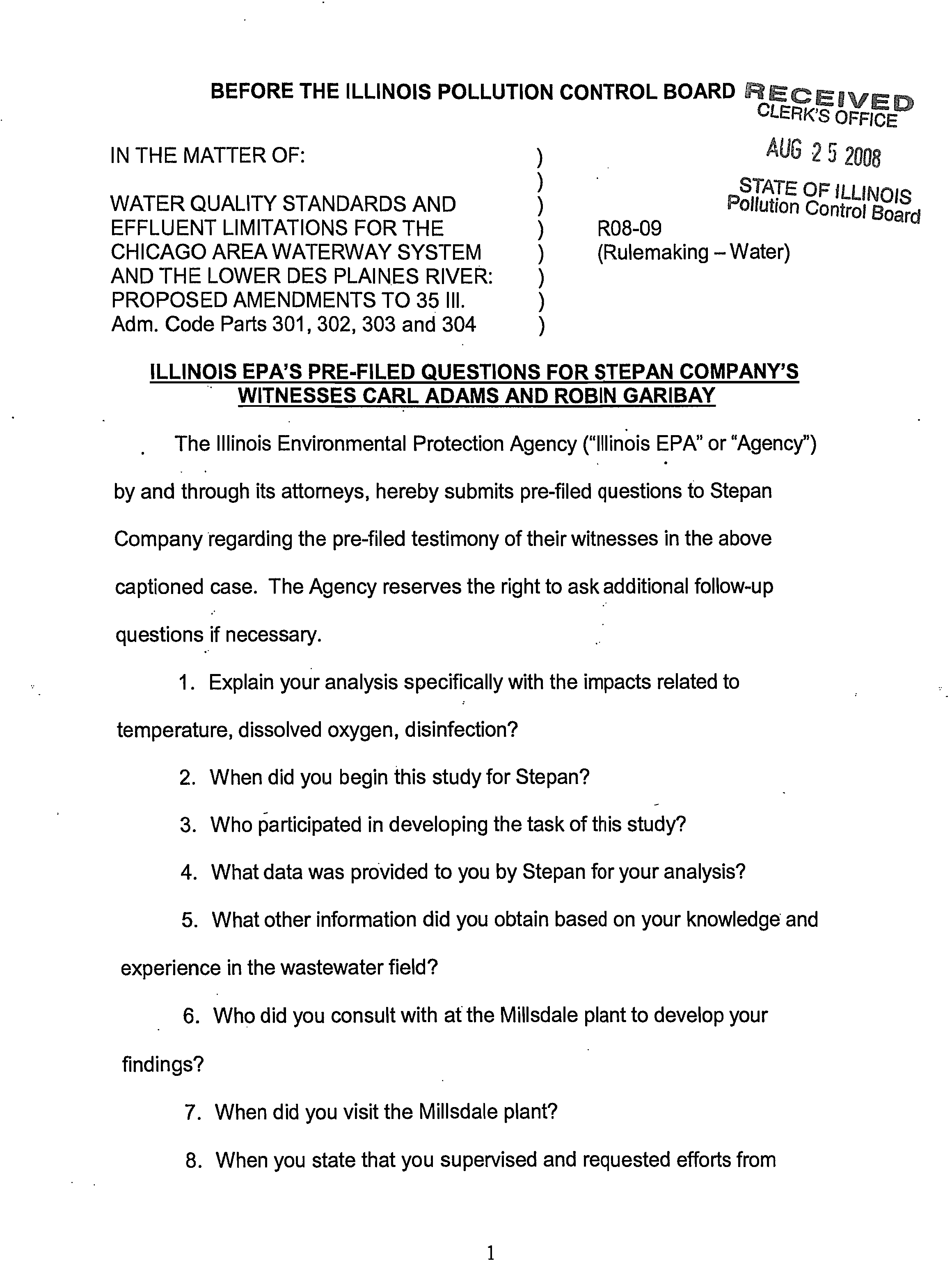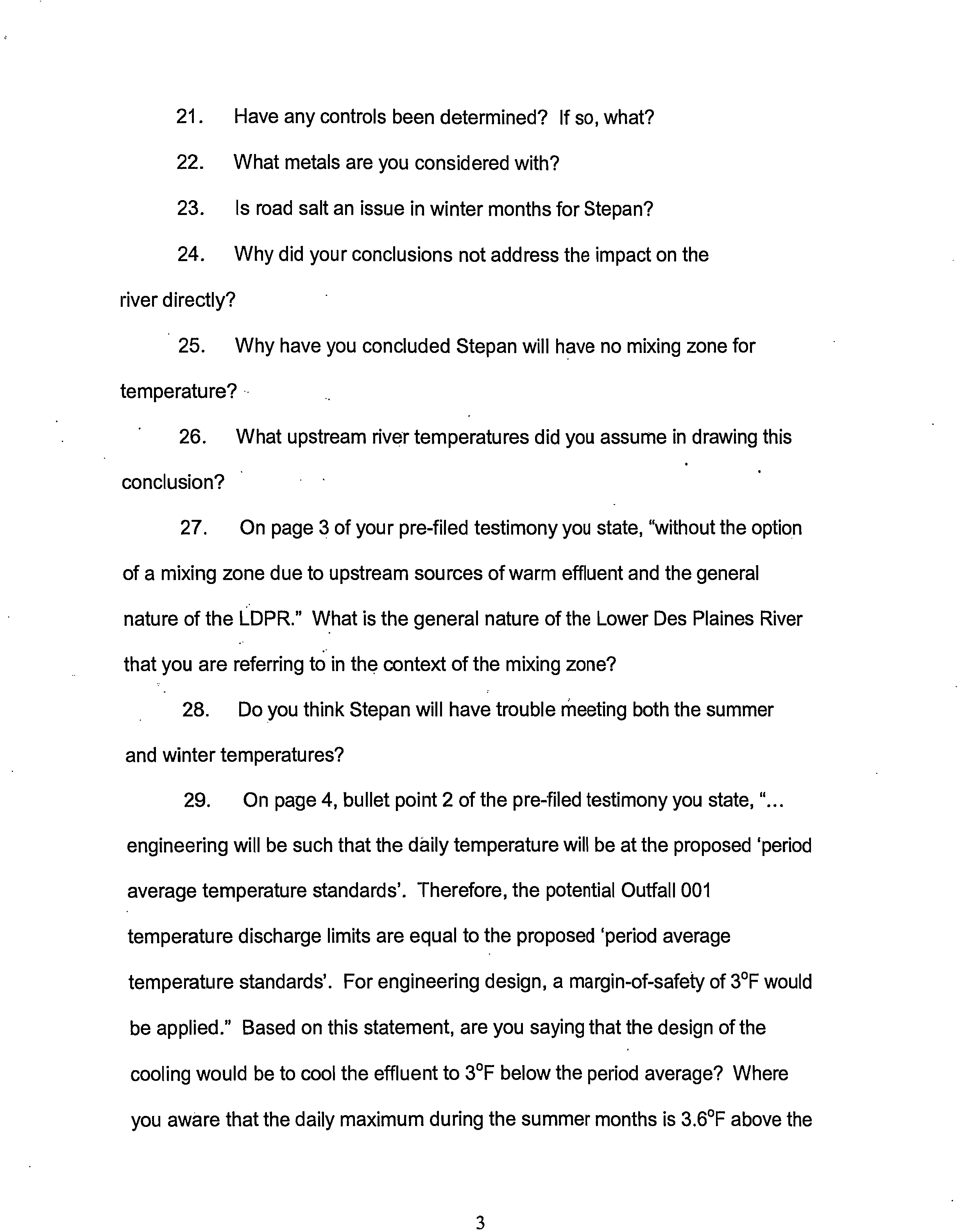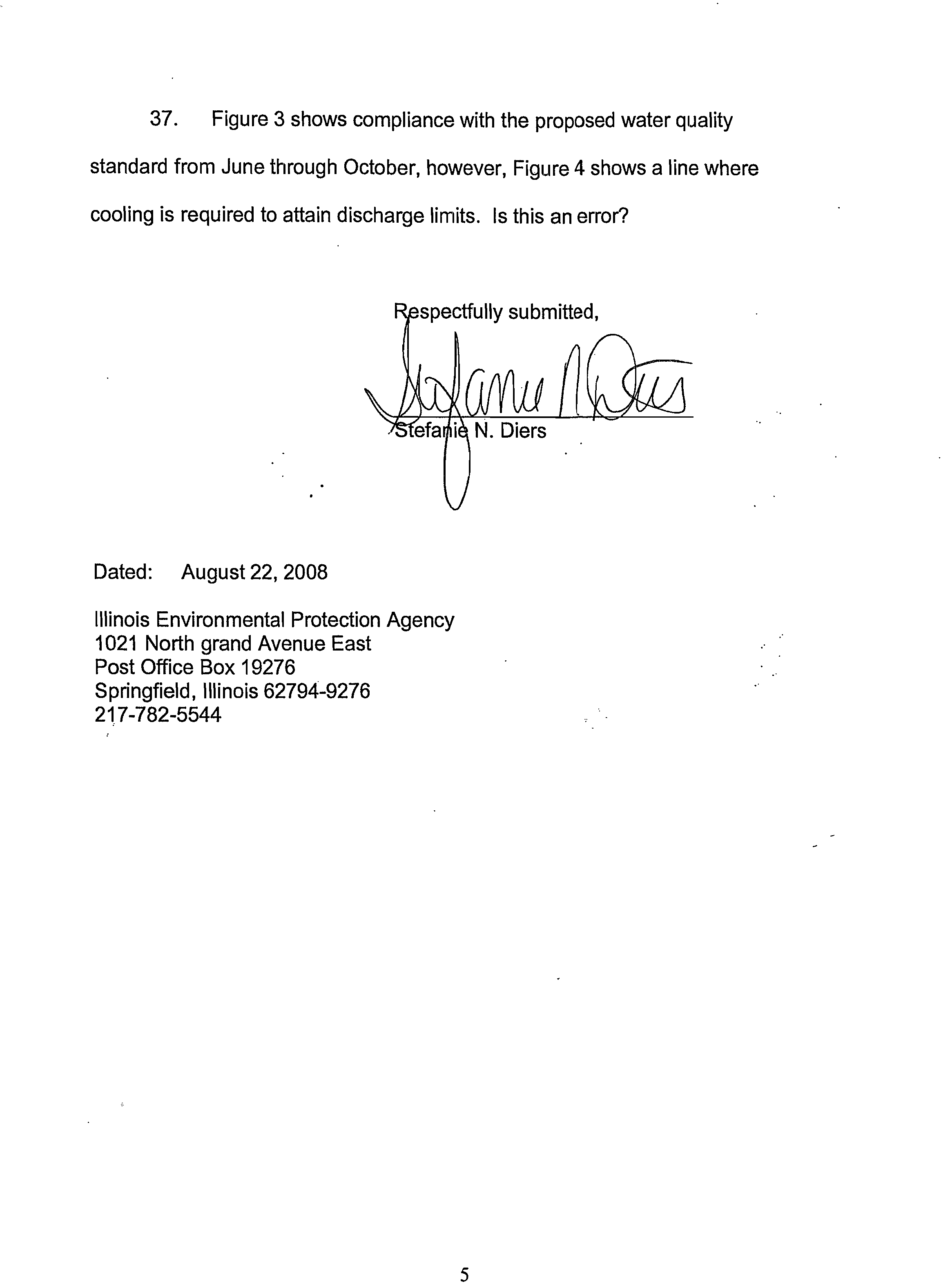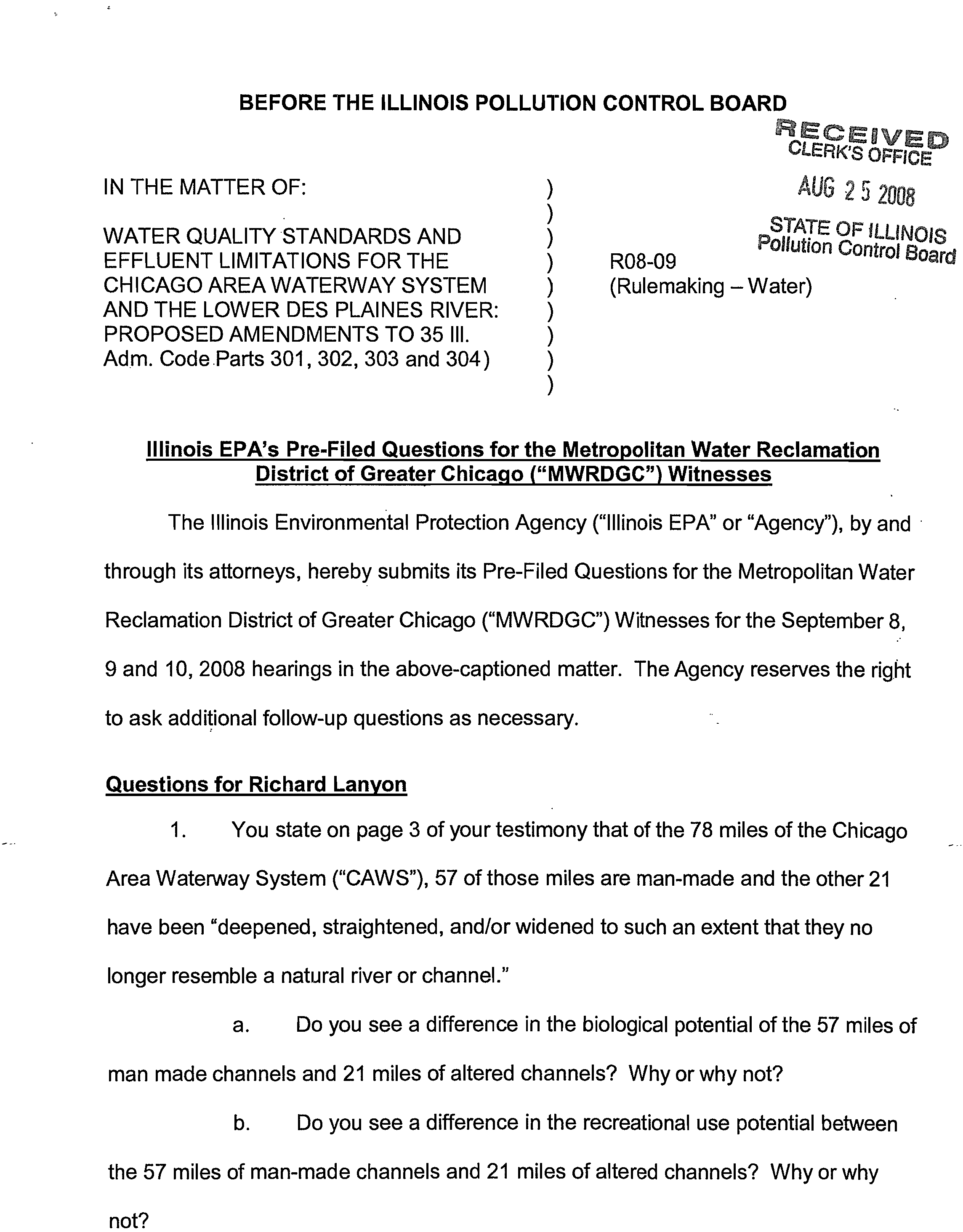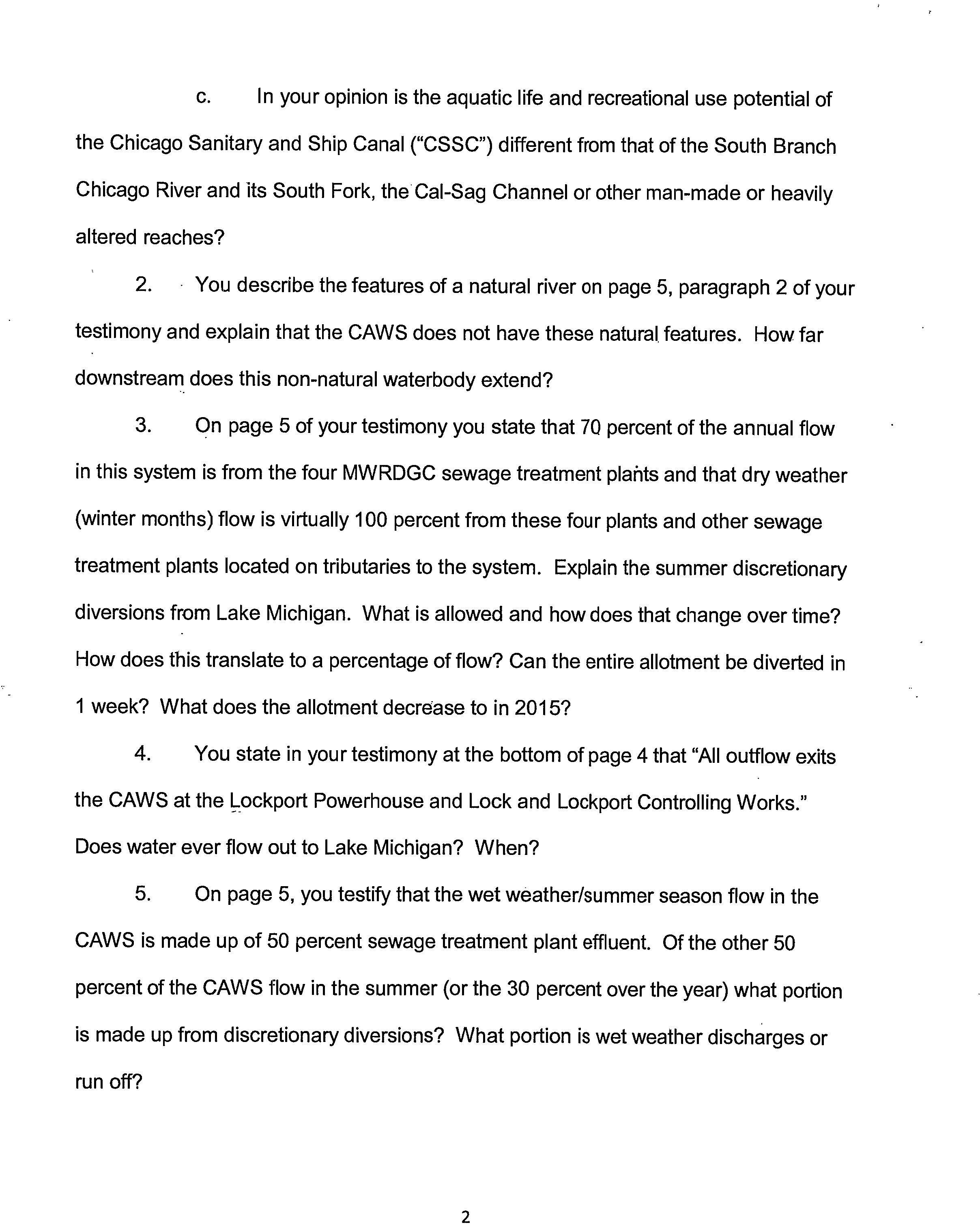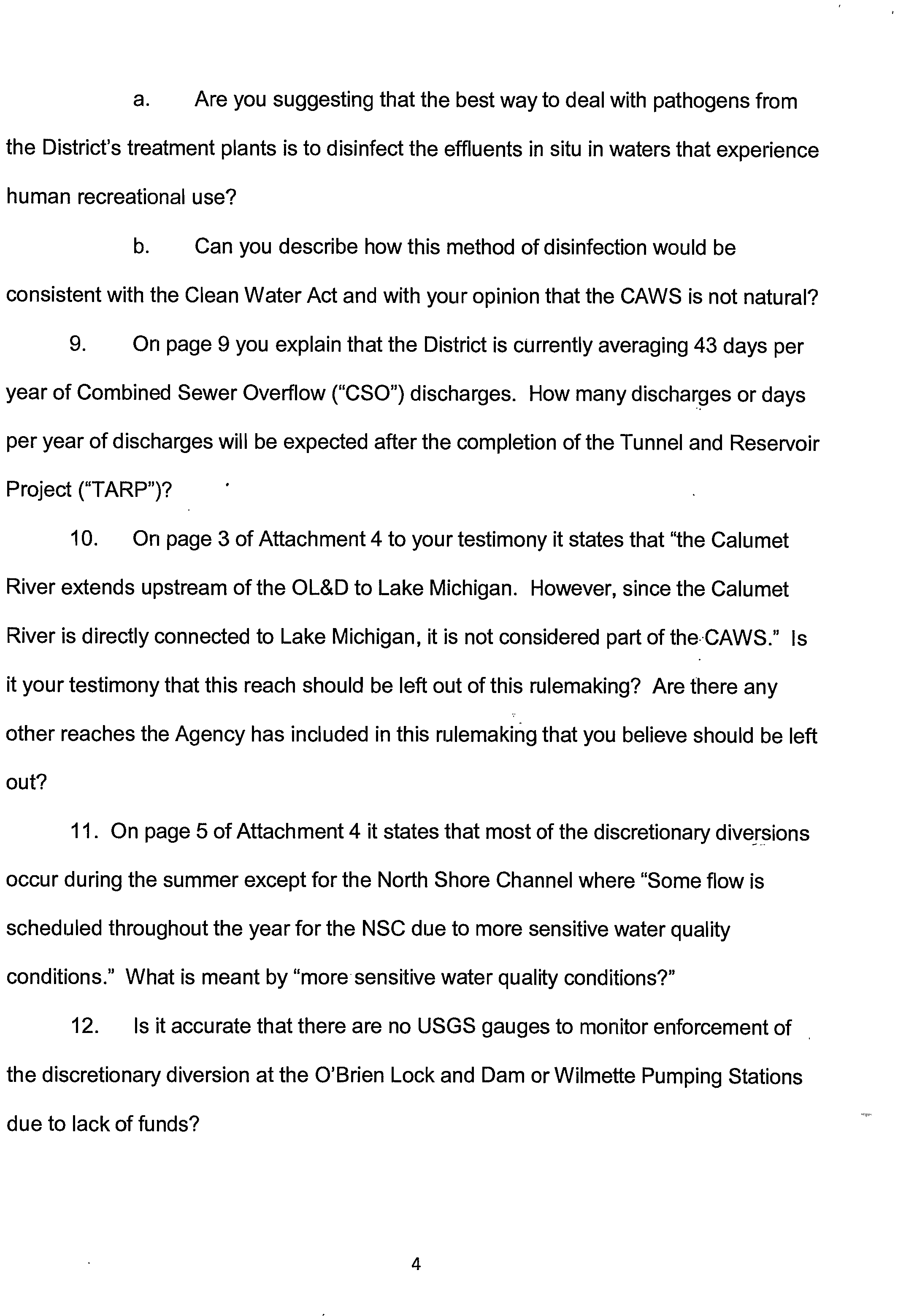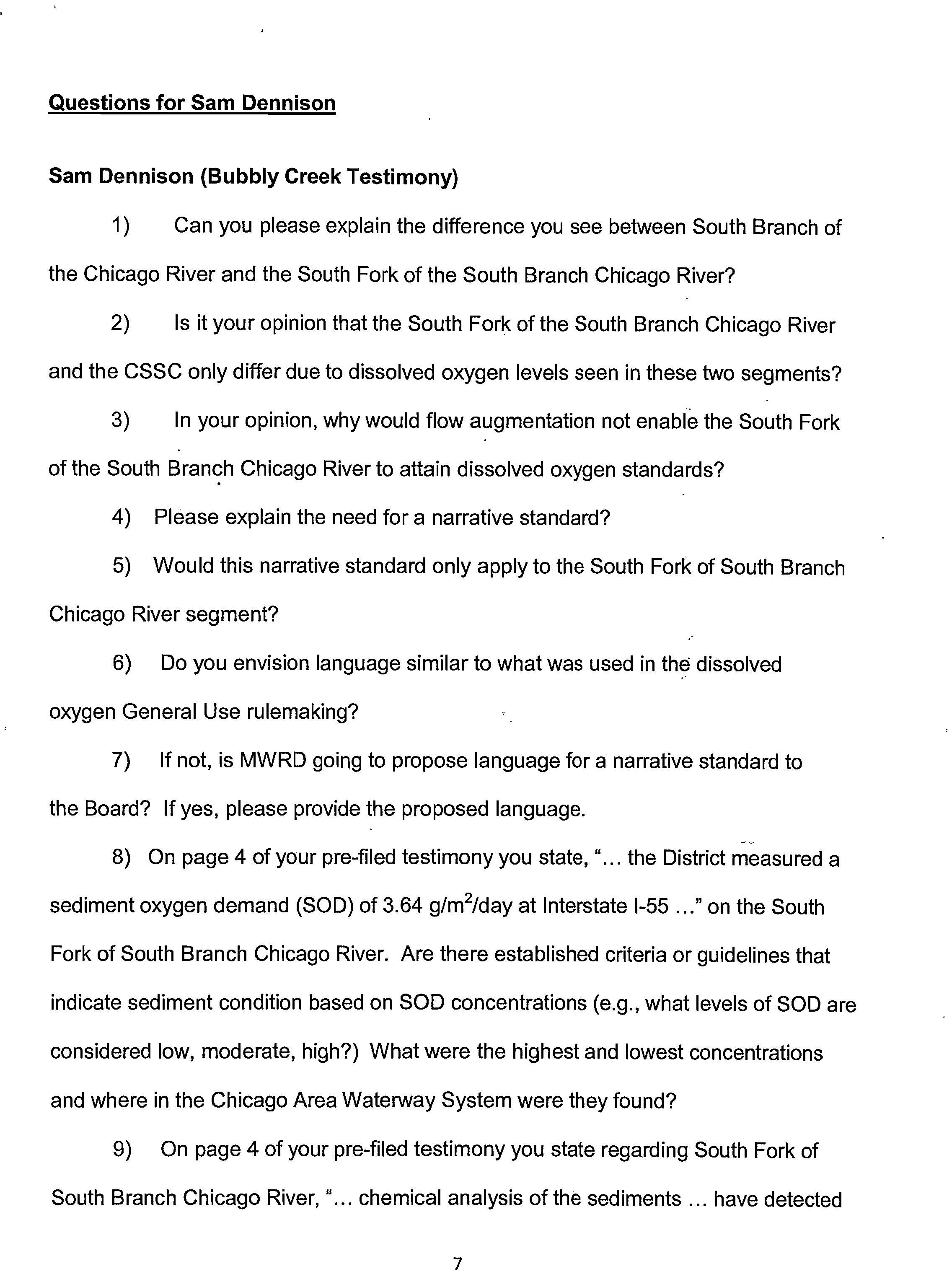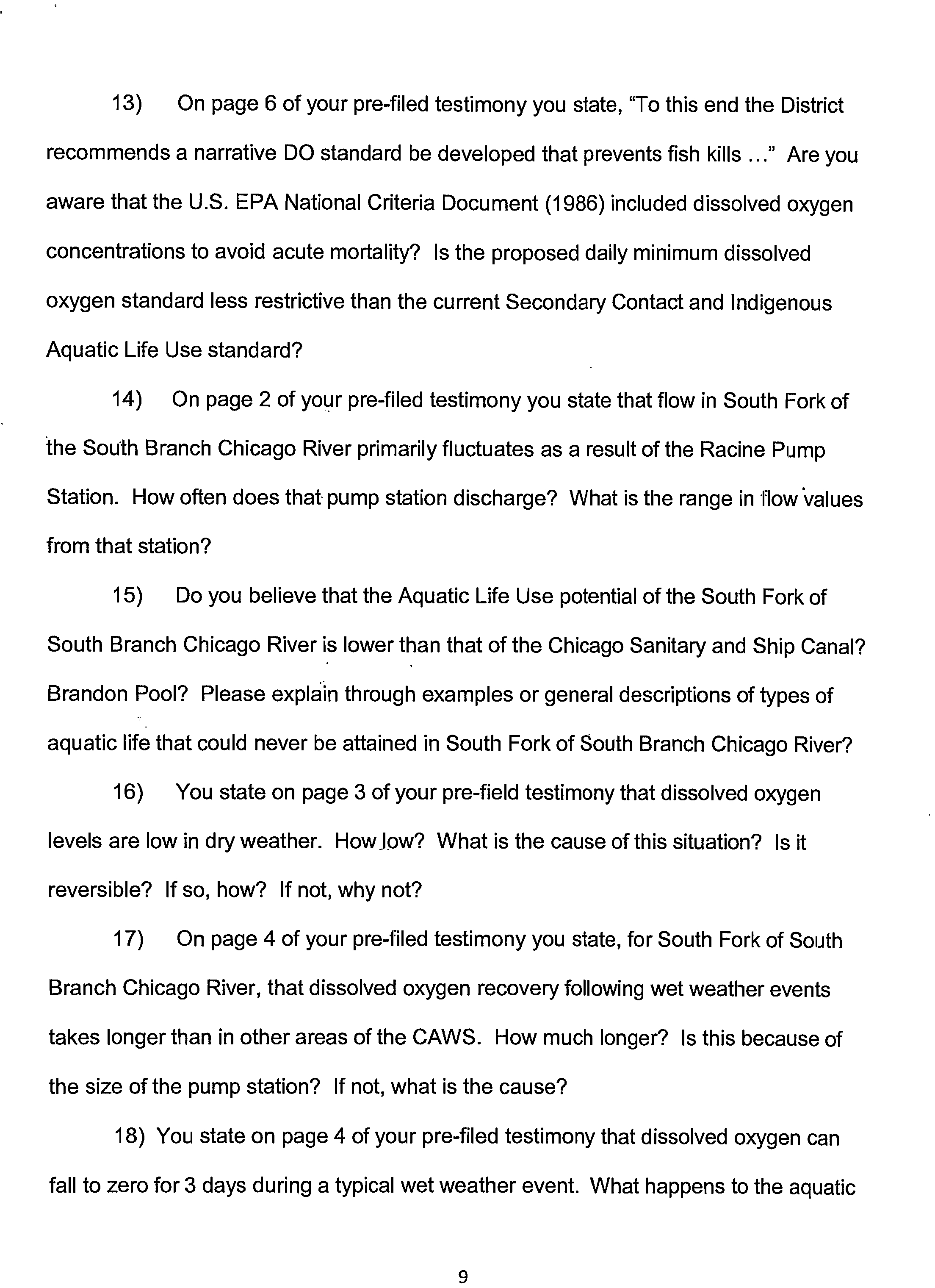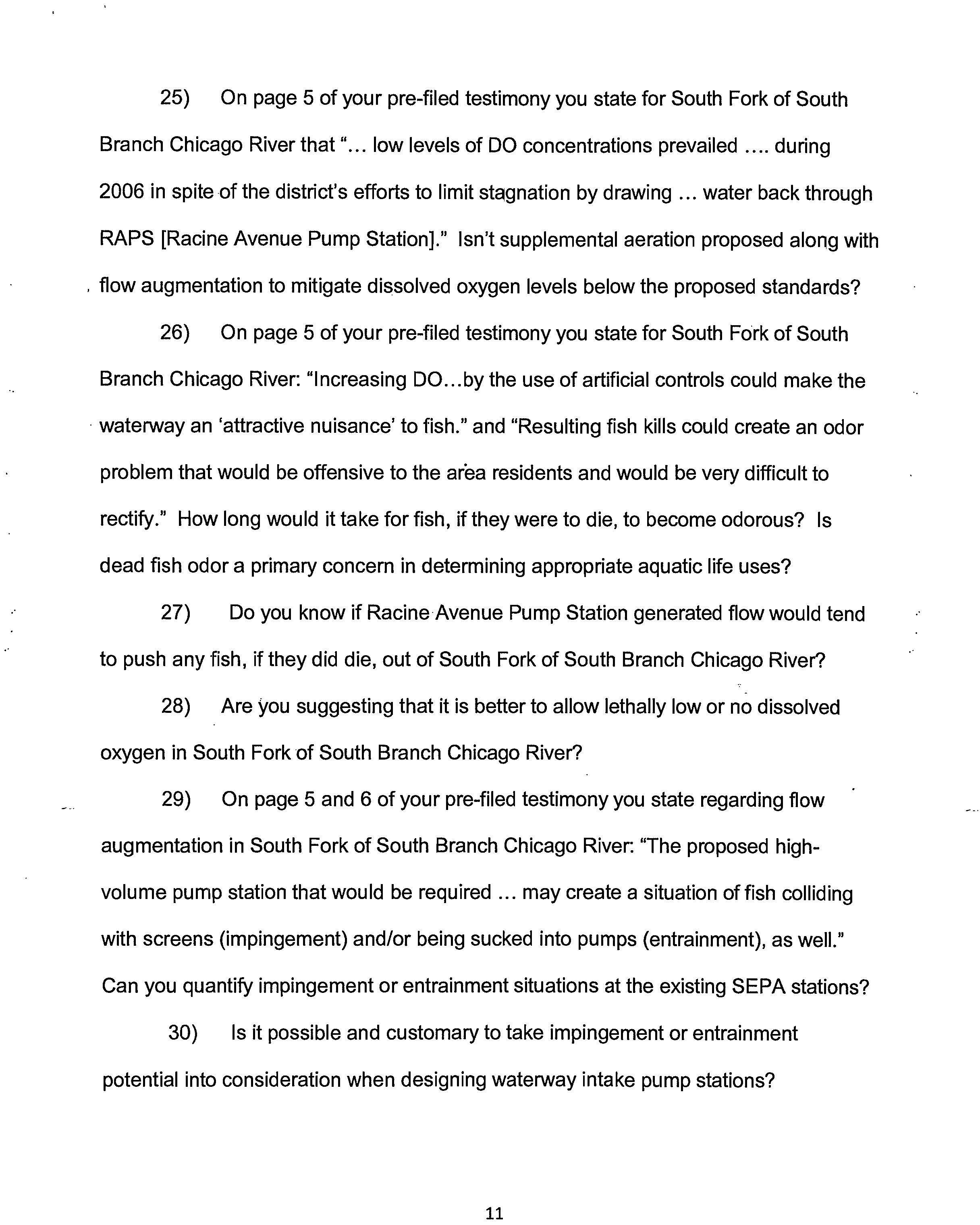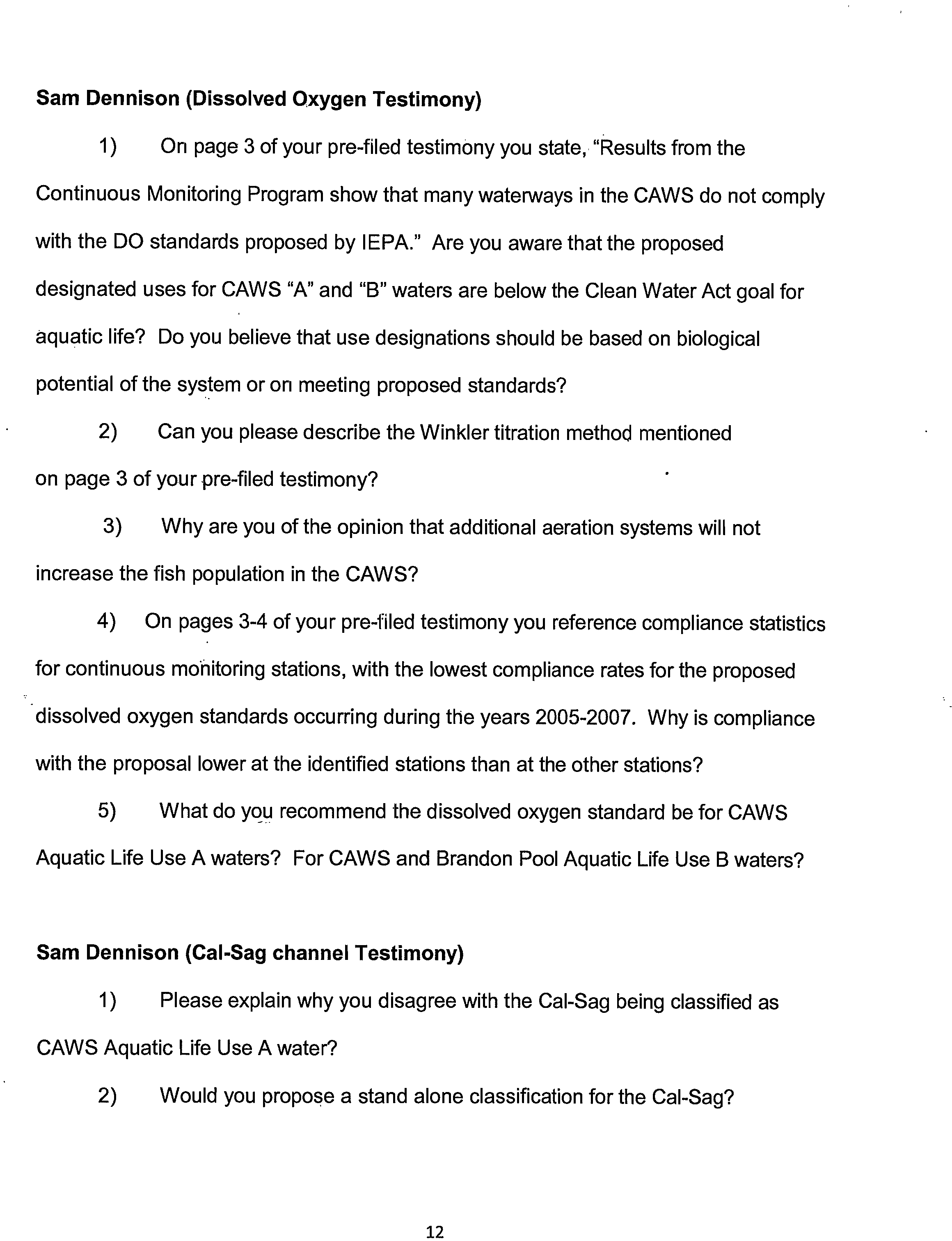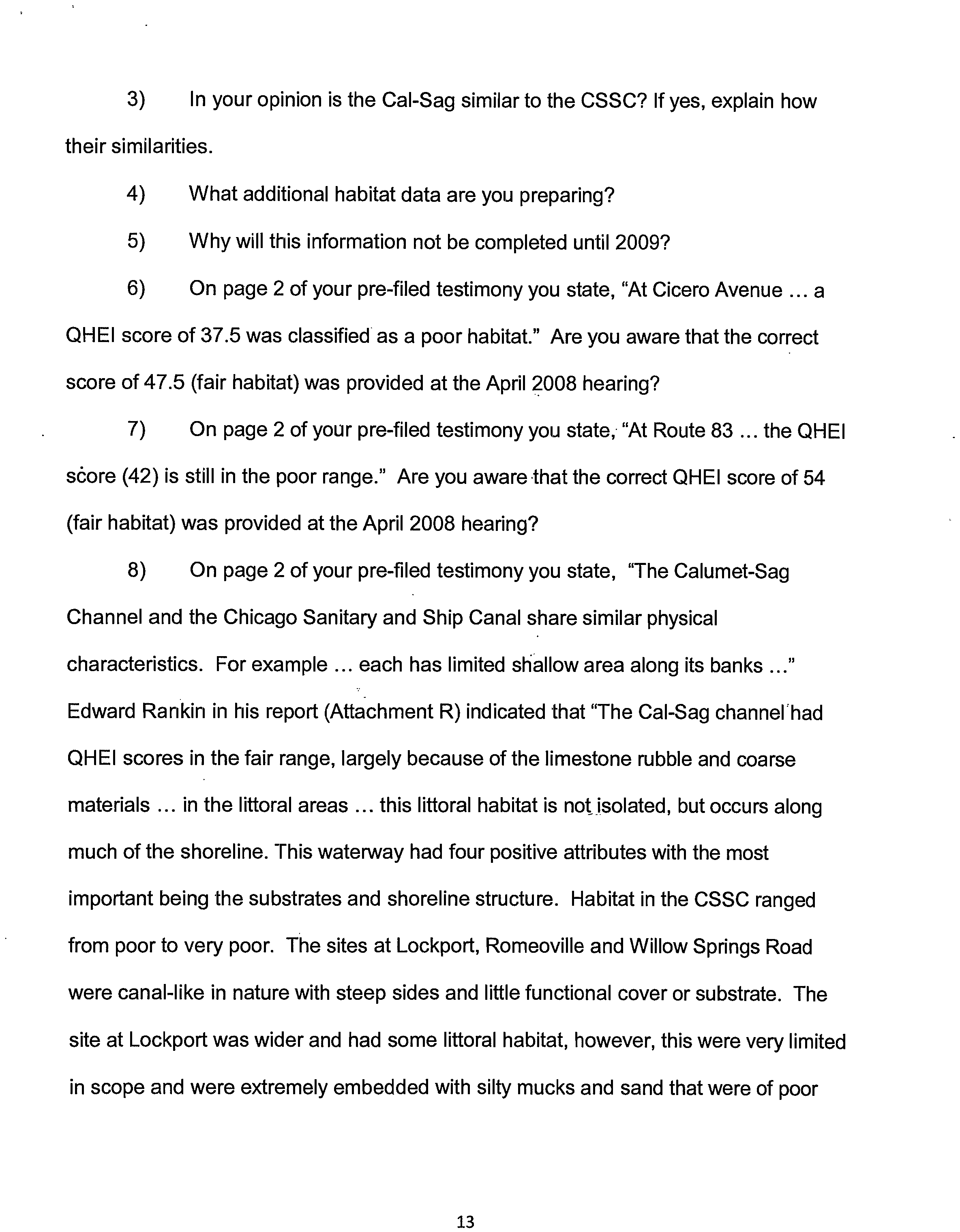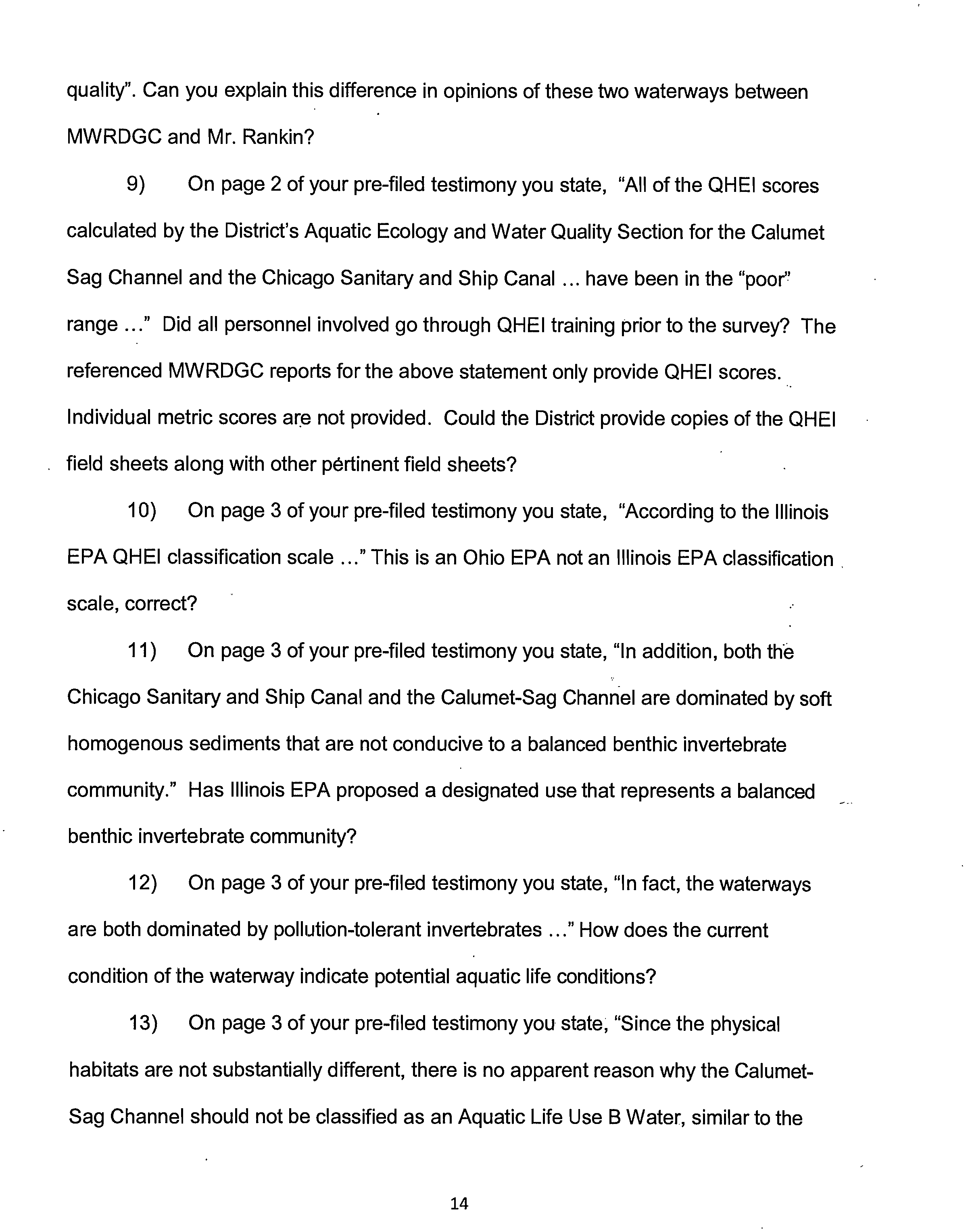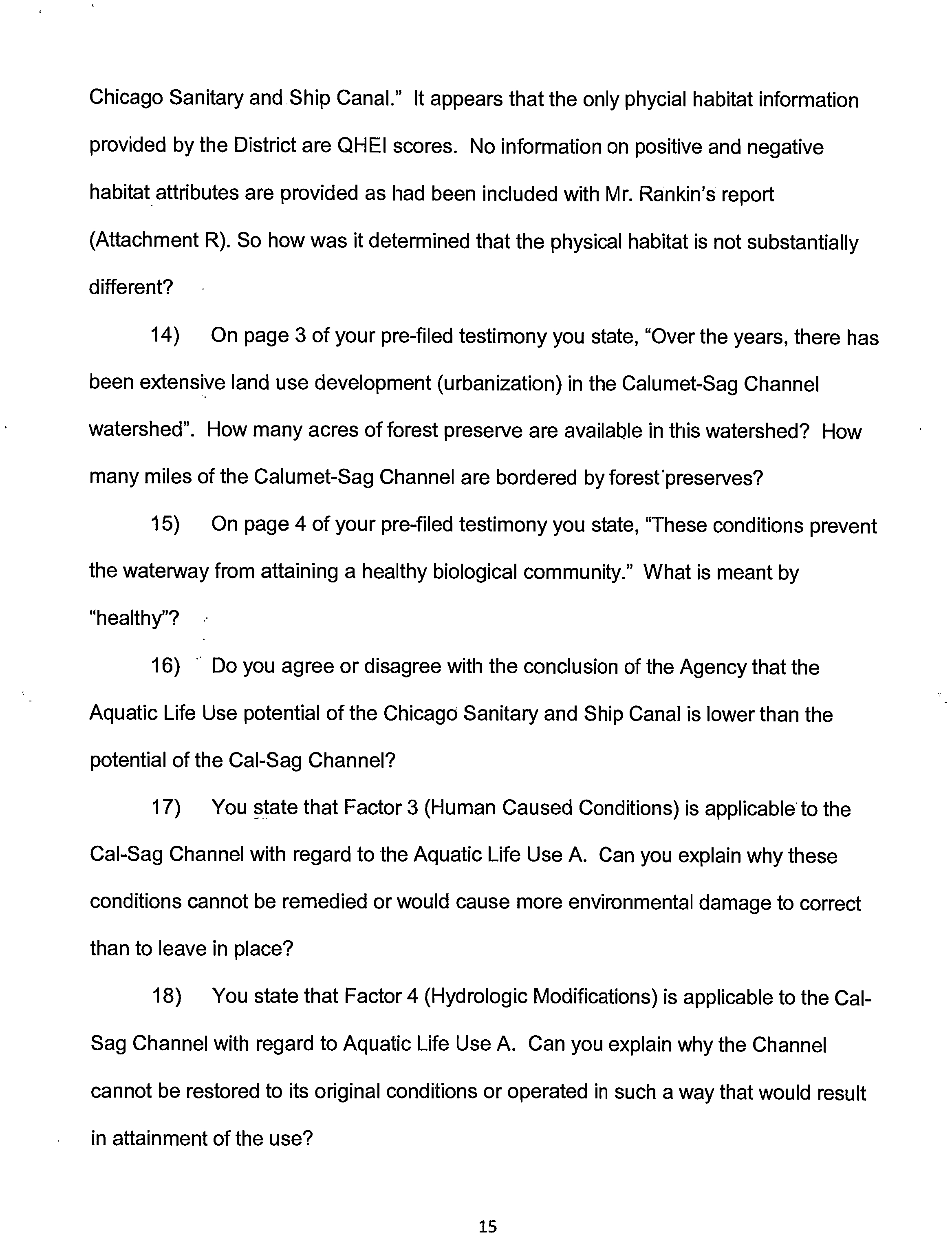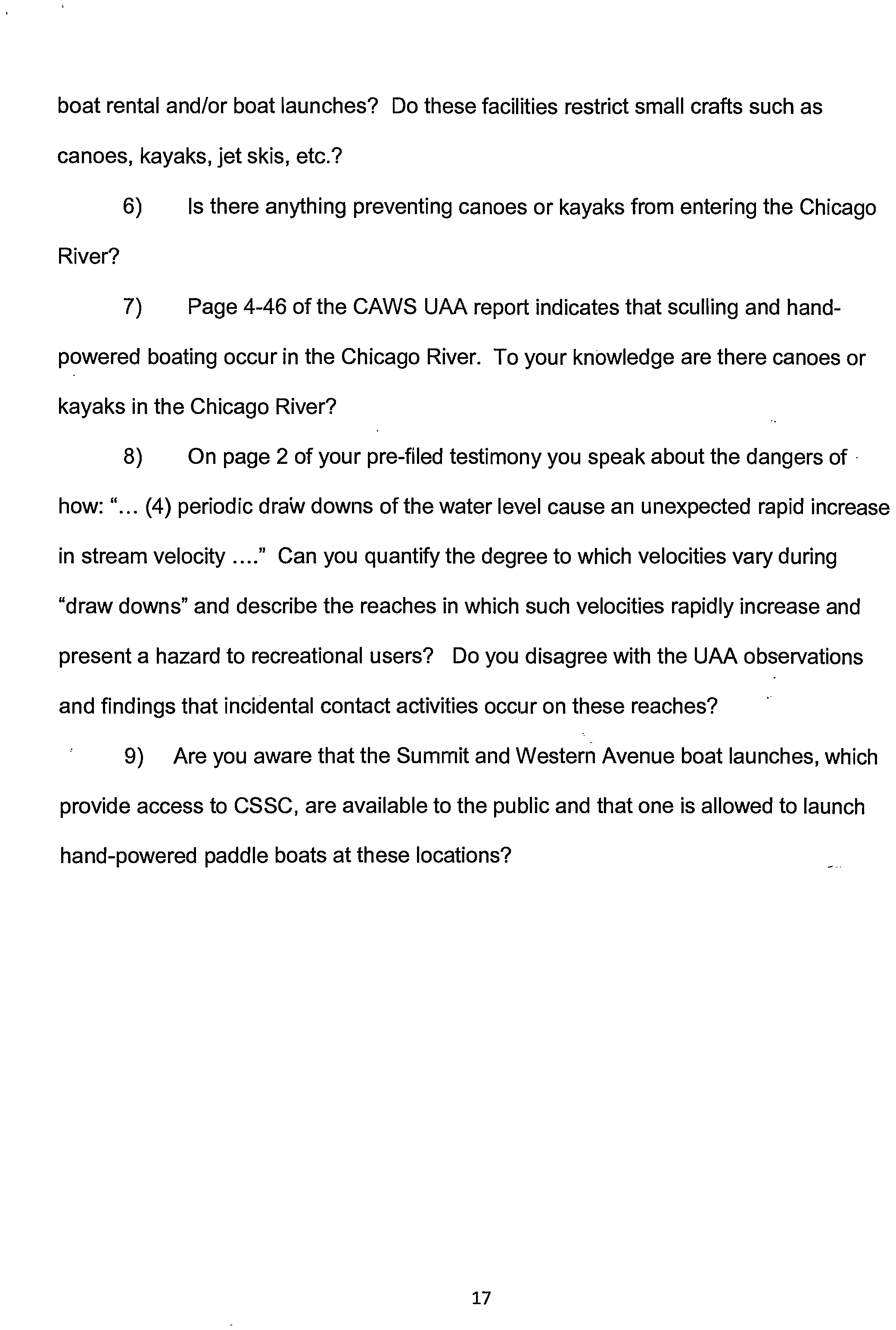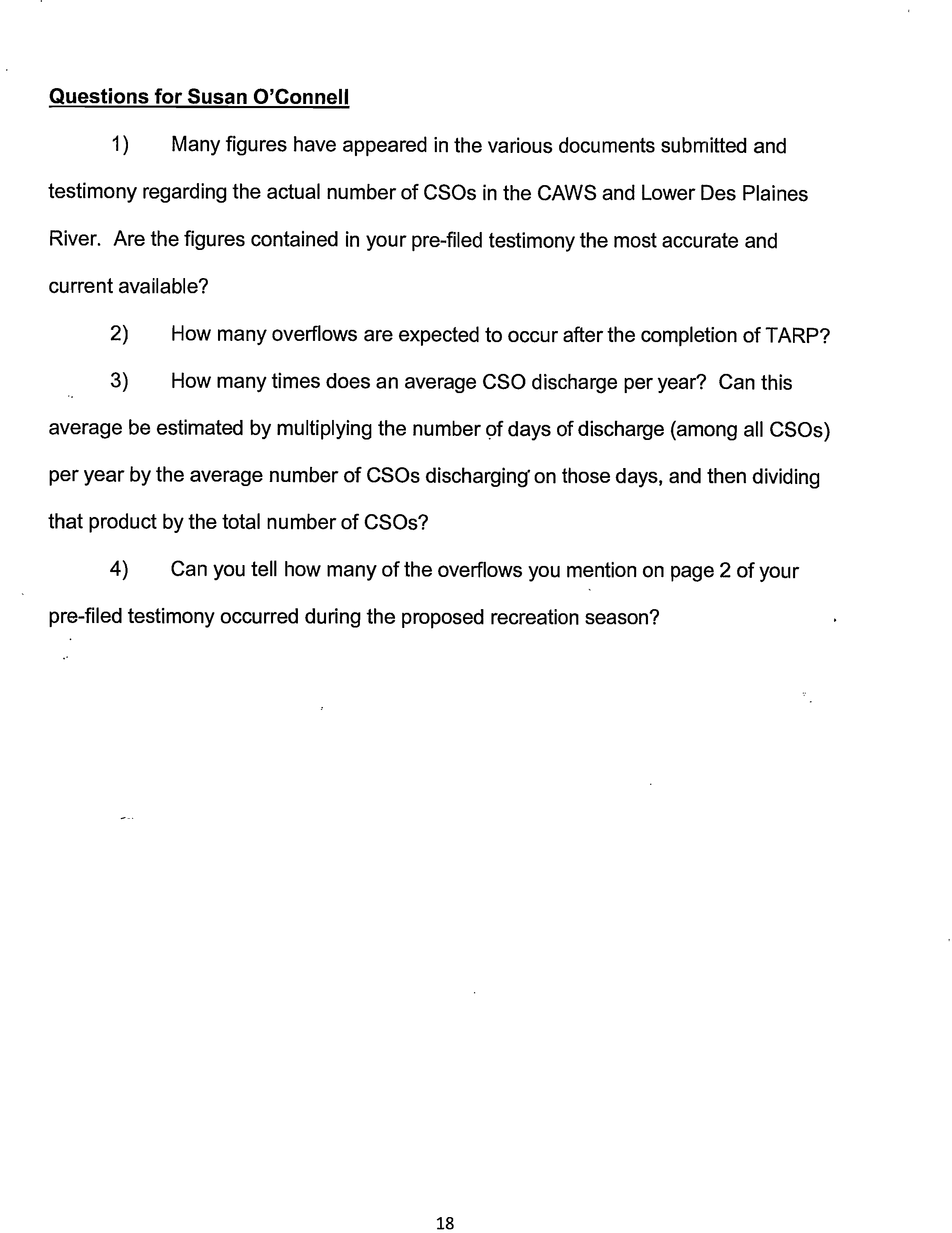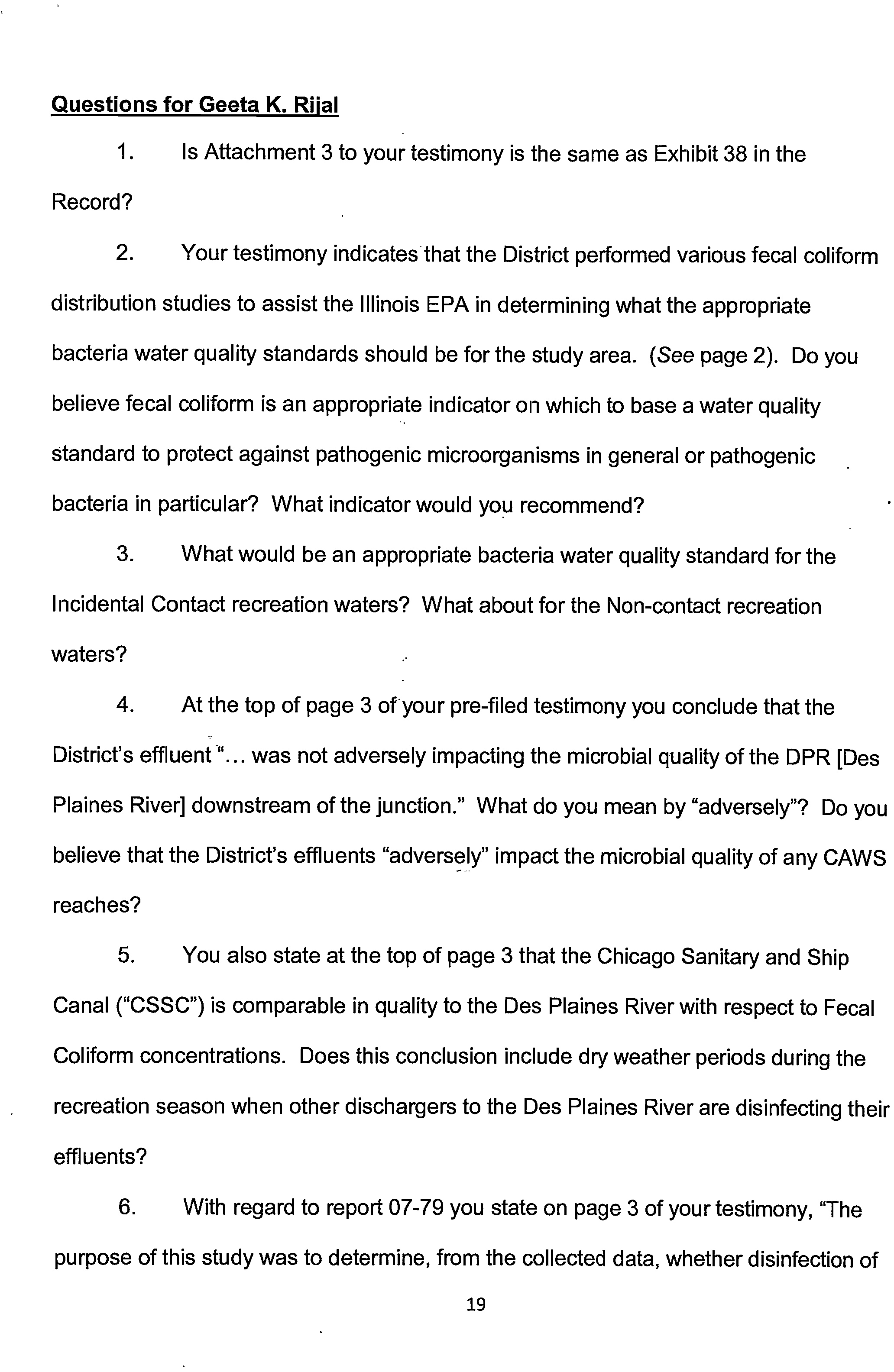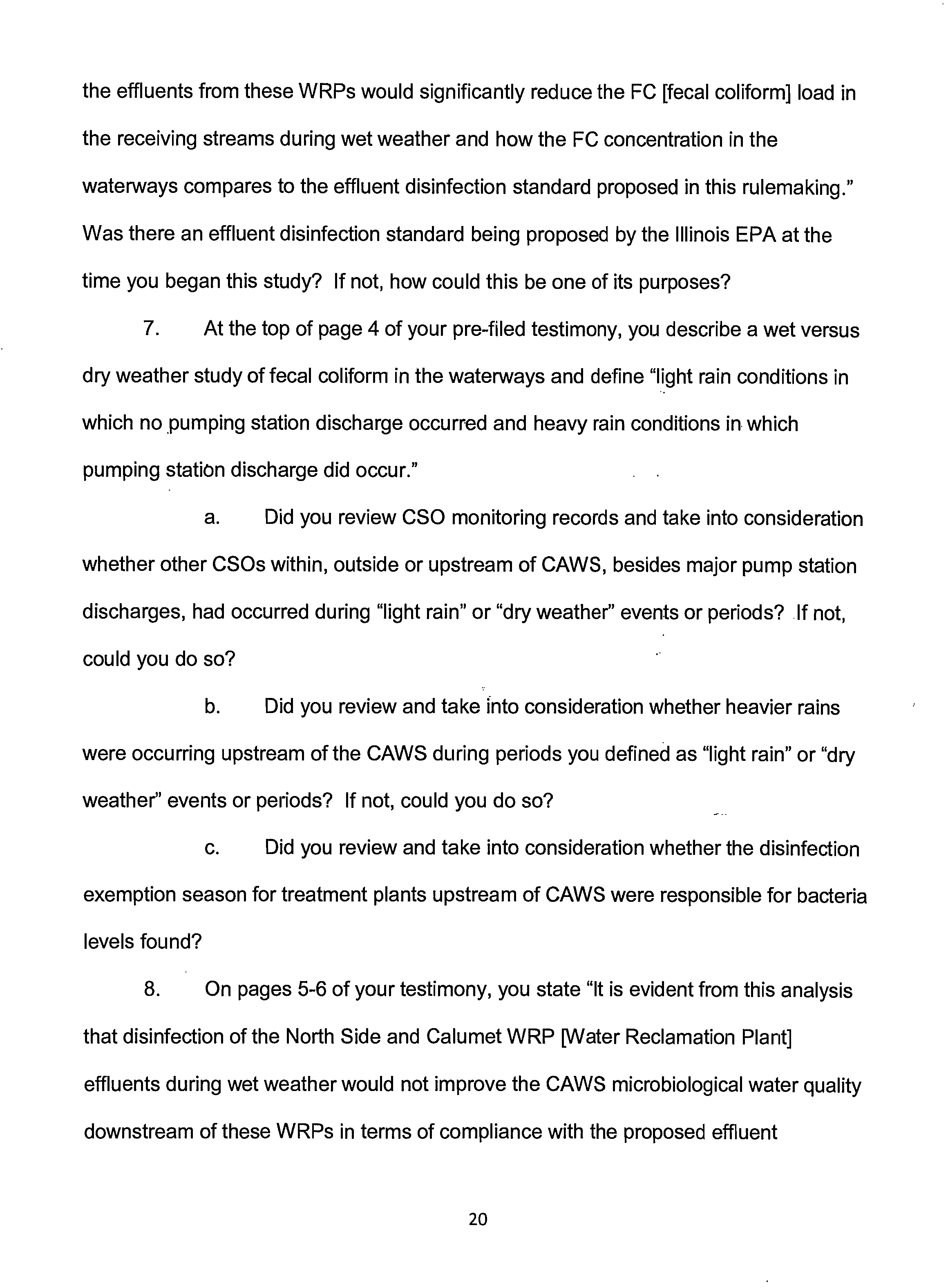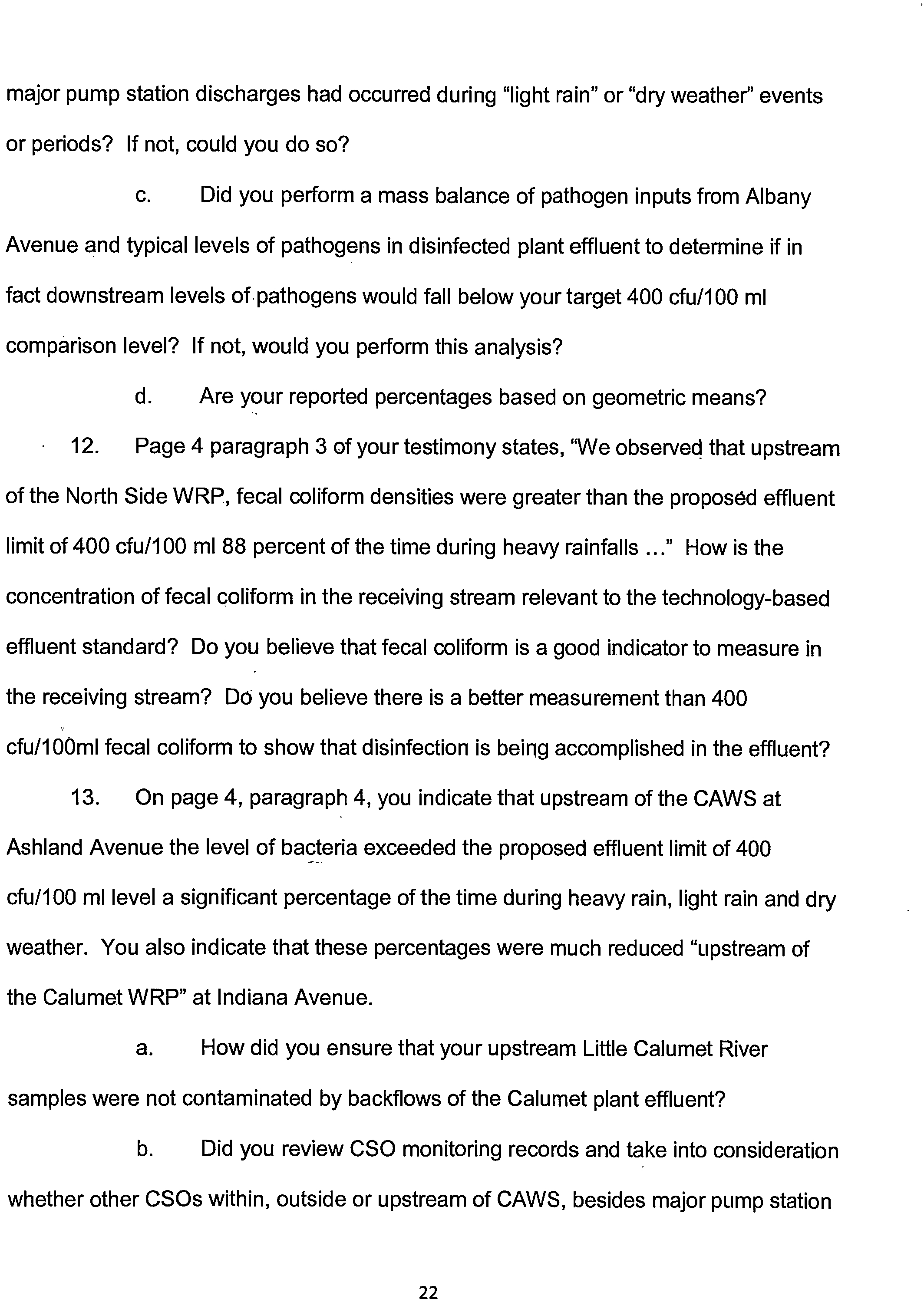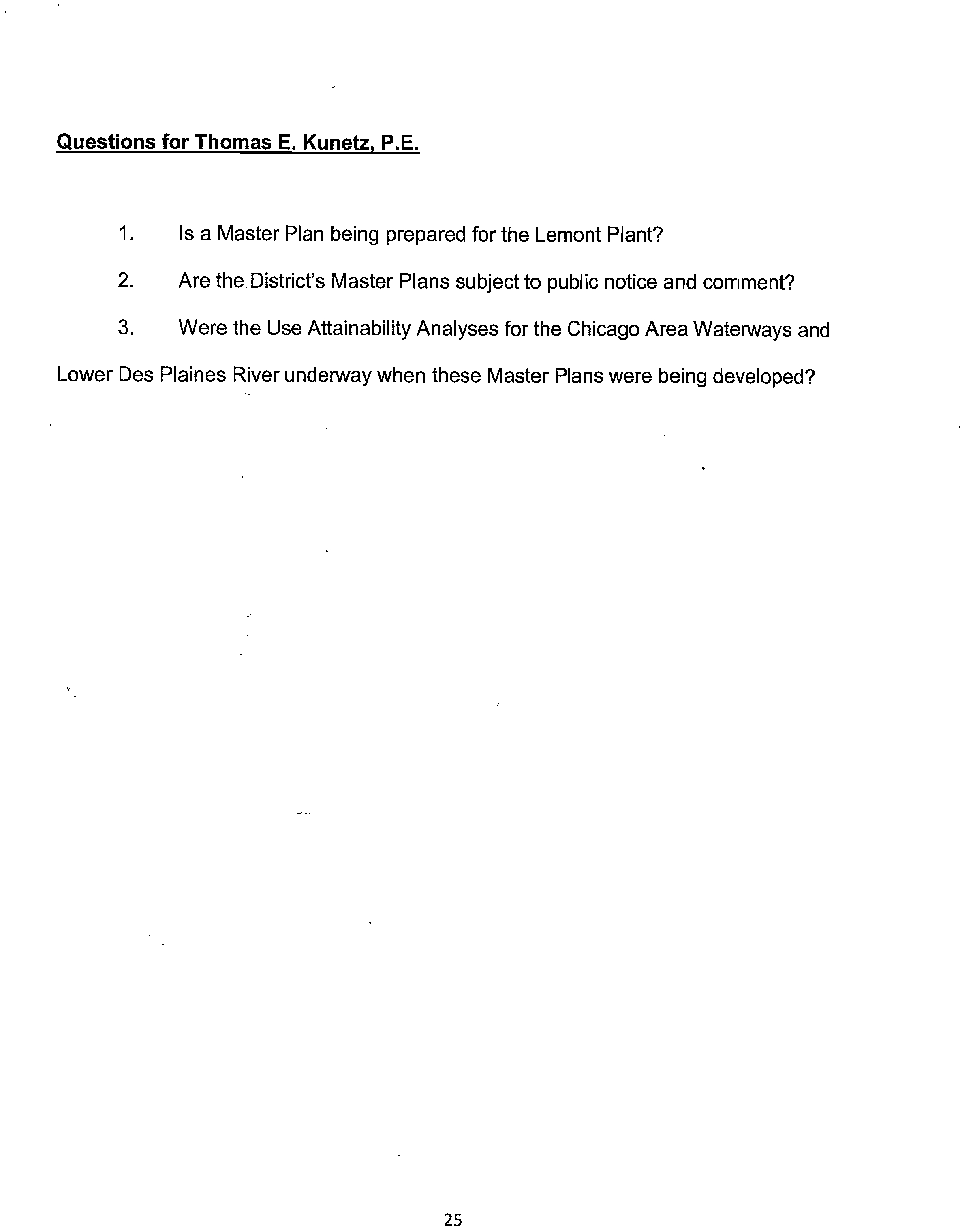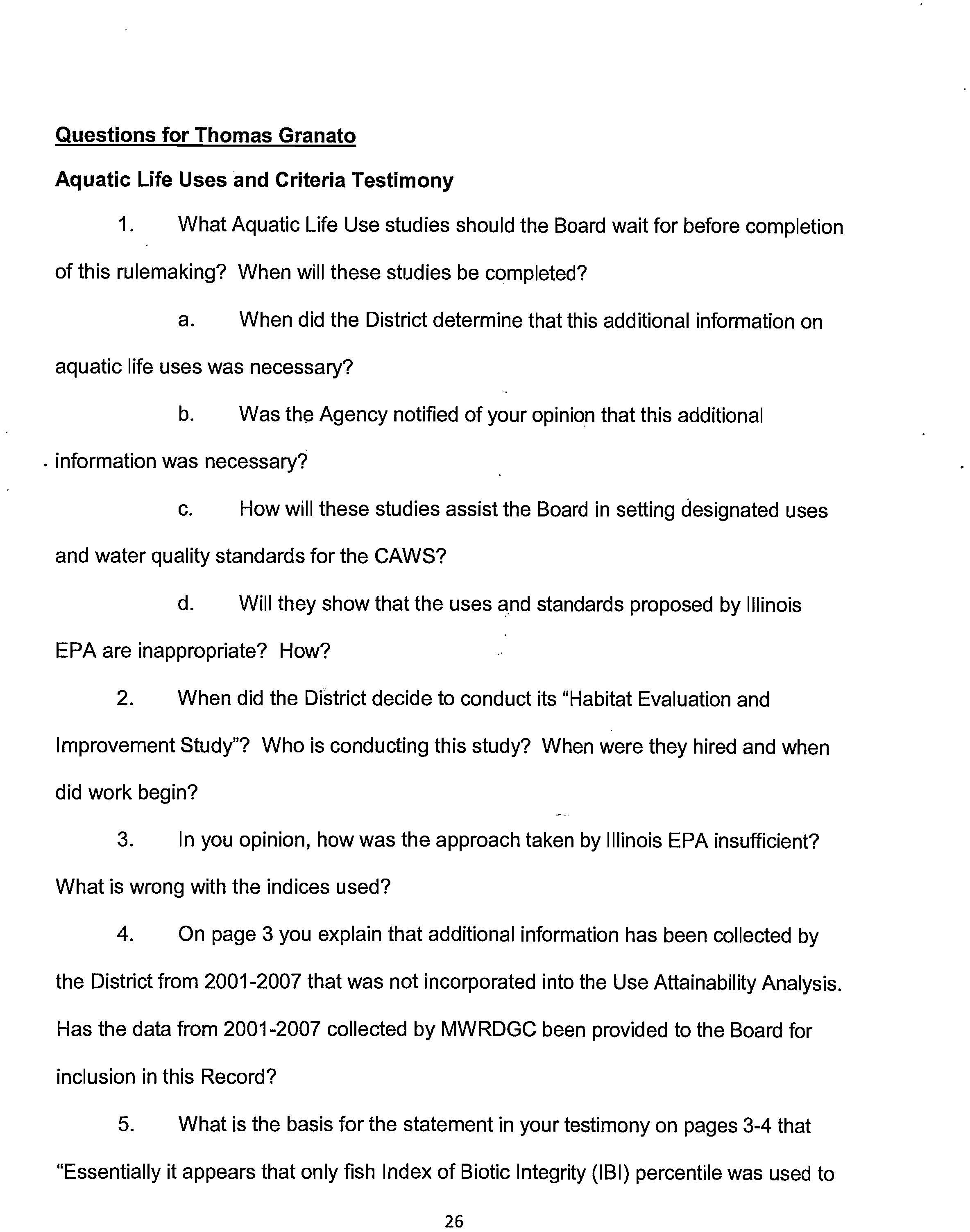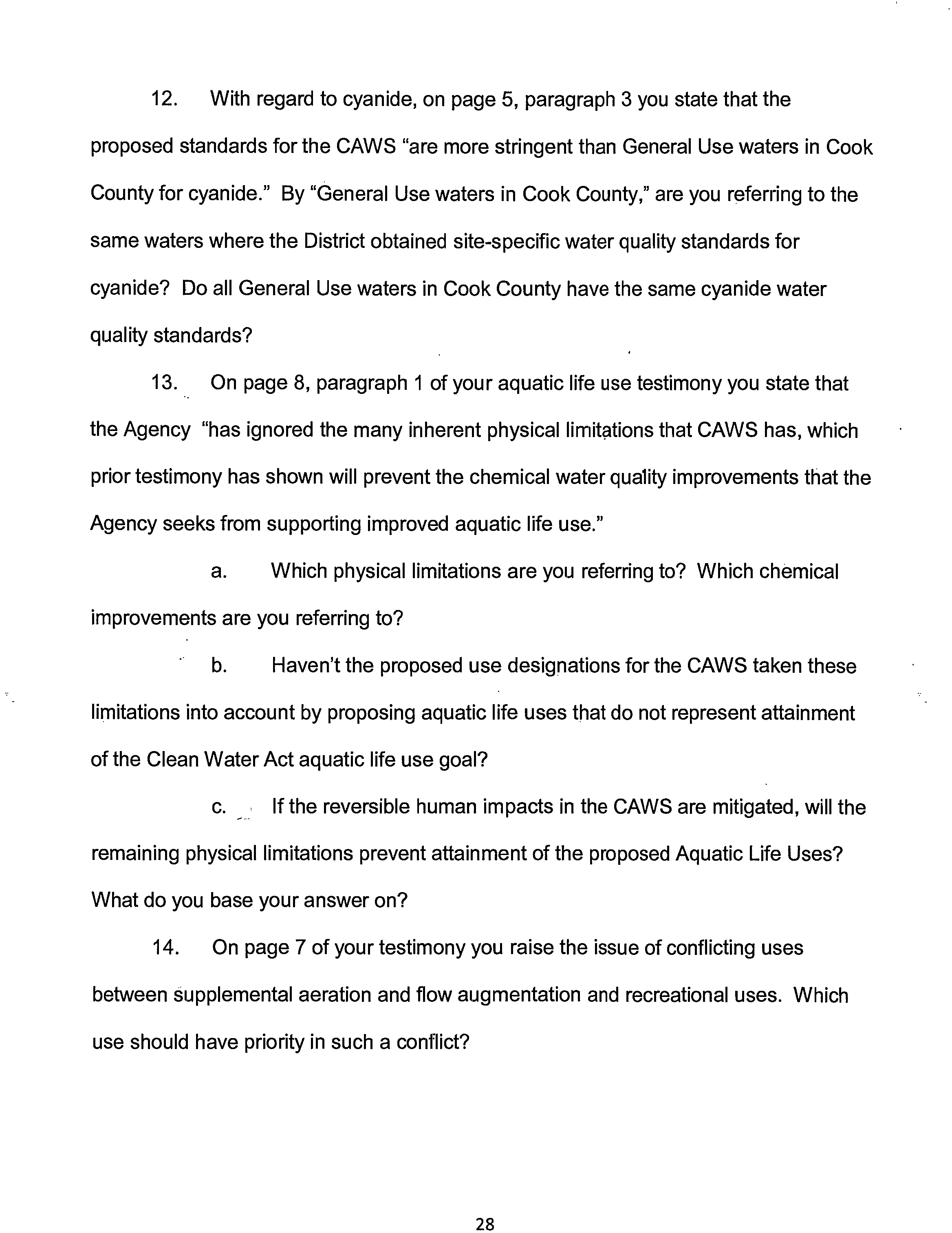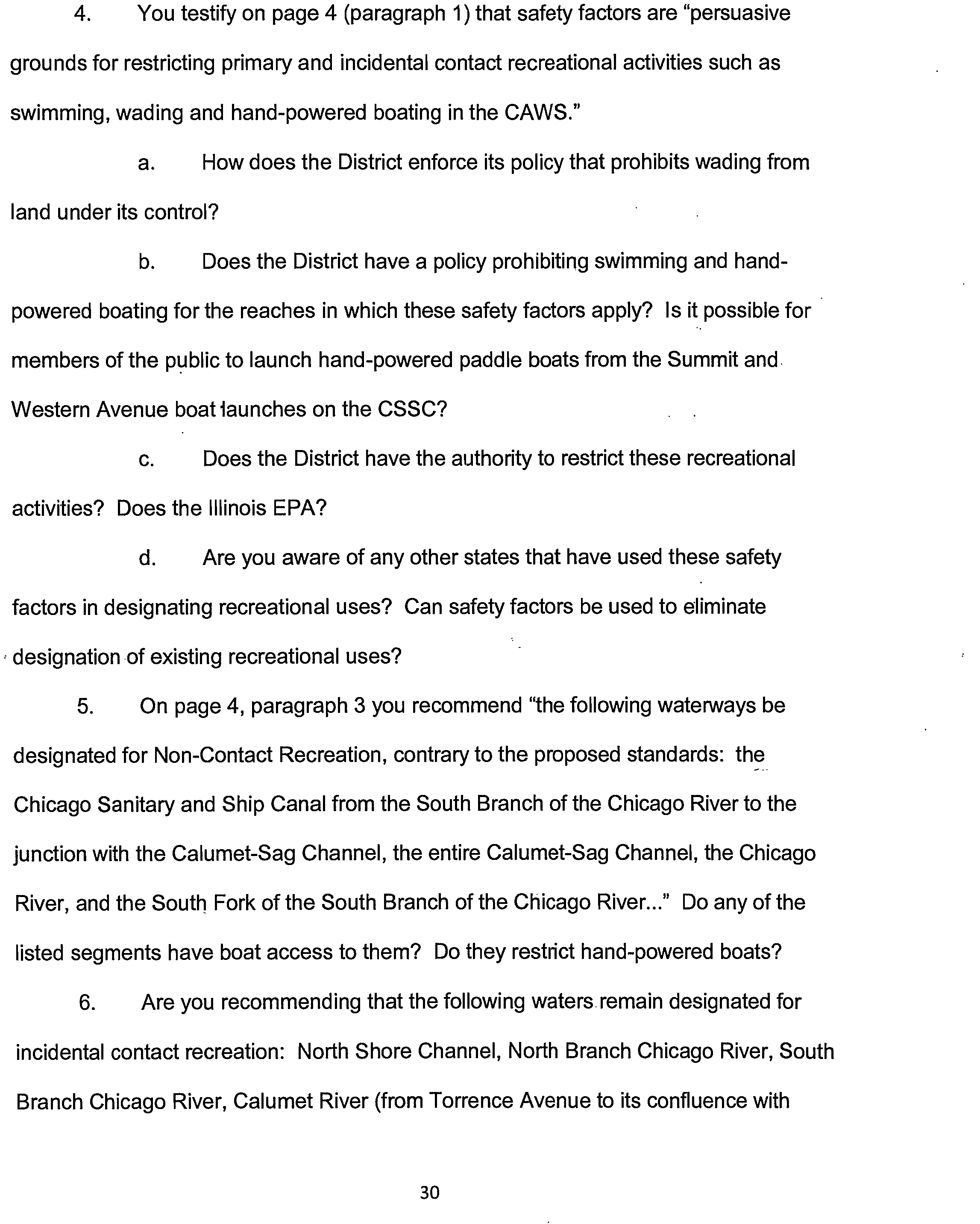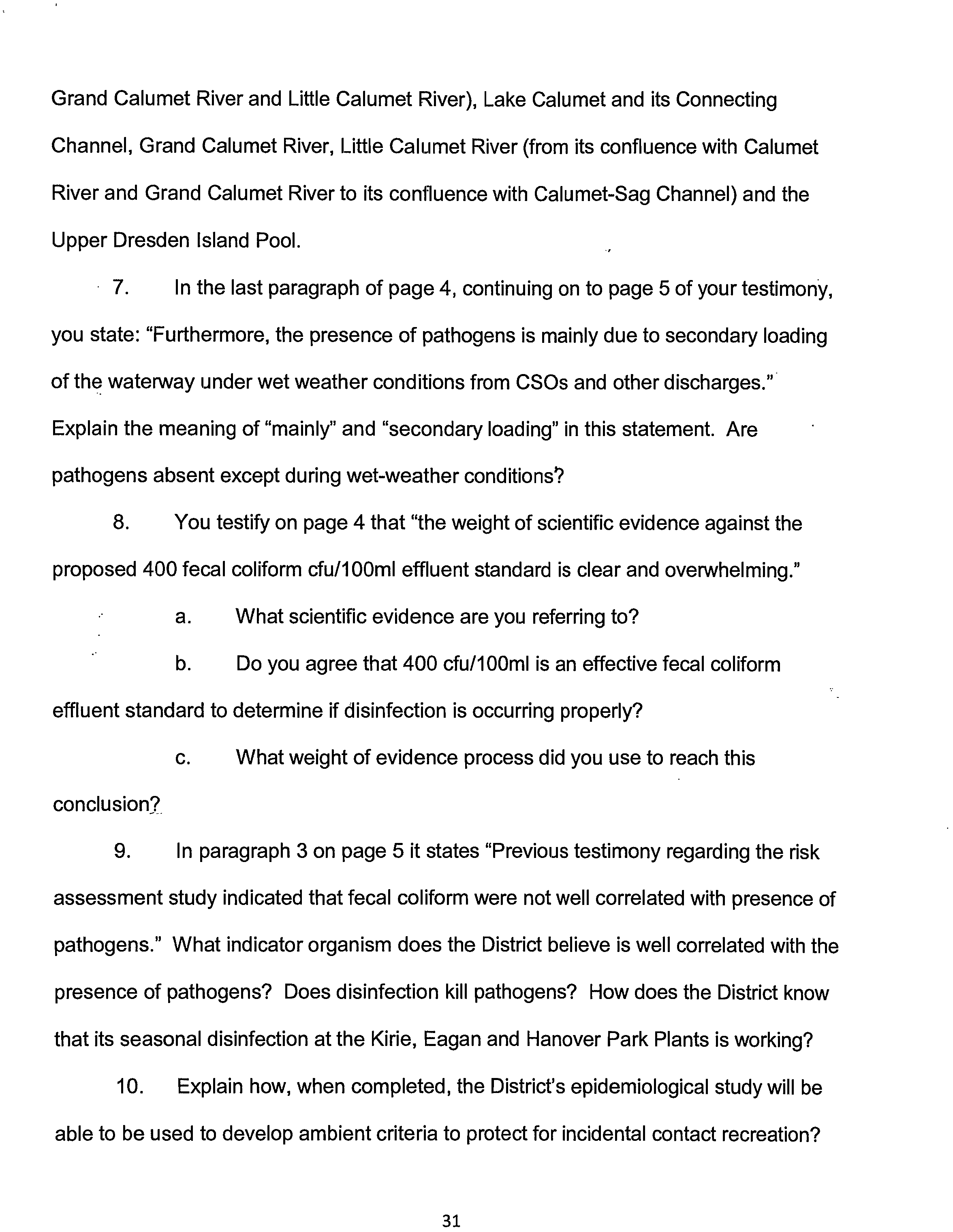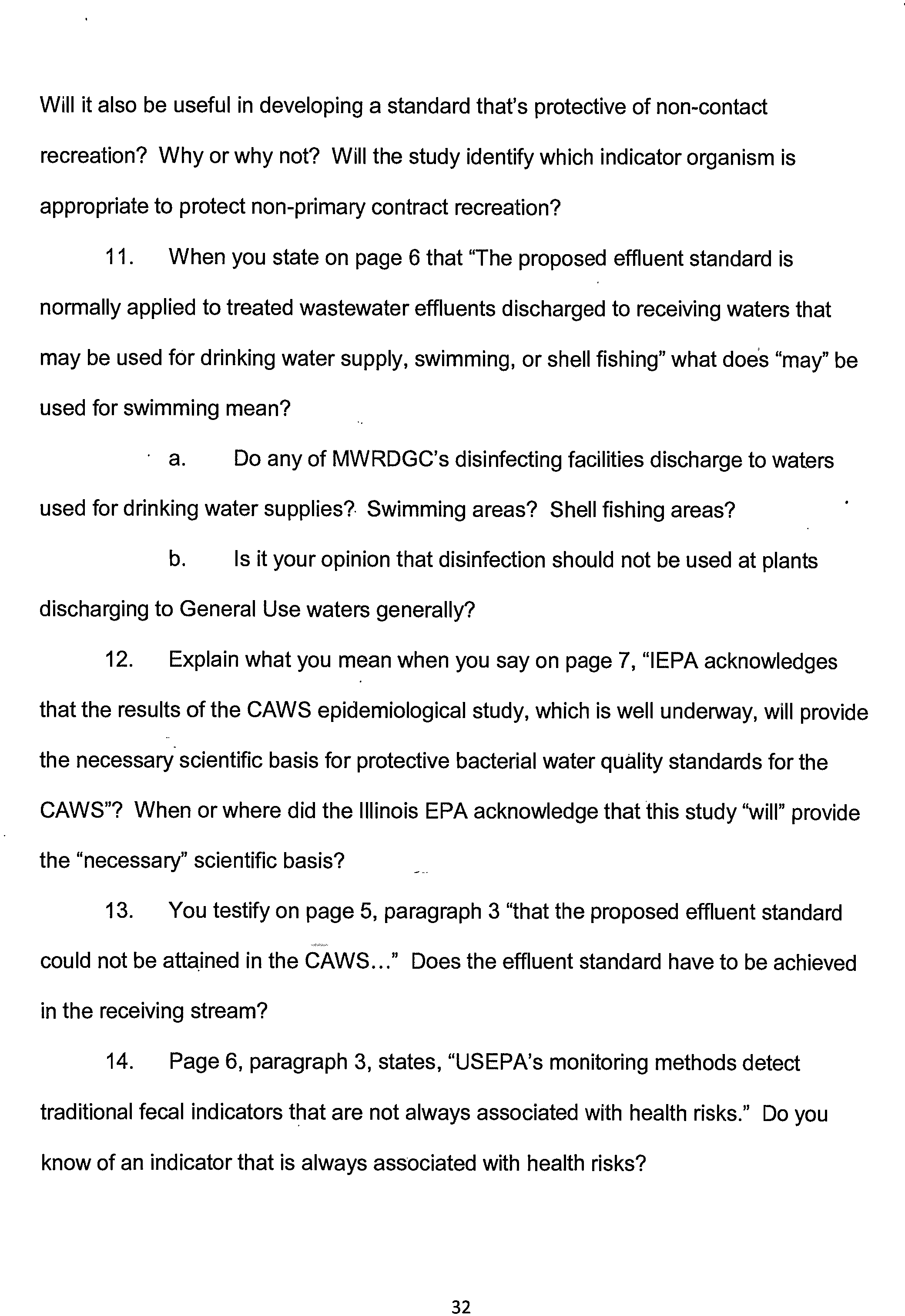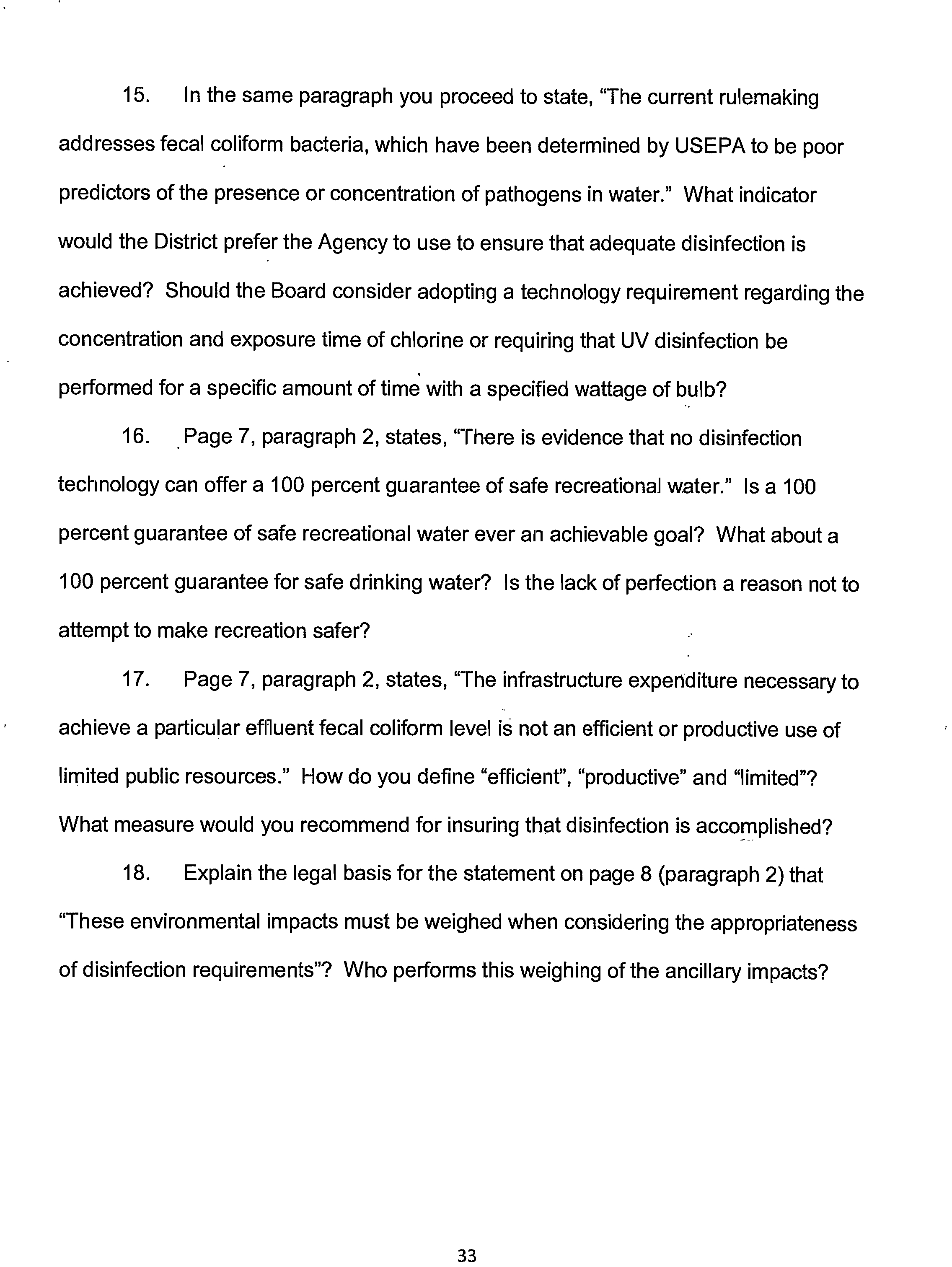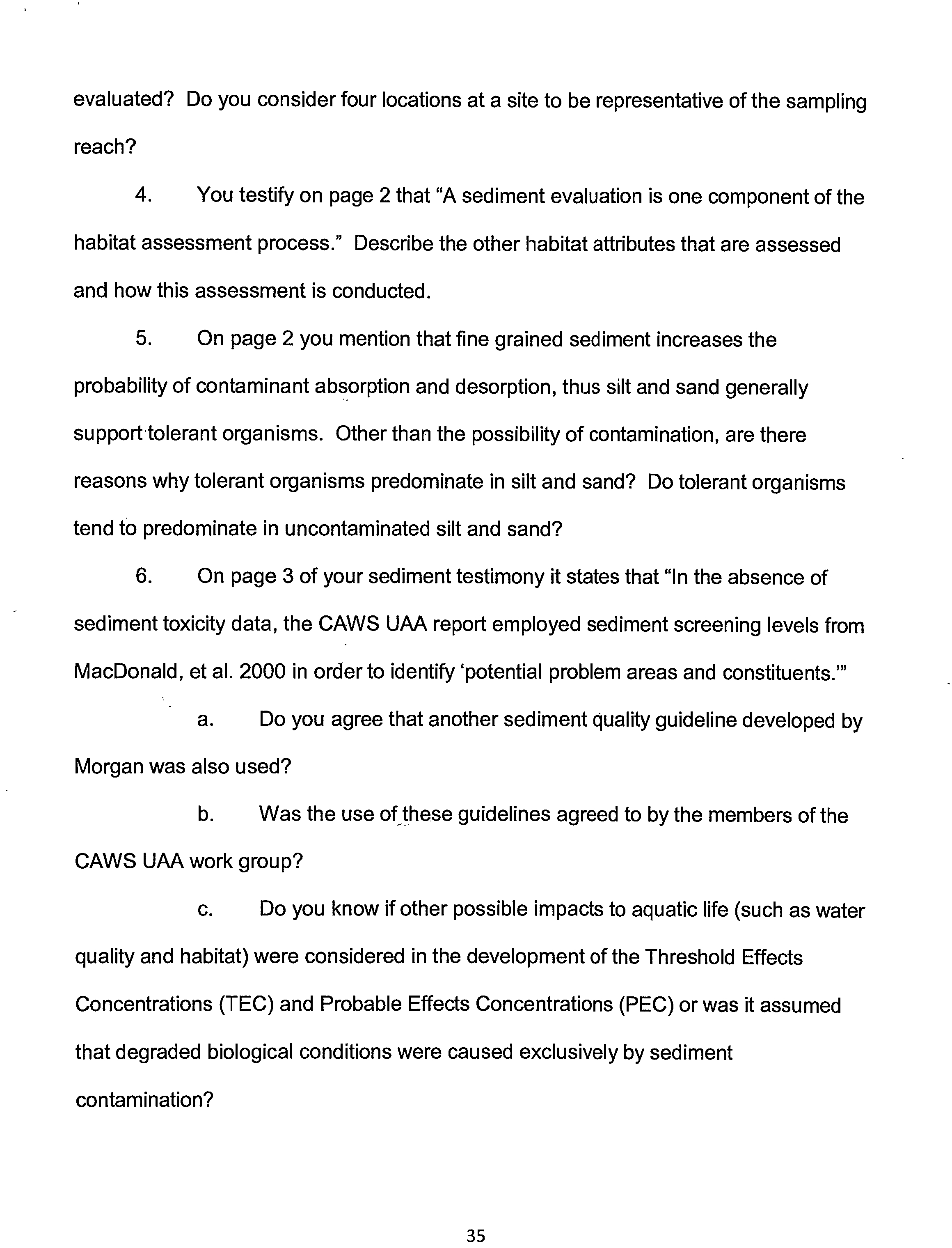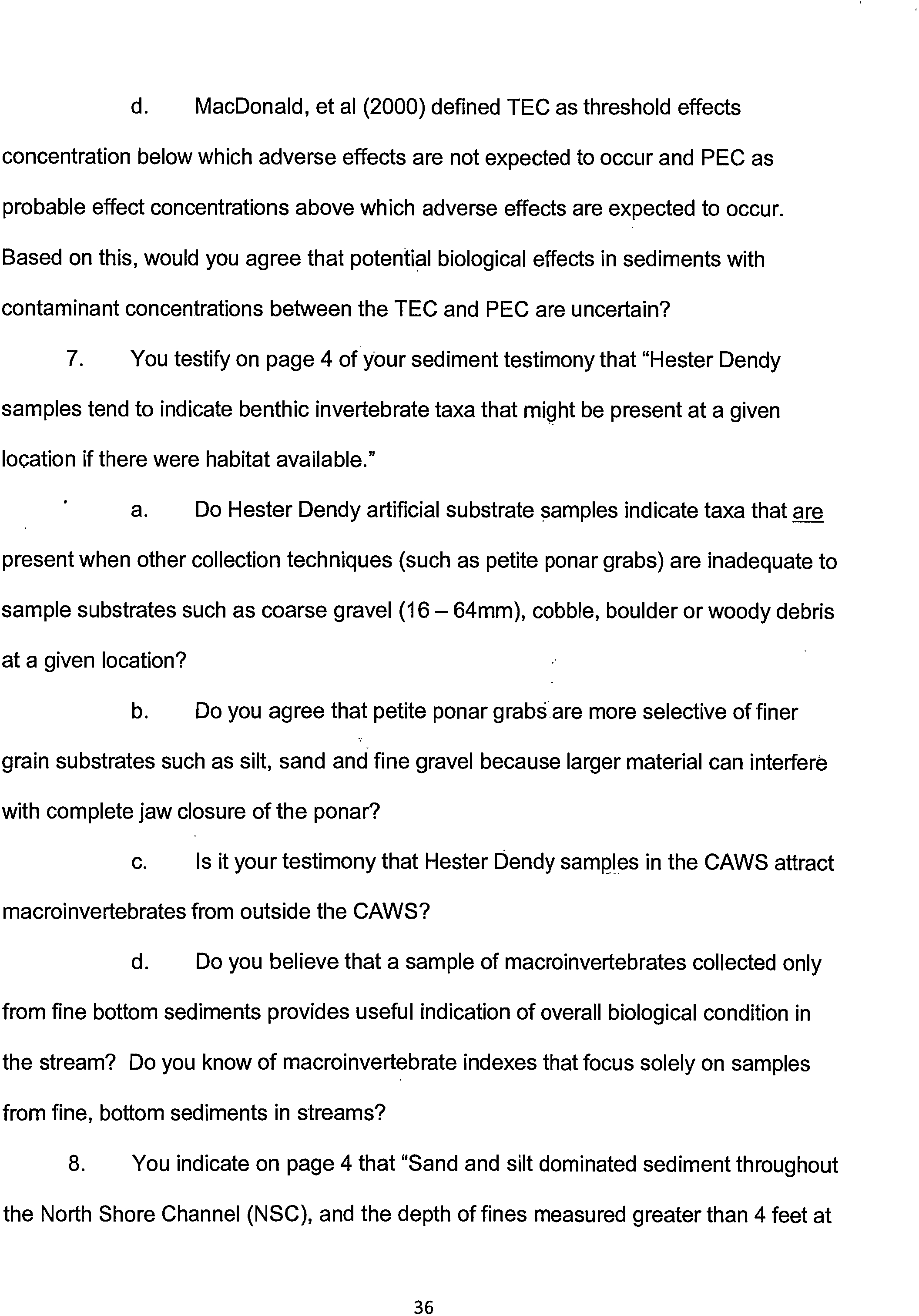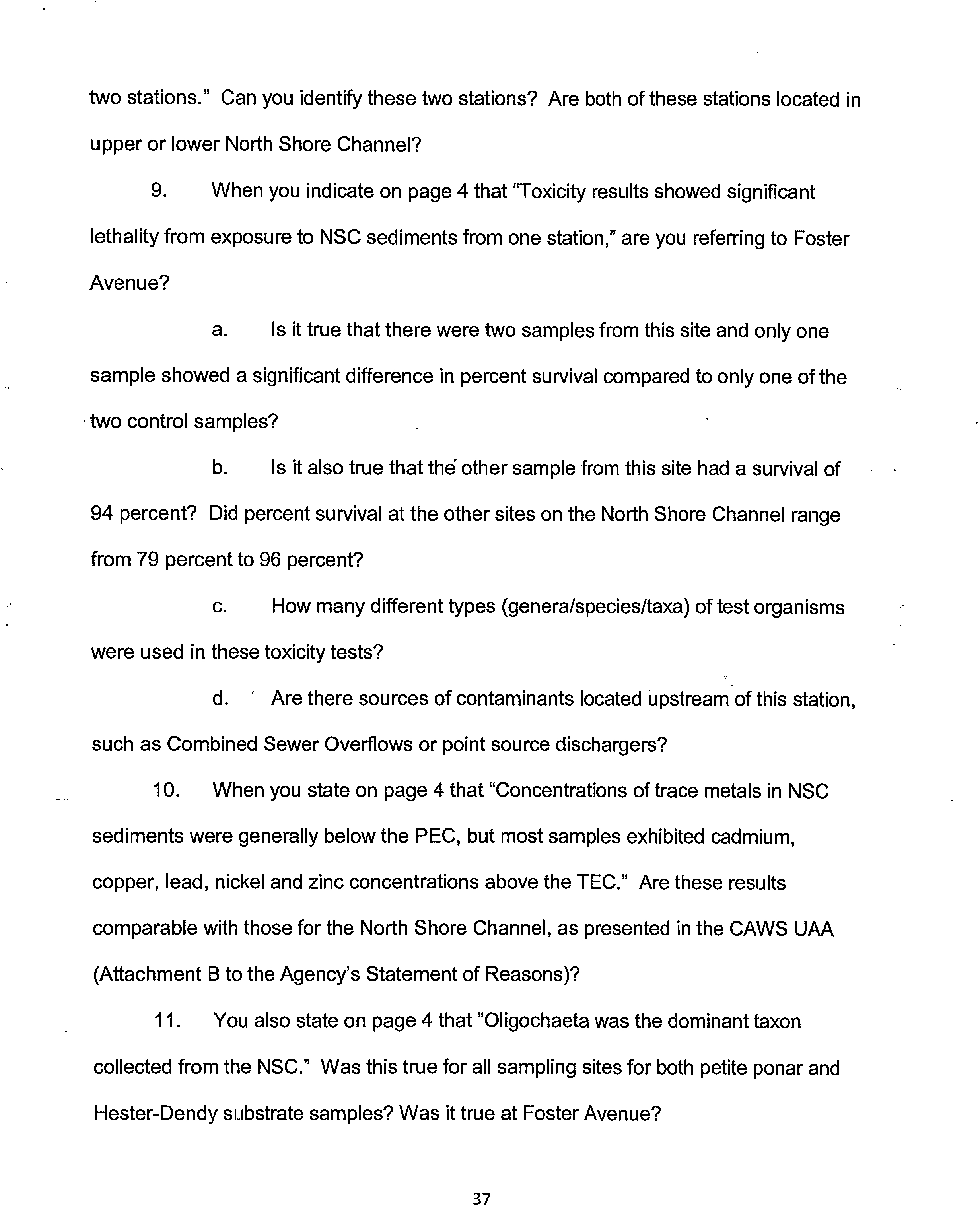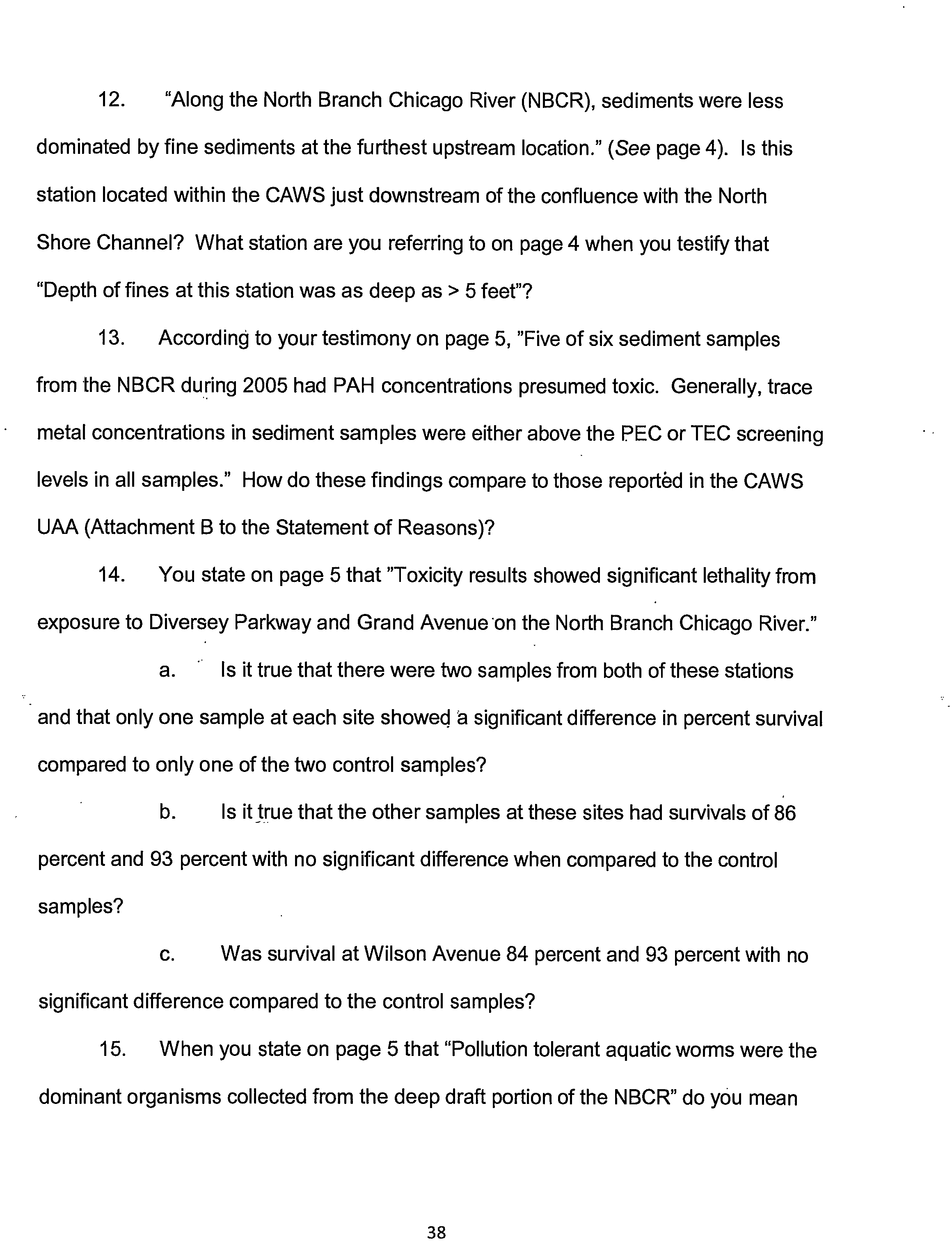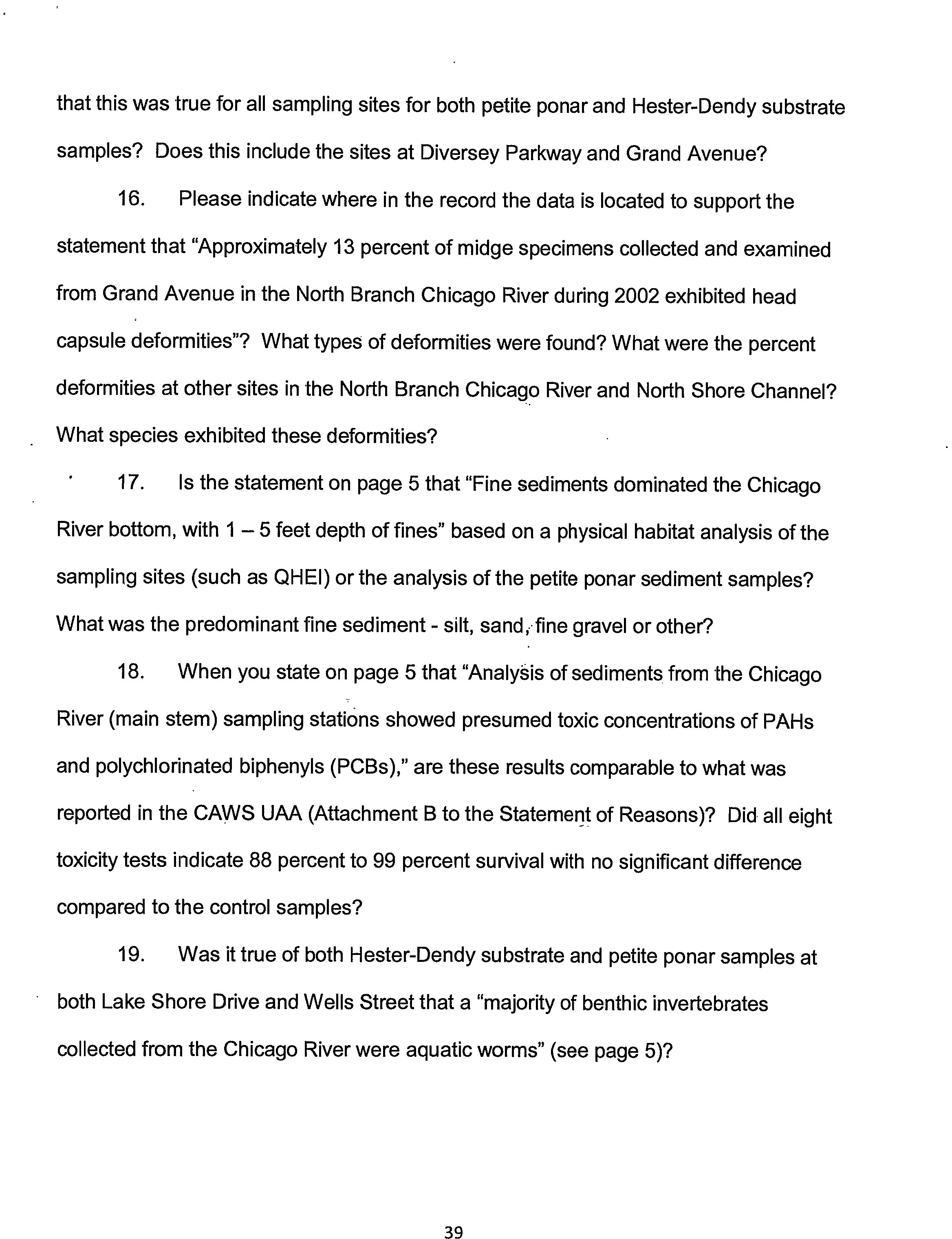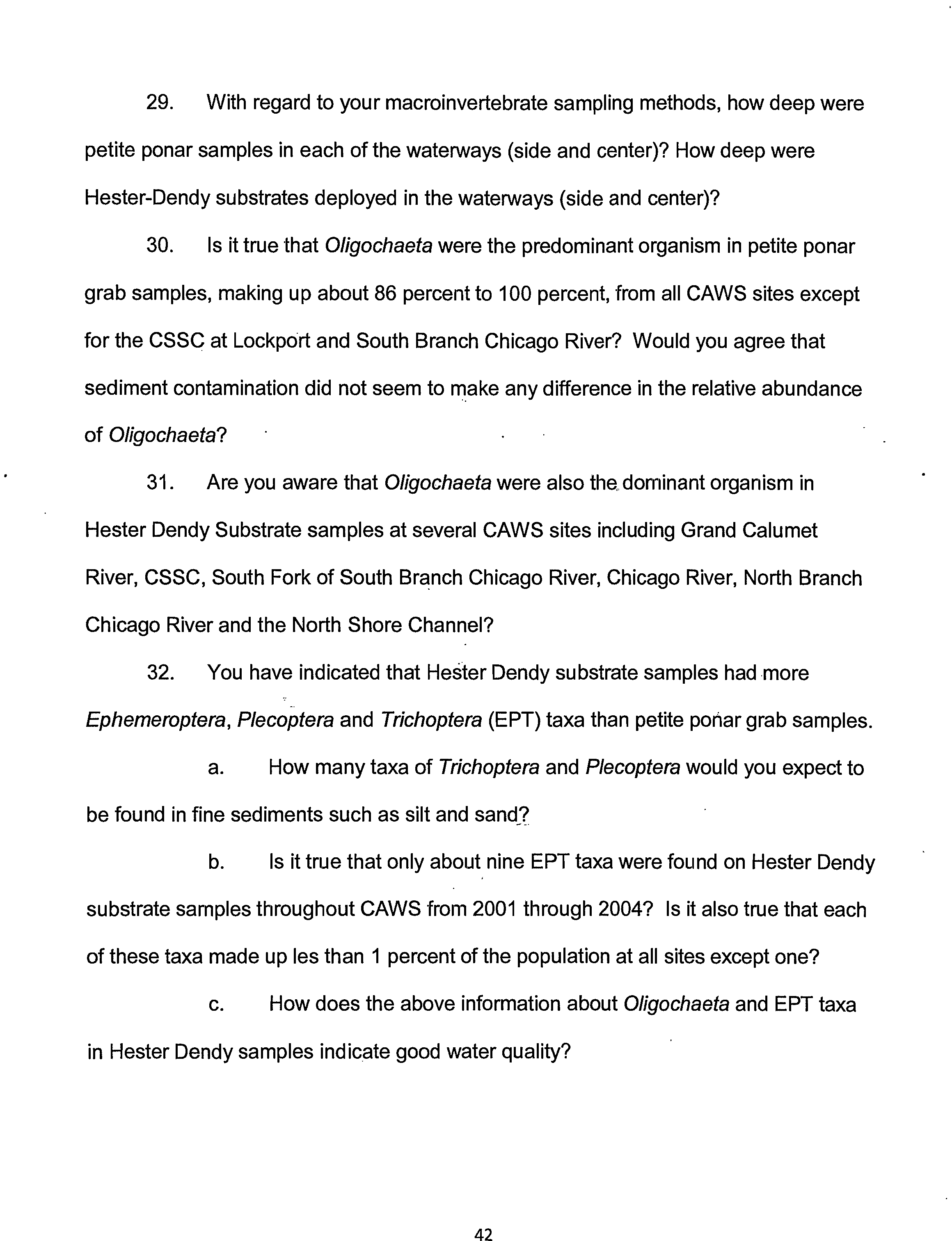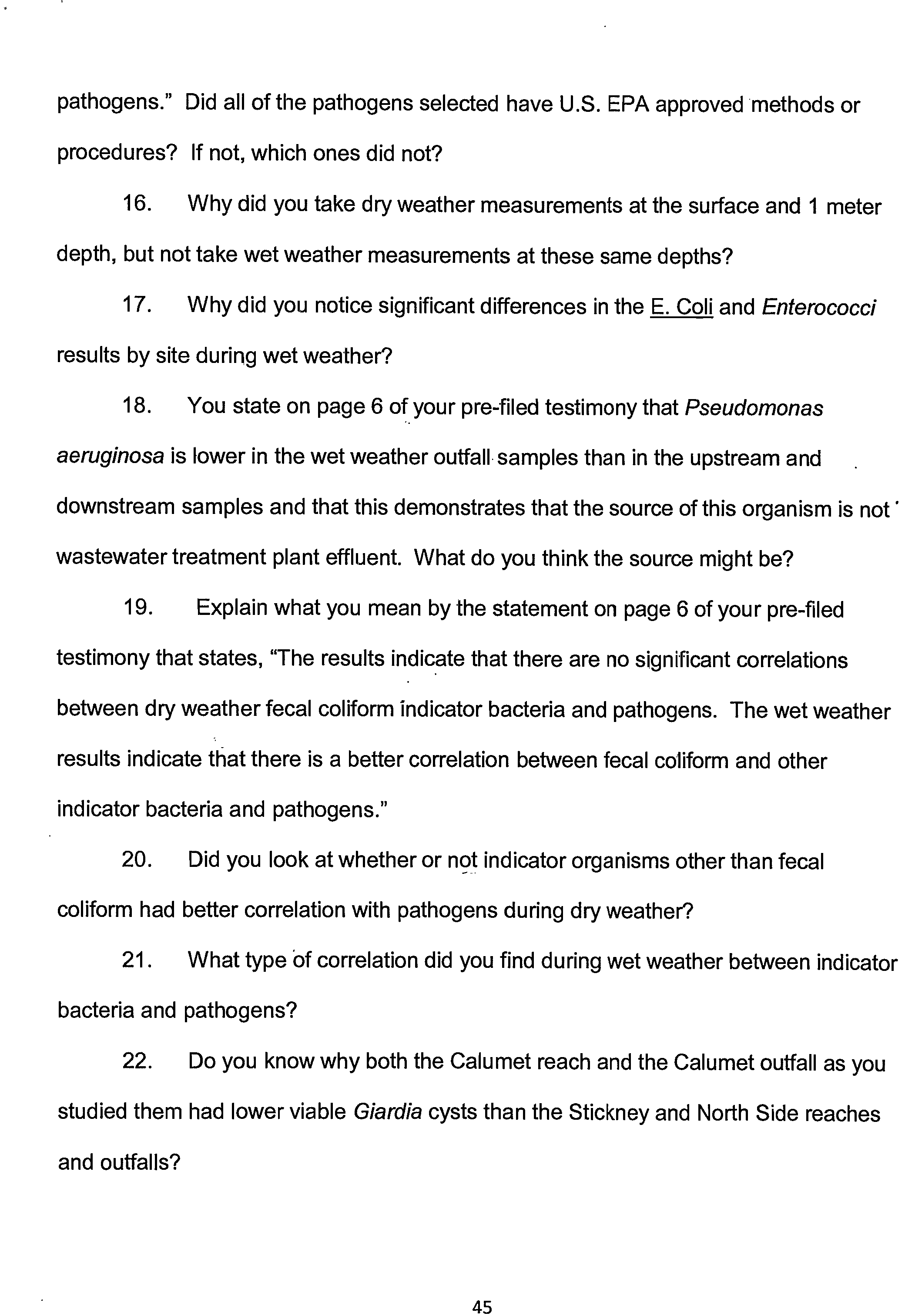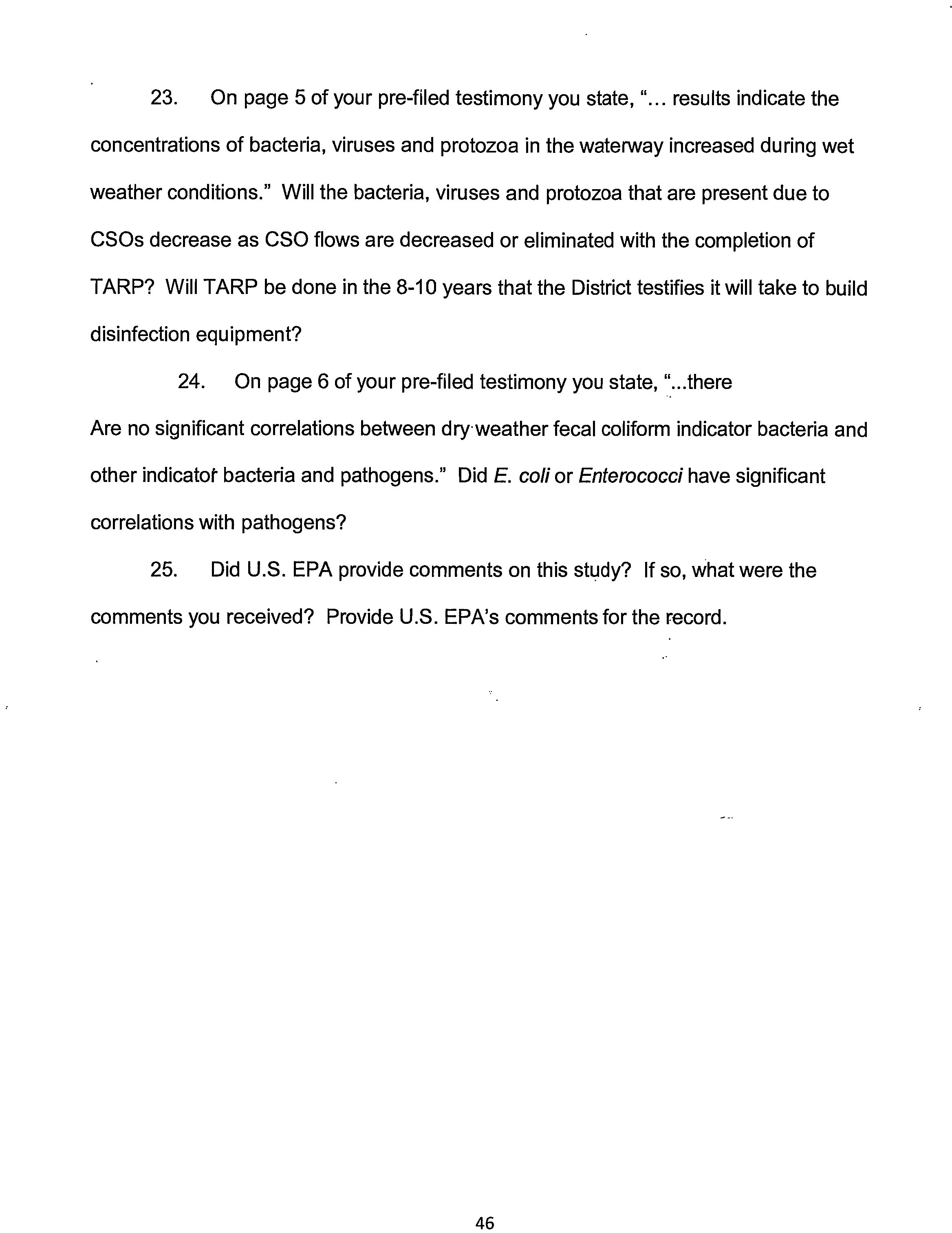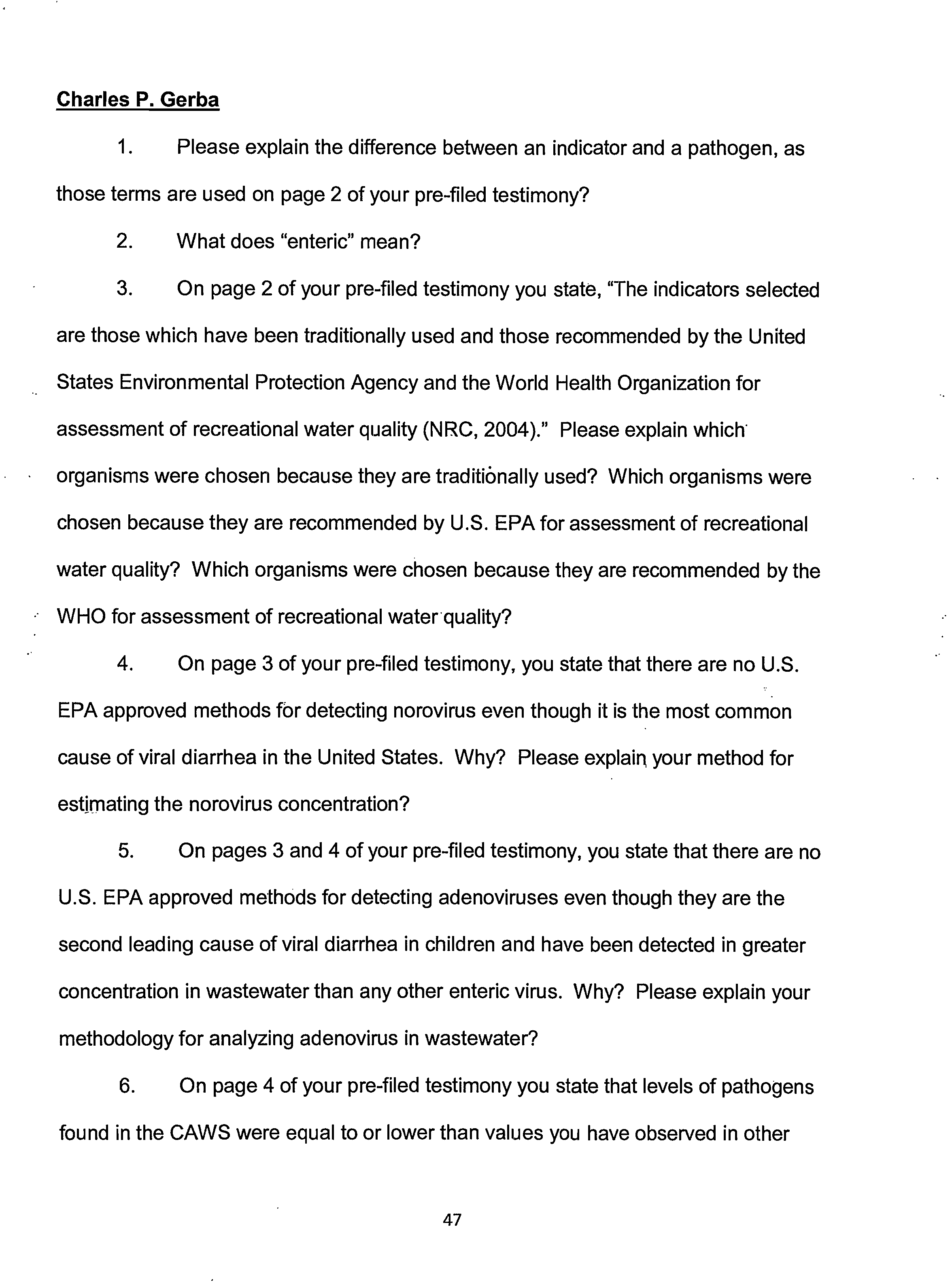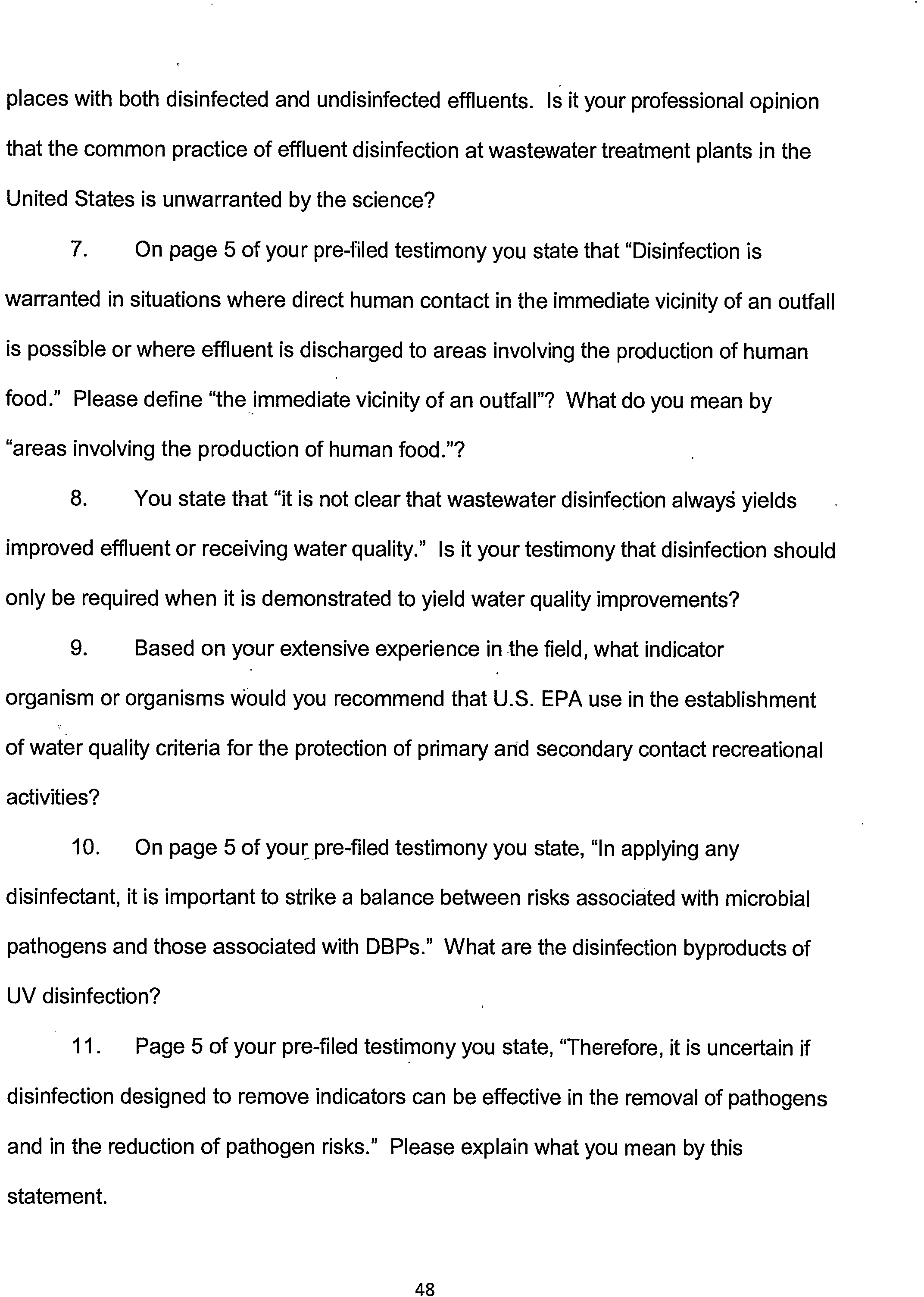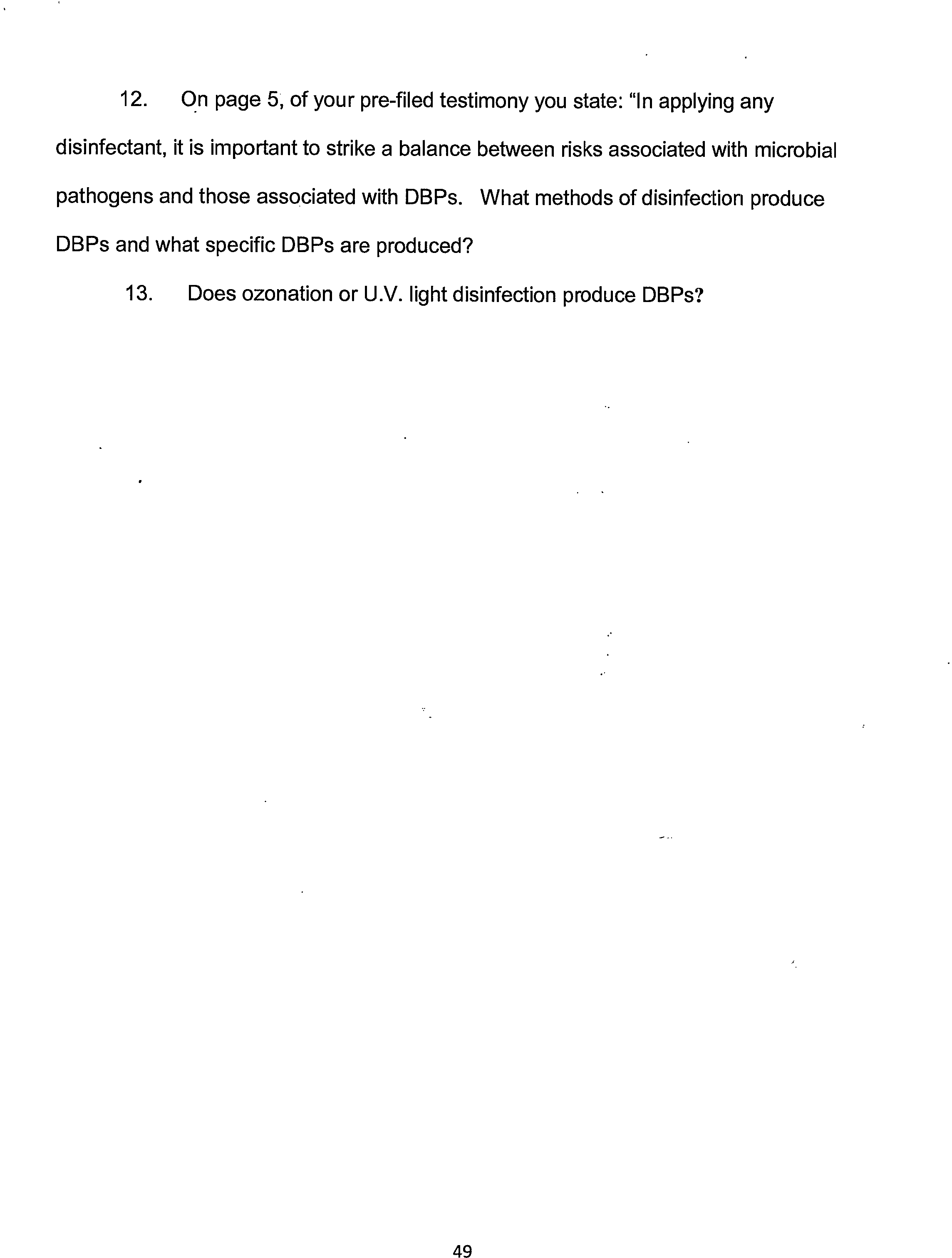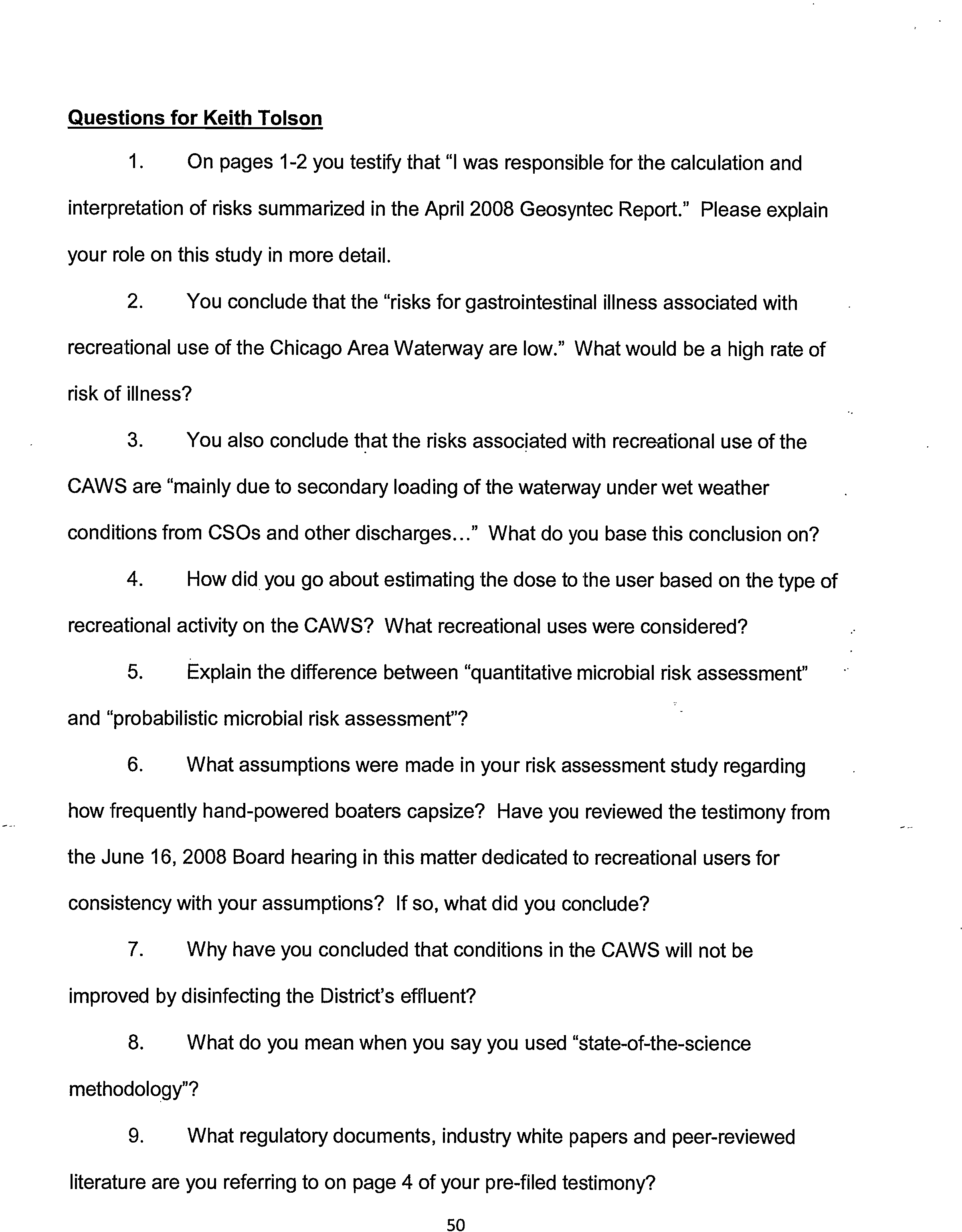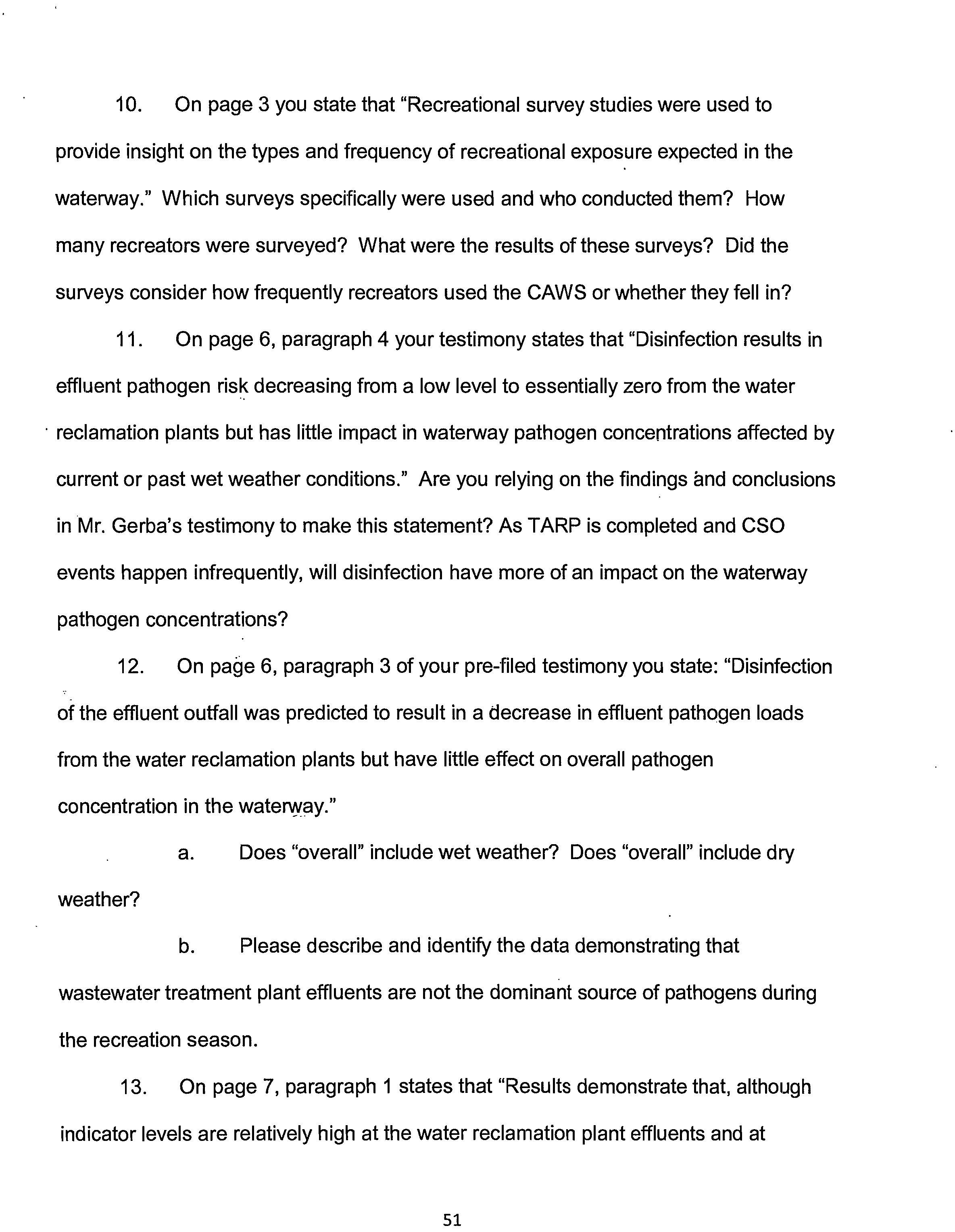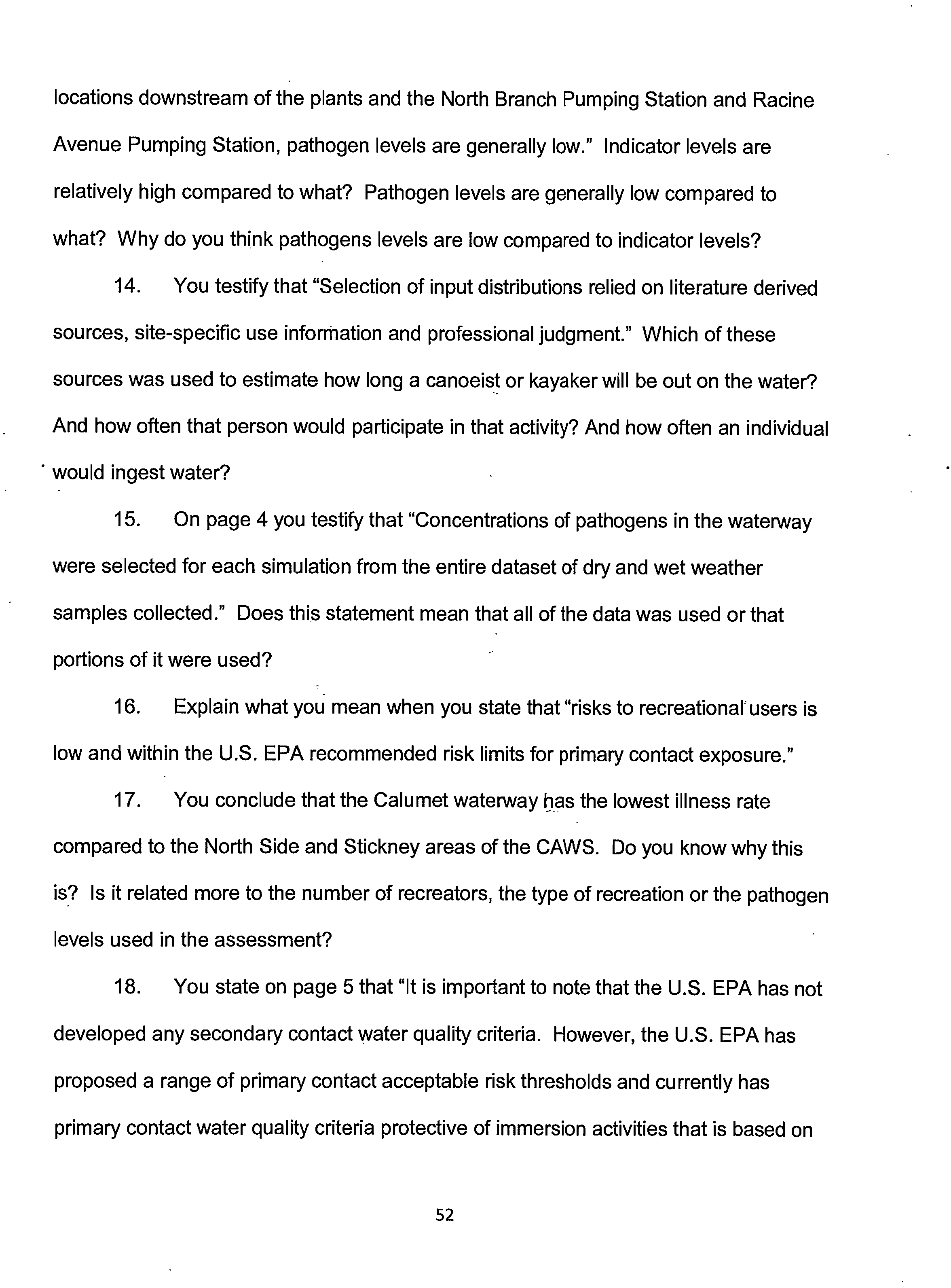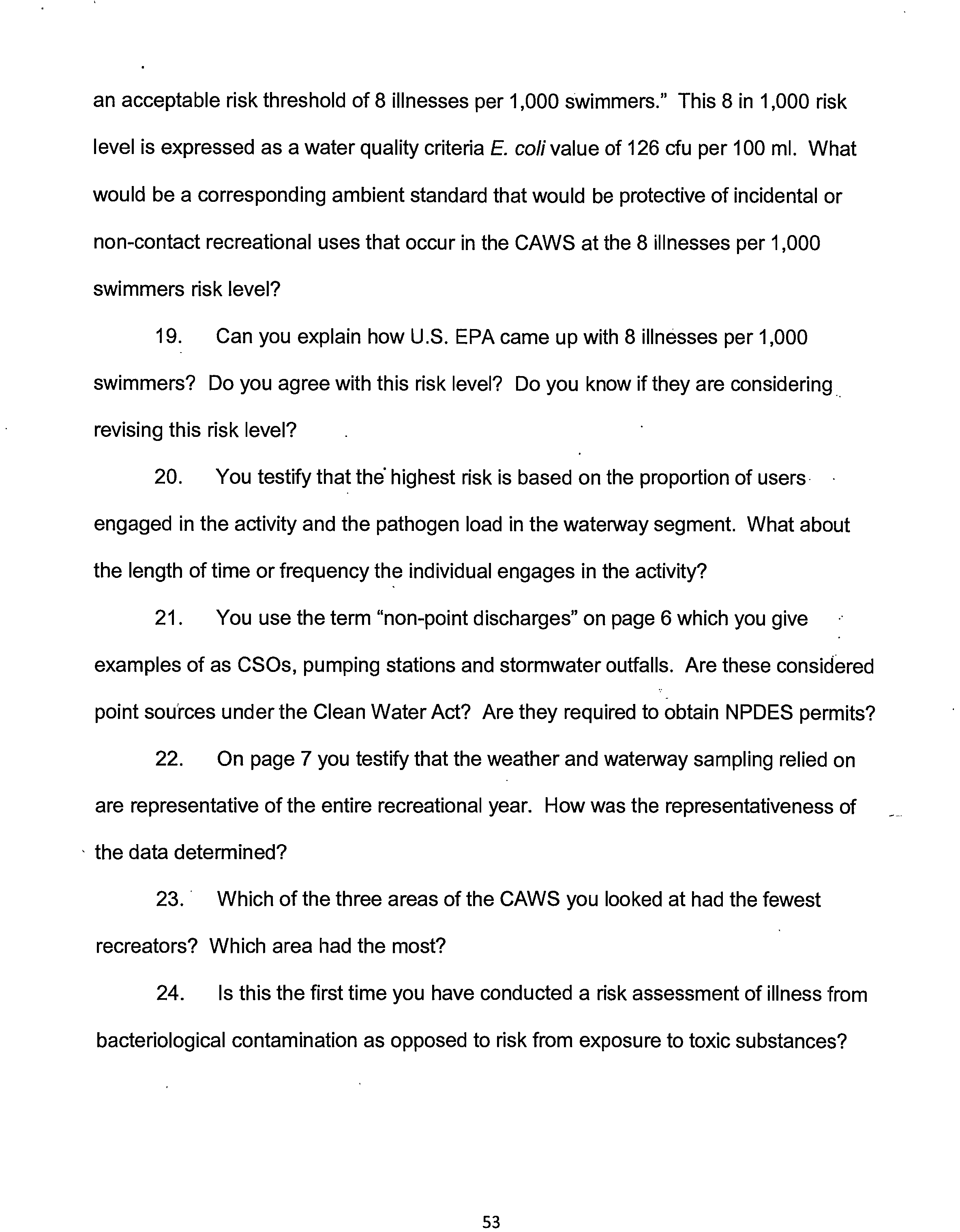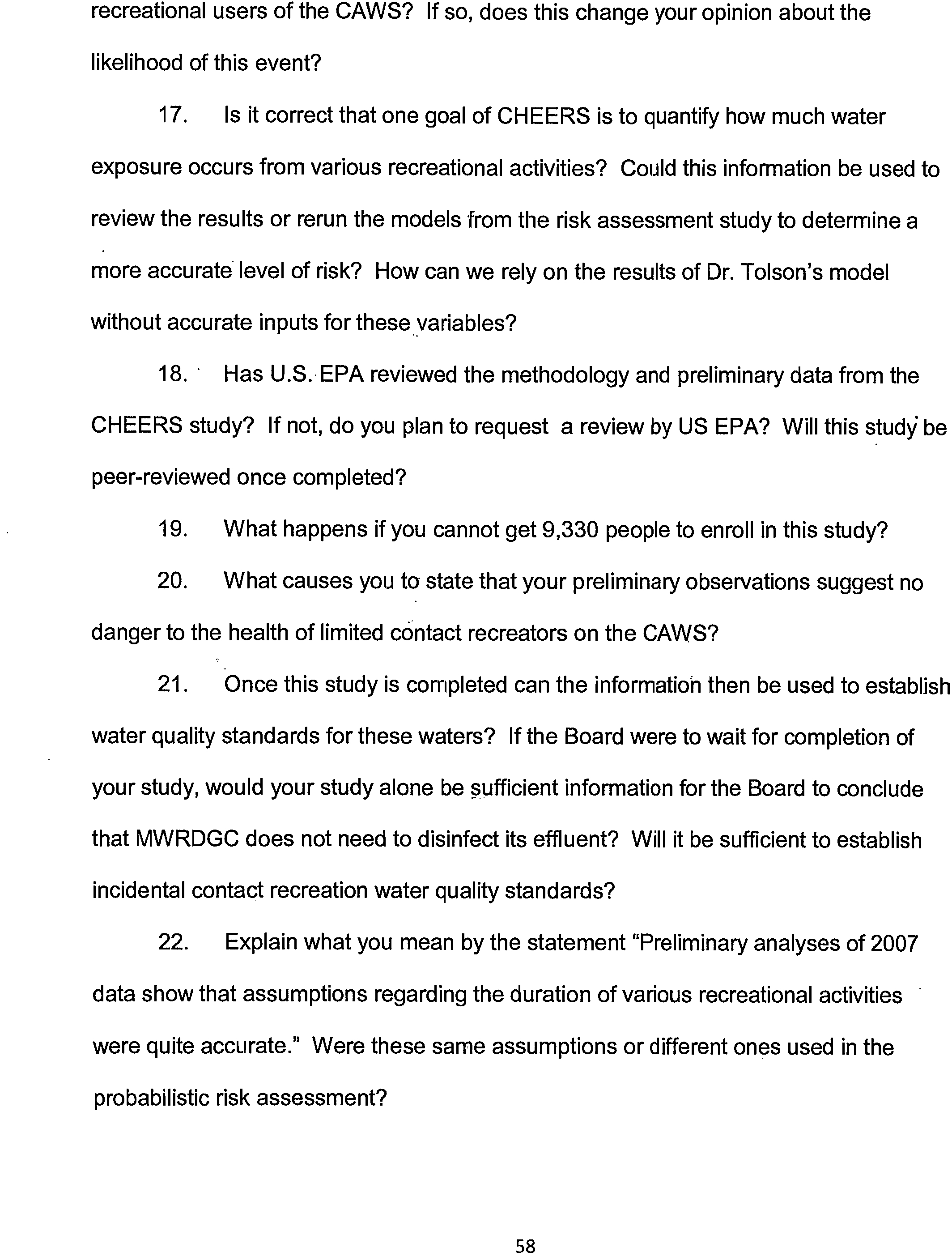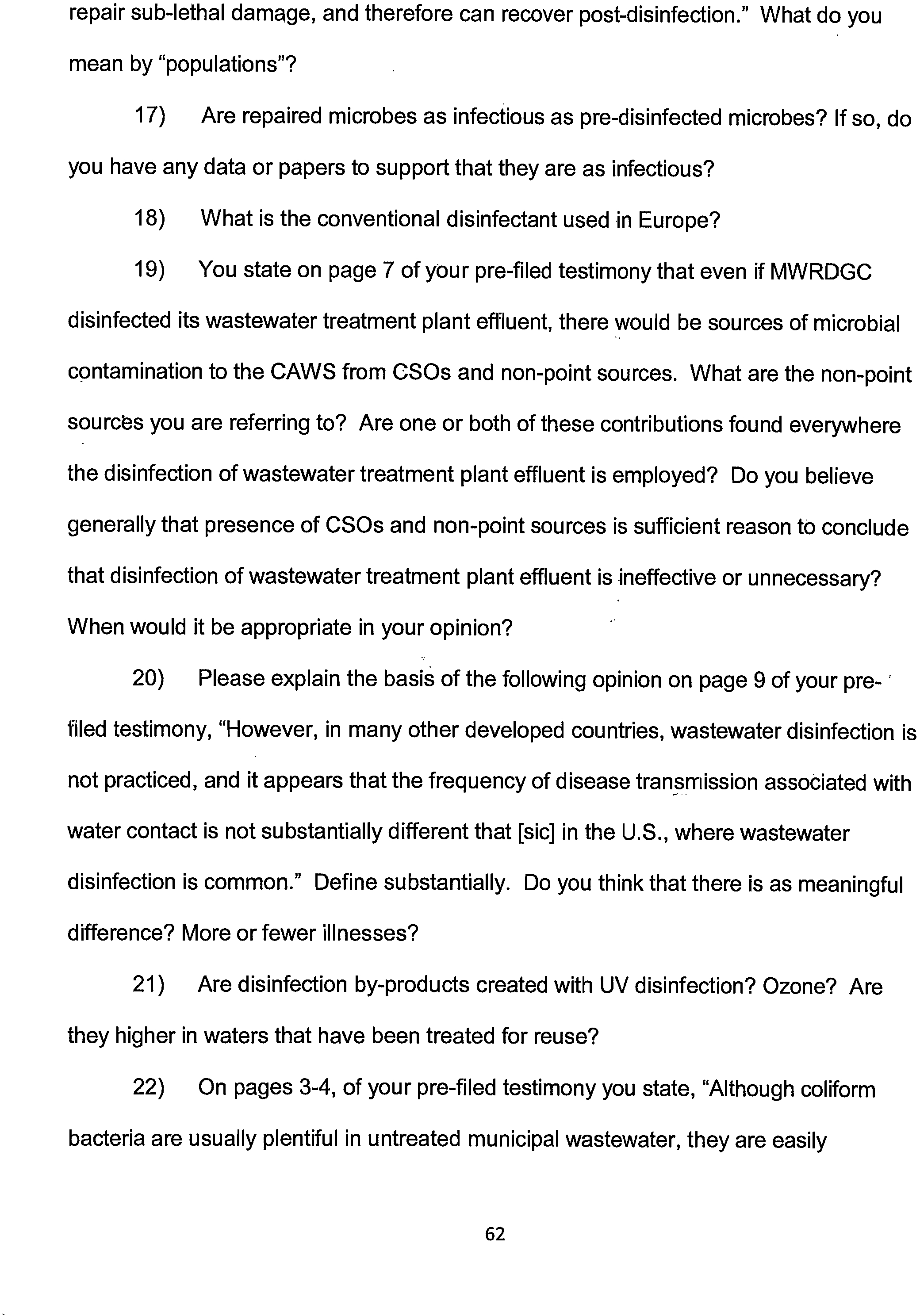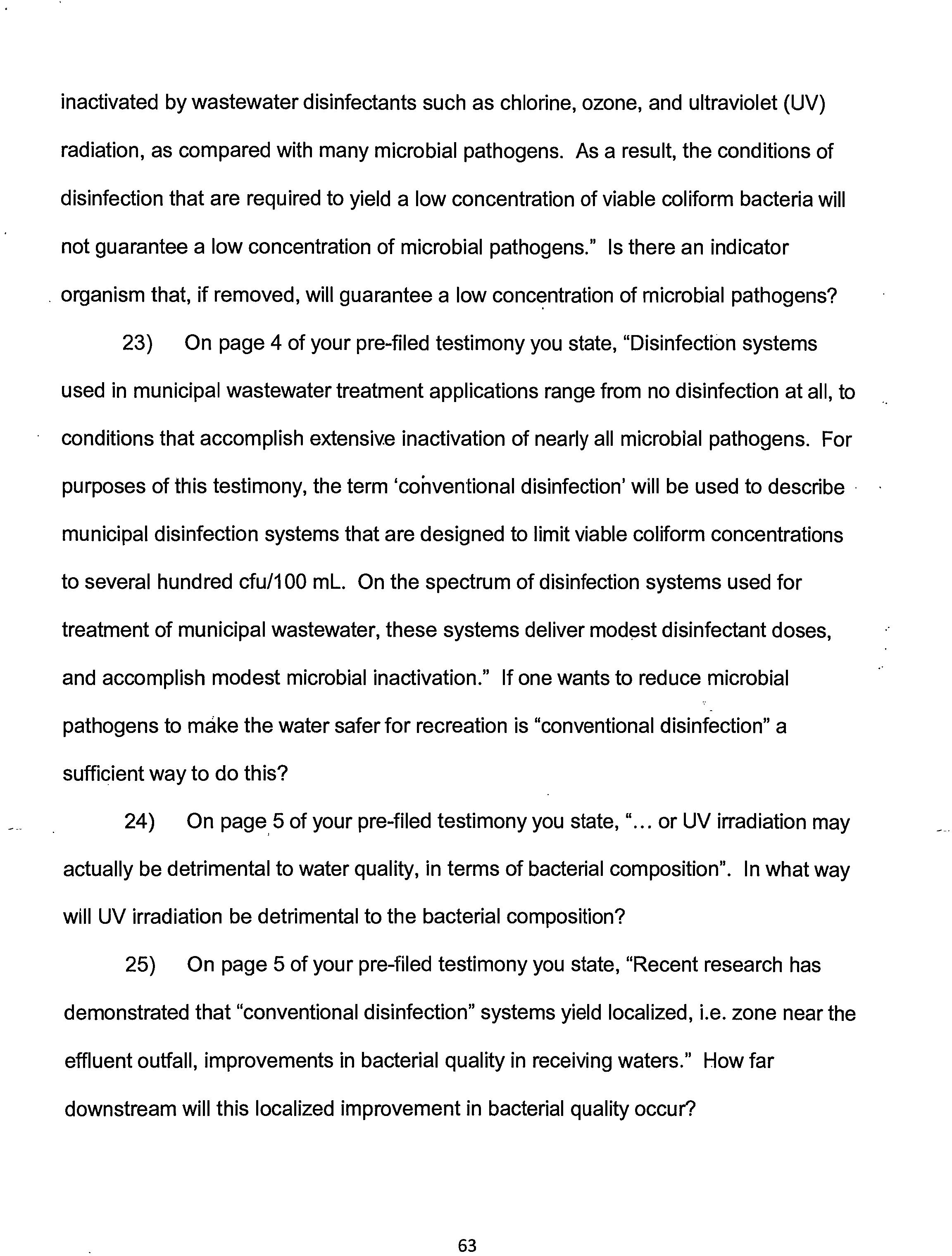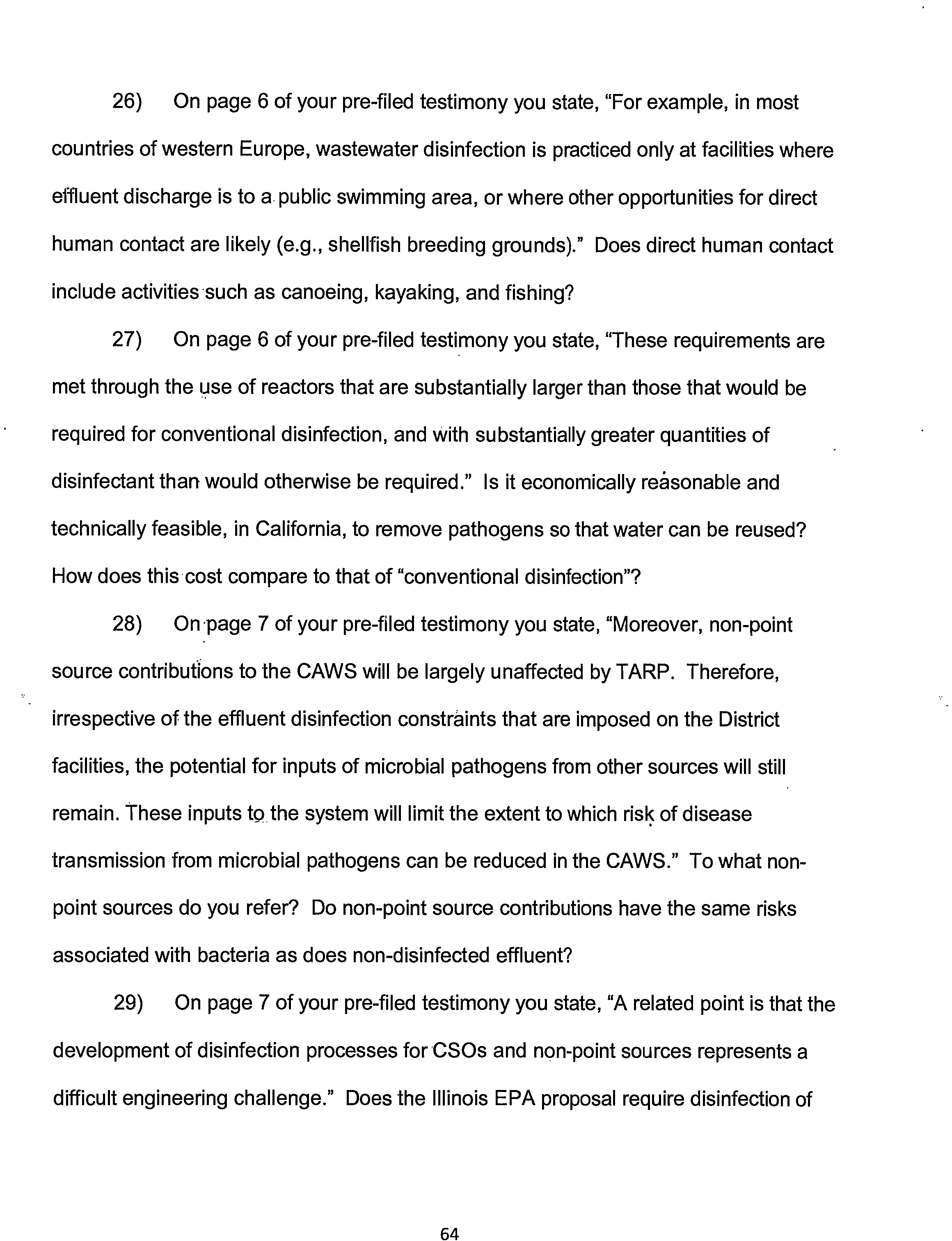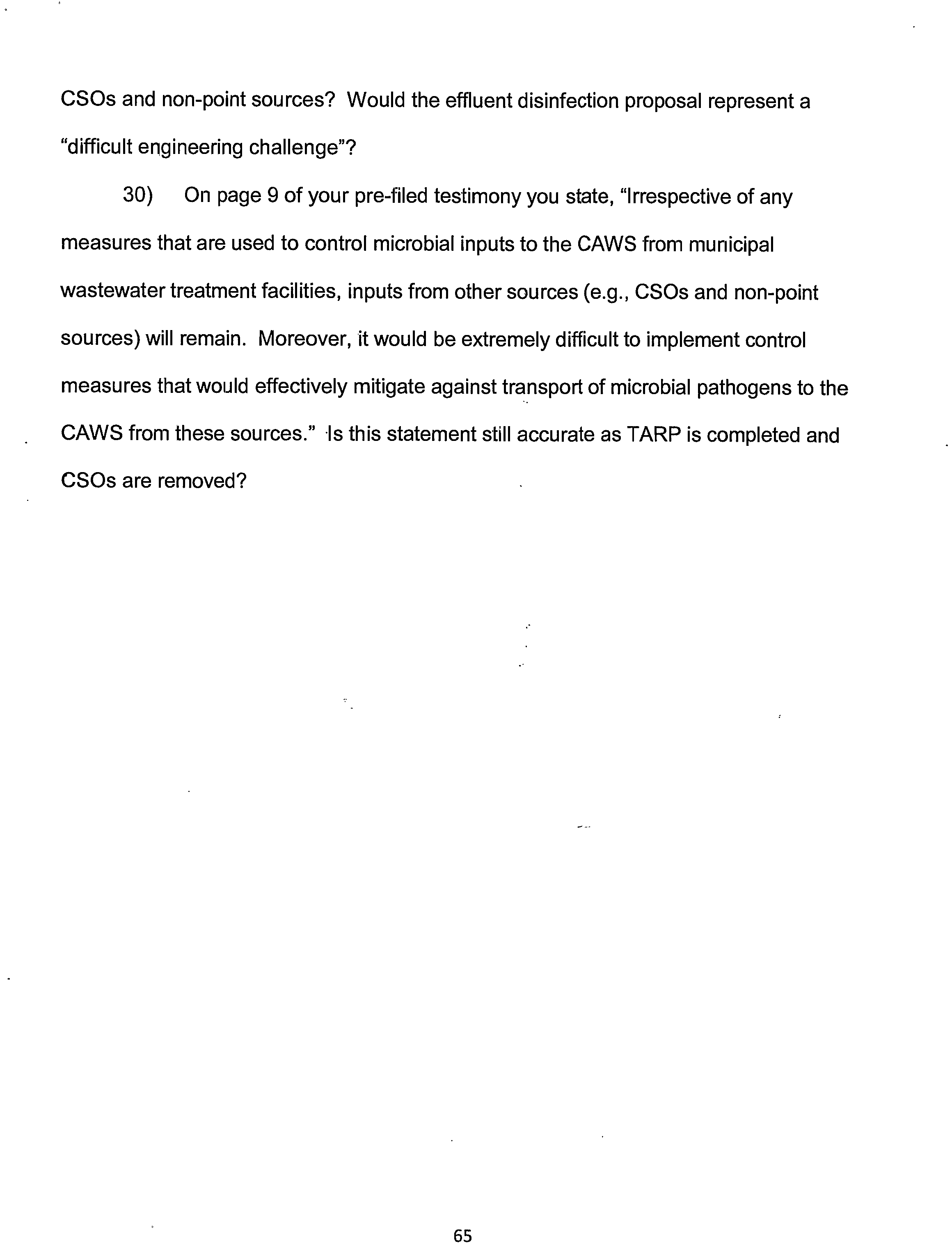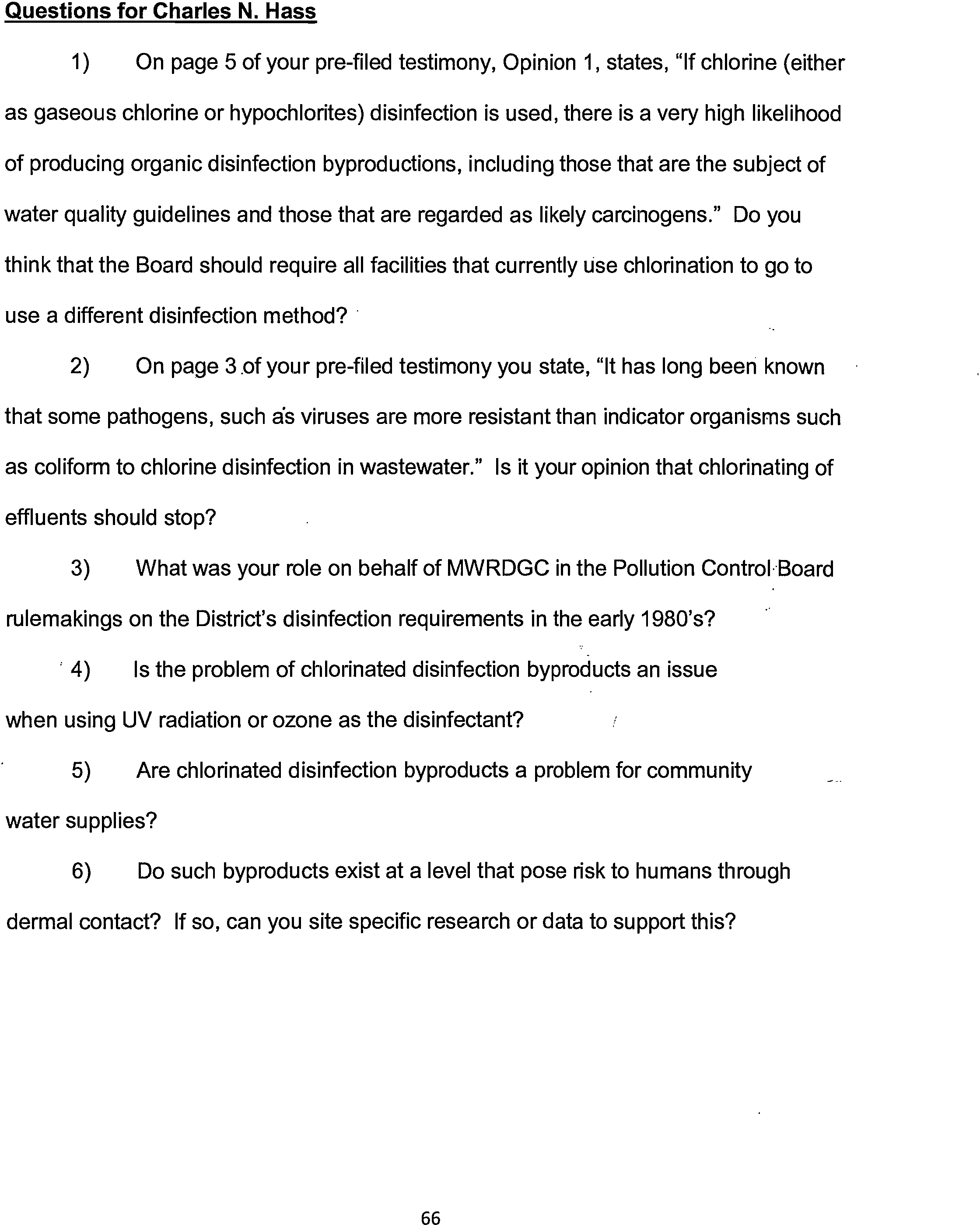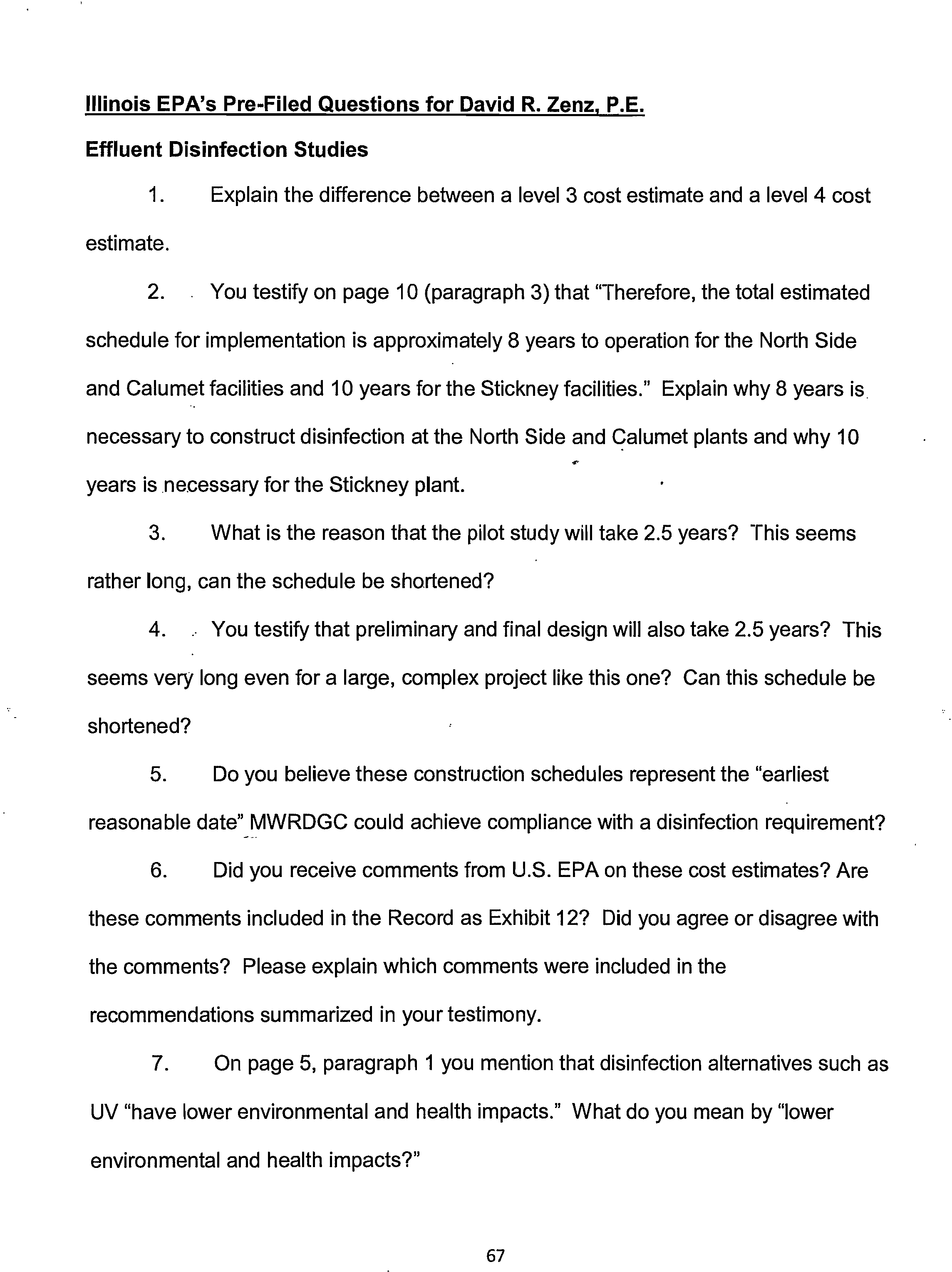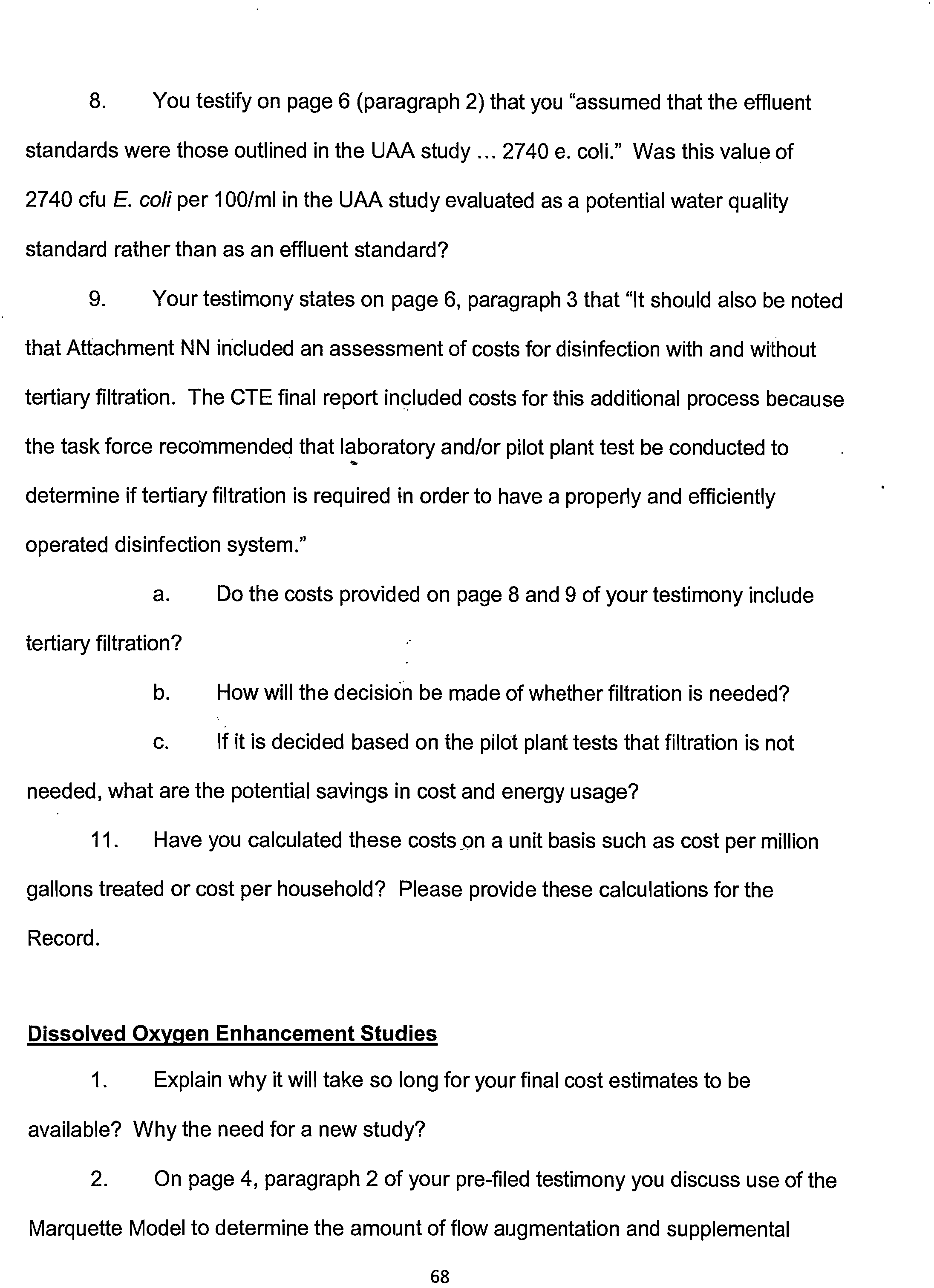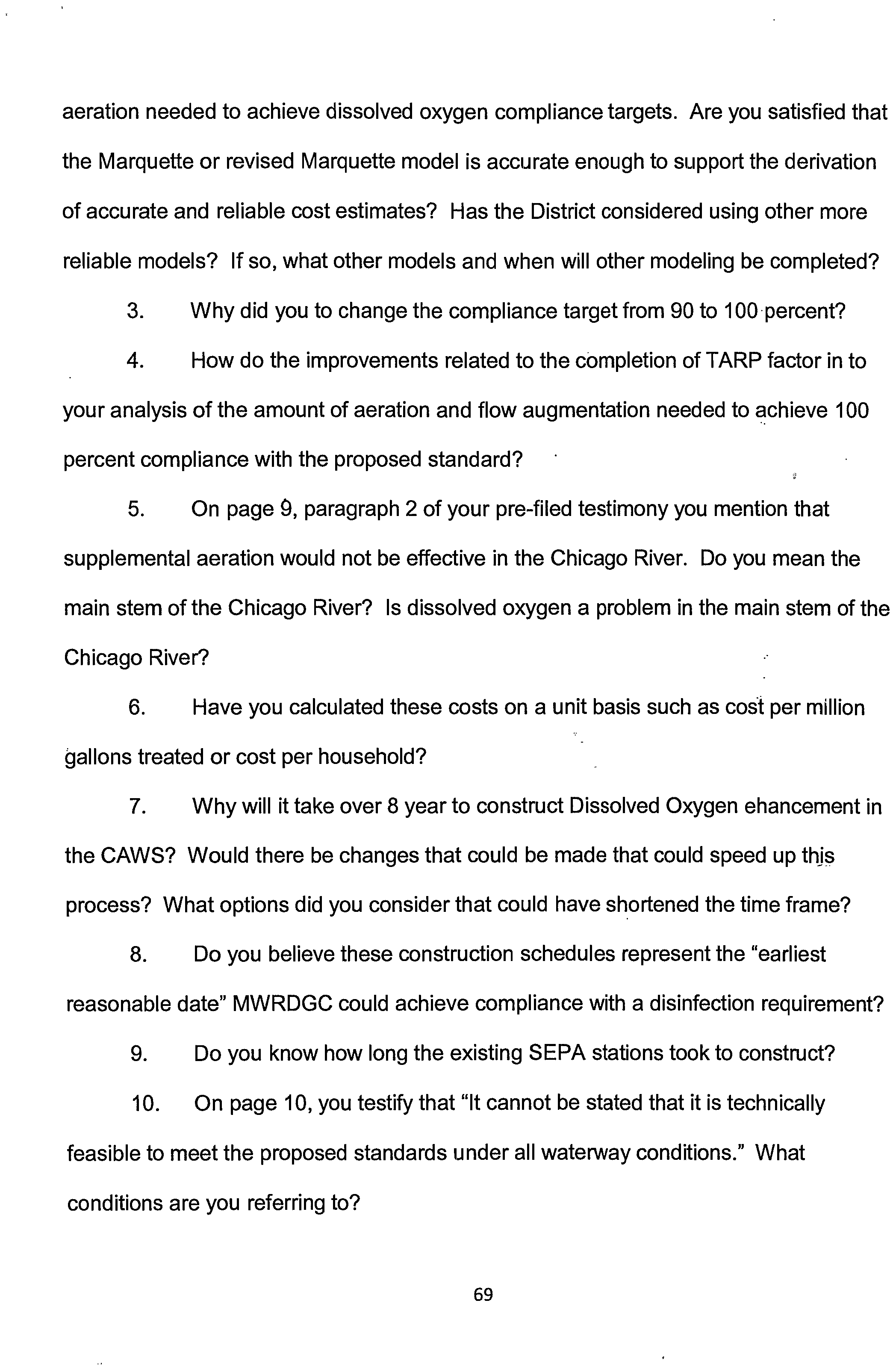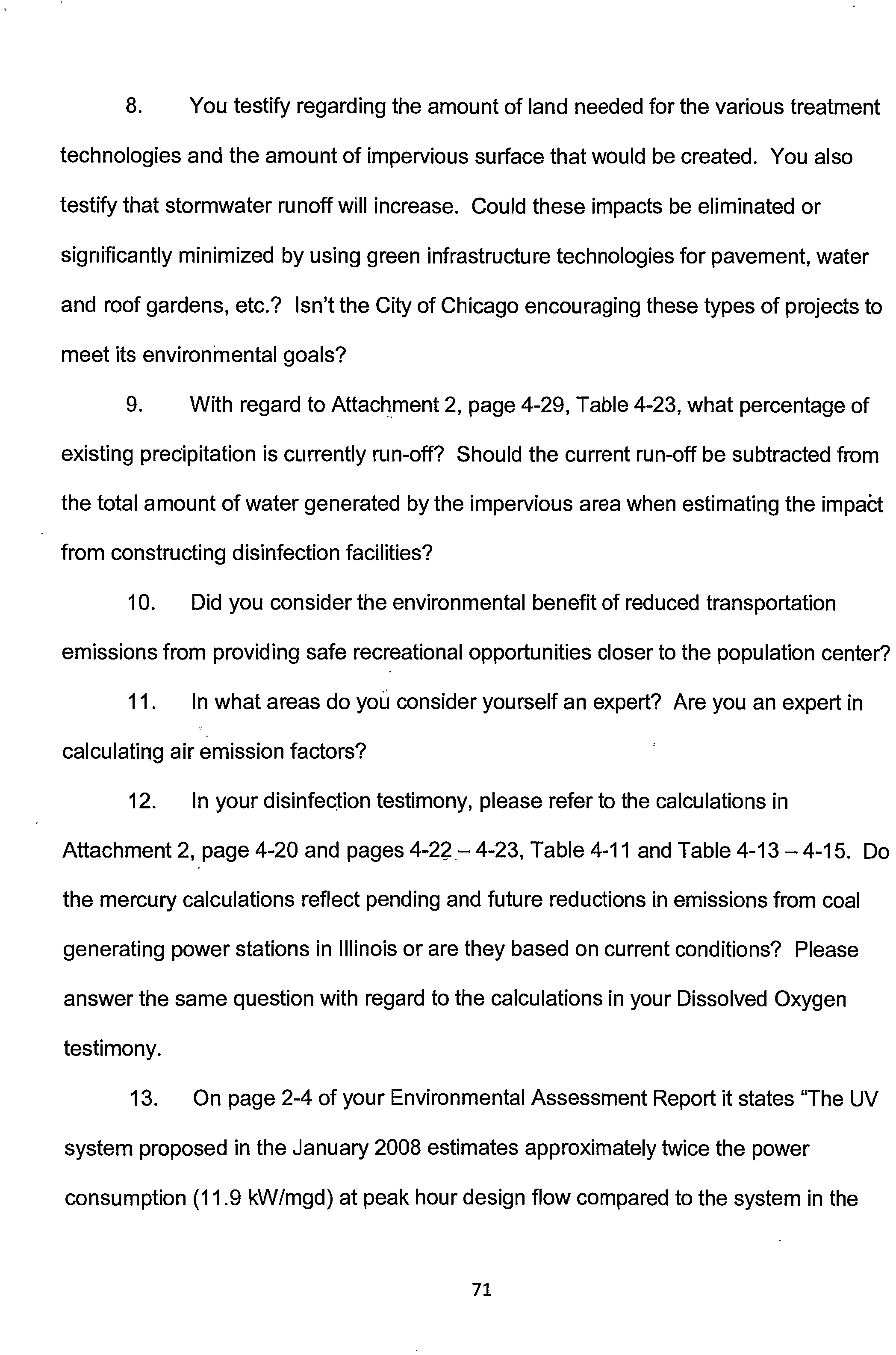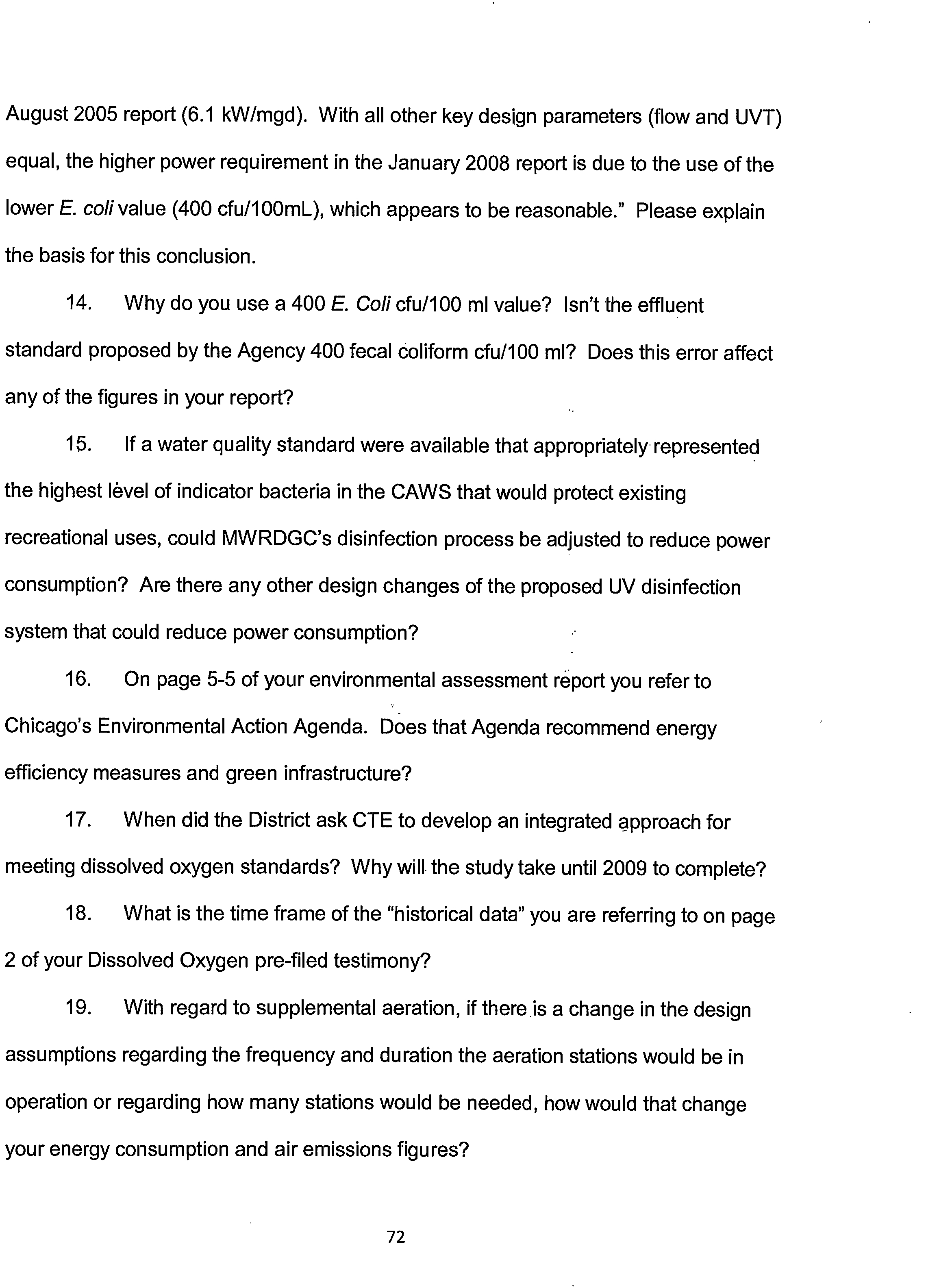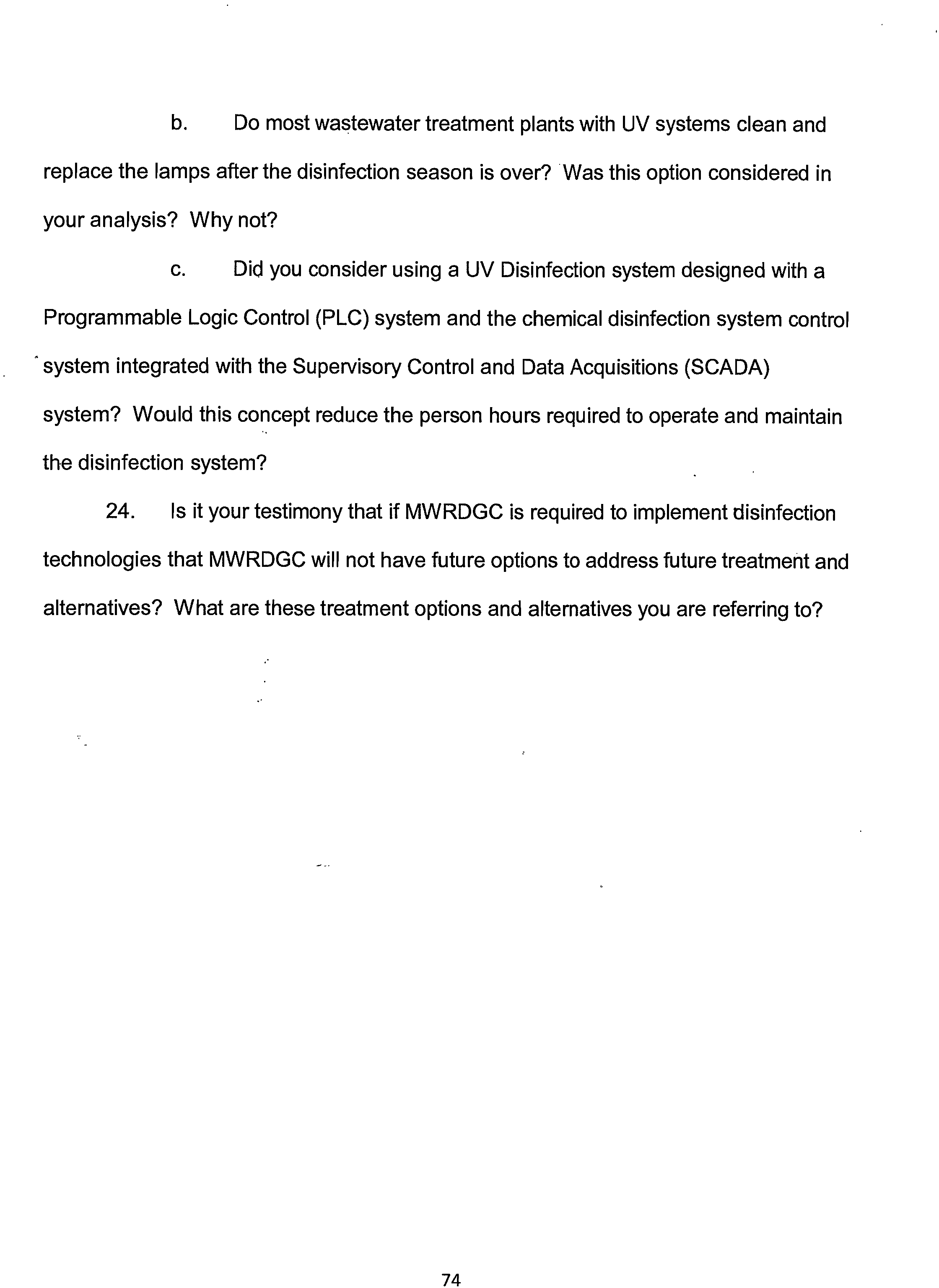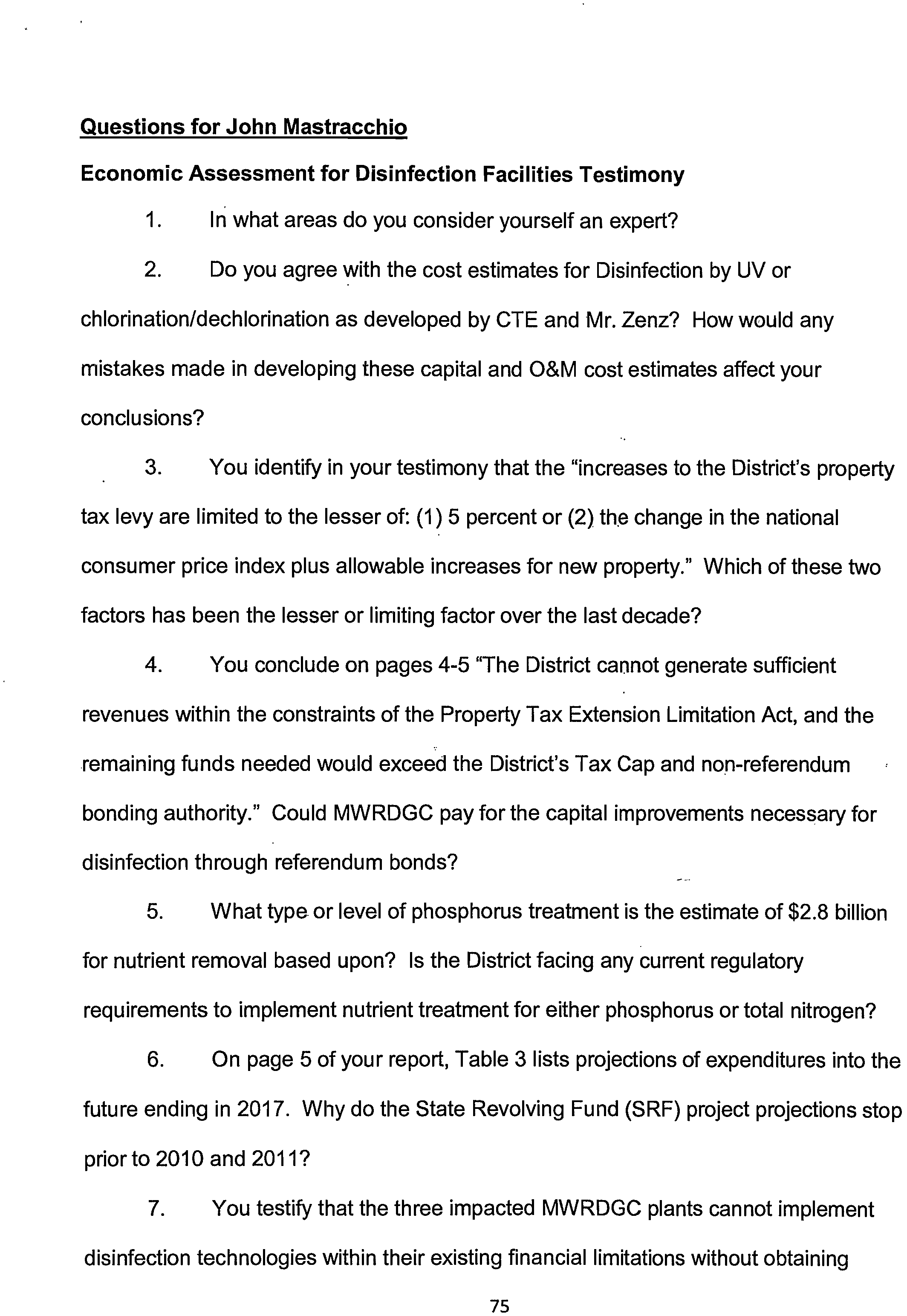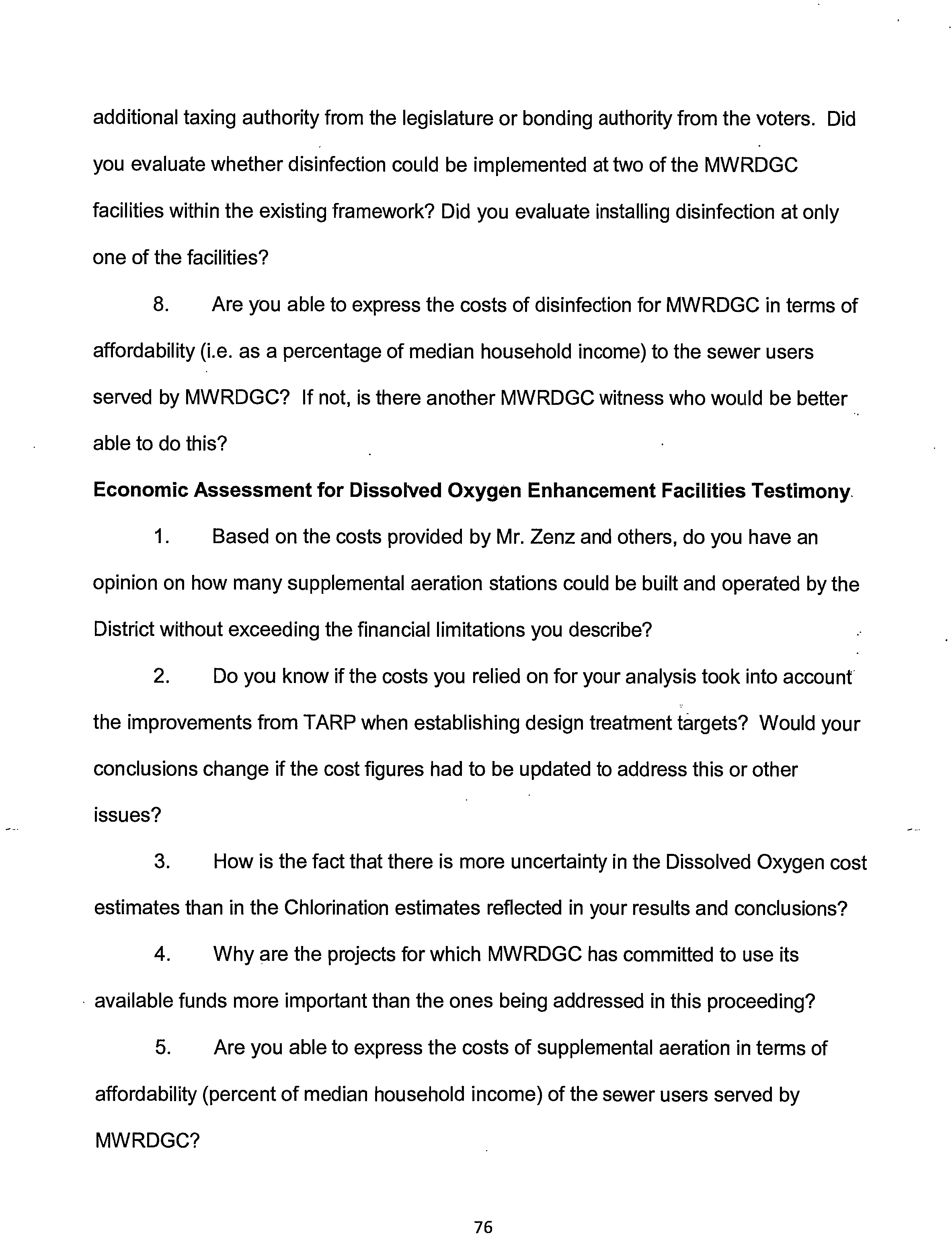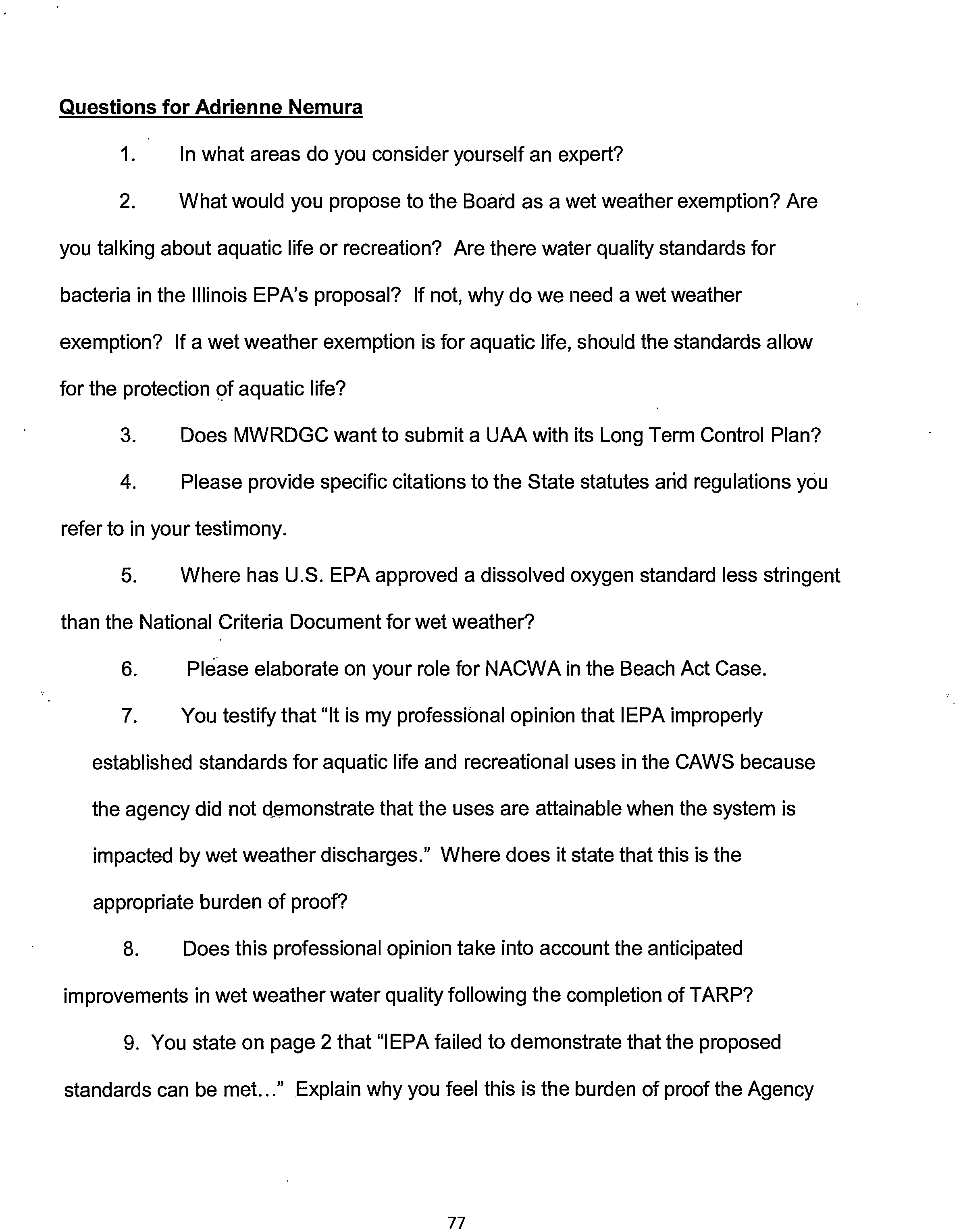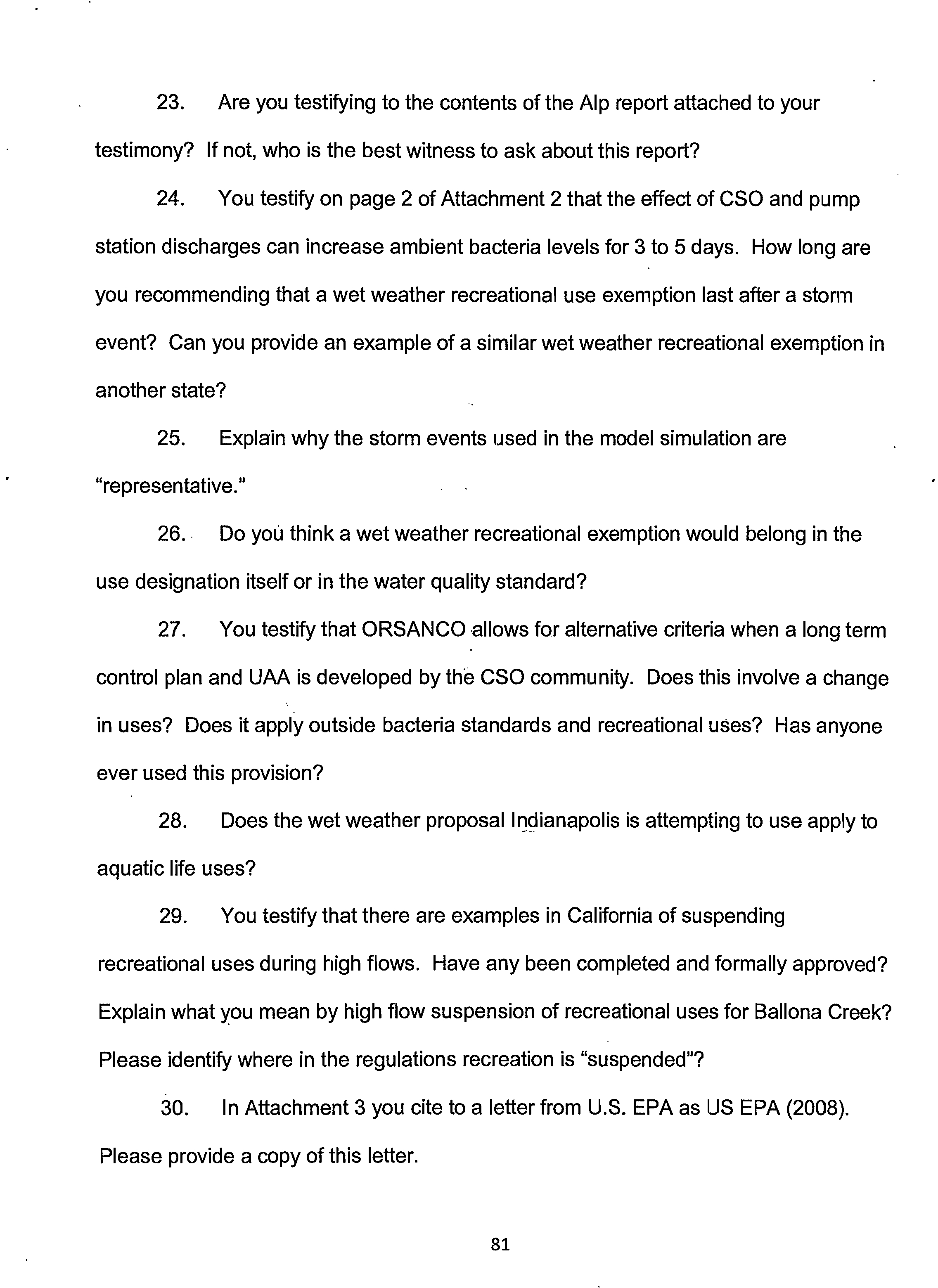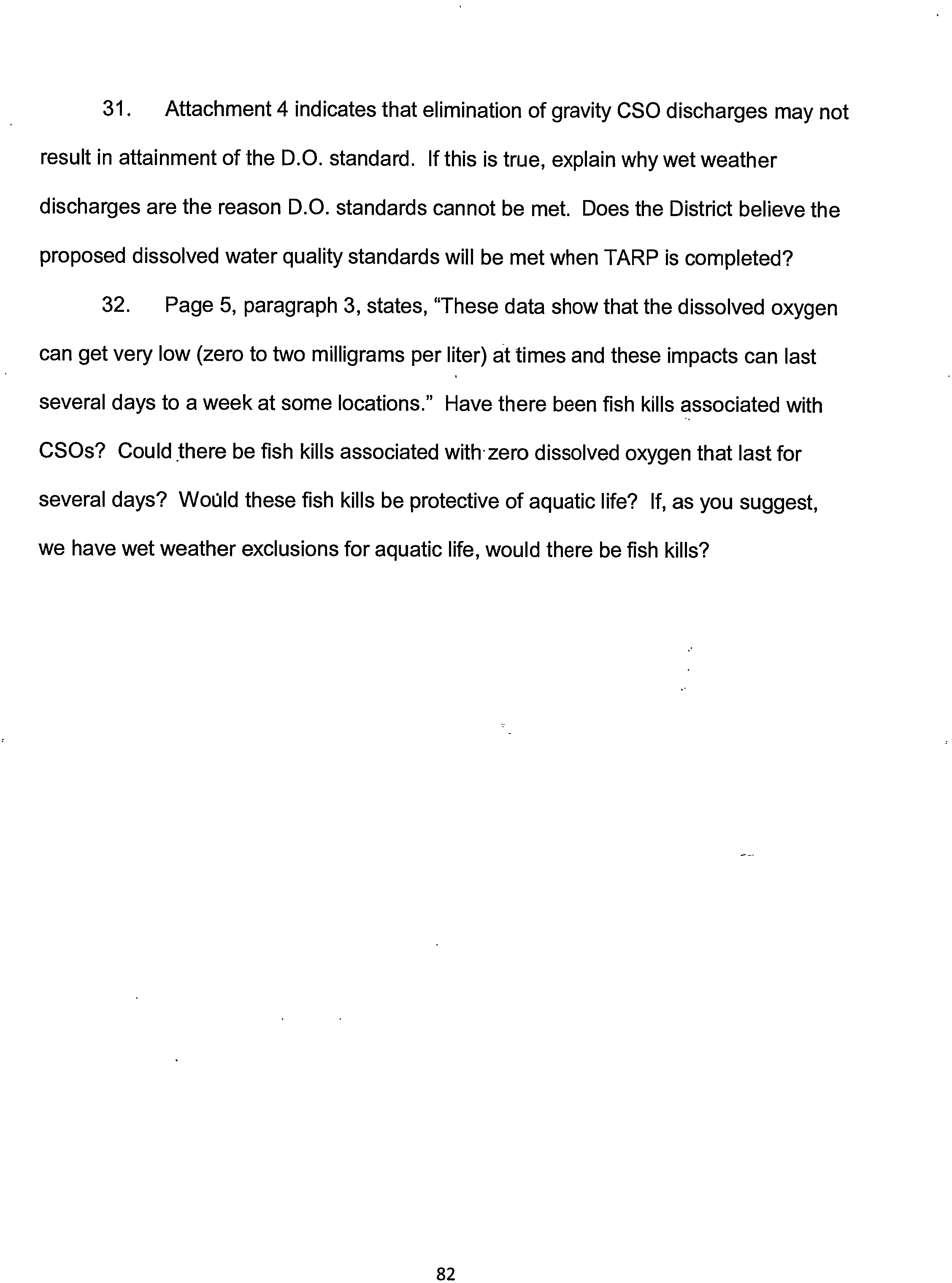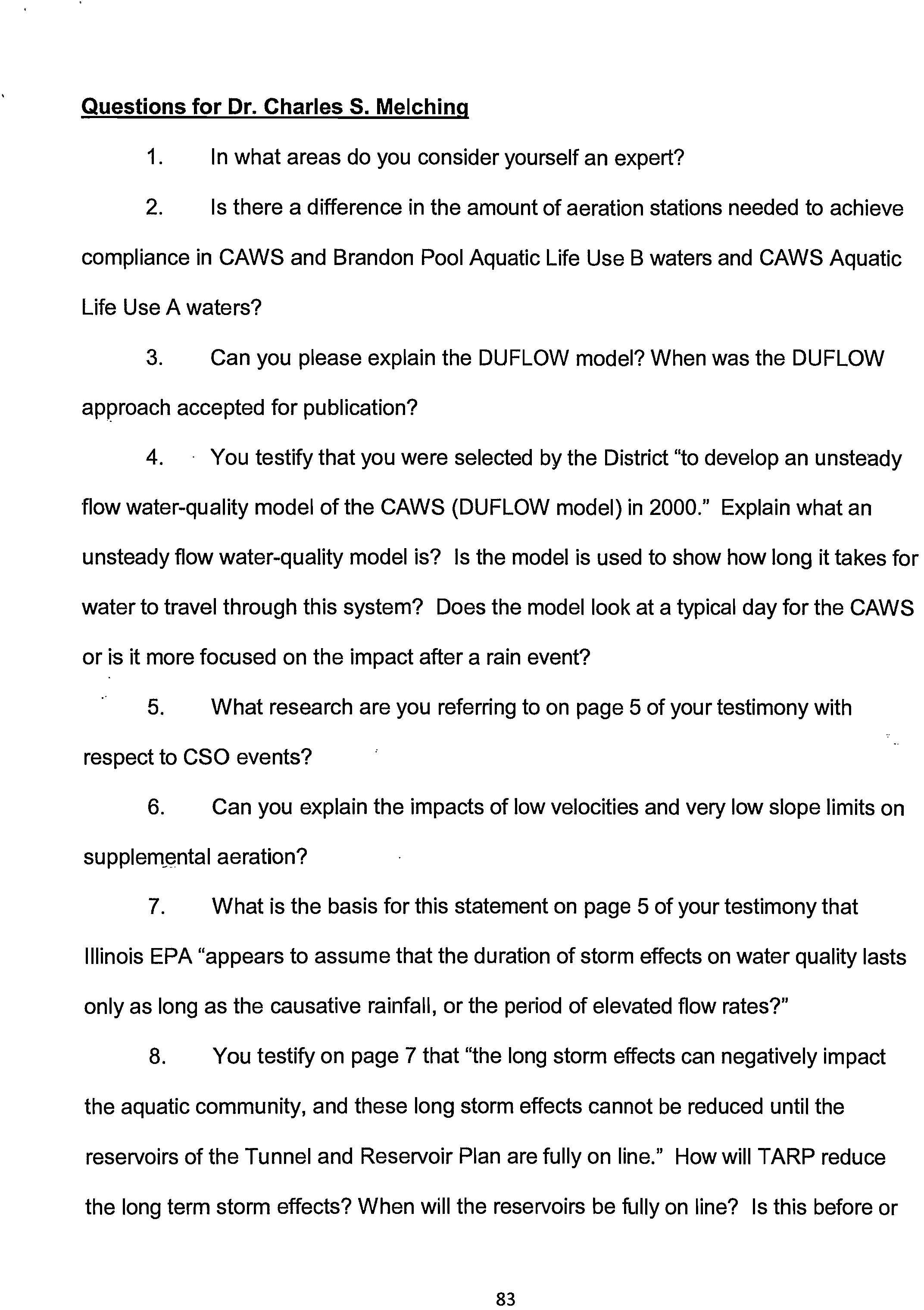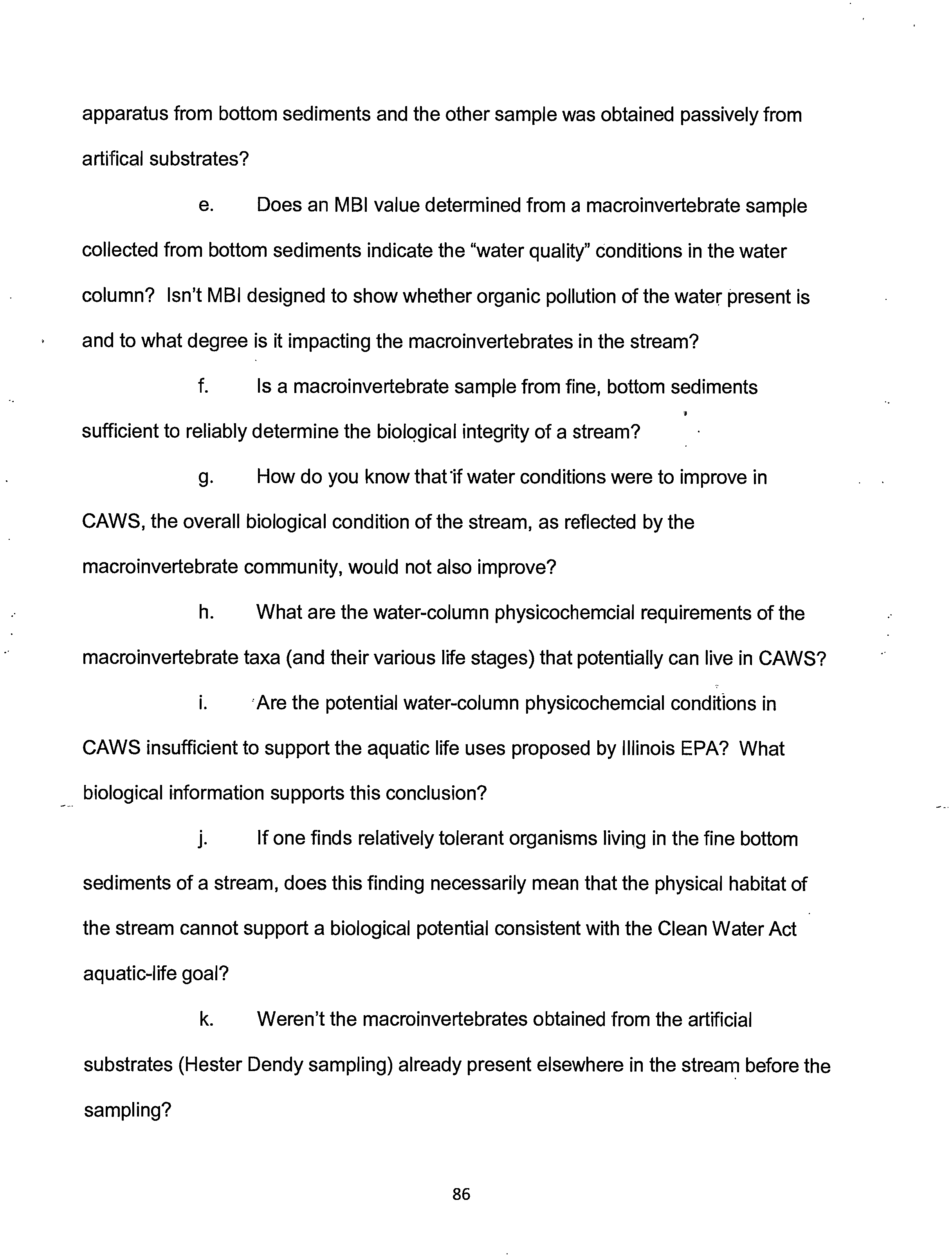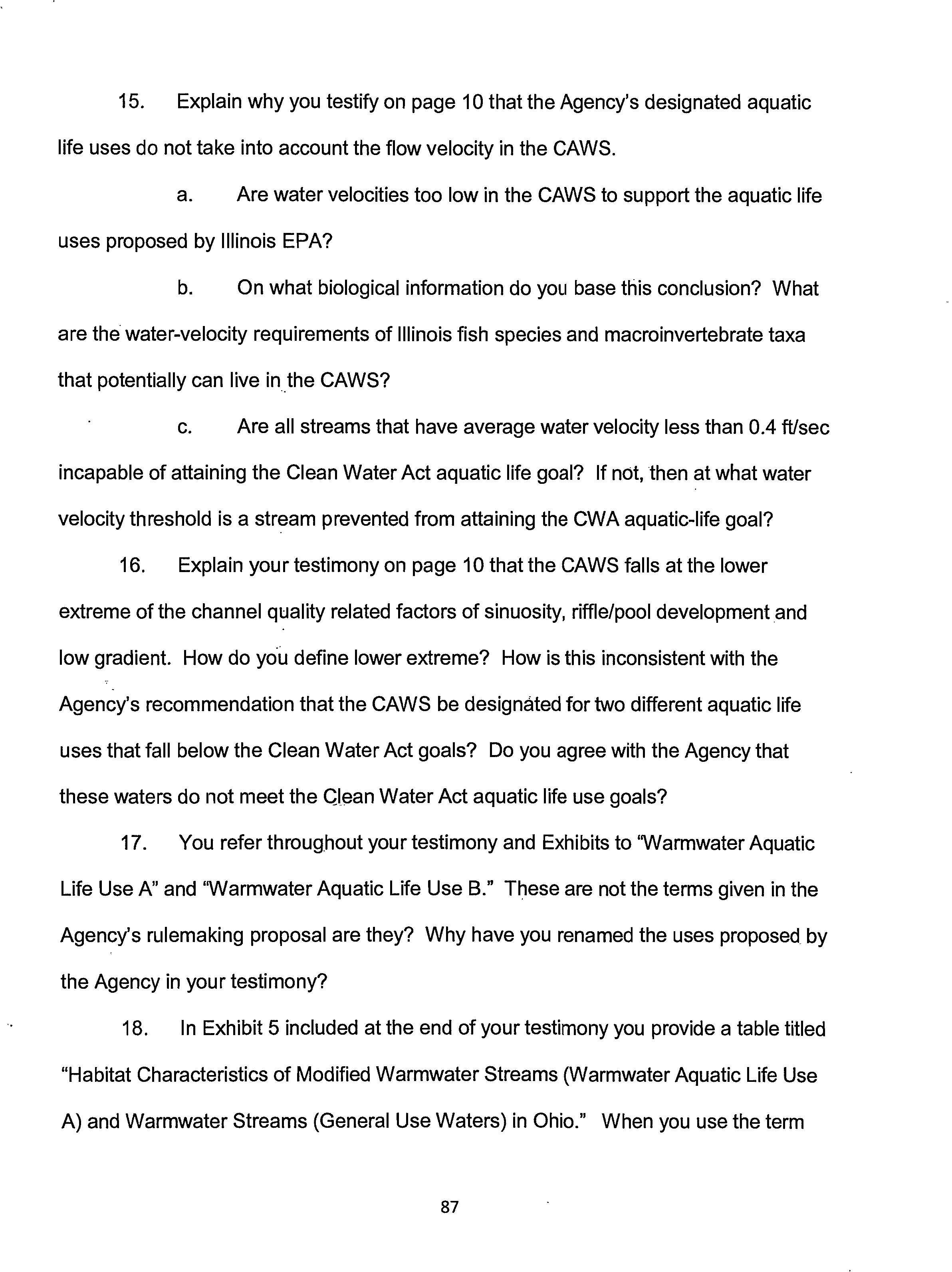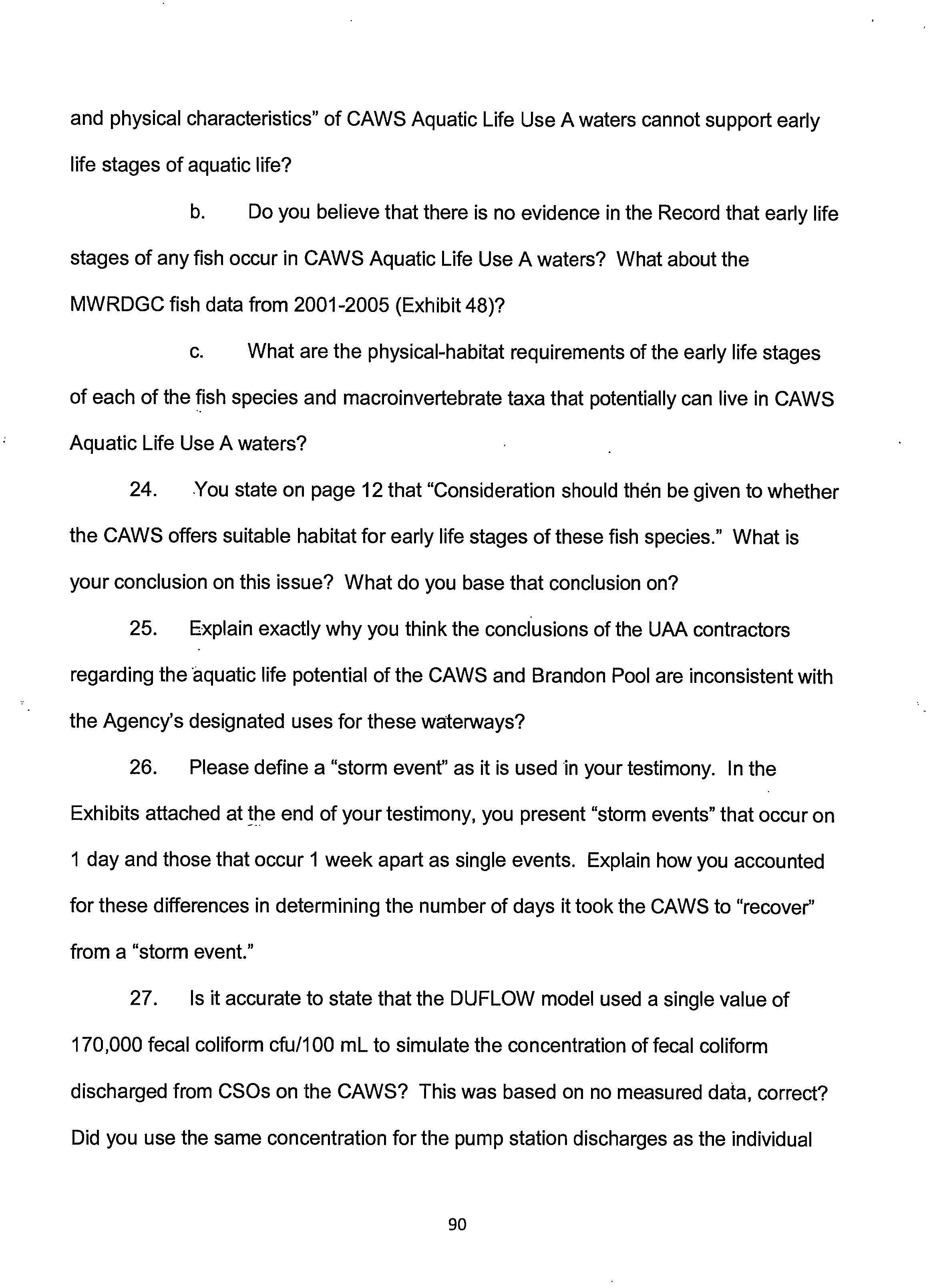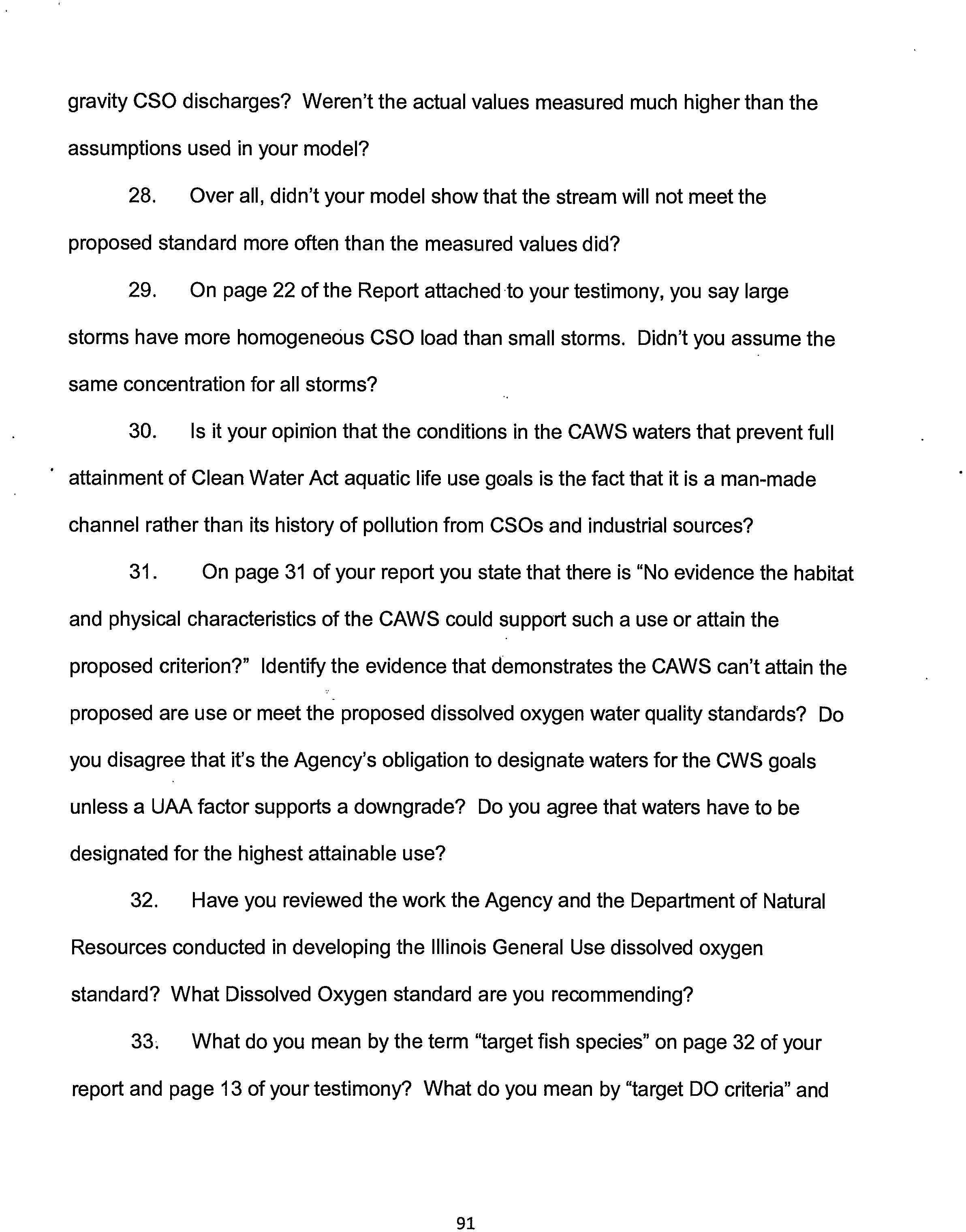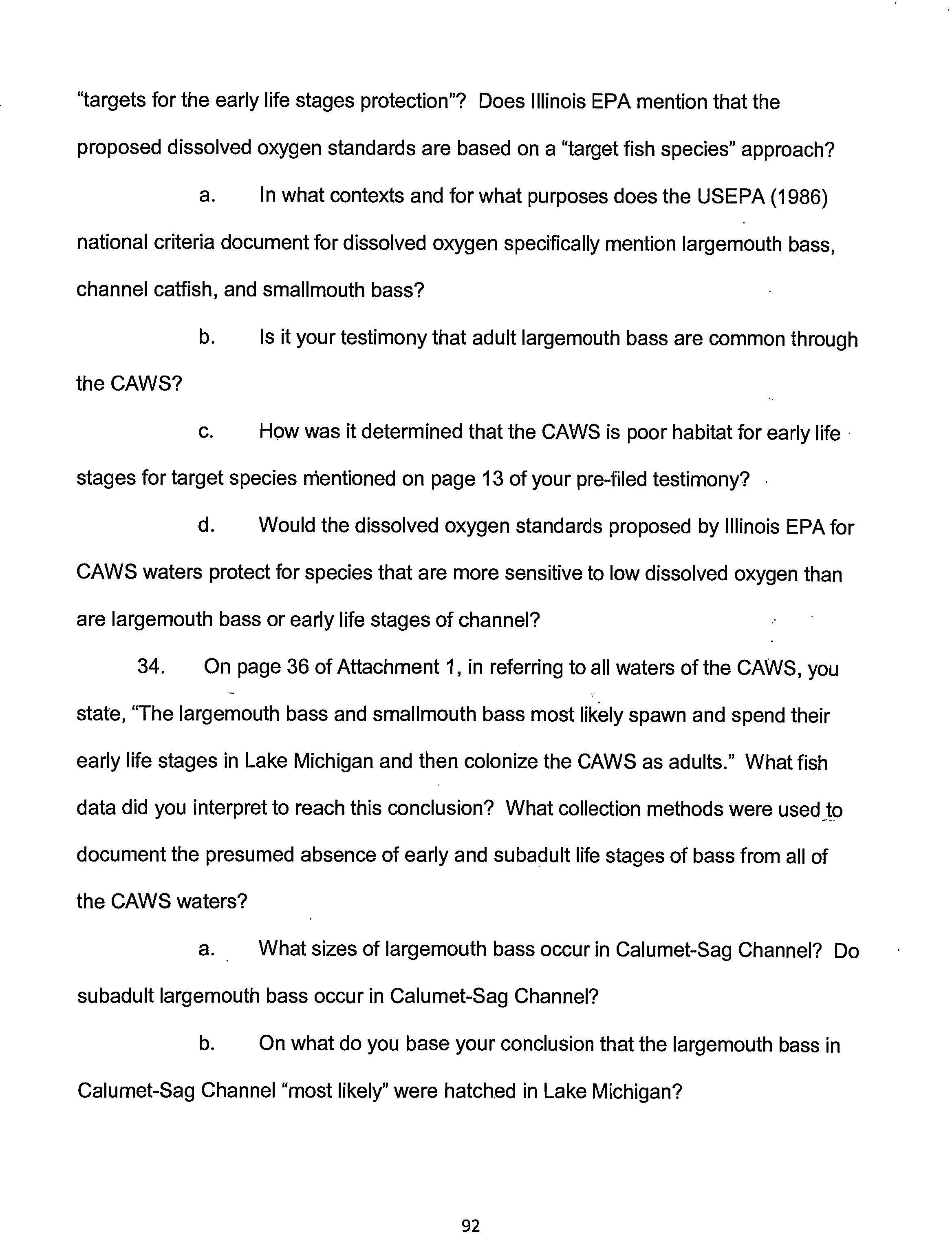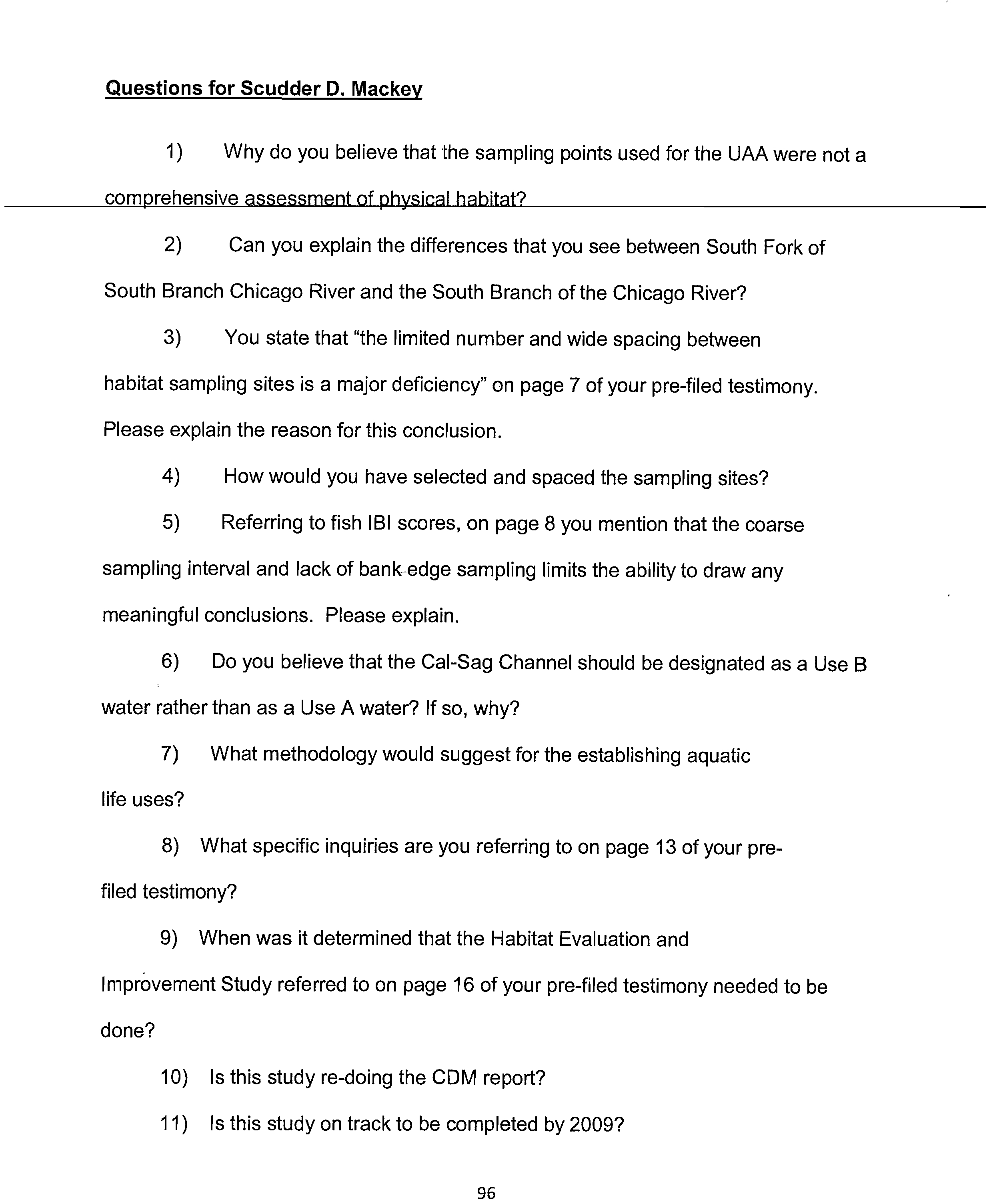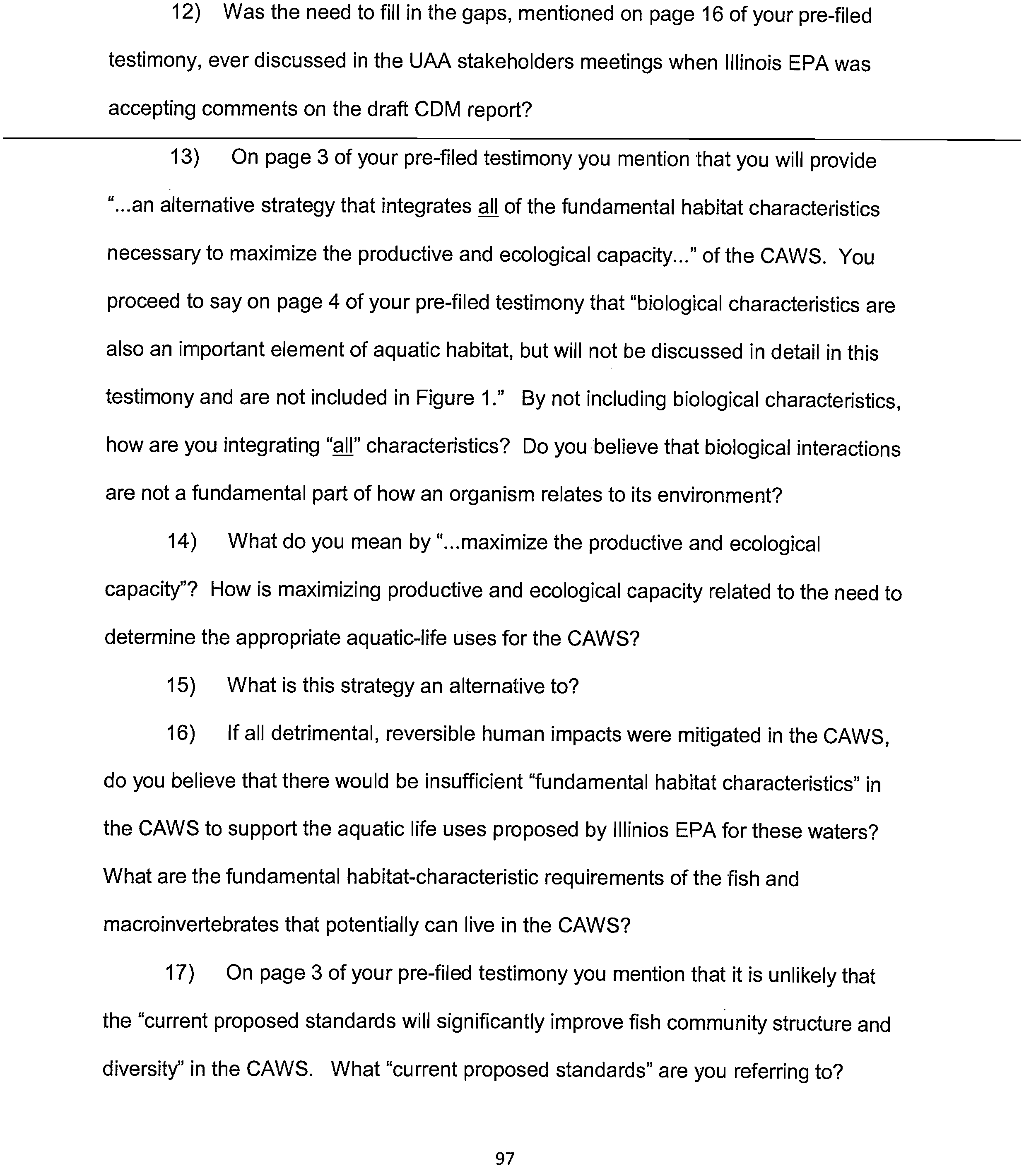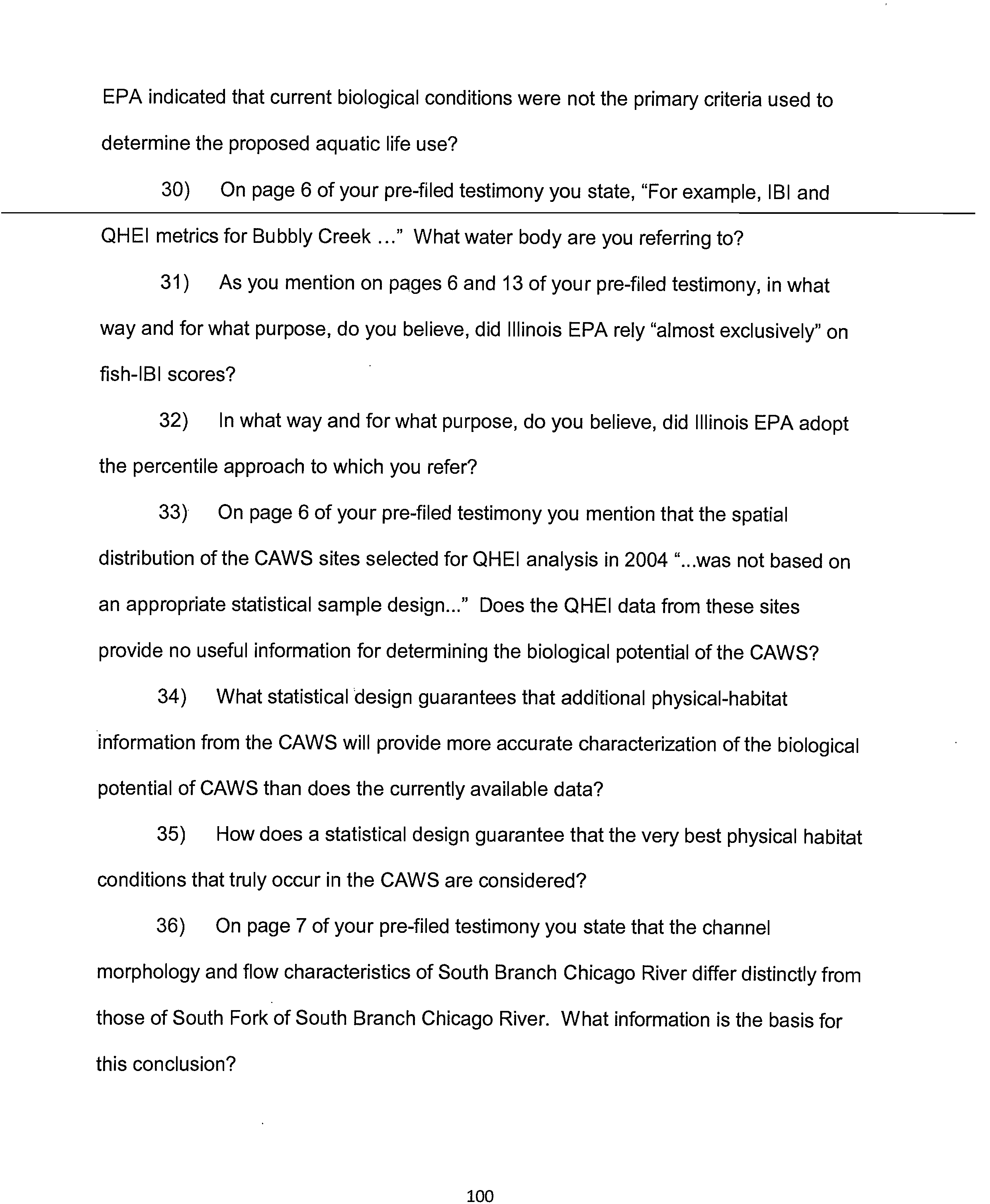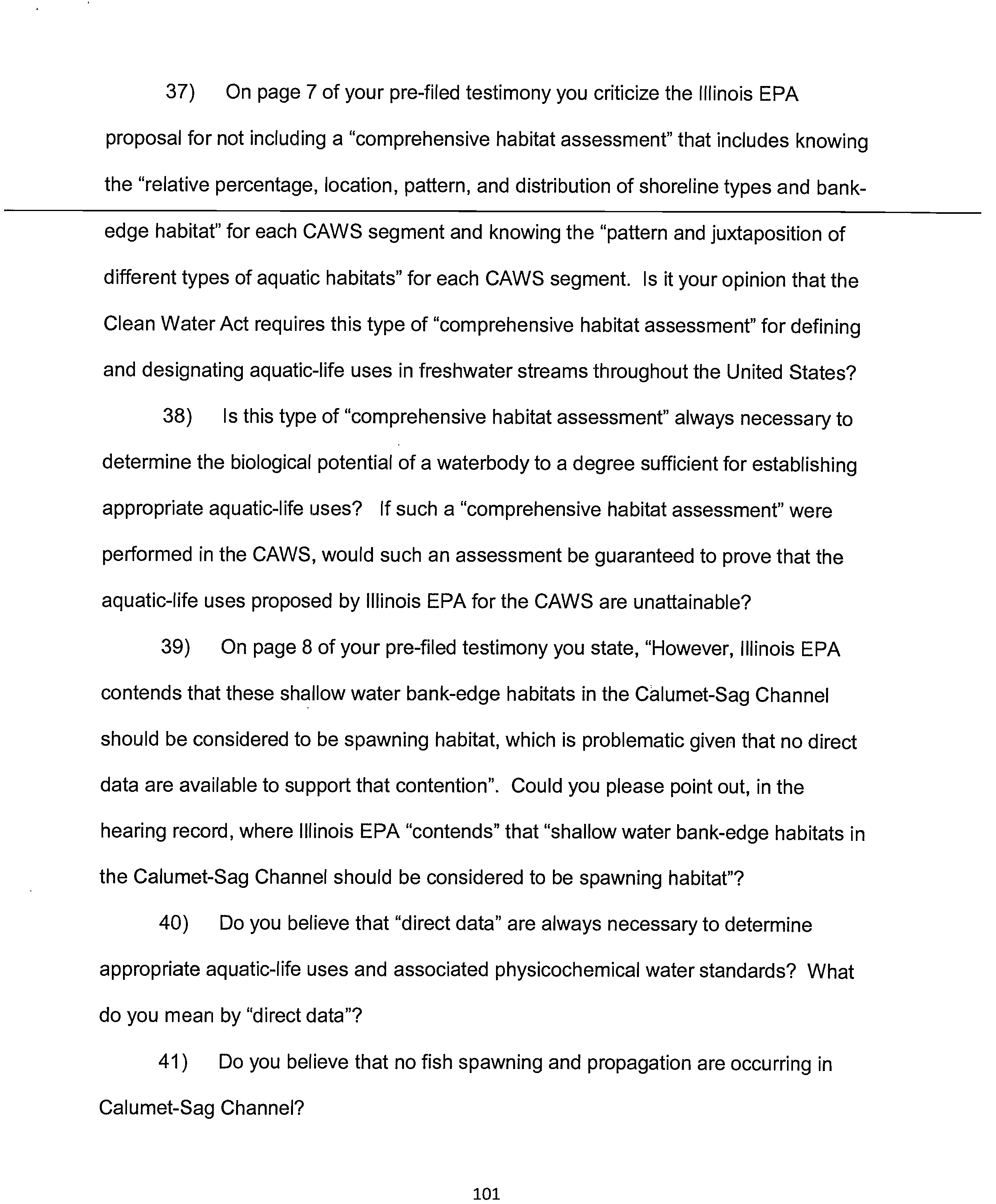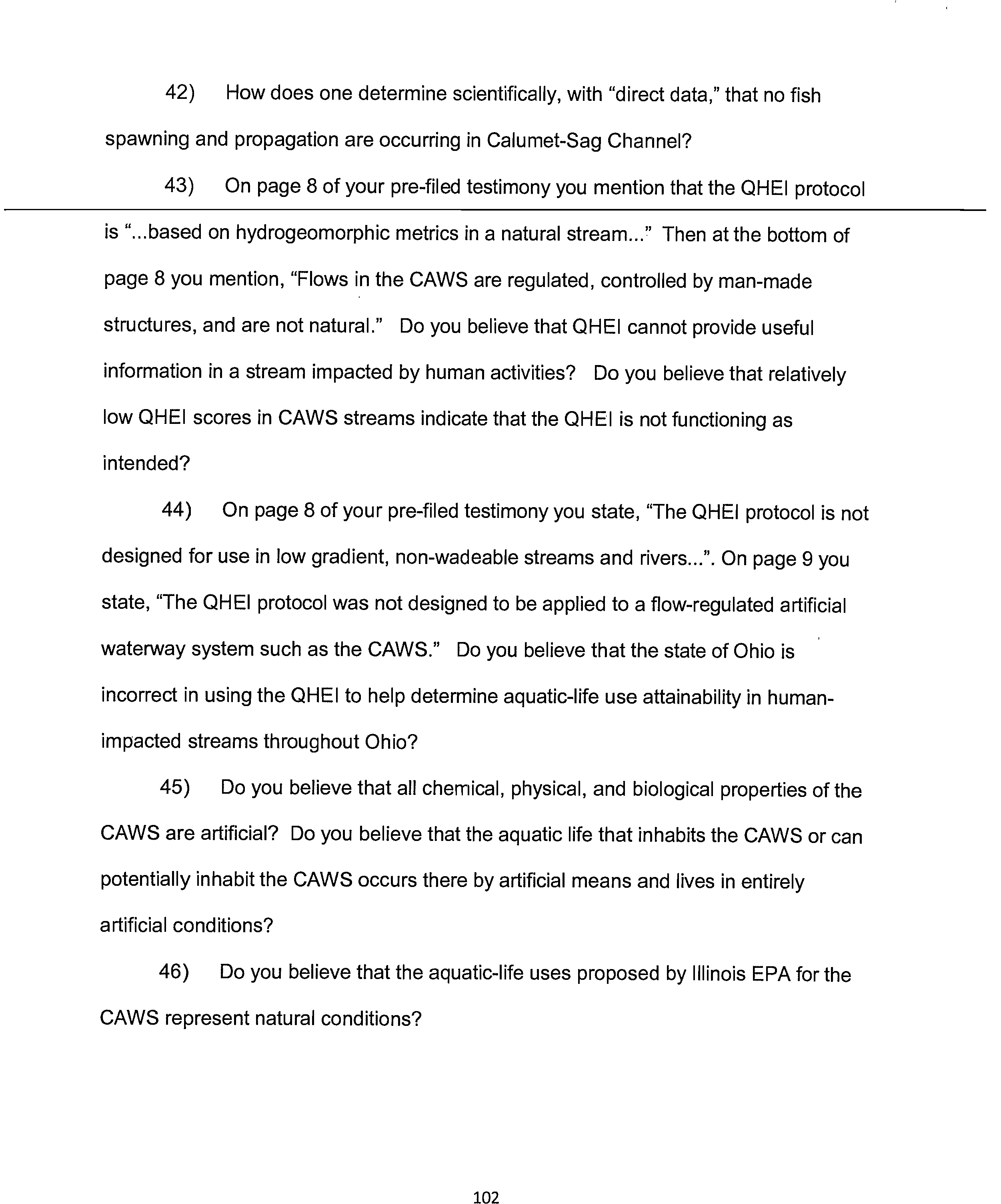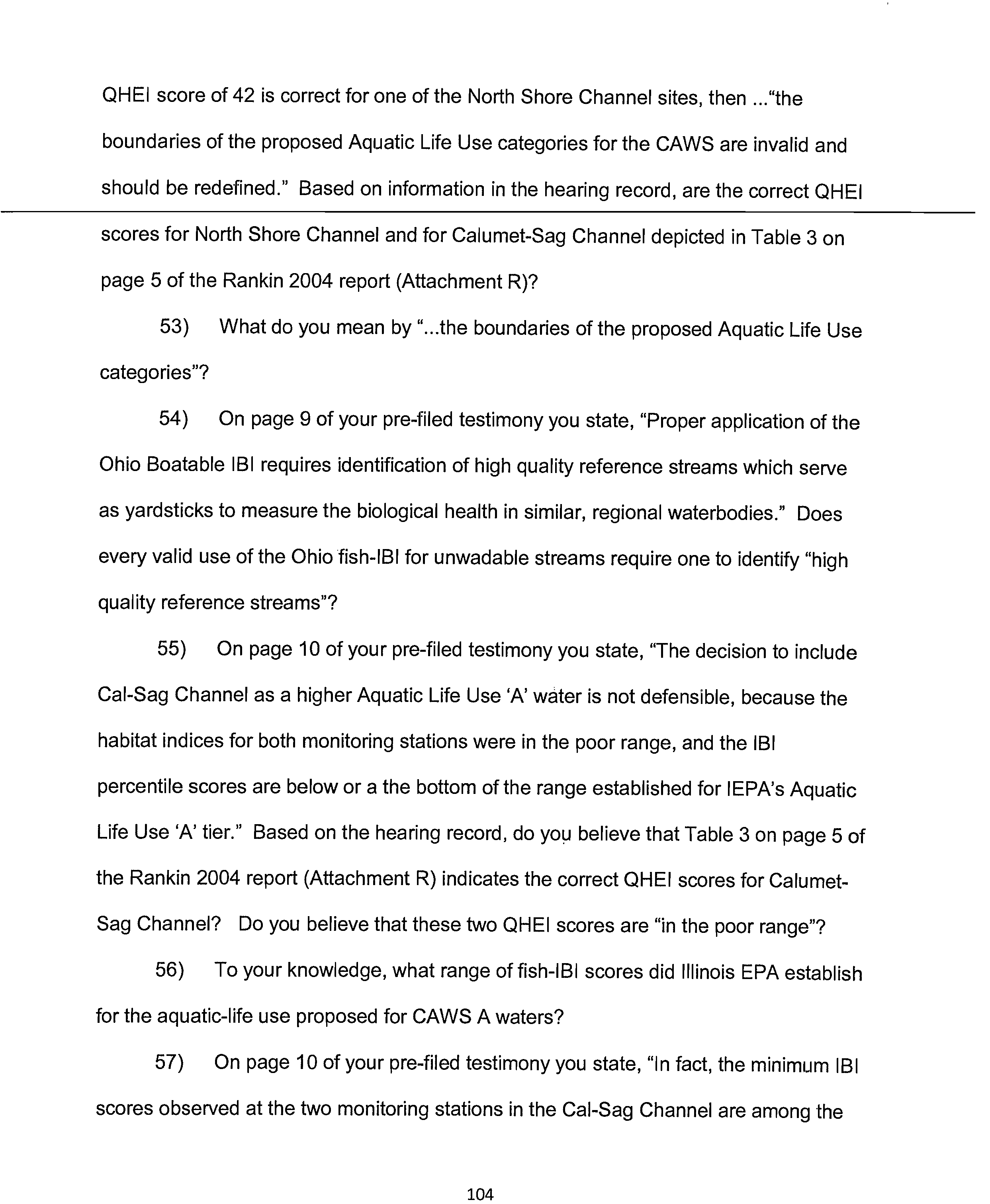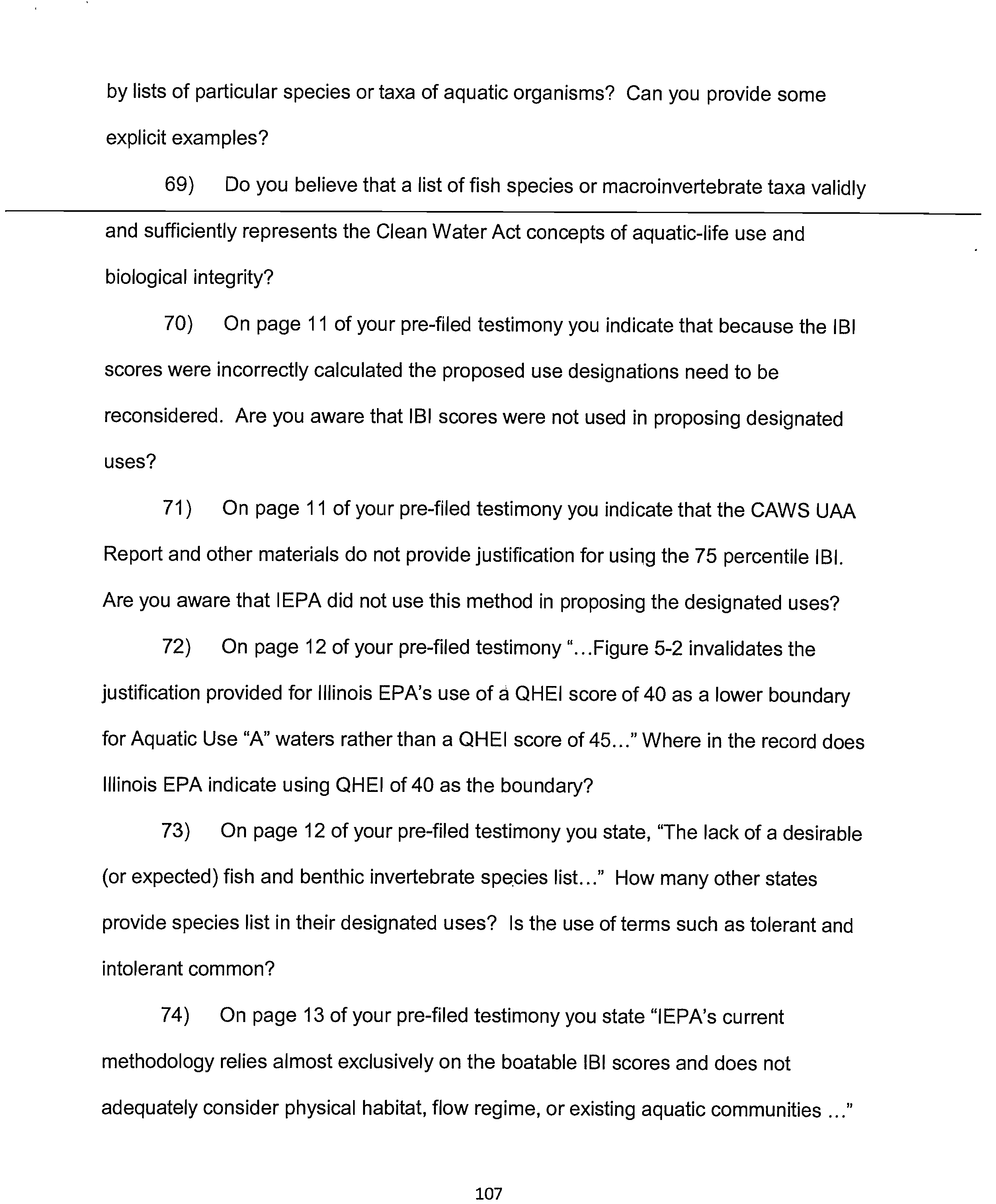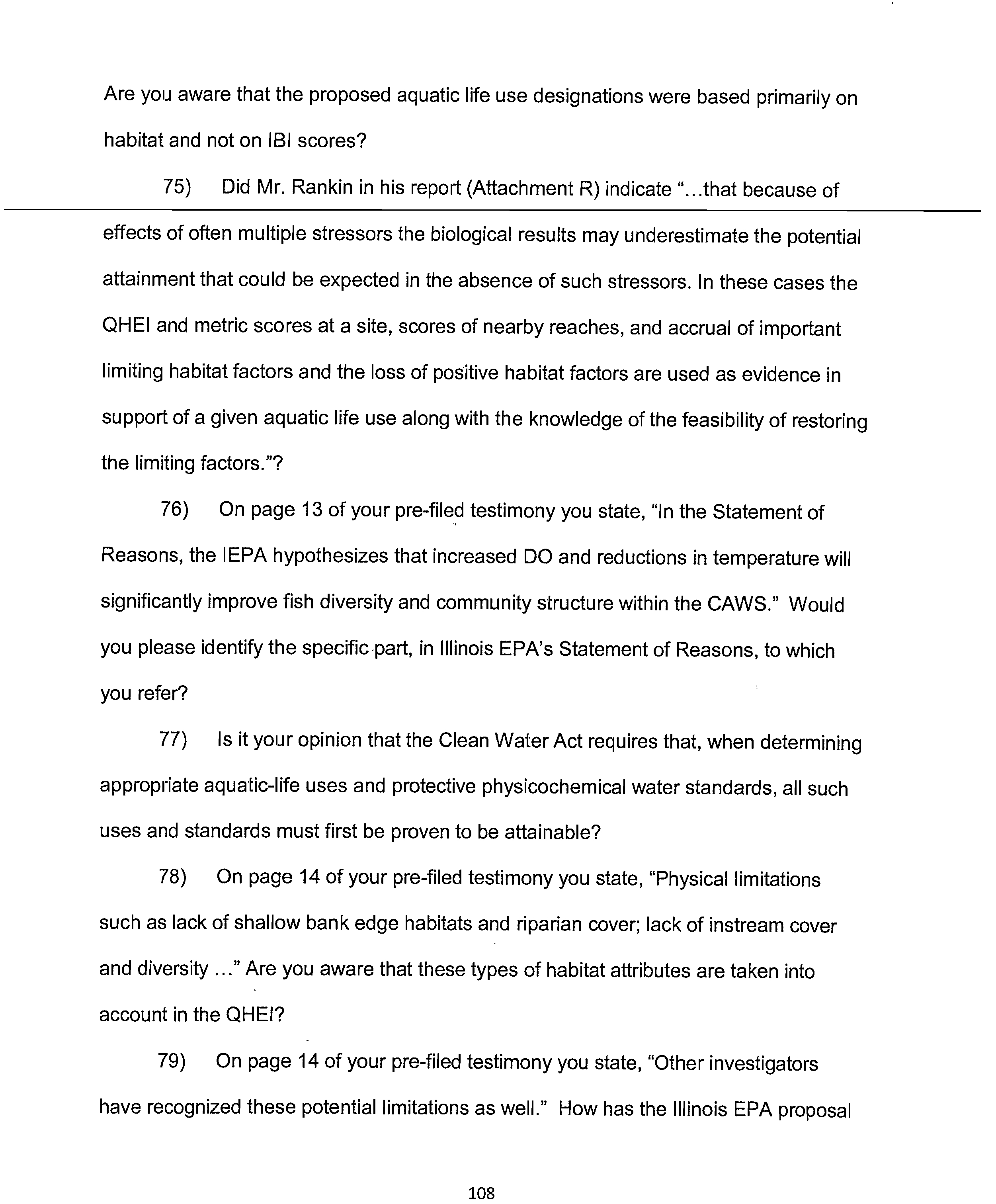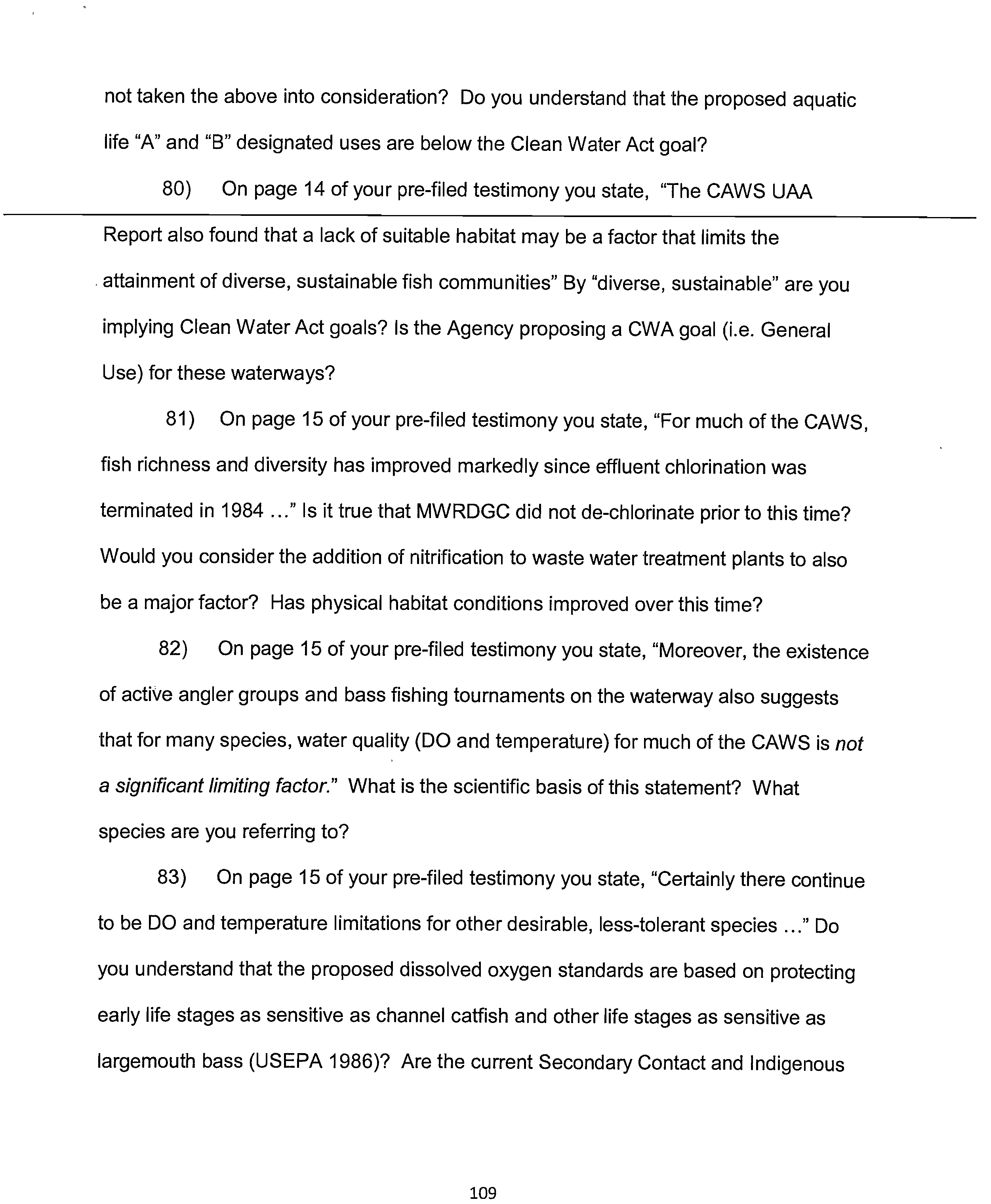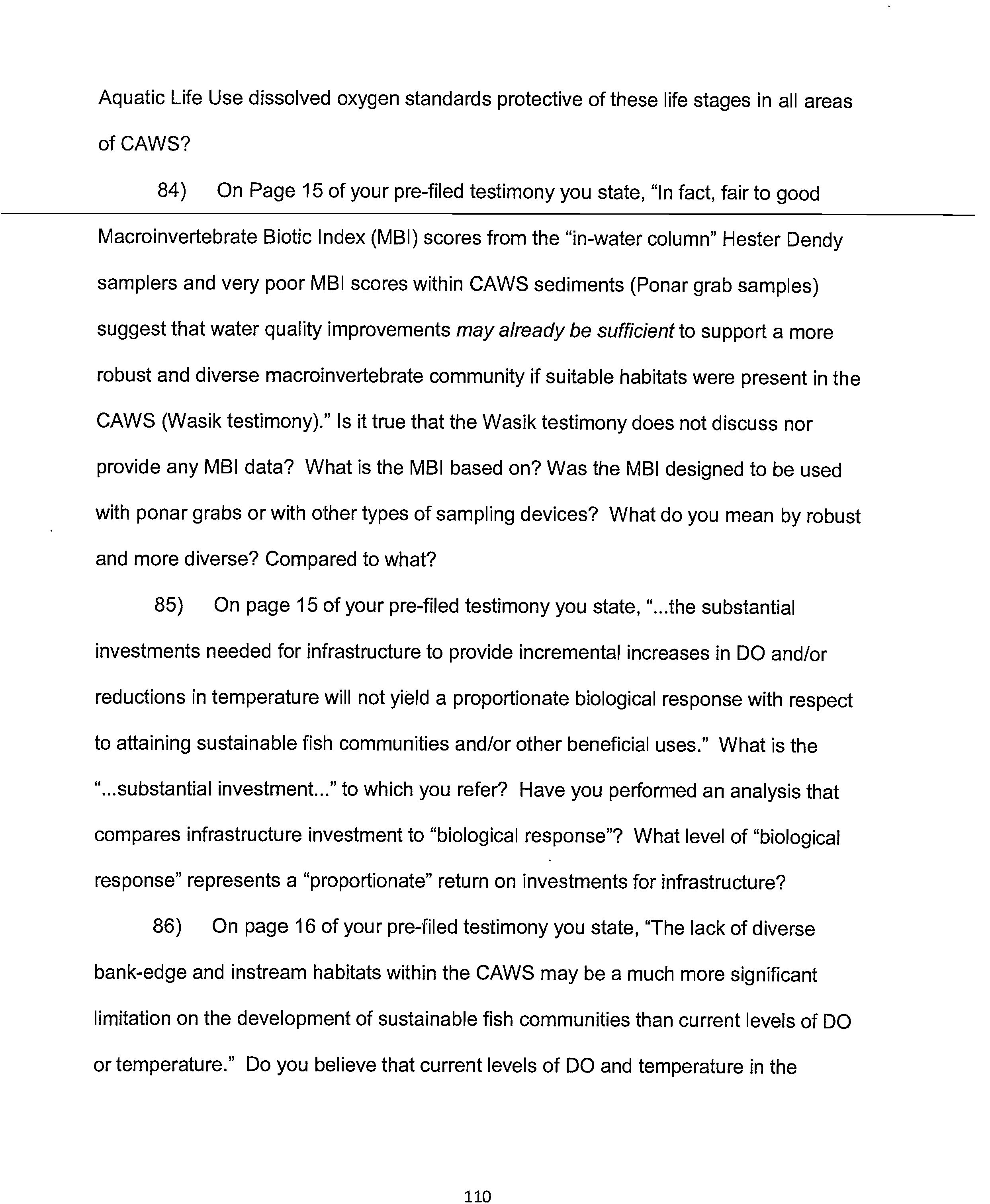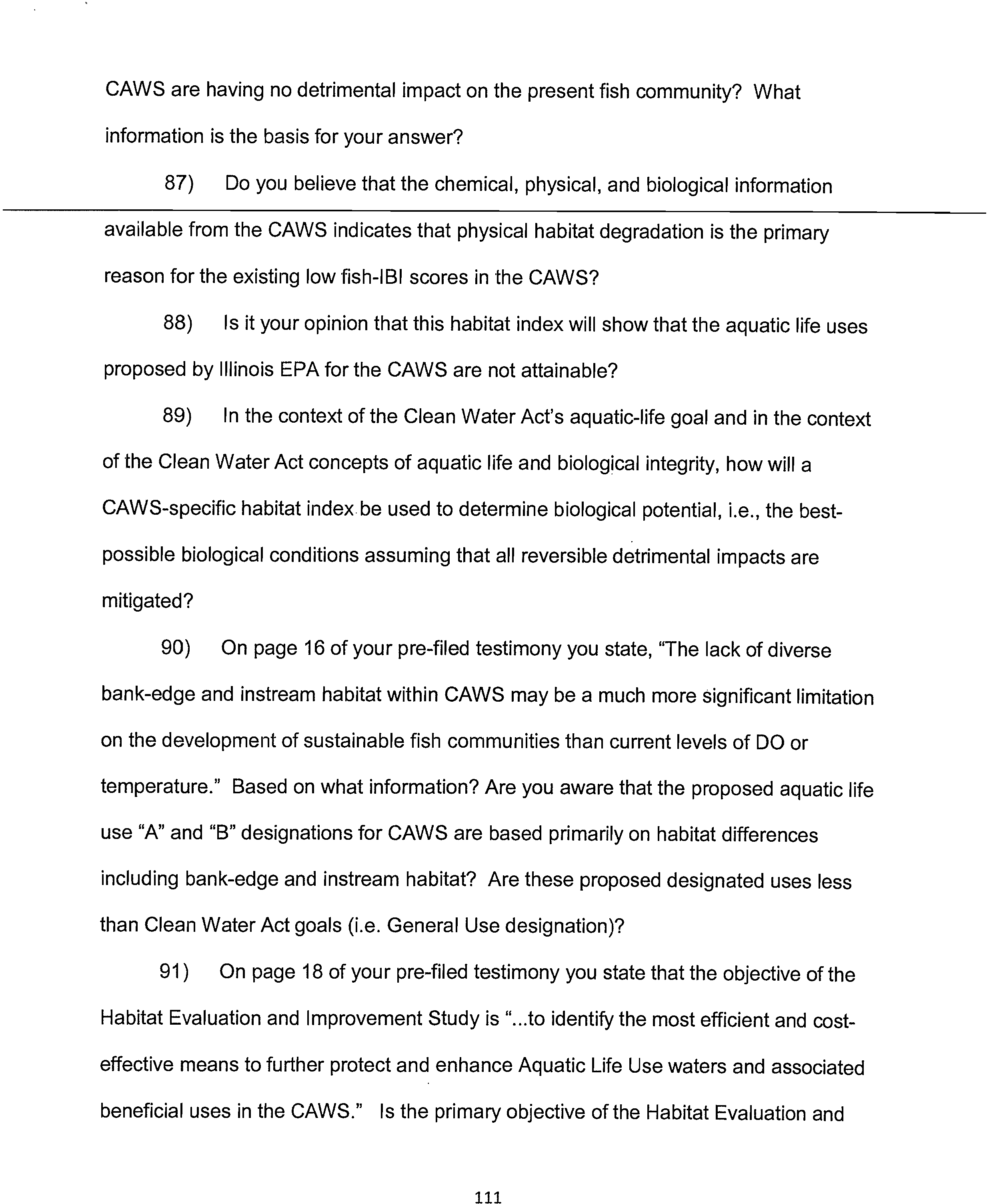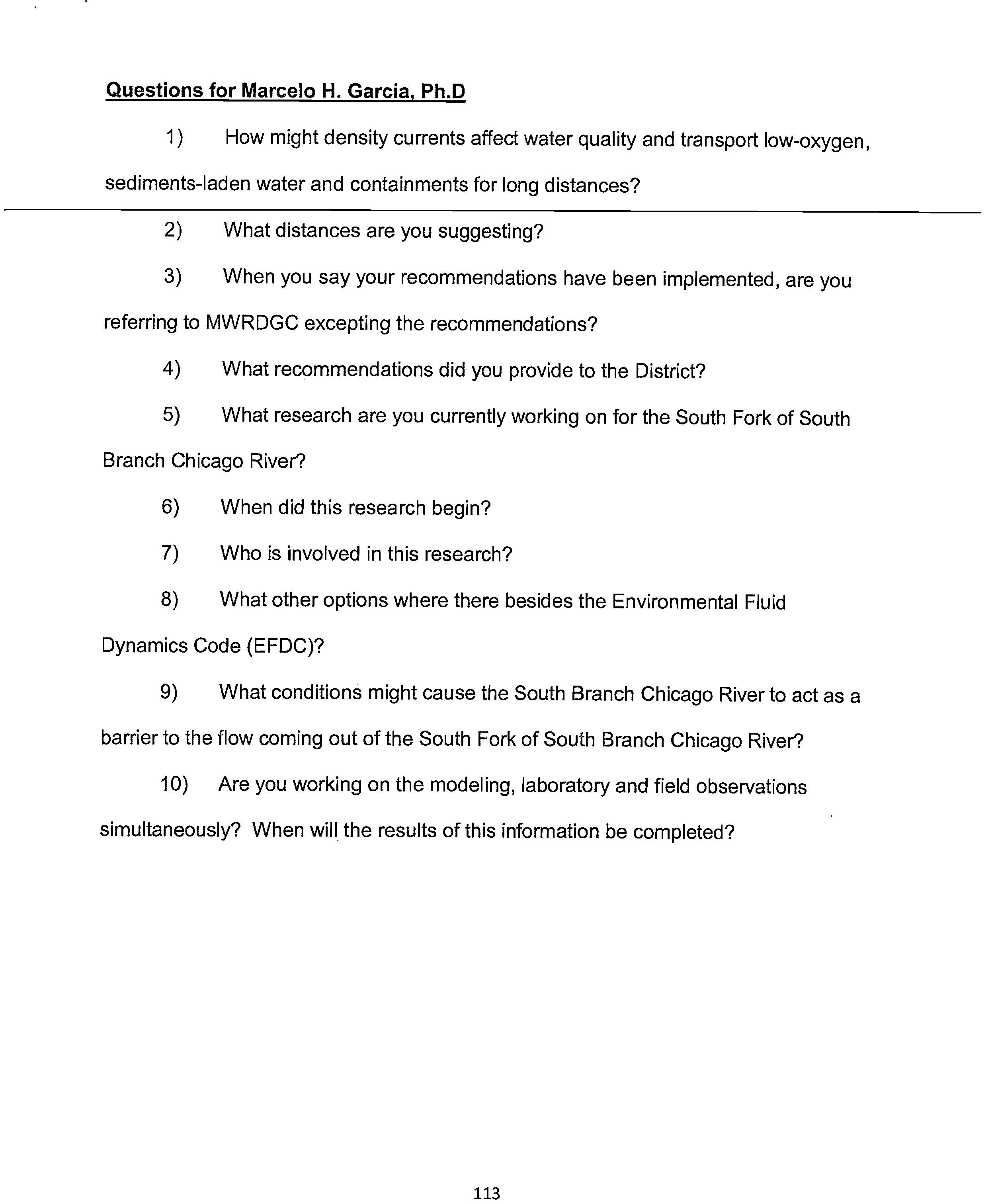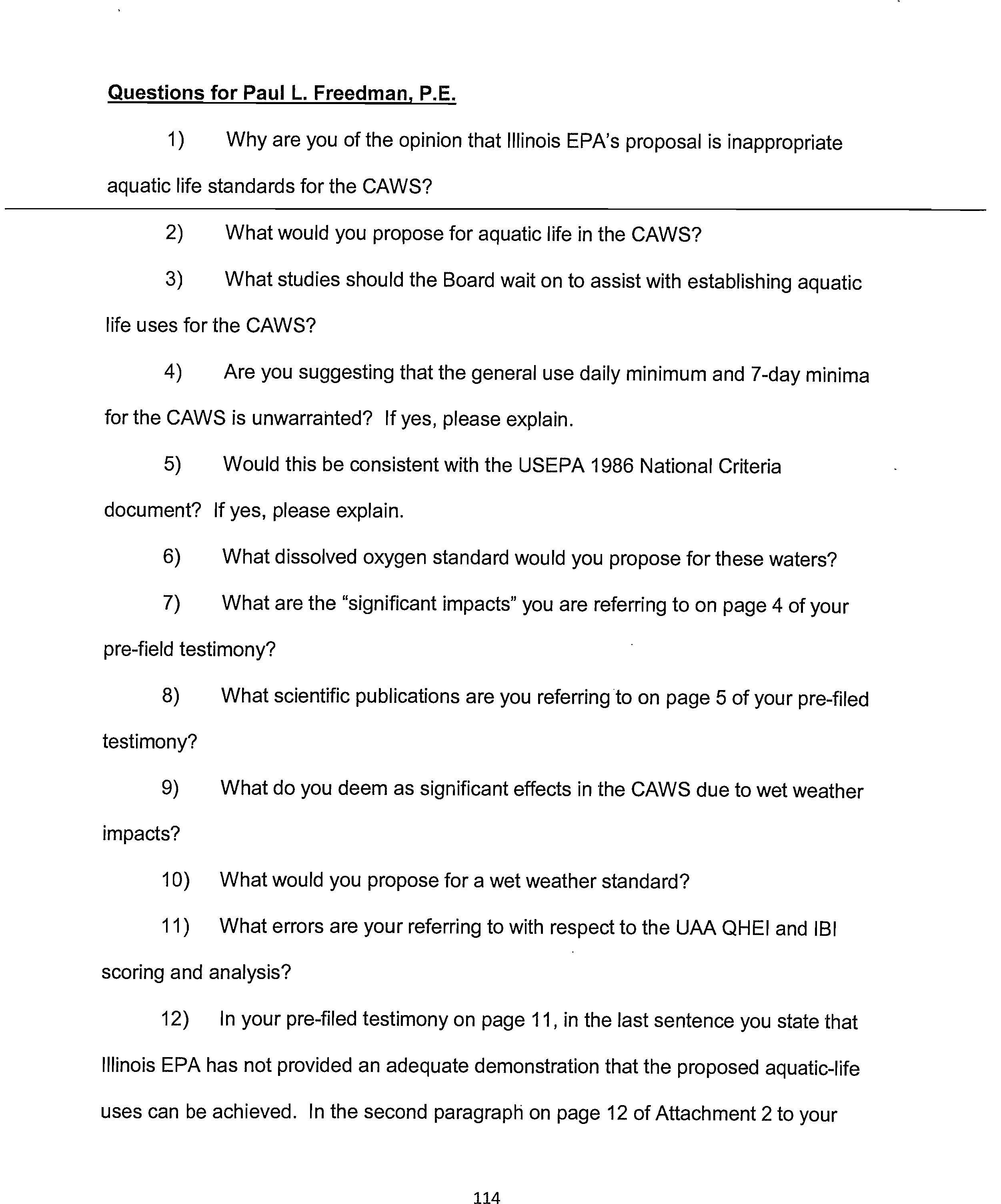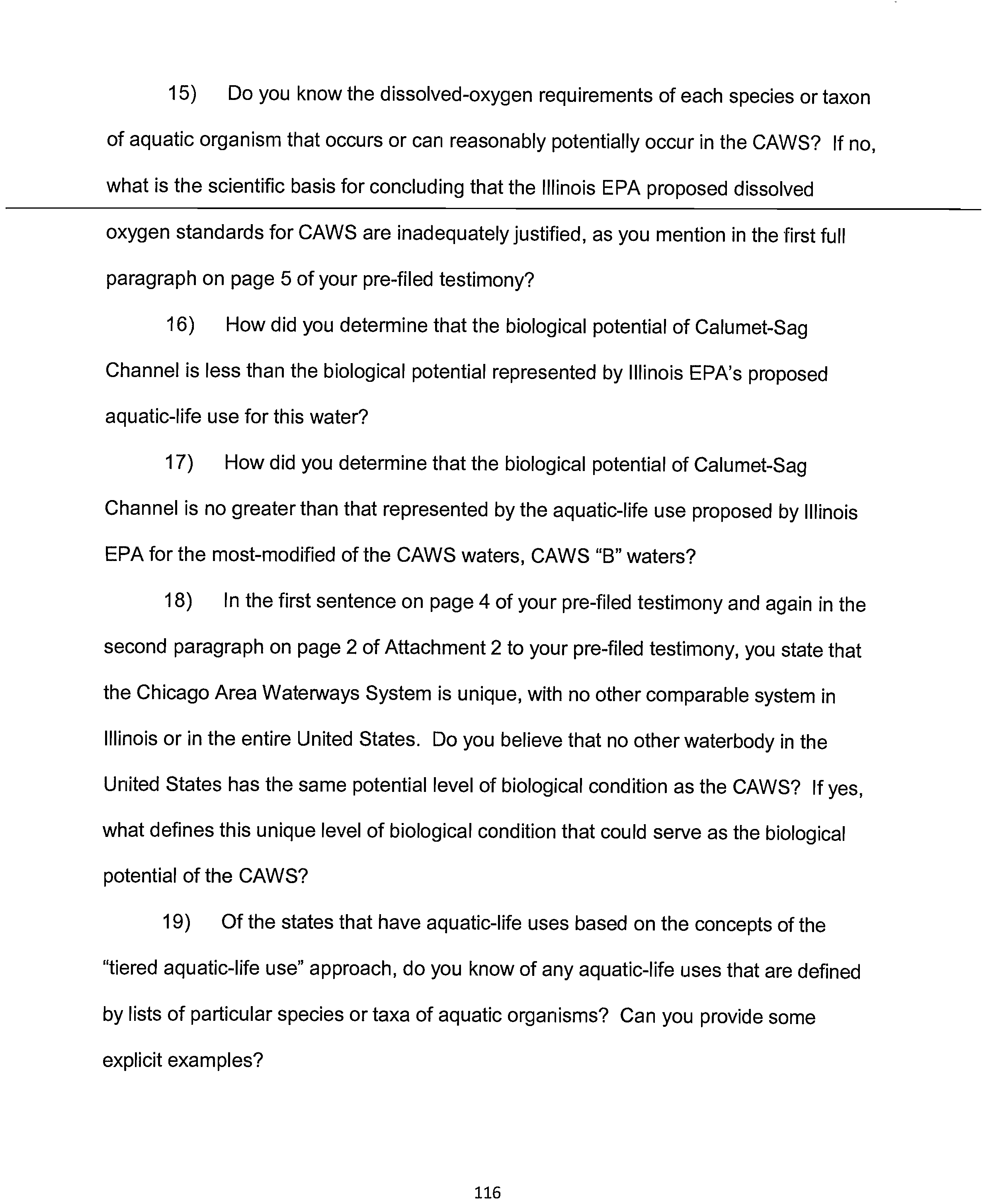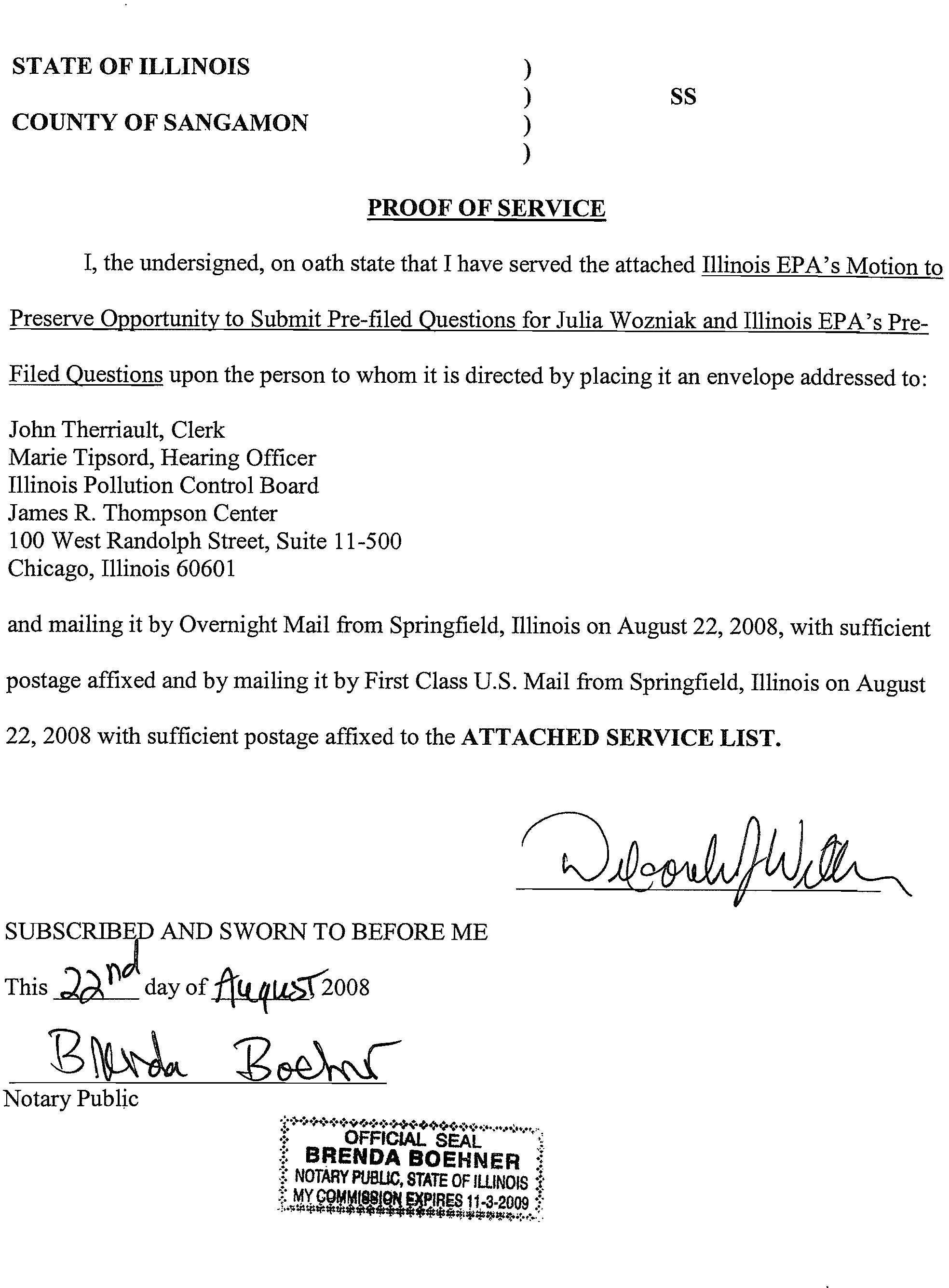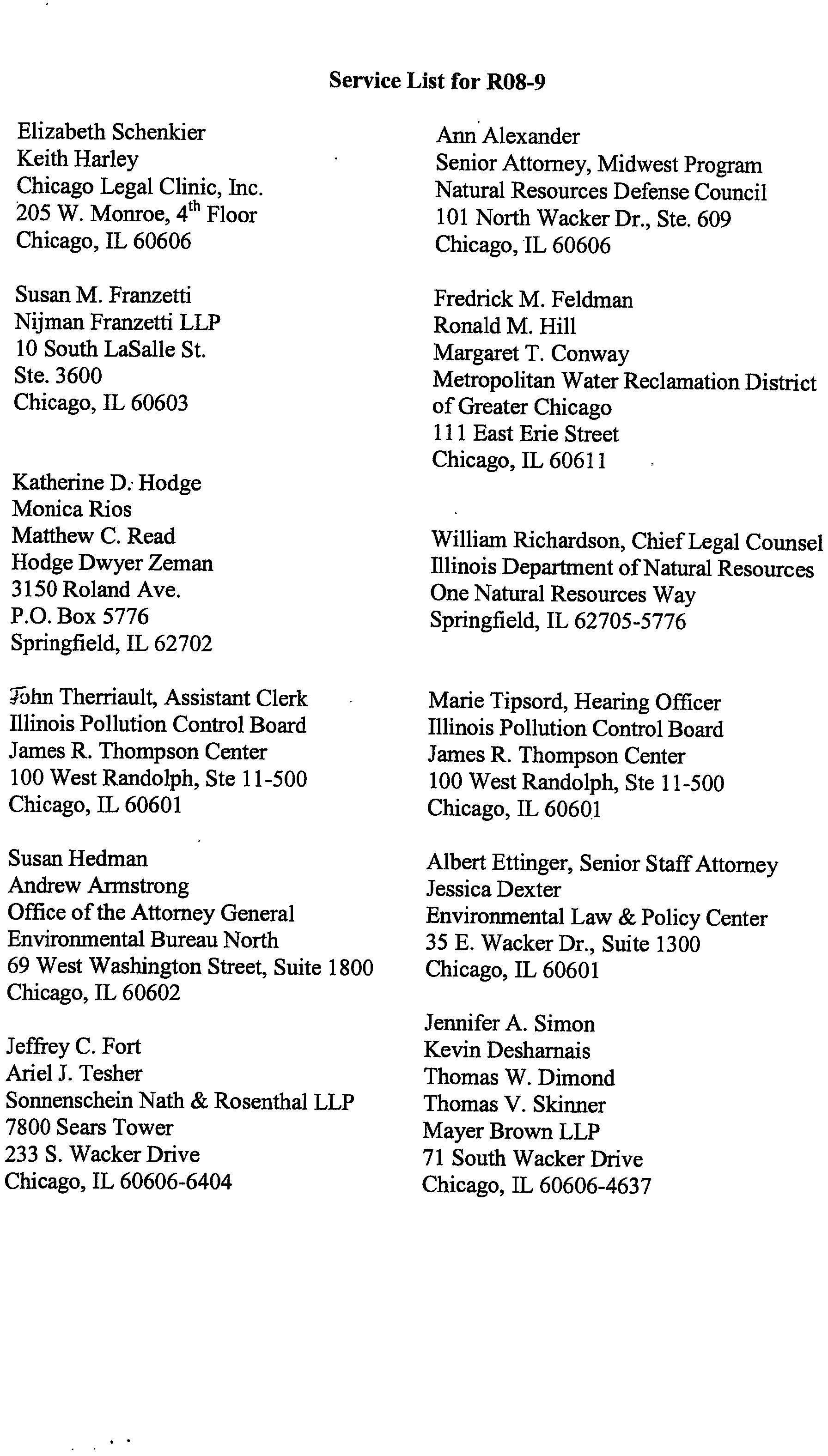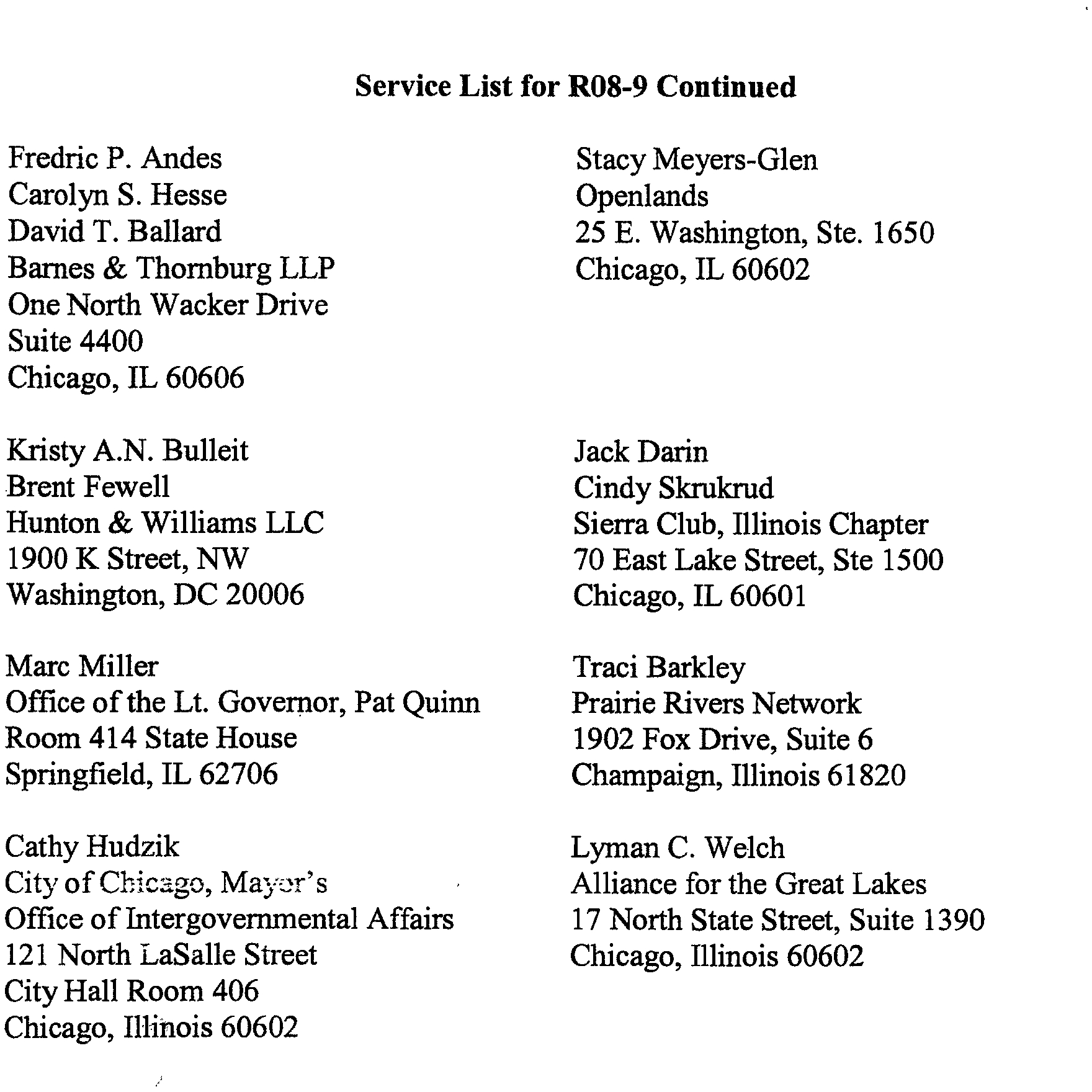BEFORE
THE ILLINOIS
POLLUTION
CONTROL
BOARD
iN
THE
MATTER
OF:
)
CLERKED
)
WATER
QUALITY
STANDARDS
AND
)
AUG
25
2008
CHICAGOEFFLUENT
AREALiMITATIONSWATERWAY
FOR
SYSTEM
THE
))
R08-09
(Rulemaking
- Wt)on
STATE
OF
Control
ILLINOIS
Board
AND THE
LOWER
DES PLAINES
RIVER:
)
PROPOSED
AMENDMENTS TO
35111.
)
Adm.
Code Parts
301, 302,
303 and 304
)
NOTICE
OF FILING
To:
John Therriault,
Clerk
Marie
Tipsord,
Hearing
Officer
James R.
Thompson
Center
Illinois
Pollution
Control
Board
100 West
Randolph
Street, Suite
11-500
Chicago,
Illinois
60601
SEE
ATTACHED
SERVICE
LIST
PLEASE
TAKE
NOTICE
that
I
have
filed
today with
the
Illinois
Pollution
Control
Board
Illinois EPA’s
Motion
to
Preserve
Opportunity
to Submit
Pre-filed
Questions
for Julia
Wozniak
and
Illinois EPA’s
Pre-Filed
Questions,
a
copy
of
which
is
herewith
served
upon
you.
ILLINOIS
ENVIRONMENTAL
PROTECTION
AGENCY
BYJQ
6
Dated:
August 22,
2008
JN
Deborah
J.
William
4uDQI\J
1021
North Grand
Avenue
East
Assistant
Counsel
P.O.
Box 19276
Springfield,
Illinois
62794-9276
(217)
782-5544
THIS FILING
IS SUMBITTED
ON
RECYCLED
PAPER
BEFORE
THE
ILLINOIS
POLLUTION
CONTROL
BOARJ1
1ECEVED
CLERK’S
OFFICE
AUG
25
2008
)
STATE
OF
ILLINOIS
)
Pollution
Control
Board
)
(Rulemaking
—
Water)
MOTION
TO
PRESERVE
OPPORTUNITY
TO
SUBMIT
PRE-FILEI)
QUESTIONS
FOR
JULIA
WOZNIAK
NOW
COMES
the Proponent,
the
ILLINOIS
ENVIRONMENTAL
PROTECTION
AGENCY
(“Illinois
EPA”),
by
one
of its
attorneys,
and
pursuant
to 35
Ill.
Adm. Code
101.500,
101.502,
101.522,
102.402
and
102.420
moves
that
the Hearing
Officer
allow the
Illinois
EPA
to submit
its
pre-filed
questions
for
Midwest
Generation
witness
Julia
Wozniak
at
such
time
as the
Hearing
Officer
Orders
the
filing
of
pre-filed
questions
for
Midwest
Generation
witnesses
Greg Seegert
and
Dr.
Alan Burton.
In
support
of its
Motion,
the
Illinois
EPA
states
as follows:
1.
On May
19,
2008,
the
Hearing
Officer
issued
an
order scheduling
additional
hearings
in
this matter
for
September
8,
9 and
10
and
23, 24
and
25.
In
addition,
a
Pre-filed
Testimony
deadline
of
August
4,
2008
and a
Pre-Filed
Question
deadline
of
August
25, 2008
were established.
2.
The
Metropolitan
Water
Reclamation
District
of
Greater
Chicago
filed
a
Motion
to Stay
these
proceedings
on
June
12, 2008.
On
July
21,
2008,
the
Board
denied
that
Motion
and
upheld
the
Pre-filed
Testimony
and
Question
deadlines
established
in
the
May
19,
2088
Hearing
Officer
Order.
IN
THE
MATTER
OF
WATER
QUALITY
STATh.DARDS
AND
EFFLUENT
LIMITATIONS
FOR
THE
CHICAGO
AREA
WATERWAY
SYSTEM
AND
THE
LOWER
DES
PLANES
RIVER:
PROPOSED
AMENDMENTS TO
35111.
Adm.
Code
Parts
301,
302,
303
and
304
)
)
)
3.
Midwest
Generation filed
a Motion for
Extension of
Time
to
File
Pre-filed
Testimony
of
Greg
Seegert
and
Dr.
Alan Burton
on
July
25, 2008. Tn
its Motion,
Midwest Generation requested
an extension
of
time
until
September
8, 2008 to file
testimony for
these
two witnesses.
Midwest
Generation
stated that “this
extension is
limited
in
both
time
and scope...
[Midwest Generation]
is not seeking
an extension
of
time to file
pre-filed testimony
of
any other
witnesses.”
Motion
at pp:
2-3.
4.
Midwest
Generation’s Motion
was granted
by the Hearing
Officer
on
August
1,
2008.
On August
4, 2008,
Midwest Generation
timely pre-filed
testimony
of
Julia Wozniak. No other
testimony
has been filed by
Midwest Generation
to date.
5.
In
addition to Ms. Wozniak,
forty-six
(46) pieces
of testimony were
filed
on
August 4,
2008 from
approximately
thirty-nine
(39) different
witnesses.
Simultaneously
with this
Motion, the Agency
is timely
filing its pre-filed
questions for
these witnesses.
6.
Ms. Wozniak’s
testimony and
the thirteen (13) Attachments
to it
overlaps
in many
respects subject
matters that the Illinois
EPA expects
will also
be covered
in the
key testimony
of Greg
Seegert
and Dr. Alan
Burton. Therefore,
it would
confuse the
Record for
cross-examination
of Ms. Wozniak
to occur
before
testimony
has even
been
filed by Mr. Seegert and
Dr. Burton. In addition,
it
would
prejudice
the
Illinois
EPA’s
case
in support
of its
rulemaking proposal
to prepare pre-filed
testimony
of this one
Midwest Generation
witness
prior to the deadline
for submittal
of testimony
by the
other
Midwest Generation
witnesses on the same
subject. For
example,
any subjects
of cross
examination
of Ms. Wozniak would
be subject
to rehabilitation
on the same
issues in the
later testimony. This
makes it necessary for
the
Agency
to
seek leave
from
the Hearing
Officer to
preserve its right to submit
questions ofMs. Wozniak on the same date and
time as the Hearing Officer orders the parties to
submit
pre-filed questions for Midwest
Generation’s
remaining use designation
witnesses.
WHEREFORE, for the reasons
set forth above, the Illinois EPA moves that the
Hearing Officer GRANT the Agency’s Motion to preserve
the
opportunity to submit
pre
filed questions for Midwest Generation witness Julia
Wozniak
until the date the Hearing
Officer
Orders submittal of Pre-filed Questions for Greg Seegert and Dr. Alan Burton.
•
Respectfully submitted,
ILLINOIS ENVIRONMENTAL
PROTECTION AGENCY
By:U)A
Deborah
J.
Willi
s
•
Assistant Counsel
Dated: August
22, 2008
1021 North
Grand Avenue East
• P.O. Box
19276
Springfield, Illinois
62794-9276
(217)
782-5544
BEFORE
THE
ILLINOIS
POLLUTION
CONTROL
BOARD
ECEVED
IN THE
MATTER
OF:
)
CLERK’S
OFFICE
)
AU6252008
WATER
QUALITY
STANDARDS
AND
)
EFFLUENT
LIMITATIONS
FOR
THE
)
R0809
pnJd
CHICAGO
AREA
WATERWAY
SYSTEM
)
(Rulemaking
-Water)
AND
THE
LOWER
DES
PLAINES
RIVER:
)
PROPOSED
AMENDMENTS
TO 35
III.
)
Adm.
Code
Parts
301, 302,
303
and
304)
)
)
Illinois
EPA’s
Pre-Filed
Questions
for
Kevin
J.
Boyle,
Ph.D.
The
Illinois
Environmental
Protection
Agency
(“Illinois
EPA”
or “Agency”),
by and
through
its attorneys,
hereby
submits its
Pre-Filed
Questions
for
Kevin
J.
Boyle,
Ph.D.
based
on
his pre-filed
testimony
in the
above-captioned
matter.
The
Agency
reserves the
right
to ask additional
follow-up
questions
as
necessary.
1.
Has your
approach
for
calculating
economic
benefits
been
used
in
other
states
to set
water
quality
standards?
If so,
what
states?
And
what
action
did
these states
take based
on this
approach?
2.
Does
your
report address
any
environmental
benefits
of
this
rulemaking
from
improved
aquatic
life
uses?
3.
Explain
where
fishing
fits
into your
analysis.
Fishing
is
a
recreational
activity and
the economic
benefits
of
the
proposed
recreational
uses
would
be
reflected,
but
does your
analysis
reflect
any
economic
benefits
from
improvements
in
the
fish consumption
use
or from
improvements
to game
fish
species
from
improved
aquatic
life
uses?
4.
What
is a
benefit-function transfer?
5.
Explain
the
difference
between a linear
and log
linear equation?
6.
You testify that
MWRDGC
monitoring
data was
Used
to calculate
the Water Quality Index
improvements
of this
rulemaking
from 6.1 to 6.8.
a.
Was
this ambient
data or effluent
data?
b.
Did you make these
calculations
or did
someone else?
c.
Can
you
provide the Water
Quality Index
and resulting
calculations for
the
Record?
d.
Do the
improvements
in the index
reflect improvements
to
fecal coliform
concentrations
only or do
they also reflect
projected
improvements
to the temperature and
dissolved
oxygen conditions
of the
waterway?
7.
Can you provide
a copy
for
the
Record of the
1986 survey of
Chicago
and surrounding
communities’ residents
that
use
the
CAWS
from
your
report and reference
list?
8.
Explain
your testimony
that
0MB
2006
Standards
and Guidelines
for
Statistical Surveys
says to
use a
value of
80
percent
for
the response rate
variable? How would
use of
a
different
variable
change the
conclusions of
your
testimony?
9.
Please explain
your calculation of
the
in-person
interview variable.
Why do you
state that
your use of
a
variable
of
one
(1)
is consistent
with the
National
Oceanic
and Atmospheric
Administration’s
Blue
Ribbon Panel
recommendations?
2
10.
Explain how the
Water
Quality
Recreational
Use variable
is
calculated
or derived?
11.
Have
you considered
the
economic
costs of recreation-related
illnesses
in your analysis?
Would
incorporating
these costs
result in
additional
economic benefits
from this
rulemaking?
12.
On page
55
(Exhibit
2)
you list the three
journal articles you
rely
on
for
the Meta-analysis
results,
the
adjustment for potentially
over-stated
values,
and the percent
of Chicago Area
Waterway
System users.
Could you provide
copies
of these
articles
for the rulemaking Record?
13.
You list three
guidance
documents
your analysis is based
on
or
consistent
with:
0MB 2003
Guidance
on Development
of Regulatory
Analysis
U.S. EPA’s
2000
Guidelines
for Preparing Economic
Analyses
U.S.
EPA’S 1995 Interim
Economic Guidance
for Water
Quality
Standards
The 1995 U.S. EPA
Guidance document
is Attachment
C to the
Statement
of Reasons. Are
the other
two
guidance
documents
in
the Record?
Can
you
submit them?
14.
Please provide
copies for the
Record of any
additional
publications
relied on or underlying
data
used in
developing
your
recommendations
that would
have
to be
made
available to
the public by
the
Board
or the
Agency pursuant to
the Illinois Administrative
Procedure
Act,
5 ILCS
I
0015-40(b)(3.5).
3
Respecifully submitted,
ILLINOIS
ENVIRONMENTAL
PROTECTION
AGENCY
Byi4
Deborah J. Williams
Assistant Counsel
Dated:
August
22, 2008
1021
North Grand
Avenue
East
P.O. Box 19276
Springfield,
Illinois 62794-9276
(217)
782-5544
4
BEFORE
THE
ILLINOIS
POLLUTION
CONTROL
BOARD
CEVE
CLERK’S
OFFICE
)
AUG25
2008
STATE
OF
ILLINOIS
)
R0809
Pollution
Control
Board
)
(Rulemaking
—Water)
)
)
)
)
Illinois
EPA’s
Pre-Filed
Questions
for
Southeast
Environmenta[Task
Force
Witnesses
Alan Mammoser
and Victor
Crivello
The
Illinois
Environmental
Protection
Agency (“Illinois
EPA”
or
“Agency”),
by and
through
its
attorneys,
hereby
submits
its Pre-Filed
Questions
for
Southeast
Environmental
Task
Force Witnesses
Alan Mammoser
and
Victor
Crivello
based
on their
pre-filed
testimony
in the
above-captioned,
matter.
The
Agency
reserves
the
right to ask
additional
follow-up
questions
as necessary.
Pre-filed
questions
for Victor
Crivello
How
does
the Lake
Calu met
Vision
Committee
promote
public
access
and
boating
on
Lake
Calumet?
Pre-filed
questions
for
Alan
Mammoser
How
does
the
Calumet
Area Land
Use Plan
“focus
on the
creation
of
public
access
through
small open
spaces
to the
rivers.”
(See
page
4
of
pre-filed
testimony).
How
is
disinfection
a “key component
to the
success
of the Calumet
Area
Vision
Plan?”
(See
page
7 of
testimony).
IN THE MATTER
OP
WATER
QUALITY
STANDARDS
AND
EFFLUENT
LIMITATIONS
FOR
THE
CHICAGO
AREA
WATERWAY
SYSTEM
AND
THE
LOWER
DES
PLAINES
RIVER:
PROPOSED
AMENDMENTS
TO
35 III.
Adm.
Code
Parts
301, 302,
303
and 304)
Respectfully
submitted,
ILLINOIS
ENVIRONMENTAL
PROTECTION
AGENCY
By:4
Deborah J. WiIlia(iis
Assistant
Counsel
Dated: August
22,
2008
1021
North Grand Avenue
East
P.O. Box
19276
Springfield,
Illinois 62794-9276
(217)
782-5544
2
IN
THE
MATTER
OF:
WATER
QUALITY
STANDARDS
AND
EFFLUENT
LIMITATIONS
FOR
THE
CHICAGO
AREA
WATERWAY
SYSTEM
AND
THE
LOWER
DES
PLAINES
RIVER:
PROPOSED
AMENDMENTS
TO
35
III.
Adm.
Code
Parts
301,
302,
303 and
304)
Illinois
EPA’s
Pre-Filed
Questions
for
Natural
Resources
Defense
Council
Witnesses
Marc
H. Gorelick,
M.D.,
Marilyn
V.
Yates,
Ph.D.
and
Peter
Orris,
M.D.,
M.P.H.
The
Illinois
Environmental
Protection
Agency
(“Illinois
EPA”
or “Agency”),
by
and
through
its
attorneys,
hereby
submits
its
Pre-Filed
Questions
for
Natural
Resources
Defense
Council
witnesses
Drs.
Marc
H. Gorelick,
Marilyn
V.
Yates
and
Peter
Orris
based
on their
pre-filed
testimony
in
the above-captioned
matter.
The Agency
reserves
the
right to
ask additional
follow-up
questions
as
necessary.
Illinois
EPA’s
Pre-filed
questions
for
Marc
Gorelick,
M.D.
and
Peter
Orris,
M.D.,
M.P.H.
1.
How would
someone
know
if they
had
contracted
an
asymptomatic
Giardia
infection
from
recreational
activity
and
passed
it on
to
their
family?
2.
What conclusions
have
you
drawn
from
the
Tables
you
include
as
Exhibits
3
and
2 (respectively)
to your
testimonies?
3.
Why
is a negative
epidemiological
result
more
difficult
to
interpret
and apply
than
a
positive
one?
BEFORE
THE
ILLINOIS
POLLUTION
CONTROL
AUG
25
2008
)
STATE
OF
ILLINQI
PølIt,n
Control
Board
)
)
)
)
)
)
)
R08-09
(Rulemaking
—
Water)
4.
On
page 11
of Dr.
Gorelick’s
testimony
it states “This
may
be
especially
true
when
water
conditions
are thought
to be ore
hazardous.”
Did
you
mean
to
say
“more”
hazardous?
5.
Why would
the
District’s
CHEERS
study
not fully
reflect
the
potential
danger
of
unintended
ingestions
and significant
exposure
to especially
vulnerable
individuals?
6.
Who are
you
referring
to
when
you say
“vulnerable
individuals”?
Questions
for
Marvlynn
V.
Yates, Ph.D.
1.
What
major
cities
use disinfection?
What
smaller
communities
use
disinfection?
2.
In your opinion,
what were
the
analytical
errors you
found with
the
microbial
risk
assessment
(“MRA”)
study
conducted
by MWRDGC?
3.
In
your
opinion,
why
is
MWRDGC’s
epidemiological
study
(“CHEERS”)
not a
sufficient
tool
to
assess
the
need
for disinfection?
How
could
the epidemiological
study
be useful
in
this
rulemaking
process?
4.
In
your
opinion,
what
would
be
a sufficient
number
of individuals
for
sampling
in the
CHEERS
study? If
you
were
to
conduct
an
epidemiological
study of
the
risk to recreators
in these
waters
how
would
you
go
about it?
5.
Your
testimony
on
page
2 in the
second
bullet
point states,
“Previous
studies
of
waterbodies
with much
lower
concentrations
of
indicator
bacteria
in
the
CAWS
have
demonstrated
risk
to
recreational
users
from
2
waterborne
pathogens,
even
absent
primary
contact
.
.
.use.”
Can
you
provide
citations
to some
of these
studies
for
the
Record?
6.
Why
do
you
believe
that
U.S.
EPA’s
revised bacteria
criteria
will
be
more
stringent
than
the
current
criteria
rather
than
less
stringent
or simply
more
targeted
to
the
better
indicator
organisms?
7.
Explain
what
you
mean
on
page
6 of
your
testimony
when
you
state
that
viruses
are
species
specific?
8.
Why
is
Geosyntec’s
use of
the
term
“enteric
viruses”
not
an
accurate
characterization
of
the
analysis
performed?
9.
On
page
13
you
state
“U.S.
EPA
has
in
recent
years
informally
applied
a
standard
of 5
times
the
primary
contact
standard
(sometimes
as
high
as
10 times),
or a
1,000
cfu/1
OOmL
—
in
evaluating
proposed
state
standards
for
recreational
waters
in which
non-primary
contact
recreation
takes
place.”
Do
you
have
an
opinion
on
whether
this
informally applied
standard
is appropriate
or
based
in
scientific
literature?
Would
you
recommend
a
different
non-primary
contact
numeric
ambient
water
quality
standard?
10.
You
testify
that
the
Agency’s fecal
coliform
general
use
water
quality
standard is
30
years
old.
Do
you
have
an opinion
on
a better
indicator
of
the
presence of
pathogenic organisms
than
fecal
coliform,
E
coil
or
Enterococci?
11.
On
page
20
you
state
“The
process
of disinfection
itself
is not
susceptible
to fine
tuning,
Its
impact
is binary.”
Please
explain
this statement.
3
12.
Is it
your testimony
that
the
risk levels
of
8 in
1,000
illnesses
for
freshwater
and
19
in 1,000
illnesses
for
marine
waters
are
arbitrary?
1
3.
On
page 24
you
state
that
invalid
ampling
methods
were
used
in
MWRD’s
Dry
Weather
Risk
Assessment.
Please
explain
which
sampling
methods
you
think
are
flawed?
14.
On
page
26 you
list
a
number
of informational
gaps
in
MWRD’s
Dry
Weather
Risk
Assessment.
Have
you
received
answers
to
fill
in these
gaps
by
reviewing
additional
pre-filed
doqumentation from
the
District?
15.
You
testify
on
page
28, bullet
I that
“people
canoeing
on
clean
water
are
much
more
likely
to
be
careful
to
avoid
accidental
immersion
and
otherwise
behave
in a manner
unlikely
to
result
in
ingestion
of water.”
Do you
mean
to
say contaminated
water instead
of
clean
water?
Or that
they
are
less
likely
instead
of more
likely?
Respectfully
submitted,
ILLINOIS
ENVIRONMENTAL
PROTECTION
AGENCY
Deborah
J.
hams
Assistant
Counsel
Dated:
August
22,
2008
1021
North
Grand
Avenue
East
P.O.
Box
19276
Springfield,
Illinois
62794-9276
(217)
782-5544
4
BEFORE
THE
ILLINOIS
POLLUTION
CONTROL BOARD
IN
THE
MATTER
OF:
)
)
WATER
QUALITY
STANDARDS
AND
)
EFFLUENT
LIMITATIONS
FOR
THE
)
CHICAGO
AREA
WATERWAY
SYSTEM
)
AND
THE
LOWER
DES
PLAINES
RIVER:
)
PROPOSED
AMENDMENTS
TO
35111.
)
Adm.
Code
Parts 301,
302,
303
and
304
)
ILLINOIS
EPA’S
PRE-FILED
QUESTIONS
FOR
ENVIRONMENTAL
LAW
AND
POLICY
CENTER
WITNESSES
The
Illinois
Environmental
Protection
Agency
(“illinois
EPA”
or
“Agency”)
by and
through
its
attorneys,
hereby
files pre-filéd
questions
to Environmental,
Law
and
Policy
Center
regarding
the
pre-filed
testimony
oftheir
various
witnesses
in
the above
captioned
case.
The
Agency
reserves
the right
to
ask
additional
follow-up
questions
if necessary.
Questions for Gerald
W.
Adelmann
(Openlands)
1) Can
you please
give
us some
names
of
the waterfowl
migrating
through
this
region?,
2)
On
page
2 of your
pre-filed
testimony
you state,
“...
and will
help
shape
smart
growth
throughout
the
Greater
Chicagoland
area
for
years
to
come.”
How
will
this
proposal
help
shape
“smart
growth”?
3)
How
does
Openlands work with
local
governments
to
increase
the
number
of
available
non-motorized
boat
launches?
4)
How
is “safe
and
adequate
paddling
access’
defined?
5)
What
is the
May
2000
CAWS
study
you
cite
in
your
pre-filed
ECEVED
CLERK’S
OFFICE
AUG
2 5
2O8
R08-09
STATE
OF
ILLlNOJ
(Rulemaking
—
4i9fl
Control
Board
testimony?
1
Questions
for
Laura
Barghusen
(Openlands)
1) What
local
and
state
agencies
do you
partner
with?
2)
What
does
this
partnership
consistent
of?
3)
What
is
a
“water
trail”?
4) How
do these
“water
trail”
plans get
approved?
5) How
are
the various
launches
chosen?.
6)
When
do you think
the
seven proposed
launch
sites along
the
stretches
of
the
CAWS
and
Lower Des
Plaines
River will
be
approved?
7)
On
page 2 of
your
pre-filed
testimony
you
state,
“The
Lower
Des
Plaines River
(LDPR)
below
the
confluence
of
the Chicago
Sanitary
and
Ship
Cahal
(CSSC)
is
part of the
Northeastern
Illinois
Regional
Water
Trail Plan.
However,
it was
characterize
in 1999
as ‘major
improvements
needed,’
. .
.“ What
major
improvements
are needed?
Is
safety
a concern?
-
8) On
page
5 of
your pre-filed
testimony
you state,
“These
include
and
unimproved
access point
. .
.“ What is
an “unimproved
access
point”?
Are
they
safe?
9)
On page 8
of
your pre-filed
testimony
you
state,
“The
interest
that
college
and
high school
rowing
teams
are
showing in
using
the
Calumet-Sag
Channel for
regattas
indicates
that
this
use
is very
likely
2
to
continue
to
increase
in the
future.”
What
information
is
given to
the
participants
about
water
quality
and
safety
precautions?
Questions
for
Dr. David
L.
Thomas
1) In
your
opinion,
why
do
you
believe
it is
sensible to
determine
the
highest
attainable
aquatic
use
of a
waterway
by
studying
the physical
characteristics?
2)
In
your
opinion,
why
do
you
believe
that
the
QHEI
is
a.
sound
methodology
for
assessing
physical
habitat?
3) Do you
know
if this
methodology
is accepted
in otherstates,
specifically
Region
5 states?
4) Why
do
you believe
that
it is
a
reasonable
conclusion
that
a
QHEI
score
of 60
generally
indicates
that
a
waterway
can attain
the Clean
Water
Act
goal
of a balanced
indigenous
population
of
fish?
5)
What do
you mean
by
“generally?
6)
What
do you
mean when
you
say you
understand
the
arguments
with
respect
to
a QHEI
score
of
45-60 in that
it
may
be
able to meet
thern.
Clean
Water
Act Goal,
depending
on the
particular
characteristics
of
the
area?
7)
What
would
those particular
characteristics
be?
8)
Why
do you believe
that the
Upper Dresden
Island
Pool can
support
a
more
balanced
and
diverse
fish
population?
9)
What
experience
are
you referring
to
with
respect
to contaminated
sediments?
3
10)
Explain
why
you
state
would be
“surprised
if
spawning
does not
currently
take
place”
in the
Use
A
waters
“for
those species
that
are
common
to the
waterway”.
Pro-filed
questions
for
Margaret
Frisbee
•
1) On
page
3 of
you pre-filed
testimony
you
state, “Over
the past 11
years, these
guides
have
taken at least
2,640
people canoeing
on
the
North
Shore Channel,
North Branch
of
the
Chicago
River, Main
Stem,
South
Branch,
down
Bubble
Creek and
along the
Chicago
Sanitary
and
Ship
Canal
• .“
What
information
do they
receive
on
the water
quality?
Do
you know
if
any
of the
guides
gotten
sick
from contact
with
the
water? Do
you
know
if any of
the guides
had
to visit
the
doctor?
Do you
know if
any
guests
have gotten
sick?
2) On
page 5
of your pre-filed
testimony
you
mention,
“The Chicago
River
Agenda
..
.“ Who wrote
the
report?
V
3)
In
your
pre-filed
testimony
you refer
to
a
“state-sanctioned
water
trails.”
Please
explain
what
this is.
- V
R sp
ctfullysub
1
t
Stefanie
N. Diers
Dated:
August22,
2008
Illinois
Environmental
Protection
Agency
1021
North
Grand
Avenue
East
Post Office
Box
19276
Springfield,
Illinois
62794-9276
217-782-5544
V
4
IN THE
MATTER
OF:
WATER
QUALITY
STANDARDS
AND
EFFLUENT
LIMITATIONS
FOR
THE
CHICAGO
AREA
WATERWAY
SYSTEM
AND
THE LOWER
DES
PLAINES
RIVER:
PROPOSED
AMENDMENTS
TO 35111.
Adm.
Code
Parts 301,
302,
303 and
304)
Illinois
EPA’s
Pre-Filed
Questions
for
Corn
Products
witness
Alan
J. Jirik
The Illinois
Environmental
Protection
Agency
(“Illinois
EPA”
or
“Agency”),
by
and
through
its
attorneys,
hereby submits
its
Pre-Filed
Questions
for Corn
Products
witness
Alan J.
Jirik
based
on his pre-filed
testimony
in
the
above-captioned
matter.
The
Agency
reserves
the right
to ask
additional
follow-up
questions
as
necessary.
1.
Your
testimony
indicates
that
Corn
Products
uses
the
waters
of the
Chicago
Sanitary
and Ship
Canal
at its
Argo
Plant
for non-contact
cooling
purposes.
a.
Does
Corn
Products
take intake
temperature
measurements
of
these waters?
Does
Corn Products
take
effluent
temperature
measurements?
How
frequently?
b.
What
restrictions
are
placed
in
Corn
Products
NPDES
permit
regarding
the
effluent temperatures?
2.
What
proportion
of the
Argo
Plant’s
effluent
is
discharged
to the
CSSC?
What portion
is sent
to MWRDGC
for
treatment?
3.
On
page
3 of your
testimony,
you state
that
the
CSSC
is a
“relatively
recently
created
artificial
man-made
channel.”
Recently
created
in relation
to
what?
BEFORE
THE ILLINOIS
POLLUTION
CONTROL
BOARD
RECEIVED
CL.ERK’S
OFFICE
AUG
25
2UO
STATE
OF
ILLINOIS
Control
Board
)
)
)
)
)
)
)
)
)
R08-09
(Rulemaking
—
Water)
4.
On
page 3
of your
testimony
you
state that
the
CSSC
is
more
like an
aqueduct
than
a
natural
stream
or
river.
Explain
how
this
is this
different
from
the
Chicago
River,
North
Branch
Chicago
River
below
North
Avenue
Turning
Basin,
South
Branch
Chicago
River,
South
Fork
of
South
Branch,
Brandon
Pool,
Lake
Calumet
connecting
channel
and
the CAWS
and
Brandon
Pool
Aquatic
Life
Use B
segment
of
Calumet
River?
What
are the
criteria
that
differentiate
an
“aqueduct”
from
a stream?
5.
Your
testimony
states
that
the
CSSC
provides
a
commercially
important
navigation
function.
Is this
different
from
the
Upper
Dresden
Island
Pool,
Brandon
Pool,
South
Branch
Chicago
River
and
Cal-Sag
Channel?
6.
On
page
3 of your
testimony
you state
that
small
boats
cannot
safely
navigate
the
CSSC
due
to
the
wakes
from
larger
boats
and
barges
and recreational
users
cannot
easily
exit the
water.
Is this
different
from
the
Brandon
Pool
or
the
North
and
South
Branches
of
the Chicago
River?
How
is it different?
7.
Are
you
aware
of
the existence
of
the
Western
Avenue
and Summit
Boat
launches
which
allow
hand-powered
boat
access
to the
CSSC?
-
8.
On
page
4 of
your
testimony
you
cite
to
page
36
of the
Illinois
EPA’s
Statement
of
Reasons
to support
the fact
that
MWRCGC
prohibits
wading
in the
CSSC.
Doesn’t
the
Statement
of Reasons
actually
state
that
“wading
is
prohibited
by
MWRDGC
on
all of
the
human-made
reaches
of
CAWS,
including:
North
Shore
Channel,
the
upper
North
Branch
Chicago
River,
CSSC,
Calumet-Sag
Channel
and
Lake
Calu
met”?
9.
On page
5 you
testify
regarding
the
vertical
walls
or steep
slopes
in
the
CSSC.
Wouldn’t
this
also
describe
the South
Branch
Chicago
River,
South
Fork
of
the
2
South
Branch
Chicago
River,
Chicago
River
and North
Branch
Chicago
River
downstream
of
the
North
Avenue
turning
basin?
10.
You state
on
page
6 that
“Taken
from
a
biological
perspective,
the
Sanitary
& Ship
Canal
therefore
essentially
terminates
at
the fish
barrier.”
Please
explain
what
is meant
by
this statement?
11.
Explain
why
you believe
that
the
CSSC
is sufficiently
distinct
to
support
a
unique
use classification
for
aquatic
life uses?
Explain
why
you
believe
that
the
CSSC
is
sufficiently
distinct
to
support
a
unique
use classification
for
recreational
uses?
12.
How
would
you
define
the
CAWS
Use
C
waters
for
regulatory
purpoes?
13.
How
will you
distinguish
the CSSC
from
the
reach
of North
Branch
Chicago
River that
extends
from
the
south
end of
the North
Avenue
Turning
Basin
to
its
confluence
with
South
Branch
Chicago
River
and Chicago
River?
a.
From
Chicago
River?
b.
From
South
Branch
Chicago
River
to
its
South
Fork?
c.
From
Calumet
River
from
Lake
Michigan
to
Torrence
Avenue?
d.
From
the Lake
Calumet
Connecting
Channel?
e.
From
the Lower
Des
Plaines
River
from its
confluence
with
the
CSSC
to
the
Brandon
Road
Lock and
Dam?
14.
Will you
be
proposing
language
to
the
Board
for aquatic
life or
recreational
uses
of
the CSSC?
15.
You
quote
from the
Board
opinion
in
AS
96-10
to
conclude
that
the
Board
has
recognized
the
unique
character
of the
CSSC.
Did
this
opinion
distinguish
the
CSSC
from
the
Lower
Des
Plaines
River
or
South
Branch
Chicago
River?
3
16.
How
would
your
facility
be impacted
if the
electrical
generating
facilities
located
upstream
were
required
to
add
supplemental
cooling
capacity?
Respectfully
submitted,
ILLINOIS
ENVIRONMENTAL
PROTECTION
AGENCY
By:__________________
Deborah
J.
Williams
Assistant
Counsel
Dated:
August
22,
2008
1021
North
Grand
Avenue
East
P.O.
Box
19276
Springfield,
Illinois
62794-9276
(217)
782-5544
4
BEFORE THE
ILLINOIS
POLLUTION CONTROL
BOARD
CLERK’S
OFFICE
AUG
25
2008
IN THE
MATTER OF:
)
STATE
OF
ILLINOIS
Pollution
Control
Board
WATER
QUALITY STANDARDS
AND
)
EFFLUENT
LIMITATIONS
FOR
THE
)
R08-09
CHICAGO
AREA WATERWAY
SYSTEM
)
(Rulemaking
- Water)
.AND
THE LOWER DES
PLAINES RIVER:
)
PROPOSED
AMENDMENTS
TO
35111.
)
Adm.
Code
Parts3Ol,
302,
303 and 304
)
ILLINOIS
EPA’S
PRE-FILED
QUESTIONS FOR
ROBERT S. ELVERT
The
Illinois
Environmental
Protection Agency (“Illinois EPA”
or
“Agency”),
by
and through
its
attorney,
hereby files the following pre-filed
questions to
Exxon
Mobil
regarding the pre-filed testimony of Robert
S.
Elvert in the
above-captioned
case. The Agency
reserves
the right
to ask additional
follow-up
questions if
necessary.
1.
Can you describe the
recreational
uses
you have
observed near the
Joliet refinery upstream of
the
-55
Bridge?
V 2.
Can you describe the
recreational uses you have
observed near the
Joliet refinery downstream
of the
1-55
Bridge?
3.
Do you believe the
current recreational uses of the
Lower Des
Plaines
River represent a
security risk
at
your
facility?
If
so, please state
why?
4.
Do you
believe the
current
recreational
uses of the
Lower
Des Plaines
River represent a
safety risk
to the
recreational user?
If so,
please
state
why?
5.
Why
do believe a
change in use
from
Secondary
Contact to
Incidental
Contact will encourage
increased recreational
use
of the Upper
Dresden Island Pool?
1
6.
On
page
5
of your
testimony
you
use the
term
“federally
protected
Energy
facility.”
What
is the definition
of this
term?
7.
On page
5 of your
testimony
you
call
the Joliet refinery
a “U.S.
Coast
Guard
governed
facility.”
What is
the
definition
of
this
term?
8.
If
you
are
not supporting
an incidental
contact
recreational
use
designation
as
proposed
by
Illinois
EPA,
what would
you
propose
for
the
Upper
Dresden
Island
Pool?
9.
Where
did
you
get
the figures
cited
on
page
3 of
your.pre-filed
testimony?
10.
Can you
cite in
the record
where people
testified
that there
would
be
increased
recreational
use
in
the
Upper Dresden
Island
Pool?
11.
Please
state
what
your additional
safety
concerns
are?
12.
What
local
and
state agencies
are
you referring
to
on page
6 of your
pre-filed
testimony?
13.
How do think
the
Agency
could
address
these
concerns
in its proposal
now
before
the
Board?
14.
On
page
2 of
your
pre-filed
testimony
you
state,
“... will
encourage
increased
use
of the
Dresden
Pool,
and consequently,
increased
numbers
of recreational
users
may
be
placed
in
danger since
the
Dresden
Pool
... is heavily
used to navigate
barges
in and
out of the
area.”
Are there
fleeting
operations
in
General
Use Waters?
Do
you
know
how they
deal
with the
safety/security
issues
that
you
have
brought
up?
Do
you know
if
they
allow
boaters
to use
the
waters?
2
15.
On
page 4 of your
pre-filed
testimony
you state,
“... witnesses indicated
that the CAWS
and
Lower Des
Plaines
River will
continue
to see an
increased
use by
canoes,
kayaks, and
other small
watercraft
if the
proposed rules
are
adopted.”
Can you please
explain
how you came
to
this conclusion?
16.
Would you agree that
your safety
concerns cannot be
addressed in
setting
•water quality standards?
17.
On page 3 of your pre-filed testimony
you
discuss
the
periodic
existence
•
of double barges being
110 feet wide in
the
areas where
the
pool
is 500
feet wide. Is
a clear
path
of 4/5ths of the waterway, especially
around
Treats Island and other side stream
areas not
enough space
for
hand
powered watercraft
to avoid the commercial activity in the Upper
Dresden
• Island Pool?
18.
Do
you
have photographs Or any other evidence (other than
the
drowning
mentioned in your pre-filed testimony) of small crafts being
overwhelmed
by the barges
inthe
pool?
19.
Was
the cited
drowning
the result of wakes?
20.
Is the
pooi
a
straight-walled channel or
does it
have side zones
with
more
gradual banks that buffer
or absorb wakes?
3
21.
Is
your
“specific
designated
area”
demarcated
with signs
or other warning
systems?
If so, are
the
warnings
obvious
to
recreational
users?
Respectfully
submitted
Stefanie
N. iers
Dated:
August 22,
2008
Illinois Environmental
Protection
Agency
1021 North
Grand
Avenue
East
Post
Office
Box
19276
Springfield,
Illinois
62794-9276
217-782-5544
4
BEFORE
THE
ILLINOIS
POLLUTION CONTROL
BOARD
CRVEc
RKS
OFFICE
IN THE MATTER
OF:
)
AUG
25
2008
STATE
OF
ILLINOIS
WATER
QUALITY
STANDARDS
AND
)
Pollution
Control
Board
EFFLUENT
LIMITATIONS
FOR
THE
)
CHICAGO AREA
WATERWAY
SYSTEM
)
AND
THE
LOWER
DES
PLAIN ES RIVER:
).
PROPOSED
AMENDMENTS
TO 35
III.
)
Adm.CodeParts3Ol,302,303and304
)
V
ILLINOIS
EPA’S PRE-FILED
QUESTIONS
FOR
JAMES
HUFF, P.E.
The
Illinois
Environmental Protection
Agency
(“Illinois
EPA” or
“Agency”)
by
and
through
its attorneys,
hereby
files
the
following
pre-filed
questions
to
CITGO
Petroleum
and.PDV Midwest,
LLC, regarding
the
pre-filed
testimony
of
James
E.
Huff, P.E. in the
above-captioned
case. The
Agency reserves
the
right
to
ask
additional
follow-up questions
if
necessary.
1) On
page 2 of your
pre-filed
testimony you state
that you
have
reviewed
“many”
reports
submitted
into the
record,
could
you please
state
what
reports you are referring
to?
2)
Are you
proposing
that
the CSSC
shouldbe
made
into its own
separate
category,
how
would
you describe this new
category?
3)
What water quality
standards
would
you propose
for CSSC?
4)
How
would
you
address
the
violations of
the
chloride
standard during
the
winter months?
5)
Can
you
please
explain how
you go
about
developing a best
management
practice
for
chlorides
and
sulfates
in place of winter
water
quality
standards?
R08-09
(Rulemaking
— Water)
6)
On
page 2 of
your
pre-filed
testimony
you
state,
“I have
also
evaluated
the impact
the
proposed
use
designation
will
have
on
Citgo and
Corn
Products.”
What
are
the
impacts
on Citgo
and
Corn Products?
7)
On
page
2 of
your
pre-filed
testimony
you
state,
‘With the
exception
of
the
Lake
Calumet
Connecting
Channel,
all of
the
waterways
in
this
group
are natural
waterways.”
Could
you define
“natural waterway”?
In your
opinion,
are
the
waterways
deep-draft
shipping
channels
with
limited
habitat?
.8).
Page 3, paragraph
3 of your
pre-filed
testimony
you
state, “There
is
no
other
water body
in
the
Chicago Area
Waterway
System
(CAWS)
which
has the
unique
physical features,
commercial
shipping,
discharge
loadings,
and
lack
of appropriate
habitat
for
aquatic
life,
as
does
the Ship Canal.”
Other
than the
fact that
the Brandon
Pool is
not
in the
CAWS,
could
you
describe
how the
CSSC
is
different from
Brandon
Pool?
9)
From an
aquatic
life habitat
stand
point,
how does
the
CSSC
differS
-
from
the
upper
Calumet
River?
Lower
North
Branch Chicago
River?
Chicago
River?
Upper
South
Branch
Chicago
River?
10)
On
page 2 of
your
pre-filed
testimony
you
state, “When
barges
pass,
the
physical
design
of the
canal
functions
as
a dangerous
wave
machine
that amplifies
the
wake
and
creates
very
large waves
when
the
barges
wakes
bounce
off
the
vertical
walls.”
In
this regard,
how
does
the
CSSC
differ from
the
upper Calumet
River?
From
portions
of
2
the
North Branch
Chicago
River
and
South
Branch
Chicago River not
governed
by the
no-wake
zones?
II) Are
you
aware
of the
existence
of the Western
Avenue
and
Summit
Boat
launches, which
allow
hand-powered
boats
access to
the
CSSC?
V
12)
In various parts
of your pre-f
lIed
testimony
you
discuss the
fish
barrier. Doesn’t
the upper
CSSC, upstream
of
the electrical fish
barrier, constitute a
waterway
link between
the Chicago
and Calumet
River systems,
providing for
aquatic
life
movement
between
the two
systems?
13)
On page 3 of
your pre-filed testimony
you
state,
“A single canoe,
•
sculling
or
hand powered
boat was observed
over
the
28
days.”
At
the time of the study,
were
there
any operating
boat launches in
the
CSSC?
14)
On page 4
of your
pre-filed
testimony you state,
“The
safest
thing
is
-
to
keep people
out of
the
water entirely”.
Oäes
the U.S. Army
Corps of
Engineers
prohibit
recreation
in and around
the electric
barrier?
15)
On
page 7
of
your
pre-filed
testimony you
state,
“... make two
significant
assumptions.
First, that
fish
passage
even occurs
or
second fish
passage is
even desirable.”
If
as
you say
there
is no
fish
passage,
shouldn’t
we still
protect
the
existing
aquatic
3
community?
What
about
fish that
swim
from
the
Calumet
system
to
the Chicago
River
system
and vice
versa?
Tern
peratu
re
I)
On
page
13
paragraph
I of your
pre-fUed
testimony
you
state
“In
essence,
the
Agency
discounted
Mr.
Yoder’s
analysis,
and set
the
non-summer
temperatures
so that the
MWRDGC
would
not
have
to
install cooling
towers.”
Shouldn’t
the
source
of
water
be the
“background”
temperature?
2)
On
pages 4
and 5,
of
your
pre-filed
testimony
you
state, “On
an
annual
average,
the municipal
treatment
plants
contribute
70
percent
of the
total flow
exiting
the
Ship
Canal
at
Lockport.”
Because
70 percent
Of
the
flow is
from the
municipal
treatment
plants,
aren’t
these
plants
the source
of water?
3)
On
page
13 of your
pre-filed
testimony
you state,
“the
Agency
discounted
Mr.
Yoder’s
analysis,
and
set the
non-summer
temperatures
so
that
the
MWRDGC
would not
have to
install
cooling
towers.”
Did Mr.
Yoder
propose
limits
in his
document
titled
“Temperature
Criteria Options
for
The Lower
Des
Plaines River”
(Exhibit
15)?
4)
On page
13
of your
pre-filed
testimony
you state,
“No attempt
was
made to
look
at the Ship
Canal
temperatures
at the
edge of
the
mixing zones
from
these
industrial
discharges.”
Do
any of these
facilities
have defined
mixing
zones?
4
5)
On page 13 of
your
pre-filed
testimony
you
state, “what
about
the
‘optimum’
amount
of barge
traffic
for fish
(undoubtedly
zero)?”
Should
the
Agency
ignore the Clean Water
Act and
restrict barge
traffic (a
protected
use)?
6)
On
page
14
of
your pre-filed
testimony
you
state,
“Over
the
years
there
appears to be
a general increase
in
its
population.” Is
100
°F
protective for
bluntnose
minhow?
Do
believe
the
current
standard
will
protect the
bluntnose minnow?
What
about the
proposed
standards?
You also state
“There is no
indication
thaf the
bluntnose minnow
is being
negatively affected
by
the current
temperature
regime in
the Ship Canal.” What
evidence did you
find
that the temperature
regime is not
impacting the blunt nbse
minnow?
7)
On Page 14
of
your
pre-filed testimony
you
state,
“If
thermal
is what
is
limiting the
fish quality/populations,
then one should
see a
dramatic
drop in
fish
diversity,
IBI,
and
fish
population at the -
downstream
stations.
At Cicero Avenue, immediately
below
two
of
the
coal-fired power
plants,
the
MWRDGC
found the greatest
fish
diversity (19
species).” When
was this sample
collected?
8)
On
page 15,
bullet point I of your
pre-filed testimony
you state,
“If
the
bluntnose
minnow
is
as sensitive
to
temperature
as
the
laboratory
studies indicate, why
do they
represent
a significant
5
portion of the
fish
population?”
Are temperatures in the CSSC the
same from
beginning
to end?
9)
Page 15, bullet
point
4 of
your pre-filed testimony you
state,
“If all
eight fish
species
already
exist in the waterway and are not shown
through
field collection
studies to
be negatively
impacted
by the
current temperature
regime,
then
given
the documented habitat
limitations
on the Ship
Canal, what benefits will be derived from
more restrictive
temperature
limitations
on
the Ship Canal?”
How
have field collection
studies shown
that the fish species are
not
negatively
impacted by the current
temperature regime? What
is
the minimum
amount of scientific
information required
to
prove that
aquatic
life in CSSC are not
being negatively impacted?
10)
On
your Page 11 of your pre-filed
testimony you state that there
are
two
methods for setting thermal
water quality standards. Please
identify a state that has set thermal
water
quality
standards
based
solely on
field data and what methodology
was used?
Respectfully submitted,
cAJke&
Deborah J. With
s, Assistant
Counsel
Dated: August 22, 2008
Illinois Environmental Protection Agency
1021 North Grand Avenue East
Post Office
Box 19276
Springfield, Illinois 62794-9276
217-782-5544
6
BEFORE THE
ILLINOIS
POLLUTION
CONTROL
BOARD
IN THE
MATTER OF:
)
AUG
25
20O
WATER
QUALITY STANDARDS
AND
)
)
POllUtjOfl
STATE
OF
Control
1LLlN
Bod
EFFLUENT LIMITATIONS
FOR
THE
)
R08-09
CHICAGO
AREA WATERWAY
SYSTEM
)
(Rulemaking
-Water)
AND THE LOWER DES
PLAINES RIVER:
)
PROPOSED
AMENDMENTS
TO 35111.
)
Adm. CodeParts30l,302,
303 and 304
)
ILLINOIS EPA’S
PRE-FILED
QUESTIONS FOR
STEPAN
COMPANY’S
WITNESSES
CARL ADAMS AND ROBIN
GARIBAY
The
Illinois Environmental Protection
Agency
(“Illinois
EPA” or “Agency”)
by and through
its attorneys, hereby submits
pre-flled
questions
to Stepan
Company
regarding the pre-filed testimony of their witnesses
in the above
captioned case. The Agency reserves
the right to
ask
additional
follow-up
questions
if
necessary.
1.
Explain your analysis specifically with the
impacts related to
temperature,
dissolved oxygen, disinfection?
2.
When did you begin
this study for Stepan?
3.
Who
participated in
developing the task of this study?
4.
What data was provided
to
you
by Stepan for your analysis?
5.
What other
information did you obtain based on your knowledge and
experience in
the
wastewater field?
6.
Who
did you
consult with
at the Millsdale plant
to develop your
findings?
7.
When did you
visit
the
Millsdale
plant?
8.
When you state
that you supervised
and requested
efforts from
1
several individuals
are you referring to
individuals
who
work
at
ENVIRON?
9.
What is
ENVIRON?
10.
Mr. Adams can you
please explain your role in
preparing this
study?
11.
Robin Garibay can
you please explain your role in
preparing this
study?
12.
What
was
the time
period for the 600 results
generated to monitor
the quality of effluent discharged to
the Lower Des Plaines
River?
13.
How did
you
come
up with the conditions
on page 4 of your Exhibit.
A?
V
14.
Please provide the details of the evaluation you
refer to
on page 10
of Exhibit A with respect to the effluent bacteria standard proposed by Illinois
EPA.
15.
On page 11 of Exhibit A, you state the Illinois
EPA
has not
developed the
data to
assess the
assimilative capadity
of
the
Upper
Dresden Island Pool water for dissolved oxygen; in your opinion what
data would
be
needed to do such an analysis?
16.
What
were
the cross-media impacts your study found?
17.
What is the
margin of safety you are referring to in your
analysis?
18.
What
environmental damage would be caused
by having Illinois
EPA’s
proposal adopted?
I
9.
When did
Stepan begin to
evaluate whether
additional controls
would
be
necessary
to assure compliance with
certain
metals and
salt
criteria?
20.
What evalUation has been done with respect to this issue?
2
21.
Have any
controls
been
determined?
If
so, what?
22.
What
metals are
you considered
with?
23.
Is road salt an
issue
in winter
months for
Stepan?
24.
Why
did your
conclusions
not address the impact
on the
river directly?
25.
Why have you
concluded Stepan
will
have no mixing zone for
temperature?
..
26.
What upstream river
temperatures did you assume
in drawing
this
conclusion? .
V
27.
On page 3 of your pre-filed testimony you
state, “without the option
of
a
mixing zone due to upstream sources of warm effluent and the general
nature of
the LDPR.” What is the general nature
of
the Lower Des Plaines River
that
you
are referring
to
in the context of the mixing zone?
28.
Do you think Stepan will have
trouble meeting
both the summer
and
winter
temperatures?
V
V
29.
On
pane 4, bullet point 2 of
the pre-filed
testimony you state, “...
engineering
will be such that the
daily temperature
will
be at the
proposed ‘period
average
temperature
Vstandards.
Therefore,
the
potential
Ouffall 001
temperature
discharge limits are
equal to the proposed
‘period average
temperature
standards’. For
engineering design, a margin-of-safety
of 3°F would
be
applied.” Based on this
statement,
are
you
saying
that the design of
the
cooling
would
be
to cool the
effluent to
3°F
below
the
period average? Where
you
aware
that
the
daily maximum
during the summer
months
is
3.6°F above
the
3
period
average?
At
what
point
does
a
conservative
design
become
overly
conservative?
30.
Are
both
closed
circuit
and
open
direct
contact
cooling
towers
infeasible?
31.
Why
are
the
operational
costs
so
high
for
the
treatment
technologies
mentioned
in your
pre-filed
testimony?
32.
Why
are
all
your
emissions
figures
from
electric
generators
based
on
coal-fired
utilities?
Does
Stepan
get
power
from the
grid?
Do
you know
if
Illinois
generates
as
much
power
from
nuciCar
as
from
coal?
33.
Why
do
you assume
that
dissolved
oxygen
standards
will be
needed
at end
of
the pipe
if they
are not
needed
now
to
meet
4.0
mg/L?
34.
Are
you
proposing
to
add
dissolved
oxygen
before
the
effluent
goes
through
the
cooling
tower?
Wouldn’t
the
proàess
of
going
through
the
cooling
tower
add
dissolved
oxygen
just
based
on
the
turbulence?
35.
On
page
9 of your
pre-filed
testimony
you
state,
“ Hence,
installation
of a
disinfection
system
to
achieve
the
effluent
fecal
standards
will be
required.”
How
much
internal
dilution
is
available
for
the
discharge
from
the
septic
systems?
Is
there
enough
dilution
to meet
an effluent
limit of
400
CFU/1
00
mL?
36.
On
page
11
of your
pre-filed
testimony, you state,
“Solid Waste:
Generation
is
significant”.
Please
explain
the significant
solid waste
that
would
be
generated
by
chlorination/dechlorination?
4
37.
Figure
3 shows
compliance
with the
proposed
water
quality
standard
from
June
through
October,
however,
Figure
4
shows
a line
where
cooling
is
required
to
attain
discharge
limits.
Is this
an
error?
spectfully
submitted,
efa
I
N.
Diers
Dated:
August
22,
2008
Illinois
Environmental
Protection Agency
1021 North
grand
Avenue
East
Post
Office
Box 19276
Springfield,
Illinois
62794-9276
217-782-5544
5
BEFORE THE ILLINOIS POLLUTION
CONTROL BOARD
INTHEMATTEROF:
)
AVG
WATER
QUALITY
STANDARDS
AND
)
f
1
TE
OF
ILLINOIS
EFFLUENT
LIMITATIONS FOR THE
)
R08-09
U
lOfl
Control
Soard
CHICAGO
AREA WATERWAY SYSTEM
)
(Rulemaking — Water)
AND
THE LOWER DES PLAIN ES
RIVER:
)
PROPOSED AMENDMENTS
TO 35111.
)
Adm. CodeParts 301, 302, 303
and 304)
)
)
Illinois EPA’s Pre-Filed
Questions
for the
Metropolitan
Water
Reclamation
District of Greater
Chicago
(“MWRDGC”)
Witnesses
The Illinois Environmental Protection Agency
(“Illinois EPA” or “Agency”),
by
and
through its attorneys, hereby submits its Pre-Filed
Questions for the Metropolitan
Water
Reclamation District of Greater Chicago (“MWRDGC”) Witnesses
for the
September
8,
9 and 10,
2008 hearings in the above-captioned matter.
The Agency reserves
the
right
to ask additional follow-up questions as necessary.
Questions
for
Richard
Lanyon
1.
You
state
on page
3 of your testimony that
of the 78 miles of the
Chicago
Area Waterway System (“CAWS”),
57 of those miles are
man-made and the
other
21
have been “deepened,
straightened,
and/or widened
to such
an extent that they
no
longer resemble a
natural river or
channel.”
a.
Do
you
see a
difference
in the biological
potential of the
57
miles
of
man made
channels and 21 miles
of altered channels?
Why
or why not?
b.
Do you see a
difference in the
recreational
use
potential
between
the 57 miles of
man-made channels and
21 miles of
altered
channels? Why or
why
not?
c.
In
your
opinion
is
the aquatic
life
and
recreational
use
potential
of
the
Chicago
Sanitary
and
Ship
Canal
(“CSSC”)
different
from
that
of the
South
Branch
Chicago
River
and
its
South
Fork,
the
Cal-Sag
Channel
or
other
man-made
or heavily
altered
reaches?
2.
You
describe
the features
of a
natural
river
on page
5,
paragraph
2 of
your
testimony
and
explain
that
the
CAWS
does
not have
these
natural,
features.
How
far
downstream
does
this
non-natural
waterbody
extend?
3.
On
page 5
of your
testimony
you
state
that
70
percent
of the
annual
flow
in this
system
is
from
the four
MWRDGC
sewage
treatment
plants
and
that
dry
weather
(winter
months)
flow
is
virtually
100
percent
from
these
four
plants
and
other
sewage
treatment
plants
located
on
tributaries
to the system.
Explain
the
summer
discretionary
diversions
from
Lake
Michigan.
What
is allowed
and
how
does
that
change
over
time?
How
does
this translate
to
a
percentage
of flow?
Can
the
entire
allotment
be
diverted
in
I
week?
What
does
the allotment
decrease
to
in 2015?
4.
You state
in
your
testimony
at
the
bottom
of
page
4 that
“All outflow
exits
the
CAWS
at
the Lockport
Powerhouse
and
Lock
and
Lockport
Controlling
Works.”
Does
water
ever
flow
out
to
Lake
Michigan?
When?
5.
On
page
5,
you
testify
that
the
wet weather/summer
season
flow
in the
CAWS
is
made
up
of 50
percent
sewage
treatment
plant
effluent.
Of the
other
50
percent
of the CAWS
flow in
the
summer
(or the
30
percent
over
the year)
what
portion
is made
up
from
discretionary
diversions?
What
portion
is
wet
weather
discharges
or
run
off?
2
6.
On
page 6, you
cite four
texts related
to
the
impact of
impervious
surfaces
in the
watershed
on habitat
quality
and
use
attainability
and
you
testify that
Cook
County
has about
42 percent
impervious
surfaces.
a.
How does
that compare
to
the surrounding
counties
of DuPage,
Lake,
McHenry,
Kane,
Kendall
and
Will.
What
impact
will
the
City of
Chicago’s
plans
for green
infrastructure
projects
have
on these
figures?
b.
Is it
your testimony
that
42 percent
of
all runoff
to
all CAWS
waters
originates
from
impervious
surfaces?
Does
this
take
into account
the impervious
surfaces
that are
located
in
combined
sewer
areas
where wet
weather
discharges
do
not
reach the
CAWS
without
treatment
unless
there are
combined
sewer
overflows?
c.
Is
the reference
to 42
percent
impervious
surfaces based
on
any
data
that characterizes
the actual
impervious
component
of
runoff to
the
CAWS?
If
so,
could
you
share
the
data?
7.
You
testify
on page
8 as
follows:
“The
District’s
treated
wastéwater
has
been
demonstrated
to have
relatively
low
levels of
pathogenic
microorganisms.”
What
is the basis
for
this
statement?
What
are
the
typical
concentrations
of pathogenic
or
indicator
organisms
in
the
District’s
effluent?
What
would
be
the level
in a typical
effluent?
Provide
the
citation or
explain
the
data
on which
you
base
this
statement.
8.
In
the
second
paragraph
on
page 8 of
your
pre-filed
testimony
you
make
the statement:
“Moreover,
the
pathogenic
microorganisms
do not
thrive well
outside
the
human body
and the
freshwater’s
natural
disinfection
process
is aided
by exposure
to
indigenous
bacteria
and
sunlight.”
3
a.
Are
you
suggesting
that
the
best
way
to
deal with
pathogens
from
the
District’s
treatment
plants
is
to disinfect
the
effluents
in
situ in
waters
that
experience
human
recreational
use?
b.
Can
you
describe
how
this method
of
disinfection
would
be
consistent
with
the
Clean
Water
Act
and
with your
opinion
that
the CAWS
is not
natural?
9.
On page
9
you explain
that
the
District
is
currently
averaging
43
days
per
year
of Combined
Sewer
Overflow
(“CSO”)
discharges.
How
many
discharges
or
days
per
year
of
discharges
will be
expected
after
the
completion
of
the
Tunnel
and
Reservoir
Project
(“TARP”)?
10.
On page
3 of
Attachment
4 to
your
testimony
it states
that
“the
Calumet
River extends
upstream
of the
OL&D
to
Lake
Michigan.
However,
since
the Calumet
River
is directly
connected
to Lake
Michigan,
it
is not
considered
part
of
theCAWS.”
Is
it
your testimony that
this reach
should
be
left
out
of this
rulemaking?
Are
there any
other
reaches
the
Agency
has
included
in
this rulemaking
that
you believe
should
be
left
out?
11.
On
page
5 of
Attachment
4 it
states
that
most
of
the
discretionary
diversions
occur
during
the
summer
except
for
the North
Shore
Channel
where
“Some
flow
is
scheduled
throughout
the
year
for
the
NSC due
to more
sensitive
water
quality
conditions.”
What
is meant
by
“more
sensitive
water
quality
conditions?”
12.
Is
it
accurate
that
there
are no
USGS
gauges
to
monitor
enforcement
of
the
discretionary
diversion
at
the
O’Brien
Lock
and
Dam
or
Wilmette
Pumping
Stations
due
to
lack
of
funds?
4
13.
On page
10 of
your
testimony
you state that “the District
is
prepared
to
take
on new
challenges
to further improve
our treatment
plant effluent
quality
and
water
quality
in the
CAWS
if sound
scientific
and
engineering studies
demonstrate
feasibility,
significant
benefit
and
economic
reasonableness.”
•
a.
What
would be necessary
to demonstrate
feasibility
of an
improvement
to the District?
b.
What
is
your definition of
a significant benefit?
c.
How are
you defining
economic
reasonableness in
this
context?
d.
What evidence do
you have that
imprbvements in
effluent
quality
will
not result in significant
benefits?
5
Questions for William
J. Stuba
1)
On
page
2
of your pre-filed
testimony
you
state that
most of the
scheduled
runs were on Tuesday,
Wednesday,
and Thursday.
What
percentage
of
observations
are made
on the weekends?
2)
Are
the given
observations
representative
of
the
weekends?
3)
What percentage
of the
day are you at
each site?
4)
On page
3 of your pre-filed
testimony
you
state that
primary
contact
activity
has been
observed infrequently.
How often
would
primary contact with
the water
have
to happen
for the District to
consider
disinfecting
it
wastewater?
5)
On
page
4
of your pre-filed testimony
you
seem to conclude
that
there
is
not
a trend toward changing
recreational
use of the
CAWS. Please
explain how
you
come
to
such a
conclusion?
6)
It
appears that
the numbers
for the recreational
surveys
you
mention
in
your pre-filed
testimony start
in 2005 but
your observations
began in June
2003,
can
you please
explain why
you
did not
submit
data from 2003
and 2004?
6
Questions
for
Sam
Dennison
Sam Dennison
(Bubbly
Creek
Testimony)
1)
Can
you
please explain
the
difference
you
see
between
South
Branch
of
the
Chicago River
and the
South
Fork
of
the South
Branch
Chicago River?
2)
Is it your
opinion
that
the South
Fork of the
South Branch
Chicago
River
and the
CSSC
only
differ
due to
dissolved
oxygen
levels
seen in
these
two
segments?
3)
In your
opinion,
why
would
flow augmentation
not enable
the
South
Fork
of the South
Branch
Chicago
River to
attain dissolved
oxygen
standards?
4) Please
explain
the need
for a
narrative
standard?
5)
Would
this
narrative standard
only
apply
to the
South Fork
of South
Branch
Chicago
River
segment?
6)
Do you
envision
language
similar
to what
was used
in the
dissolved
oxygen
General
Use
rulemaking?
7)
If
not, is
MWRD
going to
propose language
for
a
narrative
standard
to
the
Board?
If yes,
please
provide
the
proposed
language.
8)
On page
4 of
your pre-filed
testimony
you
state,
“... the District
measured
a
sediment
oxygen demand
(SOD)
of
3.64 g/m
2
/day
at
Interstate
1-55
. . .“ on
the
South
Fork
of South
Branch
Chicago
River. Are
there
established
criteria
or
guidelines
that
indicate
sediment
condition
based
on SOD concentrations
(e.g.,
what
levels
of
SOD
are
considered
low,
moderate,
high?)
What
were the highest
and lowest
concentrations
and where
in
the Chicago
Area
Waterway
System
were
they
found?
9)
On
page 4 of
your pre-filed
testimony
you
state
regarding
South
Fork
of
South
Branch Chicago
River, “...
chemical
analysis
of
the
sediments
...
have
detected
7
legacy organic
contaminants
... (USACE,
Chicago
District,
2006,
Attachment
2)”.
Is
it
indicated
on
pages
3 and
11
of Attachment
2 that sampled sediment
does not
exceed
toxicity
criteria established
under RCRA
or maximum
allowable PCB
concentrations
under the Toxic
Substances Control
Act?
10)
On
page 4
of your
pre-filed
testimony
you
state,
“High
phytoplankton
levels,
sustained by
abundant nutrient
loads . . .“
How were “high
phytoplankton
levels”
determined?
Are
you aware that
the median
chlorophyll concentration
in
South
Fork
of South Branch
Chicago
River
from January
2004 through
May 2007 was
8:8
ug/L?
11)
On
page 4 of your
pre-filed testimàny
you state
for South
Fork
of
South
Branch
Chicago River, “During
2006, dissolved
oxygen was
below the IPCB
Secondary
Contact
dissolved oxygen
standard ..
.“ How many CSO
events
occurred in 2006?
On
pages 10
and 11
of
Attachment
2, it is indicated that
between 1996
and 2005
overflows
at RAPS averaged
14/year,
with the highest
(21) in 2001
and the lowest
(9) in 2005.
What
were continuous monitoring
dissolved
oxygen concentrations
in
South
Fork
of
South
Branch Chicago
River in 2001
and 2005?
-
12)
On
page 5 of your
pre-filed
testimony you
state
for South
Fork
of
South
Branch
Chicago River,
“Increasing
DO... by the use of
artificial
controls
could
make
the
waterway
an ‘attractive
nuisance’ to
fish.” Should this condition
be
the overriding
factor
for
not improving
any river environment?
Could fish
avoid the
high flow and
resulting
low dissolved
oxygen by re-entering
South Branch
Chicago
River?
At what
rate
does
dissolved oxygen decrease
throughout
South
Fork
of South
Branch
Chicago
River
during
CSOs from
the Racine
Avenue Pump
Station?
a
13)
On
page
6 of your
pre-filed
testimony
you
state, “To this
end the
District
recommends
a
narrative
DO standard
be
developed
that
prevents fish kills .
.
.“ Are
you
aware
that
the
U.S. EPA
National
Criteria
Document
(1986) included
dissolved
oxygen
concentrations
to
avoid acute
mortality?
Is the
proposed
daily minimum
dissolved
oxygen
standard
less
restrictive than
the
current
Secondary Contact
and
Indigenous
Aquatic
Life
Use
standard?
14)
On page 2
of your
pre-filed
testimony
you
state that flow
in South
Fork
of
the
South
Branch Chicago
River primarily
fluctuates
as a result
of the Racine
Pump
Station.
How
often
does that- pump
station
discharge? What
is the
range
in flow
values
from that station?
15)
Do
you
believe that the
Aquatic Life
Use potential
of the
South
Fork
of
South
Branch
Chicago River is lower
than
that
of the
Chicago
Sanitary
and Ship
Canal?
Brandon
Pool? Please
explain through
examples or
general descriptions
of
types
of
aquatic
life
that could
never
be
attained
in South
Fork of
South
Branch
Chicago
River?
16)
You
state
on page
3 of your pre-field
testimony
that dissolved
oxygen
levels are
low in dry weather.
How
Jow?
What is the cause
of this situation?
Is it
reversible?
If so,
how? If
not,
why
not?
17)
On page
4 of your pre-filed
testimony
you state,
for
South
Fork
of
South
Branch Chicago
River,
that
dissolved
oxygen recovery
following
wet weather
events
takes
longer than in other
areas of the CAWS.
How much
longer?
Is
this
because
of
the size
of the pump
station?
If not, what is the
cause?
18)
You
state
on page 4
of
your
pre-filed
testimony
that
dissolved
oxygen
can
fall to
zero for 3 days during
a typical wet weather
event.
What happens
to
the
aquatic
9
life during these
periods?
19)
On page 4
of
your pre-filed
testimony
you indicate
that the
second
highest
sediment oxygen
demand
value
obtained
by the District was
found in South Fork
of
South Branch
Chicago
River. Where
is the highest?
20)
On page
5
your
pre-filed
testimony
you
indicate that
efforts in
2006
to
drawback
water
at
the Racine
Avenue
Pump Station
and
send it to the Stickney
Plant
for treatment
demonstrate
that flow
augmentation
will not
enable South
Fork of South
Branch Chicago
River
to attain the dissolved
oxygen
standard proposed.
Would it
result
in attainment
of
the current Secondary
Contact
Standard in dry weather?
If not,
please
explain why. Would
supplemental
aeration
work
alone or would both
be necessary?
21)
Attachment 2
on
pages 11-12
you mention a sediment-capping
project
at
the confluence of South
Branch Chicago
River and the South
Fork of South
Branch
Chicago River.
Can you tell us
the status of this project?
22)
On page
4
of
your
pre-filed testimony,
you state with
regard to
South
Fork
of the
South Branch Chicago
River
that “... chemical
analyses of
the
sediments
have
detected legacy organic
contaminants,
such as polycyclic
aromatic
hydrocarbons
and
heavy
metals....”
What do you mean
by
legacy
and how
do you differentiate
between
legacy and contemporary
contaminants?
23)
Are
the
contaminants
available
to
aquatic life?
If so, what data
do
you
have and
what methodologies
did you
use to support that
the
contaminants
are
available to aquatic
life?
24)
Are the levels of
listed contaminants
in
South Fork
of South Branch
Chicago
River much different
than the
levels
reported
for
other
reaches of CAWS?
10
25)
On
page 5 of your
pre-filed
testimony
you
state for South Fork
of
South
Branch
Chicago River that
“... low
levels of DO
concentrations
prevailed
.... during
2006 in
spite of the district’s
efforts to limit
stagnation
by
drawing ... water
back
through
RAPS [Racine Avenue
Pump Station].”
Isn’t
supplemental aeration proposed
along
with
flow augmentation
to mitigate
dissolved
oxygen levels below the proposed
standards?
26)
On page
5 of your pre-filed
testimony
you
state for South
Fork of
South
Branch
Chicago River: “Increasing
DO..
.by
the
use of artificial controls could
make
the
waterway an ‘attractive
nuisance’ to
fish.” and “Resulting fish kills
could create
an
odor
problem that would
be offensive to the area
residents and would be very
difficult
to
rectify.”
How long would
it
take
for fish, if they were to
die, to become odorous?
Is
dead fish odor a primary concern
in determining appropriate
aquatic life uses?
27)
Do
you know if Racine Avenue Pump Station
generated flow
would
tend
to push
any
fish, if they
did die, out of South Fork of South Branch
Chicago
River?
28)
Are
you
suggesting that
it is better to allow lethally
low or no
dissolved
oxygen in South Fork of South Branch Chicago River?
29)
On page 5 and 6 of your pre-filed
testimony
you
state
regarding
flow
augmentation
in South Fork of
South
Branch Chicago River:
“The proposed
high
volume
pump
station
that
would be required ... may create
a situation
of fish
colliding
with screens (impingement) and/or being sucked into pumps
(entrainment),
as well.”
Can you quantify
impingement or entrainment situations
at the
existing SEPA
stations?
30)
Is it possible and customary
to take
impingement
or
entrainment
potential into consideration when
designing waterway
intake
pump stations?
11
Sam
Dennison
(Dissolved
Oxygen
Testimony)
1)
on
page
3
of
your
pre-filed
testimony
you
state,
“Results
from
the
Continuous
Monitoring
Program
show
that
many
waterways
in
the
CAWS
do
not
comply
with
the
DO
standards
proposed
by
IEPA.”
Are
you
aware
that
the
proposed
designated
uses
for
CAWS
“A”
and
“B”
waters
are
below
the
Clean
Water
Act
goal
for
aquatic
life?
Do you
believe
that
use
designations
should
be
based
on
biological
potential
of
the system
or
on
meeting
proposed
standards?
2)
Can
you
please
describe
the
Winkler
titration
method
mentioned
on
page
3
of
your
pre-filed
testimony?
3)
Why
are
you
of
the
opinion
that
additional
aeration
systems
will
not
increase
the fish
population
in
the
CAWS?
4)
On
pages
3-4 of
your
pre-filed
testimony
you
reference
compliance
statistics
for
continuous
monitoring
stations,
with
the
lowest
compliance
rates
for the
proposed
dissolved oxygen
standards
occurring
during
the years
2005-2007.
Why
is
compliance
with
the
proposal
lower
at
the
identified
stations
than
at
the other
stations?
5)
What
do you
recommend
the
dissolved
oxygen
standard
be
for
CAWS
Aquatic
Life Use
A
waters?
For
CAWS
and Brandon
Pool
Aquatic
Life
Use
B
waters?
Sam
Dennison
(Cal-Sag
channel
Testimony)
1)
Please explain
why
you
disagree
with
the
Cal-Sag
being
classified
as
CAWS Aquatic
Life
Use
A
water?
2)
Would
you
propose
a
stand
alone
classification
for
the
Cal-Sag?
12
3)
In
your
opinion
is the
Cal-Sag similar
to the CSSC?
If
yes, explain
how
their
similarities.
4)
What
additional
habitat
data
are
you
preparing?
5)
Why
will
this
information
not be
completed
until 2009?
6)
On
page 2
of your
pre-filed
testimony
you state,
“At
Cicero
Avenue
...
a
QHEI
score
of
37.5 was
classified
as a
poor
habitat.”
Are you
aware
that the
correct
score of
47.5
(fair
habitat)
was provided
at
the April
2008 hearing?
7)
On page
2 of
your
pre-filed
testimony
you state,
“At
Route
83 ...
the
QHEI
sãore (42)
is still in
the
poor
range.” Are
you aware
that the
correct
QHEI score
of 54
(fair habitat)
was provided
at
the
April
2008 hearing?
8)
On
page 2
of your
pre-filed
testimony
you state,
“The Calumet-Sag
Channel
and the
Chicago Sanitary
and
Ship Canal
share
similar physical
characteristics.
For example
...
each has
limited
shallow
area
along its
banks . .
Edward Rankin
in
his report
(Attachment
R)
indicated
that
“The Cal-Sag
channel
had
QHEI
scores in
the
fair range,
largely
because
of
the limestone
rubble
and
coarse
materials
... in
the
littoral
areas ...
this
littoral habitat
is
notjsolated,
but occurs
along
much
of
the shoreline.
This
waterway
had
four
positive
attributes
with the
most
important
being
the
substrates
and
shoreline
structure.
Habitat
in
the
CSSC
ranged
from
poor
to very
poor.
The
sites
at Lockport,
Romeoville
and Willow
Springs
Road
were
canal-like
in
nature
with steep
sides
and
little functional
cover
or substrate.
The
site at
Lockport
was
wider
and had
some
littoral
habitat,
however,
this
were
very
limited
in scope
and were
extremely
embedded
with
silty
mucks and
sand
that
were
of
poor
13
quality”. Can
you
explain
this
difference
in opinions
of these
two
waterways
between
MWRDGC
and Mr.
Rankin?
9)
On page 2
of your pre-filed
testimony
you state, “All of
the
QHEI
scores
calculated
by the District’s
Aquatic
Ecology
and Water Quality
Section
for
the
Calumet
Sag Channel
and
the
Chicago
Sanitary
and
Ship Canal
... have
been in
the
“poor”
range ..
.“ Did all personnel
involved
go through
QHEI
training prior
to the
survey?
The
referenced
MWRDGC
reports
for
the above
statement
only
provide
QHEI
scores.
Individual
metric scores
are not
provided.
Could
the
District
provide copies
of the
QHEI
field
sheets along with
other pertinent
field sheets?
10)
On page 3 of
your pre-filed testimony
you
state, “According
to the
Illinois
EPA
QHEI classification
scale . .
.“ This
is an
Ohio
EPA not an Illinois
EPA
classification
scale,
correct?
11)
On
page 3 of your
pre-filed testimony
you state,
“In
addition,
both
the
Chicago
Sanitary and Ship
Canal and the
Calumet-Sag
Channel are
dominated
by
soft
homogenous
sediments
that are not conducive
to a
balanced benthic
invertebrate
community.”
Has
Illinois
EPA proposed
a
designated
use that
represents
a
balanced
benthic
invertebrate
community?
12)
On page
3 of your pre-filed
testimony you
state,
“In
fact, the
waterways
are both dominated
by pollution-tolerant
invertebrates
. .
.“ How
does
the
current
condition of
the waterway
indicate potential
aquatic life
conditions?
13)
On page
3
of
your pre-filed
testimony
you state, “Since
the
physical
habitats
are not
substantially
different, there is
no apparent
reason why
the
Calumet
Sag Channel
should
not be classified
as an Aquatic
Life Use
B Water,
similar
to
the
14
Chicago
Sanitary
and Ship
Canal.”
It appears
that
the
only phycial
habitat
information
provided
by the
District
are
QHEI
scores.
No information
on positive
and negative
habitat
attributes
are
provided
as
had been
included
with
Mr. Rankin’s
report
(Attachment
R). So
how
was it
determined
that
the physical
habitat
is not
substantially
different?
14)
On
page
3 of your
pre-filed
testimony
you
state,
“Over
the
years,
there
has
been
extensive
land
use development
(urbanization)
in
the Calumet-Sag
Channel
watershed”.
How
many
acres of
forest preserve
are
available
in this
watershed?
How
many
miles of
the Calumet-Sag
Channel
are bordered
by
foresupreserves?
15)
On page
4 of your
pre-filed
testimony
you
state, “These
conditions
prevent
the
waterway
from
attaining
a healthy
biological
community.”
What is
meant
by
“healthy”?
16)
Do
you agree
or disagree
with the
conclusion
of
the Agency
that
the
Aquatic
Life
Use
potential
of the
Chicago Sanitary
and
Ship
Canal is
lower than
the
potential
of
the
Cal-Sag
Channel?
17)
You
state
that
Factor
3
(Human
Caused
Conditions)
is applicable
to
the
Cal-Sag
Channel
with
regard
to the
Aquatic
Life
Use
A.
Can
you
explain
why
these
conditions
cannot
be remedied
or would
cause more
environmental
damage
to
correct
than
to leave
in
place?
18)
You
state that
Factor 4
(Hydrologic
Modifications)
is applicable
to
the
Cal
Sag Channel
with
regard
to
Aquatic
Life
Use
A. Can
you
explain
why the
Channel
cannot
be
restored
to its
original conditions
or
operated
in
such
a way
that
would
result
in attainment
of the
use?
15
19)
You state
that Factor
5
(Physical Conditions) is applicable to the
Cal-Sag
Channel with
regard to Aquatic Life
Use A.
Can
you
explain the applicability
of this
factor
and why it is irreversible
in the
foreseeable
future?
Sam Dennison (Recreational
Uses
Testimony)
1)
You state
in your pre-filed
testimony
an issue regarding decisions
that
local governments
must make to protect
their citizens
from
recreational
safety
hazards.
How does this
issue affect the decisions
at the District
in
leasing its
property for
recreational
uses such
as
boat
launches?
2)
What types
of recreational
boating activity should be protected
in the
Incidental
Contact waters but not
protected in the Non-Contact
waters?
3)
Is
fishing on the South Fork
of South Branch Chicago
River
occurring?
In
your opinion
is
it
dangerous? Do humansthat
fish there need to be protected
from
potential harm to their
health related to this
use of the CAWS?
4)
You state that the Agency
should treat the Calumet
River from Lake
Michigan to Lake Calu met and the
Chicago River mainstem in the
same manner
for
recreational use purposes. Does the
Calumet Fiver also have evidence
of existing
hand-powered recreational boating?
5)
On page 4 of your pre-filed testimony you state
“The proposed
Incidental
Contact Recreation use designation
for the Chicago Sanitary
and Ship Canal
is
alarmingly
inconsistent with
Illinois
EPA’s
realistic verbiage
describing the
CAWS
on
page 33 in the Statement of Reasons.” Does the CSSC from
South Branch
Chicago
River
to the confluence with Calumet-Sag Channel
have public
access facilities,
such
as
16
boat rental and/or boat
launches? Do these
facilities restrict
small crafts
such as
canoes,
kayaks, jet skis,
etc.?
6)
Is
there anything preventing
canoes
or kayaks
from entering
the
Chicago
River?
7)
Page
4-46 of the CAWS
UAA
report
indicates
that
sculling
and
hand-
powered
boating
occur in
the
Chicago
River.
To
your
knowledge
are there
canoes
or
kayaks in the Chicago
River?
8)
On page 2 of your
pre-filed testimony
you speak
about
the
dangers
of•
how:
“... (4) periodic
draW downs
of the
water level
cause
an
unexpected rapid
increase
in stream
velocity
....“
Can you quantify
the
degree
to which velocities
vary during
“draw
downs” and
describe
the
reaches in which
such velocities
rapidly increase
and
present a hazard
to
recreational
users? Do
you disagree
with the UAA
observations
and findings
that
incidental contact
activities
occur
on these reaches?
9)
Are you
aware that
the Summit
and
Western Avenue
boat launches,
which
provide access
to CSSC,
are
available to
the public and that
one is allowed
to
launch
hand-powered
paddle
boats
at these
locations?
-
17
Questions
for Susan
O’Connell
1)
Many
figures
have
appeared
in the
various
documents
submitted
and
testimony
regarding
the
actual
number
of CSOs
in
the
CAWS
and
Lower Des
Plaines
River.
Are the
figures contained
in your
pre-filed
testimony
the
most accurate
and
current
available?
2)
How
many overflows
are expected
to occur after
the
completion
of
TARP?
3)
How many
times
does
an
average
CSO discharge
per
year?
Can
this
average
be estimated
by
multiplying
the
number
of days
of
discharge
(among
all
CSOs)
per
year by the
average
number
of CSOs
discharging
on
those
days,
and then
dividing
that
product
by the
total
number
of
CSOs?
4)
Can
you
tell
how many
of the overflows
you mention
on page
2
of
your
pre-filed
testimony
occurred
during
the proposed
recreation
season?
18
Questions
for Geeta
K.
Rijal
1.
Is
Attachment
3
to
your
testimony
is the
same
as
Exhibit
38
in the
Record?
2.
Your
testimony
indicatesthat
the District
performed various
fecal
coliform
distribution
studies
to
assist
the
Illinois
EPA
in
determining
what
the
appropriate
bacteria
water
quality
standards
should
be for
the study
area.
(See
page
2). Do
you
believe
fecal
coliform
is an
appropriate
indicator
on
which
to
base
a water
quality
standard
to
protect
against
pathogenic
microorganisms
in
general
or
pathogenic
bacteria
in
particular?
What
indicator
would
you
recommend?
3.
What
would
be an
appropriate
bacteria
water
quality
standard
for
the
Incidental
Contact
recreation
waters?
What
about
for the
Non-contact
recreation
waters?
4.
At
the
top of
page
3
ofyour
pre-filed
testimony
you
conclude
that
the
District’s
effluent”...
was
not
adversely
impacting
the microbial
quality
of the
DPR
[Des
Plaines
River]
downstream
of the junction.” What
do you
mean
by
“adversely”?
Do
you
believe
that
the
District’s
effluents
“adversely”
impact
the
microbial
quality
of
any
CAWS
reaches?
5.
You
also state
at
the
top
of page
3
that
the Chicago
Sanitary
and
Ship
Canal
(“CSSC”)
is
comparable
in quality
to
the
Des
Plaines
River
with
respect
to
Fecal
Coliform
concentrations.
Does
this
conclusion
include
dry weather
periods
during
the
recreation
season
when
other
dischargers
to
the Des
Plaines
River
are
disinfecting
their
effluents?
6.
With regard
to report
07-79
you
state
on
page
3
of your
testimony,
“The
purpose
of
this
study
was
to determine, from the
collected
data,
whether
disinfection
of
19
the
effluents
from
these
WRPs would
significantly
reduce
the FC
[fecal coliform]
load
in
the
receiving
streams
during
wet weather
and how
the
FC
concentration
in the
waterways
compares
to
the
effluent
disinfection
standard
proposed
in this
rulemaking.”
Was
there
an
effluent
disinfection
standard
being
proposed
by the
Illinois
EPA
at
the
time
you began
this
study?
If not,
how could
this be
one of its
purposes?
7.
At the
top
of
page
4 of your
pre-filed
testimony,
you
describe
a wet
versus
dry weather
study of
fecal coliform
in the
waterways
and define
“light
rain conditions
in
which no
pumping
station discharge
occurred
and
heavy rain
conditions
in which
pumping
station
discharge
did
occur.”
a.
Did
you
review
CSO
monitoring
records
and
take
into
consideration
whether
other
CSOs
within,
outside
or
upstream
of
CAWS, besides
major pump
station
discharges,
had
occurred
during
“light rain”
or “dry
weather” events
or periods?
If not,
could
you
do
so?
b.
Did
you review
and
take Into
consideration
whether
heavier
rains
were occurring
upstream
of the CAWS
during
periods
you defined
as “light
rain”
or
“dry
weather”
events or
periods?
If not,
could
you do
so?
-
c.
Did
you review
and
take into
consideration
whether
the
disinfection
exemption
season
for treatment
plants upstream
of CAWS
were
responsible
for
bacteria
levels
found?
8.
On
pages 5-6
of your
testimony,
you
state “It
is evident
from
this
analysis
that disinfection
of
the
North Side
and
Calumet
WRP [Water
Reclamation
Plant]
effluents
during
wet
weather
would not
improve
the
CAWS
microbiological
water
quality
downstream
of
these WRPs
in
terms
of compliance
with
the proposed
effluent
20
standard.”
If MWRDGC installed
disinfection
technology
at these
plants
would
they
function
in both
wet
and
dry
weather?
Wouldn’t
the
proposed
effluent
standard
be
met
continuously
by
the
District
if
it installed
disinfection technology?
Where
is
compliance
with
an
effluent
standard
measured?
•
9.
Based
on
the information
you
developed
in
preparing
Exhibit
38
(Attachment
3
to
your
testimony),
do you
know
what
the
significant
sources
of feôal
coliform
are
to
the Des
Plaines
River
upstream
of
the
CAWS
during
dry
weather?
Are
the
health
risks
to recreators
from
non-point
sources
of fecal
coliform
bacteria,
such
as
•
from
waterfowl,
the
same
as
the
risks
from
raw
§ewage?
10.
Do
you
have
any
information
that
would
quantify ratio
of
non-point
source
to
point
sources
loads
of
bacterial
contamination in
the
CAWS?
Can
you
differentiate
during
dry
weather
periods
between
the lingering
effects
of
wet
weather
and
tributary
•
loads?
Can
you
differentiate
between
CSOs
and
non-point
sources
or
between
CSOs
and
tributaries?
11.
On
page
4,
paragraph
3
of your
testimony,
you
indicate
that “upstream
of
the
North
Side
WRP”
and
upstream
of
CAWS
at
Albany
Avenue
the
level
of
bacteria
exceeded
the
proposed
effluent
limit
of 400
CFU/1
00 mL
a
significant
percentage
of
the
time
during
heavy
rain,
light
rain
and
dry
weather.
a.
How
did
you
ensure
that
your
upstream
North
Shore
Channel
samples
were
not
contaminated
by
backflows
of
the
plant
effluent?
b.
Did you
review
CSO
monitoring
records
and
take
into
consideration
in
your
analyses
whether
other
CSOs
within,
outside
or upstream
of
CAWS,
besides
21
major
pump
station discharges
had occurred
during
“light rain” or
“dry weather”
events
or periods?
If not, could
you do so?
c.
Did you
perform
a mass
balance
of
pathogen
inputs
from
Albany
Avenue
and typical
levels
of pathogens
in disinfected
plant
effluent to
determine if
in
fact downstream
levels of.pathogens
would
fall
below your
target
400
cfu/1 00 ml
comparison
level? If not,
would
you
perform
this
analysis?
d.
Are
your reported
percentages
based on
geometric
means?
12.
Page
4 paragraph
3 of your testimony
states,
‘We
observed
that
upstream
of the
North Side
WRP, fecal
coliform densities
were greater
than the proposed
effluent
limit of 400 cfu/1
00
ml
88 percent
of the
time during heavy
rainfalls . .
.“ How is the
concentration
of fecal coliform
in the receiving
stream
relevant to
the
technology-based
effluent
standard? Do
you believe
that fecal coliform
is a good
indicator
to measure
in
the receiving
stream? DO you believe
there
is a better
measurement
than
400
cfu/lOOml fecal
coliform to
show that disinfection
is being
accomplished
in
the
effluent?
13.
On page 4,
paragraph
4, you indicate that
upstream
of the CAWS
at
Ashland
Avenue the
level
of bacteria
exceeded the proposed
effluent
limit of 400
cfu/100
ml level a
significant
percentage
of the time during
heavy
rain, light rain
and
dry
weather.
You also indicate
that these
percentages were
much reduced
“upstream
of
the Calumet WRP”
at Indiana
Avenue.
a.
How did
you ensure that your
upstream
Little Calumet
River
samples were not
contaminated
by backflows
of the
Calumet
plant
effluent?
b.
Did you review
CSO monitoring
records
and take
into
consideration
whether
other CSOs
within,
outside
or upstream of CAWS,
besides
major
pump
station
22
discharges,
had
occurred
during
“light rain”
or
“dry weather”
events or
periods?
If not,
could
you
do so?
c.
Did
you
perform
a mass
balance
of
pathogen
inputs
from
Indiana
Avenue
and typical
levels
of
pathogens
in
disinfected
plant effluent
to
determine
if in
fact
downstream
levels
of pathogens
would
fall below
your
target 400
CFU/1
00 ml
comparison
level?
If not,
would
you perform
such
an analysis?
14.
You state
in paragraph
4
on page
5 of your
testimony
that
“Estimated
wet
weather
FC density,
with or without
disinfection,
would
not meet
proposed
effluent
standard
for
at
least a distance
of
19
miles
downstream
from
the
North Side
WRP
in
the
North area
or
8
miles
downstream
from
the Cal
umet WRP
in the South
area.”
Page
6, paragraph
I also
states
that “[disinfection
during
wet weather]
would
not improve
the
CAWS
microbiological
water
quality
downstream
of
these
WRPs
in
terms
of
compliance
with the
proposed
effluent standard.”
a.
Why
would the
stream
ever
need to
meet the
proposed
effluent
standard?
b.
Is
it
your opinion
that
an
appropriate
in-stream
water
quality
standard
would be
400
cfu/100
ml for fecal
coliform?
15.
On
page 6,
paragraph
I of
your pre-filed
testimony
you
state:
“During
wet
weather,
even
light
rainfall
periods, the
CAWS
receive
CSO,
municipal
separate
storm
water
sewer system
and non-point
bacteria
loads that
result
in
elevation
of FC
concentrations
in
the
CAWS
to levels
much
higher
than
are observed
during
dry
weather,
such
that
disinfecting
WRP
effluents
will
not result
in
a
substantial
reduction
in
FC concentrations in
the
waterway.”
23
a.
Do
you have
data
to
support
your
inclusion
of
“municipal
separate
storm
sewer
system
and non-point
bacteria
loads”
in
your
statement?
If
so,
what
is
it?
b.
When
you
say “disinfecting
WRP effluents
will
not
result
in
a
substantial
reduction
in
FC
concentrations
in the waterway,”
do you
mean
at all
times
or
only
during wet
weather?
16.
Do your
conclusions
about the
Des
Plaines
River
upstream
of the
CAWS
lead
you
to believe
that
disinfection
by
wastewater
treatment
plants
that
discharge
into
that
waterbody
is
unnecessary
or
inappropriate?
17.
You
state
in your testimOny
on page
6 that “the
proposed
disinfection
standard
should
not
be
adopted
until IEPA
can demonstrate
that reducing
fecal
coilform
in the
WRP
effluents
will result
in
some
public
health
benefit.”
How
would
such
a
demonstration
be
successfully
made?
What
evidence
do you
have
that there
will
be
no
public
health benefit?
18.
Please
explain Attachment
2 to
your
testimony.
Is it a
literature
search
that
you conducted?
Did you
draft the
explanatory
text?
19.
In Attachment
2
there is
a
discussion
of “regrowth”
of
bacteria
following
disinfection.
Can you
explain this
phenomenon?
20.
Would
disinfection
significantly
reduce
CAWS
bacteria
concentrations
during
the dry
weather
conditions?
Do
dry
weather
conditions
represent
60
percent
of
the
year?
21.
You
testify
on
page 9
(paragraph
1)
that “it is
difficult
to control
water
quality
through
disinfection
of effluents.”
Is
it
your
testimony
that because
disinfection
is
difficult
it
should
not
be required
for wastewater
treatment
plants
in
Illinois?
24
Questions
for
Thomas
E. Kunetz,
RE.
1.
Is
a
Master
Plan
being prepared
for the Lemont
Plant?
2.
Are the. District’s
Master
Plans subject
to public
notice and
comment?
•
3.
Were
the
Use
Attainability
Analyses
for
the Chicago Area
Waterways
and
Lower Des
Plaines River
underway when
these
Master
Plans
were
being
developed?
25
Questions
for
Thomas
Granato
Aquatic
Life
Uses
and Criteria
Testimony
1.
What Aquatic
Life Use
studies
should
the Board
wait for
before
completion
of this
rulemaking?
When will
these studies
be
completed?
a.
When
did the
District determine
that this
additional
information
on
aquatic
life
uses
was necessary?
b.
Was
the
Agency
notified
of your
opinion
that
this additional
information
was necessary?
c.
How
will
these
studies
assist
the Board
in setting
designated
uses
and water
quality
standards
for the CAWS?
d.
Will
they
show
that the
uses and
standards
proposed
by Illinois
EPA are
inappropriate?
How?
2.
When
did the District
decide
to conduct
its
“Habitat
Evaluation
and
Improvement
Study”?
Who
is
conducting
this study?
When
were
they hired
and
when
did work
begin?
3.
In
you
opinion,
how was
the approach
taken
by Illinois
EPA
insufficient?
What
is wrong
with
the indices
used?
4.
On
page 3
you explain
that
additional
information
has been
collected
by
the
District
from 2001-2007
that
was
not incorporated
into the
Use
Attainability
Analysis.
Has
the
data from
2001-2007
collected
by
MWRDGC
been
provided
to the
Board
for
inclusion
in this
Record?
5.
What
is
the basis
for the
statement
in
your
testimony
on pages
3-4
that
“Essentially
it
appears
that
only fish
Index
of Biotic
Integrity
(IBI)
percentile
was
used
to
26
classify
waterways
into
Aquatic
Life
Use
A or B”?
What role
do you believe
physical
habitat
played
in the
determination?
6.
What
is meant
by
the term
on page
4 of
your
testimony
“sustainable
aquatic
populations”?
7.
In
your opinion,
how did
Illinois
EPA
fail
to
consider
the
uniqueness
of the
CAWS?
8.
Please
explain
what
you
mean
when
you state
that the
Agency
“has
failed
to
also
apply
the narrative
dissolved
oxygen standard
that was
recently
adopted
for
General
Use waters
to
the
CAWS”?
Please
specify
which provisions
in
the
Board’s
General
Use
Dissolved
Oxygen standard
are
not included
and
would
be
applicable
to
the
CAWS?
9.
Please
describe
the narrative
dissolved
oxygeh
standard
you
envision
for
South
Fork
of South
Branch Chicago
River?
Would
it
apply
to other
reaches
of the•
CAWS
as’
well?
10.
What
is the
basis for
suggesting
on page
6 (middle
paragraph)
of
you
testimony
that
the Agency
should
have
a
“wet
weather
standard”
or “eliminate
the
7-day
average”
with
regard to
the
dissolved
oxygen
standard?
Why
do you
suggest
eliminating
the
7-day
average
proposed
by
Illinois
EPA?
Would
the Dissolved
Oxygen
standard
still
be
protective
of the aquatic
community
without
a 7-day average?
Would
it
still be
consistent
with
U.S. EPA’s
National
Criteria
Document?
What
do
you base
your
conclusion
on?
11.
What
are the
District’s
plans
for removing
or
capping
sediment
in
the
South Fork
of
South
Branch
Chicago
River?
27
12.
With regard to
cyanide,
on page 5, paragraph
3 you
state
that
the
proposed
standards for
the
CAWS “are
more stringent
than General
Use waters in
Cook
County
for cyanide.”
By “General
Use waters
in Cook County,”
are you referring
to the
same waters
where
the District
obtained
site-specific
water quality standards
for
cyanide?
Do
all General
Use waters
in Cook
County
have
the
same
cyanide
water
quality standards?
13.
On
page 8, paragraph
I of your
aquatic
life use testimony
you state that
the
Agency
“has
ignored the many
inherent physical
limitations that
CAWS has,
which
prior
testimony
has
shown will
prevent the chemical
water quality improvements
that
the
Agency
seeks from
supporting
improved aquatic
life
use.”
a.
Which
physical limitations
are you referring
to? Which
chemical
improvements
are you
referring to?
b.
Haven’t the
proposed
use
designations
for the
CAWS
taken
these
limitations into
account
by proposing aquatic
life uses that do not
represent
attainment
of the
Clean Water Act aquatic
life use goal?
c. - If the
reversible human
impacts in the
CAWS are
mitigated,
will the
remaining
physical
limitations
prevent attainment
of the proposed
Aquatic Life
Uses?
What
do
you
base your
answer on?
14.
On
page 7 of your
testimony
you
raise the
issue
of
conflicting
uses
between supplemental
aeration
and flow
augmentation
and recreational
uses.
Which
use should have priority
in such a conflict?
28
Recreational
uses
and
standards
testimony
1.
What
necessary
studies
are
you
referring
to
on
page
2 of
your
pre-filed
testimony?
When
would
the
Board
be
able
to
complete
this
rulemaking
if
it
waits
for
the
studies
being
conducted
by
the
District
related
to
Recreational Uses
to
be
completed?
2.
On
page
2 you
state
that
the
Agency
“requested
that
the
District
undertake
and
support
a
structured
scientific
assessment
approach
designed
to
evaluate
this
need,
and
if
necessary,
provide
the
basis
for
generating
numeric water
quality
standards
for
the
proposed
recreational
use
designations.”
What
do
you
mean
by
a
“structured
scientific
assessment approach”?
3.
On
page
3,
paragraph
2
of
your
pre-filed
testimony
you
state,
“CAWS
presents
many
safety
issues
that
may
render
contact
recreational
activities
such
as
swimming,
wading
and
hand-powered
boating
hazardous
to
individuals.”
What
type
of
hazards
are
you
referring to?
a.
Speàify which
reaches
of CAWS
you
are
referring
to
for
each
of
these
hazardous
features and
which
hazards
apply
in each
reach?
b.
You
state
that “[t]he
man-made
waterways
do not
have
a
substantial
shallow
area
along
the
banks.”
Is the
Calumet-Sag
Channel
devoid
of
shallow
areas
along
the
banks?
c.
Explain
which
CAWS
reaches
experience
“rapid
increases
in
stream
velocity”
due
to
“draw
downs”?
What
are
the
velocities
and
how
do
these
velocities
present
a
hazard
to
recreational
users?
29
4.
You
testify on page 4
(paragraph 1) that safety
factors
are “persuasive
grounds for
restricting primary
and incidental
contact recreational
activities such
as
swimming, wading and
hand-powered
boating
in
the
CAWS.”
a.
How does
the
District
enforce
its policy
that prohibits wading
from
land
under its
control?
b.
Does
the
District
have
a
policy
prohibiting
swimming
and
hand-
powered boating
for the
reaches in which these
safety
factors
apply? Is it possible
for
members of
the public to
launch hand-powered
paddle
boats from the Summit
and.
Western
Avenue
boat launches
on
the
CSSC?
c.
Does
the District
have the
authority to restrict
these recreational
activities?
Does
the
Illinois EPA?
d.
Are you
aware of any
other states
that have used these
safety
factors
in
designating
recreational
uses? Can
safety factors
be used to eliminate
designation
of existing
recreational
uses?
5.
On
page 4,
paragraph
3 you
recommend
“the following
waterways be
designated
for
Non-Contact
Recreation,
contrary
to the proposed standards:
the
Chicago Sanitary
and Ship
Canal from
the
South
Branch of the Chicago
River to
the
junction with
the
Calumet-Sag
Channel,
the entire
Calumet-Sag Channel,
the
Chicago
River, and the
South Fork of
the South
Branch of the Chicago
River...” Do
any of the
listed
segments have
boat access
to
them?
Do they
restrict
hand-powered
boats?
6.
Are
you
recommending
that the following
waters remain designated
for
incidental
contact
recreation:
North Shore
Channel, North
Branch Chicago River,
South
Branch
Chicago
River,
Calumet River
(from
Torrence
Avenue to its
confluence
with
30
Grand
Calu met River
and Little
Calu met River),
Lake
Calu
met
and its Connecting
Channel,
Grand
Calumet River,
Little
Calumet
River (from
its confluence
with
Calumet
River
and Grand
Calumet River
to
its
confluence with Calumet-Sag
Channel)
and the
Upper
Dresden Island
Pool.
7.
In
the
last paragraph
of
page 4, continuing
on to page 5 of
your
testimony,
you
state: “Furthermore,
the
presence
of
pathogens
is mainly due
to secondary
loading
of
the waterway
under wet weather
conditions
from CSOs
and
other
discharges.”
Explain the meaning
of “mainly”
and “secondary
loading”
in
this statement.
Are
pathogens
absent except
during wet-weather
condition&?
8.
You
testify
on
page 4
that
“the weight
of
scientific evidence
against
the
proposed
400 fecal coliform
cfu/lOOml
effluent
standard
is
clear
and
overwhelming.”
a.
What scientific evidence
are you
referring to?
b.
Do
you agree
that
400
cfu/lOOml is
an
effective
fecal
coliform
effluent
standard to determine
if
disinfection
is occurring
properly?
c.
What weight of
evidence process
did you use to
reach
this
conclusion
9.
In paragraph 3
on page 5 it states
“Previous testimony
regarding
the
risk
assessment
study indicated
that fecal coliform were
not well
correlated
with
presence
of
pathogens.” What indicator
organism does
the District
believe is well
correlated
with
the
presence
of
pathogens? Does
disinfection
kill pathogens? How
does the
District know
that
its seasonal
disinfection at the
Kirie, Eagan and Hanover
Park
Plants
is
working?
10.
Explain
how, when completed,
the District’s
epidemiological
study
will
be
able
to
be used
to develop ambient
criteria to protect
for incidental
contact
recreation?
31
Will it
also
be
useful
in developing
a standard
that’s
protective
of
non-contact
recreation?
Why
or
why
not?
Will the
study
identify
which
indicator
organism
is
appropriate
to
protect
non-primary
contract
recreation?
11.
When
you state
on page
6
that
“The
proposed
effluent
standard
is
normally
applied
to treated
wastewater
effluents
discharged
to receiving
waters
that
may
be used
fOr drinking
water
supply,
swimming,
or
shell fishing”
what
does
“may”
be
used
for swimming
mean?
a.
Do
any
of MWRDGC’s
disinfecting
facilities
discharge
to
waters
used for
drinking
water
supplies?
Swimming
areas?
Shell
fishing
areas?
b.
Is it
your opinion
that disinfection
should
not be used
at
plants
discharging
to
General
Use
waters
generally?
12.
Explain
what
you mean
when you
say on
page 7, “IEPA
acknowledges
that the
results
of the CAWS
epidemiological
study,
which is
well underway,
will
provide
the
necessary
scientific
basis for
protective
bacterial
water
quality
standards
for
the
CAWS”?
When
or
where
did the
Illinois
EPA acknowledge
that this
study
“will”
provide
the
“necessary”
scientific
basis?
13.
You
testify
on
page 5,
paragraph
3 “that
the
proposed
effluent
standard
could
not
be
attained
in the
CAWS. .
.“ Does
the effluent
standard have
to
be
achieved
in
the
receiving
stream?
14.
Page
6,
paragraph
3, states,
“USEPA’s
monitoring
methods
detect
traditional
fecal
indicators
that
are not
always associated
with
health
risks.”
Do
you
know
of
an indicator
that
is always
associated
with health
risks?
32
15.
In
the same
paragraph
you
proceed
to state,
“The
current
rulemaking
addresses
fecal
coliform
bacteria,
which
have
been
determined
by
USEPA
to
be
poor
predictors
of
the
presence
or
concentration
of pathogens
in
water.”
What
indicator
would
the District
prefer
the
Agency
to
use to
ensure
that
adequate
disinfection
is
achieved?
Should the Board
consider
adopting
a
technology requirement
regarding
the
concentration
and
exposure
time
of
chlorine
or requiring
that
UV
disinfection
be
performed
for
a specific
amount
of
time
with
a
specified
wattage
of bulb?
16.
Page
7, paragraph
2,
states,
“There
is evidence that
no
disinfection
technology
can offer
a 100
percent
guarantee
of safe
recreational
water.”
Is
a 100
percent
guarantee
of safe
recreational
water
ever
an
achievable
goal?
What
about
a
100
percent
guarantee
for safe
drinking water?
Is
the
lack
of
perfection
a
reason
not
to
attempt
to
make
recreation
safer?
17.
Page
7, paragraph
2,
states,
“The
infrastructure
expenditure
necessary
to
achieve
a
particular
effluent
fecal
coliform
level
is
not
an efficient
or
productive
use
of
limited
public
resources.”
How
do
you
define
“efficient”,
“productive”
and
“limited”?
What
measure would
you
recommend for
insuring
that
disinfection
is
accomplished?
18.
Explain
the
legal
basis
for
the
statement
on
page
8
(paragraph
2)
that
“These
environmental impacts
must
be
weighed
when
considering
the
appropriateness
of
disinfection requirements”?
Who
performs
this
weighing
of
the
ancillary
impacts?
33
Questions
for
Jennifer
Wasik
Cyanide
Testimony
1.
You
testify
that MWRDGC
is recommending
a chronic
cyanide
standard
of
10
micrograms
per
liter or
higher.
How much
higher
would you
recommend?
•
2.
Will the District
be making
a
proposal
for
the
proposed
change?
3.
The Agency’s
proposal
would allow
for
cyanide
to
be
analyzed
as
either
the
WAD
(weak
acid
dissociable)
or
available
cyanide
forms. Do
you
agree with
this
recommendation?
What analytical
method does
MWRDGC
use?
What
cyanide
form
is
•
reported
by
MWRDGC?
Sediment
and
Macroinvertebrate
Testimony
1.
On
page 1
you
state
that
“Twenty-eight
of
the
stations
are in the
CAWS,
whereas
the
other stations
are located
in the
General
Use,
shallow
draft
waterways.”
Based on
Attachments
I and
2, there
appear to
be only 26
stations
within
CAWS
reaches
that are
part
of this
rulemaking.
Could
you
identify
which 28
stations
are
in the
CAWS?
2.
You
identify
on
page 2 that
the
stations
in the
“Des
Plaines
River
System
are
not
relevant
to
this
rulemaking.”
Are
there
other waterways
in the
District’s
Ambient
Water
Quality
Monitoring
Network
(“AWQMN”)
that
are not
part of this
rulemaking?
3.
“During
biological
collections,
physical
habitat
is
assessed
at
four
locations
at
each sampling
station:
At the
beginning
and
end
of
a sampling
reach,
at the
side
and
center
of
the
waterway.”
(See
page
2). How
long are
the
sampling
reaches?
Which
side
of the
waterway
is evaluated?
How is
this determined?
Why
aren’t both
sides
34
evaluated?
Do
you consider
four locations
at
a
site to
be
representative
of
the
sampling
reach?
4.
You
testify
on
page 2
that
“A
sediment
evaluation
is
one component
of
the
habitat
assessment
process.”
Describe
the
other
habitat
attributes
that
are
assessed
and
how
this
assessment
is
conducted.
5.
On
page
2 you
mention
that
fine grained
sediment
increases
the
probability
of
contaminant
absorption
and
desorption,
thus
silt
and sand
generally
supporttolerant
organisms. Other
than
the possibility
of
contamination,
are
there
reasons
why
tolerant
organisms predominate
in
silt
and
sand?
Do
tolerant
organisms
tend to
predominate
in
uncontaminated
silt
and
sand?
6.
On
page 3
of your
sediment
testimony
it states
that “In
the
absence
of
sediment
toxicity
data, the
CAWS
UAA
report
employed
sediment
screening
levels
from
MacDonald, et al.
2000 in
order
to
identify
‘potential
problem
areas
and
constituents.”
a.
Do
you
agree
that
another
sediment
quality
guideline
developed
by
Morgan
was
also
used?
b.
Was
the
use of
these
guidelines
agreed
to
by the
members
of the
CAWS
UM
work
group?
C.
Do
you
know
if
other
possible
impacts
to aquatic
life
(such
as
water
quality
and
habitat)
were
considered
in
the development
of
the
Threshold
Effects
Concentrations (TEC)
and
Probable Effects
Concentrations
(PEC)
or was
it
assumed
that
degraded
biological
conditions
were
caused
exclusively
by
sediment
contamination?
35
d.
MacDonald,
et al (2000)
defined
TEC
as
threshold
effects
concentration
below
which
adverse
effects
are not
expected
to occur
and PEC
as
probable
effect
concentrations
above
which
adverse
effects
are
expected
to
occur.
Based
on this,
would
you agree
that potential
biological
effects
in
sediments
with
contaminant
concentrations
between
the TEC
and PEC
are
uncertain?
7.
You
testify
on
page
4 of your
sediment
testimony
that
“Hester
Dendy
samples
tend to indicate
benthic
invertebrate
taxa
that might
be present
at a given
location
if there were
habitat
available.”
a.
Do Hester
Dendy
artificial substrate
samples
indicate
taxa
that
are
present
when
other
collection
techniques
(such
as petite
ponar
grabs)
are
inadequate
to
sample
substrates
such
as
coarse
gravel
(16
— 64mm),
cobble, boulder
or
woody
debris
at
a
given
location?
b.
Do you
agree
that petite
ponar
grabs
are more
selective
of finer
grain
substrates
such
as
silt,
sand and
fine gravel
because
larger
material
can
interfere
with
complete
jaw
closure
of
the
ponar?
c.
Is
it your
testimony
that Hester
Dendy
samples
in the
CAWS
attract
macroinvertebrates
from
outside
the
CAWS?
d.
Do
you
believe that
a
sample
of macroinvertebrates
collected
only
from fine
bottom
sediments
provides
useful indication
of overall
biological
condition
in
the stream?
Do
you
know of
macroinvertebrate
indexes
that
focus
solely
on
samples
from
fine,
bottom sediments
in streams?
8.
You
indicate
on page 4
that
“Sand and
silt
dominated
sediment
throughout
the North
Shore
Channel
(NSC),
and
the depth
of fines
measured
greater
than 4
feet
at
36
two stations.”
Can you
identify
these two stations?
Are
both of these stations
located
in
upper or lower
North
Shore
Channel?
9.
When
you indicate
on
page
4 that
“Toxicity
results showed
significant
lethality
from
exposure
to
NSC sediments
from
one
station,”
are you referring
to Foster
Avenue?
a.
Is it true that
there were two
samples from
this
site
and
only
one
sample showed
a significant
difference
in percent survival compared
to
only
one
of the
• two control
samples?
b.
Is it also true that th
other sample
from this
site
had
a
survival
of
94
percent? Did percent
survival
at the other sites
on the North
Shore
Channel
range
from 79 percent
to
96 percent?
V
c.
How many different
types
(genera/species/taxa)
of
test
organisms
were used
in these toxicity tests?
d.
Are there sources of
contaminants
located Upstream
of this
station,
such as Combined
Sewer Overflows
or point source
dischargers?
10.
When you state on
page 4 that
“Concentrations of
trace
metals
in NSC
sediments were
generally below
the PEC, but most
samples exhibited
cadmium,
copper,
lead,
nickel
and
zinc
concentrations
above the TEC.”
Are these
results
comparable
with
those for the North
Shore
Channel, as
presented in
the
CAWS
UAA
(Attachment
B to
the
Agency’s
Statement of Reasons)?
II.
You also
state
on
page 4
that “Oligochaeta
was the
dominant
taxon
collected
from the NSC.”
Was this true for
all sampling
sites
for both
petite
ponar
and
Hester-Dendy substrate
samples?
Was
it true at Foster
Avenue?
37
12.
“Along
the North
Branch Chicago
River (NBCR),
sediments
were
less
dominated
by fine
sediments
at the furthest
upstream
location.”
(See
page 4).
Is this
station
located
within
the CAWS
just downstream
of
the
confluence
with
the North
Shore
Channel?
What station
are
you
referring
to
on page 4
when
you testify
that
“Depth
of fines
at this
station was
as
deep
as>
5 feet”?
13.
According
to
your testimony
on page
5,
“Five of six
sediment
samples
from the
NBCR during
2005
had
PAH
concentrations
presumed
toxic.
Generally,
trace
metal concentrations
in
sediment
samples
were either
above
the PEC
or
TEC
screening
levels
in all samples.”
How do these
findings
compare
to those
reported
in the
CAWS
UAA
(Attachment
B
to
the Statement
of Reasons)?
14.
You state
on page
5
that
“Toxicity results
showed
significant
lethality
from
exposure
to Diversey
Parkway
and
Grand
Avenue
on the
North Branch
Chicago
River.”
a.
Is it
true
that
there
were
two
samples
from
both of
these
stations
and that
only one
sample
at
each
site showed
a significant
difference
in
percent
survival
compared
to only
one
of the
two control
samples?
b.
Is it true that
the
other
samples
at
these
sites had
survivals
of
86
percent
and 93
percent
with
no
significant
difference
when
compared
to
the
control
samples?
c.
Was survival
at
Wilson
Avenue
84
percent
and 93
percent
with
no
significant
difference
compared
to
the
control
samples?
15.
When
you state
on
page
5
that
“Pollution
tolerant
aquatic
worms
were
the
dominant
organisms
collected
from
the deep
draft portion
of
the NBCR”
do you mean
38
that this
was
true
for all
sampling
sites
for
both
petite
ponar
and
Hester-Dendy
substrate
samples?
Does
this
include
the
sites
at
Diversey
Parkway
and Grand
Avenue?
16.
Please
indicate
where
in
the
record
the
data
is
located
to support
the
statement
that “Approximately
13
percent
of
midge
specimens
collected
and
examined
from
Grand
Avenue
in
the
North
Branch
Chicago
River
during
2002
exhibited
head
capsule
deformities”?
What
types
of deformities
were
found?
What
were
the
percent
deformities
at other
sites
in the
North
Branch
Chicago
River
and
North
Shore
Channel?
What
species
exhibited
these
deformities?
17.
Is the
statement
on page
5
that “Fine
sediments
dominated
the
Chicago
River
bottom,
with
1 —5
feet
depth
of fines”
based
on
a physical
habitat
analysis
of
the
sampling
sites
(such
as
QHEI)
or the
analysis
of the
petite
ponar
sediment
samples?
What
was the
predominant
fine
sediment
-
silt, sand,.
fine
gravel
or
other?
18.
When
you state
on
page 5
that “Analysis
of
sediments
from
the
Chicago
River
(main
stem)
sampling
stations
showed
presumed
toxic
concentrations
of
PAHs
and
polychlorinated
biphenyls
(PCBs),”
are
these
results
comparable
to
what was
reported
in the
CAWS
UAA
(Attachment
B to
the
Statement
of Reasons)?
Did all
eight
toxicity
tests
indicate
88 percent
to
99 percent
survival
with
no significant
difference
compared
to
the
control
samples?
19.
Was
it true
of both
Hester-Dendy
substrate
and
petite
ponar
samples
at
•
both Lake
Shore
Drive
and
Wells
Street
that
a
“majority
of benthic
invertebrates
collected
from
the
Chicago
River
were
aquatic
worms”
(see page
5)?
•
39
20.
You testify on
page 5 that “F-lester Dendy
samples yielded a
total
of 22
species . . .while ponar samples
only had 5 species, as
would be expected
given
the
high quality lake
water
in this reach
and
the poor
sediment habitat quality.”
a.
Of these 22
species
how
many
are considered
tolerant and
intolerant?
b.
Is it true that the Hester-Dendy
substrate and petite ponar samples
at Wells Street each consisted
of more
than
90
percent aquatic worms?
c.
Did Gammarus fasciatus (an
intolerant amphipod) make
up 56
percent of the population in th Hester-Dendy
sample at Lake Shore Drive but only
4
percent
at
Wells Street? Given the above statement
about
high
quality lake water
and
poor sediment quality in this reach, how do you
explain this decline?
21.
On Page 6 of your testimony
in reference to the South Fork of
the
South
Branch Chicago
River
you
state
that
“Tolerant
benthic invertebrate taxa comprised
over
99
percent . - “ Was this true for both
Hester-Dendy substrate and petite ponar
samples?
22.
On page 6
of
your
testimony in
reference to the
South
Fork of South
Branch Chicago River you
state that
“Sediment toxicity bioassays
also
confirmed
toxicity
to
Chironomus tentans . . .“ Is it true
that samples from 2006 had 66 percent
and 75 percent
survival and were not significantly
different compared to the controls?
23.
You
testify on page 6 regarding
the
Sanitary
and Ship Canal that
“[alt the
three stations
further downstream, the
channel bottom was often scoured concrete.”
In
your opinion,
does this make the
habitat better
or worse than
the areas
with
large
40
amounts
of fine sediments?
Where
did the
sediment
that
was scoured
from the
bottom
go?
24.
On page
7 of your testimony
regarding
the
Calumet-Sag
Channel
you
state that
“The results from
physical
habitat
characterizations in
the Calu met-Sag
Channel
(CSC)
clearly
show
that the sediments
lack substrate
heterogeneity.”
Is this
statement
based on a physical
habitat
assessment
(such
as the QHEI)
or
on the
ponar
grab
samples?
25.
On
page
7 of
your testimony
regarding the Calumet-Sag
Channel
you
testify
that
“Aquatic vegetation
.was absent
during the
surveys, except for
attached
green algae.”
This
is the first mention
of aquatic vegetation
in
your
testimony.
Was
aquatic vegetation
present in the
other
waterways
previously discussed?
26.
If one of two
sediment toxicity
tests conducted
is significantly
different
from
one control
sample but not the
other
control
sample, then
would this mean
the
test
was inconclusive?
Why was
the number
of control samples
for toxicity
tests
reduced
from two
controls
to
only one?
27.
Are you
familiar with tiered
sediment screening
methodologies
that
take
into consideration specific
chemical, aquatic
life and
bioassay
lines
and weight
of
evidence approaches
to determine
the effects of sediments
on
aquatic
life?
If
so,
please
describe any such
analyses the District
has performed.
28.
In
your opinion, are toxics
in sediments
biologically
available
throughout
the CAWS to the
extent that
you would
conclude
that sediment
toxicity
would
prevent
attainment
of
the aquatic life uses
that Illinois EPA
proposes
for
the
CAWS?
41
29.
With
regard to your
macroinvertebrate sampling
methods,
how deep
were
petite ponar
samples in each of the
waterways
(side and
center)? How deep were
Hester-Dendy
substrates deployed
in the waterways
(side
and center)?
30.
Is it true that Oligochaeta
were the predominant organism in petite
ponar
grab samples, making
up about 86 percent to
100 percent,
from all CAWS
sites except
for the CSSC at Lockpdrt
and South Branch
Chicago
River? Would you agree
that
sediment
contamination did not seem to
make any
difference in the relative
abundance
of Oligocha
eta?
V
31.
Are you aware that Oligocha
eta were also the,
dominant
organism in
Hester
Dendy Substrate samples at several CAWS sites including Grand
Calumet
River, CSSC, South Fork of South Branch
Chicago River, Chicago River, North
Branch
Chicago River and the North Shore Channel?
32.
You have indicated that Hester Dendy substrate samples
had more
Ephemeroptera, Plecoptera and Trichoptera (EPT) taxa than petite pohar
grab
samples.
a.
V
How many taxa of Trichoptera and Plecoptera
would you
expect
to
be
found in fine sediments such as silt and sand?
b.
Is it
true
that only about, nine EPT
taxa
were found
on Hester
Dendy
substrate samples throughout CAWS from 2001 through 2004? Is it
also true that
each
of these taxa made up les
than 1 percent of the population at
all sites except
one?
c.
How does the above information
about
Oligocha
eta and EPT
taxa
in
Hester Dendy
samples indicate
good
water quality?
42
Questions for Christo
Pertropoulou
1)
You
state
in
your pre-filed
testimony
the following: “For
the
last three
years I have been the project manager
for the
Metropolitan
Water Reclamation
District
of Greater
Chicago
Microbial Risk
Assessment
Study”
and
that “I have been
intimately
involved
with every aspect of the MRA study.”
When you
state “The main of
objective
of
the
MRA study was to evaluate the human
health
impact
of continuing the
current
practice
of not disinfecting the effluents from the
District’s North Side,
Stickney
and
Calu met
water
reclamation plants versus
initiating disinfection of the effluent
at
these
three plants” did you formulate that objective?
a.
If so, when did you formulate
it and
what
did you base it on?
b.
If not, who did formulate
it? How did
they communicate
it to
you?
When
did they
communicate it to you?
2.
Have
you performed risk assessments
in the
past?
Have these
assessments
evaluated risks attributable to microbial contaminants?
3.
Have you performed sampling for microbial contaminants in
the
past?
Which indicators
organisms have you sampled
and
where?
4.
Are you an expert in
microbial
risk assessment? If so, what
makes
you
an
expert?
5.
You
state that dry weather samples were taken
in 2005. How did
you
define your dry
weather period?
6.
Wet
weather samples were taken
in
the 2006
recreational season.
Were
any dry weather
samples taken in 2006 also? How did you define
the wet weather
period for sampling
purposes?
43
7.
Why
were there
75
dry weather
samples
compared
to only
50 wet
weather
samples?
8.
How
were the
sampling
locations
chosen?
9.
Explain
why the
dry and
wet weather
results
were
integrated?
•
10.
On
pages 2 and
3 of
your
pre-
filed
testimony
you list
three
specific
objectives
of
the 2005
dry weather
sampling.
When
were
these
objectives
formulated?
Who
formulated
them?
V
On page
3 of your
pro-filed
testimony
you
list four specific
objectives
of
the
2006 wet
weather sampling.
When
were these
objecfives
formulated?
Who
formulated
them?
V
V
12.
The
first objective
of
the
wet
weather
sampling
is
stated as
“Evaluate
the
impact
of the
reclamation
plan
wet weather
flow
on the microbial
quality
of the
plant
oütfalls.”
Please
clarify
the
meaning
and intent
of
this
objective?
13.
Did
you sample
at different
locations
during
wet weather
than
during
dry
weather?
Why?
14.
You
state
on page
4 of your pre-filed
testimony
that
you tested
for
the
“U.S.
EPA-approved
indicator
microorganisms,
such
as E. coil,
Enterococci,
and
focal
coliform.”
What
makes
these U.S.
EPA approved?
Where
there
others
besides
these
three?
If
so, do you
consider
the
other indicators
sampled
to be U.S.
EPA
approved
indicators?
15.
One
of the
criteria
for selecting
pathogens
for the
MRA
study
identified
on
page
4
of your testimony
was
‘There
are U.S.
EPA-approved
methods
or
laboratory
standard
operating
procedures
(SOPs)
available
for
measurement
of
the
selected
44
pathogens.”
Did
all of
the
pathogens
selected
have
U.S.
EPA
approved
methods
or
procedures?
If
not, which
ones
did
not?
16.
Why
did
you
take
dry
weather
measurements
at
the surface
and
1 meter
depth,
but
not take
wet
weather
measurements
at
these
same
depths?
17.
Why
did you
notice
significant
differences
in the
E.
Coil
and
Enterococci
results
by
site during
wet weather?
18.
You state
on
page 6
of
your pre-filed
testimony
that
Pseudomonas
aeruginosa
is
lower
in the
wet
weather
outlal[
samples
than in
the upstream
and
downstream
samples
and
that
this
demonstrates that
the source
of this
organism
is
not
wastewater
treatment
plant
effluent.
What
do
you think
the
source
might
be?
19.
Explain
what
you
mean
by the
statement
on page
6
of
your
pre-filed
testimony
that
states,
“The
results
indicate
that
there
are no
significant
correlations
between
dry
weather
fecal
coliform
indicator
bacteria
and
pathogens.
The
wet
weather
results
indicate
that
there
is
a
better correlation
between
fecal
coliform
and
other
indicator
bacteria
and
pathogens.”
20.
Did you
look
at
whether
or not
indicator
organisms
other than
fecal
coliform
had
better
correlation
with
pathogens
during
dry weather?
21.
What
type àf
correlation
did you
find during
wet weather
between
indicator
bacteria
and
pathogens?
22.
Do
you
know
why
both
the
Calumet
reach
and
the
Calumet
outfall
as
you
studied
them had
lower
viable
Giardia
cysts
than the
Stickney
and North
Side
reaches
and
outfalls?
45
23.
On page
5 of
your
pre-filed
testimony
you
state, “...
results
indicate
the
concentrations
of
bacteria,
viruses
and
protozoa
in the
waterway
increased
during
wet
weather
conditions.”
Will
the bacteria,
viruses
and
protozoa
that
are
present
due to
CSOs
decrease
as
CSO
flows
are decreased
or
eliminated
with the
completion
of
TARP?
Will
TARP
be done
in the 8-10
years
that the
District
testifies
it will
take
to
build
disinfection
equipment?
24.
On
page 6 of
your pre-filed
testimony
you
state,
“...there
Are
no
significant
correlations
between
dryweather
fecal coliform
indicator
bacteria
and
other indicatot
bacteria
and pathogens.”
Did E. coil
or Enterococci
have
significant
correlations
with
pathogens?
25.
Did
U.S. EPA
provide
comments
on this
study? If
so,
what
were
the
comments
you
received?
Provide
U.S. EPA’s
comments
for
the
record.
46
Charles P.
Gerba
1.
Please explain
the
difference between
an indicator
and a pathogen,
as
those terms
are used on
page
2 of
your
pre-filed testimony?
2.
What does “enteric”
mean?
3.
On page 2
of your
pre-filed
testimony
you
state, “The
indicators
selected
are
those
which
have been traditionally
used and those recommended
by
the
United
States Environmental
Protection
Agency
and the
World
Health
Organization
for
assessment
of recreational
water quality
(NRC, 2004).”
Please explain
which
•
organisms
were chosen
because
they
are traditiànally
used? Which
organisms
were
chosen
because
they are recommended
by
U.S. EPA
for
assessment of
recreational
water
quality? Which organisms
were chosen
because
they are
recommended
by the
WHO for assessment
of recreational
waterquality?
4.
On page 3 of
your pre-filed testimony,
you state
that there
are no
U.S.
EPA approved methods
fbr detecting norovirus
even
though it is the most
common
cause of viral
diarrhea
in
the United States.
Why?
Please
explain
your method
for
estimating
the
norovirus concentration?
5.
On pages 3 and 4
of your pre-filed testimony,
you
state
that there
are
no
U.S.
EPA approved
methods
for
detecting
adenoviruses
even though they
are the
second leading
cause of
viral diarrhea in children
and have
been detected
in
greater
concentration
in
wastewater
than any
other enteric
virus.
Why?
Please
explain
your
methodology
for
analyzing
adenovirus in
wastewater?
6.
On
page 4
of your
pre-filed testimony
you
state that levels
of
pathogens
found in
the
CAWS
were equal to or
lower than values
you
have observed in other
V
47
places
with
both
disinfected
and undisinfected
effluents.
Is it
your
professional
opinion
that
the
common
practice
of effluent
disinfection
at
wastewater
treatment
plants
in
the
United
States
is
unwarranted
by
the
science?
7.
On
page
5 of your
pre-filed
testimony
you
state
that
“Disinfection
is
warranted
in situations
where
direct
human
contact
in the immediate
vicinity
of
an outfall
is possible
or where
effluent
is
discharged
to areas
involving
the production
of
human
food.”
Please
define
“the
immediate
vicinity of
an outfall”?
What
do
you mean
by
“areas
involving
the production
of
human
food.”?
8.
You state
that “it
is
not
clear that
wastewater
disinfection
alway
yields
improved
effluent
or
receiving
water
quality.” Is
it your testimony
that
disinfection
should
only
be
required
when it is
demonstrated
to
yield water
quality
improvements?
9.
Based on
your extensive
experience
in
the
field,
what indicator
organism
or organisms
would
you recommend
that
U.S. EPA
use
in
the
establishment
of water
quality criteria
for the
protection
of
primary
and
secondary
contact
recreational
activities?
10.
On
page 5
of
your pre-filed
testimony
you
state,
“In applying
any
disinfectant,
it
is
important
to
strike
a balance
between
risks associated
with
microbial
pathogens
and
those associated
with
DBPs.”
What are
the
disinfection
byproducts
of
UV disinfection?
11.
Page
5
of your pre-filed
testimony
you
state,
“Therefore,
it is
uncertain
if
disinfection
designed
to remove
indicators
can
be
effective
in the
removal
of
pathogens
and in the
reduction
of
pathogen
risks.”
Please
explain
what
you
mean by
this
statement.
48
I 2.
On
page
5,
of
your
pre-filed
testimony
you
state:
“In
applying
any
disinfectant,
it
is important
to
strike
a
balance
between
risks
associated
with
microbial
pathogens
and
those
associated
with
DBPs.
What
methods
of
disinfection
produce
DBPs
and
what
specific
DBPs
are
produced?
13.
Does
ozonation
or
U.V.
light
disinfection
produce DBPs?
49
Questions
for
Keith Tolson
1.
On pages
1-2 you
testify
that “I was
responsible
for
the
calculation
and
interpretation
of
risks summarized
in the
April
2008
Geosyntec
Report.”
Please
explain
your
role on
this study
in more
detail.
2.
You
conclude
that the
“risks for
gastrointestinal
illness
associated
with
recreational
use
of
the
Chicago Area
Waterway
are low.”
What
would be
a high
rate
of
risk
of illness?
3.
You
also
conclude
that the
risks associated
with
recreational
use
of the
CAWS are
“mainly
due
to
secondary
loading
of the
waterway
under
wet
weather
conditions
from CSOs
and other
discharges..
.“ What
do
you base
this
conclusion
on?
4.
How
did
you
go about
estimating
the dose
to the user
based
on the
type
of
recreational
activity
on the
CAWS?
What
recreational
uses were
considered?
5.
Explain
the difference
between
“quantitative
microbial
risk
assessment”
and “probabilistic
microbial
risk assessment”?
6.
What
assumptions
were made
in
your risk assessment
study
regarding
how
frequently
hand-powered
boaters
capsize?
Have
you reviewed
the
testimony
from
the
June 16,
2008
Board hearing
in
this
matter
dedicated
to recreational
users for
consistency
with
your assumptions?
If
so,
what
did
you
conclude?
7.
Why
have
you concluded
that
conditions
in the
CAWS
will
not be
improved
by
disinfecting
the
District’s
effluent?
8.
What
do you
mean when
you say
you used
“state-of-the-science
methodology”?
9.
What
regulatory
documents,
industry
white
papers
and peer-reviewed
literature
are you
referring
to on
page 4 of
your pre-filed
testimony?
50
io.
On page 3 you state that
“Recreational survey studies were used to
provide insight
on the types and frequency of recreational
exposure
expected in the
waterway.” Which surveys specifically
were used and who conducted them? How
many recreators were surveyed? What were
the results of these
surveys? Did
the
surveys
consider
how frequently
recreators used the CAWS or whether they fell in?
II.
On page 6,
paragraph
4 your testimony states that “Disinfection results
in
effluent pathogen risk decreasing from
a low level to essentially zero from
the
water
reclamation plants but has little impact in waterway pathogen
concentrations
affected
by
current
or past wet
weather conditions.”
Are you relying on the findings and conclusions
in Mr.
Gerba’s
testimony to make this statement? As TARP is completed and
CSO
events
happen
infrequently, will disinfection have more of an impact
on
the waterway
pathogen
concentrations?
12.
On page 6,
paragraph
3
of your pre-filed testimony you state:
“Disinfection
of the effluent
outfall
was
predicted to result in a decrease in effluent pathogen loads
from the
water reclamation plants but have
little effect on
overall pathogen
concentration in the
waterway.”
a.
Does
“overall” include wet weather? Does
“overall” include dry
weather?
b.
Please describe
and identify the data
demonstrating that
wastewater
treatment
plant effluents are
not the dominant
source of pathogens
during
the recreation
season.
13.
On
page 7,
paragraph I
states that “Results
demonstrate that,
although
indicator levels are
relatively high
at the water reclamation
plant effluents and at
51
locations
downstream
of the
plants
and
the
North Branch
Pumping
Station
and
Racine
Avenue
Pumping
Station,
pathogen
levels
are generally
low.”
Indicator
levels
are
relatively
high compared
to what?
Pathogen
levels
are generally
low
compared
to
what?
Why
do
you
think
pathogens
levels
are low
compared
to
indicator
levels?
14.
You
testify
that
“Selection
of input
distributions
relied
on literature
derived
sources,
site-specific
use information
and
professional
judgment.”
Which
of these
sources
was
used to
estimate
how
long
a canoeist
or kayaker
will
be out
on the
water?
And
how often
that
person
would
participate
in that
activity?
And
how often
an
individual
would
ingest
water?
15.
On
page
4 you
testify
that
“Concentrations
of pathogens
in the
waterway
were
selected
for
each
simulation
from
the
entire
dataset
of
dry
and
wet
weather
samples
collected.”
Does
this statement
mean
that
all
of
the
data
was used
or that
portions
of
it were
used?
16.
Explain
what
you
mean
when
you
state
that
“risks
to recreational
users
is
low and
within
the U.S.
EPA
recommended
risk limits
for primary
contact
exposure.”
17.
You conclude
that
the
Calumet
waterway
has the
lowest
illness
rate
compared
to the
North
Side
and
Stickney
areas
of
the
CAWS.
Do
you know
why
this
is? Is
it
related
more
to
the number
of recreators,
the
type of
recreation
or
the
pathogen
levels
used
in
the assessment?
18.
You
state
on
page
5 that
“It is
important
to note
that
the
U.S.
EPA has
not
developed
any
secondary
contact
water quality
criteria.
However,
the
U.S.
EPA
has
proposed
a
range
of primary
contact
acceptable
risk
thresholds
and currently
has
primary
contact
water
quality
criteria
protective
of
immersion
activities
that
is
based
on
52
an acceptable
risk threshold
of
8 illnesses
per 1,000
swimmers.” This
8 in 1,000
risk
level
is expressed
as a water
quality criteria
E.
coil value
of
126 cfu per 100 ml.
What
would
be a corresponding
ambient
standard
that
would
be
protective
of incidental
or
non-contact
recreational
uses that
occur
in the CAWS
at the 8
illnesses
per 1,000
swimmers
risk level?
19.
Can you explain
how U.S.
EPA came
up
with 8 illnesses per
1,000
swimmers?
Do you
agree with this
risk level?
Do you
know if they
are considering
revising
this risk level?
20.
You testify that the
highest risk
is
based on
the proportion
of users
engaged
in
the
activity and
the pathogen
load in the waterway
segment. What
about
the
length
of time
or frequency the individual
engages
in the
activity?
21.
You use the term
“non-point
discharges” on page
6 which
you give
examples of as CSOs,
pumping stations
and
stormwater
outfalls. Are these
considered
point sources
under the Clean Water
Act? Are they
required to
obtain NPDES
permits?
22.
On page 7
you
testify
that the
weather and waterway
sampling
relied
on
are
representative of the
entire recreational
year. How was the
representativeness
of
the
data determined?
23.
Which
of
the
three areas
of
the
CAWS
you
looked at
had
the fewest
recreators?
Which
area had the
most?
24.
Is this
the first
time you have
conducted
a risk
assessment
of illness
from
bacteriological
contamination
as
opposed to risk from
exposure
to toxic
substances?
53
25.
If
I recreate
on
the North
Shore
Channel,
for
example,
and my activity
is
canoeing
once per
week from
June through
September,
would I have to
multiply
the
risk
level by 12 to
determine
my personal
risk from
that activity?
54
Questions for Samuel Dorevitch
1.
Page 1, paragraph
I of your pre-filed
testimony
states that you
are
“a
medical doctor, with
training and
board certification
in
Emergency Medicine and
also
in
Preventative Medicine...” With
your training
and board certification
in
Preventative
Medicine, would
you recommend recreating
(swimming, canoeing, etc.) in
undisinfected
effluent?
2.
What scientific data
are you referring
to on page
2 of your pre-filed
testimony?
3.
Are you
suggesting that the scientific consensus that air pollution
causes
illness is more settled than the scientific
consensus that bacteria and pathogens
cause
illness?
4.
In listing information “one would
want to know” your
testimony
includes
the
following:
“Are
rates
of
illness higher among
CAWS recreators compared to
recreators
doing
the
same
activities
on
water that do not receive treated wastewater?”
and
“How
does the contribution of water
reclamation
plants to microbial measures
of water
quality
compare to the
contributions of runoff and sewer overflows?”
Why is it relevant
to
your
analysis whether the risk to the
recreator is from undisinfected
effluent or some
other
source?
5.
Another thing “one
would want to
know” is “Are the pathogens
responsible
for illness; bacteria,
viruses or
parasites,
which may require
different water quality
treatment strategies.” Why would
it matter if one was dealing
with
a
virus
instead
of
bacteria? Explain
what
would be
different about the treatment
strategy if the
responsible pathogen was
a
virus
rather than bacteria?
55
6.
Another
question
you
pose
in
your
testimony
is
“If
the
Pollution
Control
Board
were
to establish
a
water
quality
standard,
rather
than
a
disinfection
requirement,
is there
a
microbial
water
quality
level
above
which
risk is
unacceptable
and below
which
risk
is acceptable.”
a.
Are you
able
to recommend
such
a
microbial
water
quality
level
to
the
Board
today?
If so,
what
would
you recommend?
If
not,
will the
CHEERS
study
result
in such
a
recommendation
when
complete?
b.
Can
you
identify
what
organism
would be
the best
indicator
for
this
type
of
ambient
standard?
c.
If
you
do
not
have a
conclusion
at
this time,
do
you
think
you
will
have
one at
the conclusion
of
the CHEERS
study?
7.
You
reference
to
an outbreak
in Tazewell
County,
was
that
from
immersion
in
a
river
or a
swimming
pool?
8.
Explain
what
you
mean by
the
terms
“epidemic”
and “outbreak”
on
page
3
of
your
testimony
in
the context
of illnesses
from
recreational
activity.
9.
Page
3,
paragraph
1, states,
“Since
1978,
the
U.S.
Centers
for Disease
Control
and
Prevention
has
monitored
disease
outbreaks
linked
to water
recreation.”
a.
Are
all illnesses
reported
to
this data
base?
b.
Do
all people
that
get
sick,
go
to
a doctor?
If
you
don’t
go to the
doctor,
will
your
illness
be
included
in this
data
base?
c.
Are
the outbreaks
in the
CDC
database
usually
associated with
a
single
swimming
pool
or bathing
beach?
How
common
would
it
be
to identify
an
“outbreak”
over
a
78
mile
waterway?
56
10.
In
your testimony
on
page 4 you
refer
to the
“quantitative
microbial
risk
assessment”
to
support your
conclusion
that
immediate
action
is
not necessary
to
address
the risks
from
recreational
activity
on the
CAWS.
Do you
understand
the
basis
for
the
estimated
I
to 2
illnesses
per
1,000
uses
in that
study? Is
a “use” a
person
or
an
incident
of recreating?
Do
I need
to multiply
my individual
risk
by
the number
of
times
I
use
the waterway
to
determine
my individual
risk?
Have
you
relied
on
this study
in
developing
the methodology
for the CHEERS
study?
11.
Will
you be assessing
the impacts
of
wading
and
jetskiing in
addition
to
fishing,
boating,
rowing
and paddling
which
are
listed
in your
testimony
on page
4?
12.
You
testify
that
public comment
63
is
from
Daniel
Woltering
of WERF.
Did
you mean
to
say
public
comment
#66?
13.
What
waters
is the
CHEERS
study
looking
at
for
the General
Use
recreators
group?
14.
Can
you
explain
for
us how you
feel that
the CHEERS
study
will
“in
several
respects,
surpass
the
U.S. EPA’s
ongoing
research
about
primary
contact
recreation
known
as
the
National
Epidemiological
and Environmental
Assessment
of
Recreational
Water
(NEEAR)
study”?
15.
Can
you
point to
a
citation
that supports
the idea that
U.S. EPA
places
considerable
weight
on epidemiological
studies
when establishing
environmental
standards?
I 6.
When
you
testify regarding
methods
of
ingestion
on page
6, you
indicate
that
capsizing
or
falling into
the
water
is an
“unlikely
event”.
Can
you quantify
unlikely?
Have
you
reviewed
the
testimony
from the
June 1
6
th
Pollution
Control
Board
hearing
by
57
recreational
users
of
the
CAWS?
If so,
does
this change
your opinion about
the
likelihood
of this event?
17.
Is it correct
that
one
goal of
CHEERS is to
quantify how much
water
exposure
occurs
from various
recreational
activities?
Could this information
be
used
to
review
the results or rerun
the
models from
the risk assessment
study
to
determine
a
more
accurate level
of risk?
How can
we
rely
on the
results of Dr. Tolson’s
model
without
accurate
inputs
for these
variables?
18.
Has U.S. EPA
reviewed
the methodology
and preliminary
data from
the
CHEERS
study? If not,
do you plan to
request
a
review
by US
EPA? Will this
study
be
peer-reviewed
once
completed?
19.
What happens
if you
cannot
get
9,330 people to
enroll in this study?
20.
What causes
you to state that
your preliminary
observations
suggest
no
danger
to the health of limited
càntact
recreators
on the
CAWS?
21.
Once this
study
is completed
can the
information then
be used to
establish
water
quality standards
for these
waters? If the
Board were
to wait for
completion
of
your
study,
would
your
study
alone
be sufficient
information
for the Board to
conclude
that
MWRDGC
does
not
need to
disinfect its effluent?
Will it
be sufficient to
establish
incidental
contact
recreation water quality
standards?
22.
Explain
what you
mean by the statement
“Preliminary
analyses
of 2007
data show
that assumptions
regarding the
duration
of various
recreational
activities
were quite
accurate.”
Were these
same assumptions
or different
ones used
in
the
probabilistic
risk assessment?
58
23. “The conduct
of an
epidemiological
and
a
risk
assessment in
tandem
is
unusual
and this
opportunity to
evaluate
the strengths
and
limitations
of risk
assessment
methods
is one
reason that there
is considerable
national
interest in
applying the
final
results
of this research
to the development
of
water
quality
regulation.”
How
would
this
type of information
be
applicable
in the development
of
water
quality
regulations?
24.
When
you
identify
the
participants recruited
for
CHEERS,
are
these
all
new
people
or could
the same individual
be included
multiple
times
for different dates
of
recreational
.use?
V
25.
Or page
8 you
state
“Inconsistencies
between ourobservations
and
those
of
the
UAA regarding
the frequency of
specific
recreational
activities and the
distinction
between
uses and
users are likely
due to
difference
in methodologies.”
What
inconsistencies
are you
referring to?
26.
Have you
ever worked
on an
epidemiological
study of gastrointestinal
illness? Please
identify these
studies?
27.
Are
you
also looking for illnesses
from
ear,
nose
and throat infections
in
the CHEERS
study?
28.
Your letter
to Mr. Granato
(Attachment 3
to
your
testimony)
indicates
that
recreational
observations were
made while
recruiting for CHEERS.
How
many
researchers were
present
during
the observation periods?
How
did they count
recreators
while
simultaneously signing
up
CHEERS
participants?
59
Questions for Ernest
R. Blatchley
1)
Why
would the
conditions
of disinfection
that are required
to yield
a low
concentration
of viable
coliform
not
guarantee
a
low concentration
of microbial
pathogens?
2)
Is it your testimony
that
even if waters
are
disinfected,
those
who
come
in
contact
with the disinfected
water
can still
get sick?
3)
How
might
chlorination/dechlorination
or UV irradiation
be
detrimental
to
water
quality, in
terms
of bacterial
composition?
4)
What recent research
are
you
referring
to
on page 5 of your
pre-filed
testimony?
5)
On page
8 of your pre-filed
testimony,
you state that it
is unlikely that
the
disinfection process
as applied
to CSOs
or
non-point sources will
yield
substantial
reductions in
the risk of
disease transmission
associated with
waterborne
microbial
pathogens.
Why is this
unlikely?
6)
How are
you defining
“substantial” in this statement?
--
7)
Are some
reductions better
than none?
8)
Why will the
performance
of UV-based disinfection
systems
for
CSOs
be
limited
by
water quality
as you mention
on
page
8?
9)
You
state in your pre-filed
testimony
that coliform
bacteria are
poor
indicators
of
disinfection
efficacy.
Is this
because
they are
easy
to kill
(or
inactivate)
with chlorine? What
would be
a good indicator of
disinfection
efficacy?
10)
You state in
your pre-filed testimony
on page
5
that
“conventional”
disinfection
technology
“systems
deliver
modest disinfectant
doses,
and
accomplish
60
modest
microbial
inactivation.”
Please
give an example of an effluent
limitation
that
would provide for more than
“modest” microbial
inactivation?
11)
On page 5 of your pre-filed
testimony
you
state that “it appears the
long-
term effects
of
chlorination/dechlorination
or
UV irradiation may
actually be
detrimental
to
water quality, in terms of bacterial
composition”. Please explain this conclusion.
12)
Define “minimal improvements
in viral composition” and “control of
protozoan pathogens may also be quite
minimal” as you use
these phrases
on
page 5
of your testimony. What disinfection technologies
are most effective at dealing
with
viruses and protozoa?
13)
Are you suggesting
that
viruses will
be
more prevalent in the
CAWS if
MWRDGC installs disinfection
than they
are currently? In the conclusion to
your
testimony (page 9) you state that compliance with the 400 cfu/100 ml fecal coliform
effluent standard “may yield diminished water quality relative to a situation in
which
disinfection is not practiced.” Please explain the basis for this statement?
14)
What
conclusion should be drawn from
your
pre-filed
testimony that
where
wastewater treatment plant
effluent is treated for
reuse, exposure to disinfectants
is ten
times
that
of
conventional wastewater treatment plant disinfection?
15)
On page 4 of
your pre-filed testimony you state: “Disinfection
systems
used
in municipal
wastewater treatment applications range from
no disinfection at
all, to
conditions
that accomplish
extensive inactivation of nearly
all
microbial
pathogens.”
What level of
indicator pathogens
would constitute
“extensive inactivation?”
16)
On
page 5 of your
pre-filed testimony you
state: “... the populations
of
microbes
in
disinfected
water
will
change
with time.
Many microbes
have the ability
to
61
repair
sub-lethal
damage,
and therefore
can recover
post-disinfection.”
What
do
you
mean
by “populations”?
17)
Are repaired
microbes
as
infectious
as pre-disinfected
microbes?
If so,
do
you
have
any data
or
papers
to support
that they
are
as infectious?
18)
What
is the
conventional
disinfectant
used
in Europe?
19)
You state
on
page 7 of
your
pre-filed
testimony
that
even if
MWRDGC
disinfected
its wastewater
treatment
plant effluent,
there
would
be sources
of
microbial
contamination
to
the CAWS
from
CSOs and
non-point
sources.
What
are the
non-point
sourc’es
you are referring
to?
Are
one or both
of these
contributions
found
everywhere
the disinfection
of
wastewater
treatment
plant
effluent
is
employed?
Do you
believe
generally
that
presence
of CSOs
and non-point
sources
is sufficient
reason
to
conclude
that
disinfection
of wastewater
treatment
plant
effluent
is ineffective
or
unnecessary?
When
would it
be appropriate
in your
opinion?
20)
Please
explain
the
basis of
the following
opinion
on
page 9
of your
pre
filed
testimony,
“However,
in many
other
developed
countries,
wastewater
disinfection
is
not
practiced,
and it appears
that
the frequency
of disease
transmission
assoôiated
with
water
contact
is not
substantially
different
that [sic]
in
the
U.S.,
where
wastewater
disinfection
is common.”
Define
substantially.
Do
you think
that there
is
as
meaningful
difference?
More
or
fewer
illnesses?
21)
Are
disinfection
by-products
created
with
UV
disinfection?
Ozone?
Are
they higher
in waters
that
have
been treated
for reuse?
22)
On
pages 3-4,
of your
pre-filed
testimony
you state,
“Although
coliform
bacteria
are
usually
plentiful
in
untreated
municipal
wastewater,
they are
easily
62
inactivated
by
wastewater
disinfectants
such as chlorine, ozone, and ultraviolet
(UV)
radiation,
as compared with many
microbial pathogens.
As a
result, the conditions
of
disinfection that are required to
yield
a low concentration of viable coliform bacteria
will
not
guarantee a low concentration
of microbial
pathogens.” Is
there
an indicator
organism that,
if
removed,
will guarantee
a low concentration of microbial
pathogens?
23)
On page 4 of your pre-filed
testimony
you
state, “Disinfectibn systems
used
in
municipal wastewater
treatment applications
range from no
disinfection
at
all,
to
conditions that accomplish extensive inactivation
of nearly all microbial
pathogens.
For
purposes of this
testimony,
the term ‘cohventional disinfection’ will be
used to
describe
municipal disinfection systems
that are designed to limit viable coliform
concentrations
to
several
hundred cfu/1
00
mL.
On the
spectrum
of disinfection systems used
for
treatment
of
municipal wastewater,
these systems deliver modest disinfectant
doses,
and accomplish
modest
microbial inactivation.” If one wants to reduce microbial
pathogens to make
the water
safer for
recreation
is “conventional disinfection”
a
sufficient way
to do this?
24)
On page, 5 of your pre-filed
testimony
you state, “... or UV
irradiation
may
actually
be
detrimental to water quality, in terms of bacterial composition”.
In what
way
will UV
irradiation be detrimental to the bacterial composition?
25)
On page 5 of your pre-filed testimony
you
state,
“Recent research
has
demonstrated that
“conventional disinfection” systems
yield localized, i.e. zone
near
the
effluent
outfall, improvements in bacterial quality in receiving
waters.” How far
downstream will this
localized improvement in bacterial
quality occur?
63
26)
On
page 6
of your pre-filed
testimony
you
state,
“For
example,
in most
countries
of
western
Europe, wastewater
disinfection
is
practiced
only at
facilities
where
effluent
discharge
is
to a. public
swimming
area,
or
where
other
opportunities
for
direct
human
contact
are
likely
(e.g.,
shellfish
breeding
grounds).”
Does
direct
human
contact
include
activities
such
as
canoeing,
kayaking,
and
fishing?
27)
On page
6
of
your
pre-filed
testimony
you
state,
“These
requirements
are
met
through
the
use
of reactors
that
are
substantially
larger
than
those
that would
be
required
for
conventional
disinfection,
and
with
substantially
greater
quantities
of
disinfectant
than
would
otherwise
be
required.”
Is it economically
reasonable
and
technically
feasible,
in California,
to remove
pathogens
so
that water
can
be
reused?
How
does this
cost
compare
to that
of “conventional
disinfection”?
28)
On
page
7 of your
pre-filed testimony
you
state, “Moreover,
non-point
source contributlons
to the CAWS
will
be
largely
unaffected
by
TARP.
Therefore,
irrespective
of
the
effluent
disinfection
constraints
that
are imposed
on
the District
facilities,
the potential
for
inputs of
microbial
pathogens
from other
sources
will still
remain.
These
inputs
tç
the
system
will
limit
the
extent
to which risk
of
disease
transmission
from
microbial
pathogens
can
be
reduced
in the CAWS.”
To
what non
point
sources
do
you refer?
Do non-point
source
contributions
have
the
same
risks
associated
with
bacteria
as does
non-disinfected
effluent?
29)
On
page
7 of
your pre-filed
testimony
you state,
“A
related
point
is that
the
development
of
disinfection
processes
for
CSOs
and
non-point
sources
represents
a
difficult
engineering
challenge.”
Does
the
Illinois EPA
proposal
require
disinfection
of
64
CSOs
and
non-point
sources?
Would
the
effluent
disinfection proposal
represent
a
“difficult
engineering
challenge”?
30)
On page
9 of
your
pre-filed
testimony
you
state,
“Irrespective
of
any
measures
that
are
used
to
control
microbial
inputs
to
the CAWS
from
municipal
wastewater
treatment
facilities,
inputs
from
other
sources
(e.g.,
CSOs
and non-point
sources)
will remain.
Moreover,
it
would
be
extremely
difficult
to
implement
control
measures
that
would
effectively
mitigate
against
transport
of
microbial
pathogens
to
the
CAWS
from
these
sources.”
•ls
this statement
still accurate
as TARP
is
completed
and
CSOs
are
removed?
65
Questions
for
Charles N. Hass
1)
On page
5 of your pre-filed
testimony,
Opinion 1,
states, “If chlorine
(either
as gaseous
chlorine or hypochlorites)
disinfection
is used, there
is a very high
likelihood
of producing
organic disinfection
byproductions,
including
those that are the
subject
of
water
quality
guidelines and
those
that
are regarded
as
likely carcinogens.”
Do
you
think that
the Board should
require all facilities
that currently
use
chlorination
to
go to
use a different
disinfection
method?
2)
On page
3 .of your pre-filed
testimony
you
state,
“It has long
been known
that
some pathogens,
such
as
viruses are
more resistant than
indicator organisms
such
as coliform
to
chlorine
disinfection in wastewater.”
Is
it your opinion that
chlorinating
of
effluents should
stop?
V
3)
What was
your role on behalf
of MWRDGC in the
Pollution
ControlBoard
rulemakings on
the District’s disinfection
requirements
in
the early 1980’s?
4)
Is the
problem of chlorinated
disinfection byproducts
an
issue
when using
UV radiation or
ozone as
the disinfectant?
1
5)
Are chlorinated
disinfection
byproducts
a
problem
for community
water supplies?
6)
Do such byproducts
exist
at
a
level that pose
risk to humans
through
dermal contact? If so,
can
you
site specific research
or data to support
this?
66
Illinois EPA’s Pre-Filed
Questions
for David
R. Zenz. P.E.
Effluent
Disinfection Studies
1.
Explain the difference
between a level
3 cost
estimate and a level
4 cost
estimate.
2.
. You testify
on page 10 (paragraph
3) that “Therefore,
the total
estimated
schedule
for
implementation
is approximately
8 years to operation
for the North
Side
and Calu met facilities
and 10 years for the Stickney
facilities.”
Explain why 8
years is.
necessary to construct disinfection at
the
North
Side and Calumet
plants and
why
10
years is necessary for the
Stickney
plant.
3.
What
is
the reason that the pilot study
will take 2.5 years? This
seems
rather long, can the schedule be shortened?
4.
You testify that preliminary and final
design will also
take
2.5 years?
This
seems very long even
for
a
large, complex project
like this one? Can
this
schedule
be
shortened?
5.
Do you believe these construction schedules represent the “earliest
reasonable date”
MWRDGC could achieve compliance with
a
disinfection
requirement?
6.
Did you receive
comments from U.S. EPA
on these cost estimates?
Are
these
comments included in the
Record
as Exhibit 12? Did you agree or
disagree with
the
comments? Please explain
which comments were
included in the
recommendations
summarized in
your testimony.
7.
On page 5,
paragraph I you mention that disinfection
alternatives such
as
UV “have lower
environmental and health
impacts.”
What
do you mean by “lower
environmental and
health impacts?”
67
8.
You testify
on
page 6
(paragraph
2)
that
you “assumed
that the
effluent
standards were
those outlined
in the UAA
study
... 2740
e. coli.” Was this
value
of
2740 cfu
E. coil per 100/mi
in the
UAA study
evaluated
as a potential
water quality
standard
rather
than
as an effluent
standard?
9.
Your
testimony
states
on
page 6,
paragraph 3 that
“It should also
be noted
that
Attachment NN included
an
assessment of
costs for disinfection
with
and without
tertiary filtration.
The CTE final
report included
costs for this
additional
process
because
the task force recommended
that laboratory
and/or
pilot
plant
test be conducted
to
determine
if
tertiary
filtration
is required in
order to
have
a properly and efficiently
operated
disinfection system.”
a.
Do
the costs provided
on page
8 and 9 of your
testimony
include
tertiary filtration?
b.
How will the
decisiàn be
made of whether
filtration is
needed?
c.
If it
is decided based
on the pilot
plant tests that
filtration
is
not
needed,
what are the potential
savings
in
cost
and
energy usage?
11.
Have you
calculated these
costson
a unit basis such
as cost
per million
gallons
treated or cost per
household? Please
provide
these calculations
for
the
Record.
Dissolved
Oxygen
Enhancement
Studies
1.
Explain
why it will
take so long for
your
final
cost estimates
to
be
available?
Why
the
need
for a new study?
2.
On
page
4,
paragraph
2 of your
pre-filed
testimony
you discuss
use of
the
Marquette
Model
to determine the amount
of flow
augmentation
and
supplemental
68
aeration needed to achieve
dissolved
oxygen compliance
targets.
Are you satisfied
that
the Marquette
or
revised Marquette
model
is
accurate enough
to
support the
derivation
of accurate and reliable
cost
estimates?
Has the District
considered
using
other
more
reliable models? If so,
what other
models
and
when will other modeling be
completed?
3.
Why did you to change the
compliance
target from 90 to
100 percent?
4.
How do the improvements
related to the
completion of TARP factor
in
to
your
analysis
of the amount of aeration
and
flow augmentation needed to achieve
100
percent compliance
with the proposed
standard?
5.
On
page 9, paragraph 2 of
your
pre-filed testimony you mention
that
supplemental aeration would not be effective in the Chicago River. Do you mean
the
main
stem of
the Chicago River? Is dissolved
oxygen
a
problem
in the main stem
of
the
Chicago
River?
6.
Have you calculated these costs on a
unit
basis such as cost per
million
gallons treated or
cost per household?
7.
Why will it
take over
8 year
to construct Dissolved Oxygen
ehancement
in
the CAWS? Would
there be changes
that could be made that
could speed up this
process? What options
did
you
consider that
could have
shortened the time
frame?
8.
Do
you believe these
construction schedules represent the
“earliest
reasonable
date” MWRDGC could
achieve
compliance with
a disinfection
requirement?
9.
Do you
know how long the
existing SEPA stations took to
construct?
10.
On page
10,
you
testify that “It
cannot be stated
that it is technically
feasible to meet the
proposed standards
under all waterway conditions.”
What
conditions
are
you referring
to?
69
Questions
for
Stephan
F.
McGowan
1.
What
do you base
your
assumption
on page
4 of
your
Disinfection
testimony
that
“These
power plants
are generally
coal-based
electric generating
facilities?”
Wouldn’t
your
conclusions
change
drastically
if
the
electricity
powering
these
treatment technologies
was
generated
at a
nuclear facility?
2.
On
page 4 of your
Disinfection
testimony you state
that
you
use
emission
factors
from the
Emissions
&
Generation
Resource Integrated
Database
(“eGrid”)
specifically for Illinois.
What
do
you mean
by “specifically
for Illinois.”
Where
can•
copies of the
eGrid database
be obtained
or found?
3.
Can you explain
in more
detail what
you
mean when
you state
on
page
5
of your Disinfection
testimony
“environmental
impacts
were identified
through
professional experience,
literature
reviews, input
from manufacturers
and
brainstorming
sessions”?
Explain how the
impacts were
ranked and prioritized?
4.
What are
the
assumptions
made for the
negative
environmental
impacts?
5.
What are the
baseline
conditions
you
refer to on
page 7 of your
pre-filed
Disinfection
testimony?
6.
For your UV
impact
estimates
of transportation
impacts,
is it
possible
that
delivery
and waste transportation
for
this technology
could be
absorbed
by existing
•deliveries and waste
shipments with
no
increase
in transportation
emissions?
7.
Have you calculated
the air emissions
impacts
on a per
customer
or
per
gallon of water treated
basis? If
so,
what
is
the
result
of these
calculations?
How
does
this compare
to the emissions from
a single
vehicle? How
does it
compare
to your
• calculation
of
emissions
of
carbon dioxide
absorbed
by a single tree?
70
8.
You
testify
regarding
the
amount
of
land
needed
for the
various treatment
technologies
and
the amount
of impervious
surface that would
be created. You
also
testify
that
stormwater
runoff will
increase.
Could
these
impacts be
eliminated
or
significantly
minimized
by
using green
infrastructure technologies
for pavement,
water
and
roof
gardens,
etc.? Isn’t the
City of Chicago
encouraging these
types
of projects
to
meet
its
environmental goals?
9.
With regard
to Attachment
2, page 4-29,
Table 4-23, what
percentage
of
existing
precipitation
is
currently
run-off?
Should
the
current run-off
be subtracted
from
the
total
amount
of water generated
by
the
impervious
area when
estimating
the
impaàt
from
constructing disinfection
facilities?
10.
Did
you consider the environmental
benefit
of reduced
transportation
emissions
from providing safe
recreational
opportunities
closer
to the population
center?
11.
In what
areas do you consider
yourself an
expert? Are you
an
expert
in
calculating air
emission factors?
12.
In
your disinfection
testimony, please
refer to the calculations
in
Attachment
2,
page 4-20
and pages
4-2?—
4-23, Table 4-11
and Table 4-13—4-15.
Do
the
mercury
calculations
reflect pending and
future
reductions
in emissions
from
coal
generating power
stations
in
Illinois or are they
based on
current
conditions?
Please
answer the
same
question with regard
to the calculations
in your Dissolved
Oxygen
testimony.
13.
On page
2-4 of your
Environmental
Assessment
Report
it
states
“The
UV
system
proposed
in the January
2008 estimates
approximately
twice
the power
consumption (11.9
kW/mgd)
at peak
hour
design
flow
compared
to
the
system in the
71
August
2005
report
(6.1
kW/mgd).
With
all
other
key
design
parameters
(flow
and
UVT)
equal,
the
higher
power
requirement
in the
January
2008
report
is
due
to
the
use
of
the
lower
E.
coil
value
(400
cfu/1
OOmL),
which
appears
to
be
reasonable.”
Please
explain
the
basis
for
this
conclusion.
14.
Why
do
you
use
a
400
E.
Coil
cfu/100
ml
value?
Isn’t
the
effluent
standard
proposed
by
the
Agency
400
fecal
äoliform
cfu/100 ml?
Does
this
error
affect
any
of
the
figures
in your
report?
15.
If
a
water
quality
standard
were
available
that
appropriately
represented
the
highest
level
of indicator bacteria
in the
CAWS
that
would protect
existing
recreational
uses,
could
MWRDGC’s
disinfection
process
be
adjusted
to
reduce
power
consumption?
Are
there
any
other
design
changes
of the
proposed
UV
disinfection
system
that
could reduce
power consumption?
16.
On
page
5-5
of
your
environmental
assessment
report
you
refer
to
Chicago’s
Environmental
Action
Agenda.
Does
that
Agenda
recommend
energy
efficiency
measures and
green
infrastructure?
17.
When
did
the
District
ask
CTE
to develop
an
integrated
?pproach
for
meeting
dissolved
oxygen standards?
Why
will, the
study
take
until
2009
to
complete?
18.
What
is
the
time
frame
of
the
“historical
data”
you
are
referring
to
on
page
2
of your
Dissolved
Oxygen pre-filed
testimony?
19.
With
regard
to
supplemental
aeration,
if there
is
a change
in
the
design
assumptions
regarding
the frequency
and
duration the
aeration
stations
would
be
in
operation
or
regarding
how
many
stations
would
be
needed,
how
would
that
change
your
energy
consumption
and
air
emissions
figures?
72
20.
Have
any Dissolved
Oxygen treatment
technologies
been
considered
that
would
not
have
a
long-term
energy
demand?
21.
In
Appendix
B of your
report
in Table B-2
you identify
variety of
economic
information
you
gathered
for
preparing
your report
from
units of
local
government
such
as
media
household
income,
bond
ratings
and property
taxes.
Does
this
information
appear
anywhere
in
your study?
How
was it used?
22.
What
energy
efficiency
options
were
considered
to
reduce
energy
consumption
from
disinfection
and
Dissolved
Oxygen
enhancement?
Were
options
for
sustainable
engineering
concepts
that
could
reduce
energy
consumption
incorporated
into the
building
design
considered?
Did
you consider
using
a
high-efficiency
pump
system?
Did
you
consider
a Variable
Frequency
Drive
WED)
mechanism
added
to the
aeration
blowers
design
to control/adjust
output based
on specific
demand
of work
being
performed?
23.
In
Section
4.5 of your
report
(page 4-17)
you discuss
the Labor
Burden
and
indicate that
the
operators
will have
additional
mental
and
physical
challenges
with
the
operation
of
the
disinfection
system
and
the
additional
mundane
and
tedious
labor
requirements
associated
with
extensive
bulb replacement
or chemical
deliveries.
UV
operations
will
require 16
hours per
day,
80 hours
per week
at
North
Side and
Calumet
WRPs
while it will
require
20
hours
per
day
to operate
and maintain
the
chlorination!
dechlorination
system
at
all
three
plants
Stickney,
Calumet
and
North
Side.
a.
Did
you
consider
using
a
UV
disinfection
system
design
that
includes
automatic
online
cleaning
to
reduce 0
& M costs
associated
with
manual
cleaning
for
large
scale
plants?
73
b.
Do most
wastewater
treatment
plants with UV
systems
clean
and
replace
the
lamps after
the
disinfection
season
is
over?
Was this option
considered
in
your analysis?
Why not?
c.
Did
you consider
using
a UV Disinfection
system
designed
with
a
Programmable Logic
Control
(PLC)
system
and the
chemical disinfection
system
control
system
integrated with the
Supervisory
Control
and Data Acquisitions
(SCADA)
system?
Would this
concept
reduce
the
person
hours
required
to
operate
and
maintain
the
disinfection
system?
24.
Is
it
your testimony
that
if MWRDGC
is required
to implement
disinfection
technologies
that
MWRDGC
will not have future
options
to address future
treatment
and
alternatives?
What are these
treatment
options and alternatives
you
are referring
to?
74
Questions
for John Mastracchio
Economic Assessment for
Disinfection
Facilities
Testimony
1.
In what areas do
you consider
yourself
an
expert?
2.
Do you agree with the
cost estimates
for Disinfection by UV or
chlorination/dechlorination
as developed
by CTE and
Mr.
Zenz? How would
any
mistakes made in developing these
capital
and O&M
cost
estimates affect your
conclusions?
3.
You identify in your testimony
that the
“increases
to
the
District’s
property
tax levy are limited to the lesser
of: (1)
5
percent
or (2) the change in the national
consumer price index plus allowable
increases for new property.”
Which of these
two
factors has been the lesser
or
limiting
factor over the last
decade?
4.
You conclude on
pages 4-5 “The District
cannot
generate
sufficient
revenues
within the constraints
of the Property Tax Extension Limitation
Act,
and the
remaining funds needed would
exceed
the District’s
Tax Cap and
non-referendum
bonding authority.” Could MWRDGC pay for the capital
improvements necessary
for
disinfection through referendum bonds?
-.
5.
What
type.
or
level
of
phosphorus treatment
is
the estimate of
$2.8 billion
for
nutrient removal based upon? Is the
District
facing any
current regulatory
requirements to implement nutrient
treatment
for either
phosphorus or total
nitrogen?
6.
On page 5 of your report, Table 3 lists projections
of
expenditures
into the
future ending in 2017. Why do the
State Revolving Fund
(SRF) project
projections
stop
prior to
2010 and 2011?
7.
You
testify that
the three
impacted MWRDGC
plants
cannot
implement
disinfection
technologies within
their
existing financial
limitations without
obtaining
75
additional
taxing
authority
from
the
legislature
or
bonding authority
from
the voters.
Did
you evaluate
whether
disinfection
could be implemented
at two
of
the MWRDGC
facilities
within
the existing
framework? Did
you evaluate
installing
disinfection
at
only
one of the
facilities?
8.
Are
you able to
express the
costs of disinfection
for MWRDGC
in terms
of
affordability
(i.e. as a percentage
of median
household
income) to the sewer
users
served
by
MWRDGC?
If not, is
there another MWRDGC
witness who
would be better
able to
do this?
Economic
Assessment
for
Dissolved
Oxygen Enhancement
Facilities Testimony.
1.
Based
on
the
costs
provided
by
Mr. Zenz and others,
do you have
an
opinion
on how
many
supplemental
aeration
stations could
be built and operated
by the
District
without exceeding
the
financial
limitations
you describe?
2.
Do
you know if the costs
you
relied
on
for
your analysis
took into
account
the
improvements
from TARP
when establishing
design treatment
targets? Would
your
conclusions
change if the cost
figures had to be
updated
to
address this or other
issues?
3.
How is the fact
that there is more uncertainty
in
the Dissolved
Oxygen
cost
estimates
than in the Chlorination
estimates reflected
in
your
results and
conclusions?
4.
Why
are the
projects for which
MWRDGC
has
committed to
use its
available
funds
more
important
than
the ones being
addressed in
this proceeding?
5.
Are you
able
to express the
costs
of supplemental
aeration in terms
of
affordability
(percent
of median household
income) of the
sewer users
served
by
MWRDGC?
76
Questions
for Adrienne Nemura
1.
In what areas do
you
consider
yourself an
expert?
2.
What would you propose to the
Board as
a
wet weather exemption? Are
you talking about aquatic life or recreation? Are there water quality standards for
bacteria
in the
Illinois EPA’s proposal? If not,
why do we need
a wet weather
exemption?
If a
wet weather exemption is
for aquatic life,
should the standards allow
for the protection
of
aquatic life?
3.
Does MWRDGC
want to
submit a UAA with its Long
Term Control
Plan?
4.
Please
provide specific citations to
the
State statutes arid regulations
yäu
refer to in your
testimony.
5.
Where
has U.S. EPA approved a dissolved oxygen standard
less
stringent
than the National
Criteria Document for wet weather?
6.
Please
elaborate on your role for NACWA in the Beach Act Case.
7.
You
testify that “It is my professional opinion
that
IEPA improperly
established
standards for
aquatic
life and
recreational
uses in the
CAWS
because
the agency did
not
demonstrate
that the uses
are attainable
when the
system
is
impacted by
wet
weather discharges.” Where does
it
state that this is the
appropriate
burden of proof?
8.
Does
this
professional opinion take into account
the
anticipated
improvements in
wet weather water quality
following the
completion of TARP?
9.
You state
on page
2 that “IEPA failed
to
demonstrate that
the
proposed
standards can be
met...”
Explain
why you
feel this is the
burden of proof the Agency
77
needs
to
meet.
How
have
you determined
that the
aquatic
life
uses proposed
by Illinois
EPA
cannot
be
attained?
10.
Page 2,
paragraph
4 of
your
testimony
states,
“In
particular,
a
provision
is
needed
to
inform
the
publió
that
the
waterways
should
not
be
used
for
recreation
wh.en
impacted
by wet
weather
discharges.”
Explain
how
your
recommendation
is different
than
the
current
signs
posted
along
the
waterway?
Does
the District
also
already
have
a
brochure
and
a message
on
their
web
page
informing
the
public
of the health
hazards
associated
with
recreating
on
the CAWS?
Does
the District
need to
do
more
to get
the
message
to the
public?
Why
do
you
believe
this
should
be
part
of
a water
quality
standard
regulation?
11.
Are you
recommending
that
the
Agency
propose
a
numeric
bacteria
criteria
for
the
protection
of incidental
and
non-contact
recreation
activities
at
this
time?
If so,
what
do
you
recommend
that
numeric
criteria
should
be?
12.
Page
3,
paragraph
1,
states,
“Section
303(c)(2)(A)
directs
that
new
or
revised
standards
‘shall consist
of
the
designated
uses
of
the ..
.“ and
paragraph
2,
states,
“... a
numeric
bacteria
standard
to protect...”
Would
a
narrative
standard
meet
this
requirement?
13.
Page
3, paragraph
3,
states,
“IEPA
has
failed
to
define
“dry weather”
or
what
recreational
activity
can be
attained
at different
locations
or different
times
. .
.“
Is
there
a
need
to
define
“dry
weather”?
Is “dry
weather”
used
in the
proposed
rulemaking?
14.
You
testify
on
page
4 that
“If
no regulatory
target
is
provided
to
address
wet weather
conditions,
the
public
will
not know
when
the
water
is safe
for recreation
78
and when
it is
not..
.“ Why is this
issue
not addressed sufficiently
or appropriately
by
current signs posted
in
the
waterway?
How would
a
numeric
bacteria criteria
address
this?
How would a
wet weather
exemption
for the numeric
bacteria criteria
help
the
public
know
when
it is unsafe to
use the
CAWS?
15.
Page
4, paragraph
2, states,
“... there
has
been long-standing
concern
(as
well as confusion)
over
the
validity
and implementation
of US EPA’s
1986 bacteria
criteria
(ASIWPCA,
2005).”
What are the
concerns? What
is the
confusion?
16.
Page 6, paragraph
2,
states, “IEPA
did
not
document that it
considered
the need to establish
realistic attainable
targets
for wet
weather
conditions
in
its
proposed
rulemaking.”
Where
is documentation
of
this information
required?
17. You
testify that “Indiana
allows
for temporary suspension
of the
recreational
uses
if
CSO
discharges
are
in accordance
with an approved
long-term
control
plan
and
a
UAA.”
Please provide
the citations and information
regarding
whether any
municipalities have
received use
designation
changes under
this process.
Has U.S.
EPA approved
any
standards changes
under this provision?
Does
the
MWRDGC
have
an
approved
Long Term Control
Plan? Are the
CSO
discharges
described
in
your
testimony “in
accordance with”
that plan? How
many overflows are
expected to
occur
after
TARP is completed
under
the District’s LTCP?
Does Indiana
ever allow
for
suspension
of
aquatic
life
uses
as
a result
of CSO discharges?
Would
you limit
how
many days
following a
rain event
a
wet weather exemption
would
be allowed to
last?
18.
You
testify on page 7
that
“Massachusetts
allows for
a
partial use
designation
for
recreational
or
aquatic life
uses
with a UAA
or a variance.”
Please
provide
the citation?
Explain what
is meant
when
you
quote the
Massachusetts
79
provision
as
requiring
that
“criteria
may
depart
from
the
criteria
assigned
to the
Class
only
to the
extent
necessary
to
accommodate
the
technology
based
treatment
limitations
of the
CSO
or stormwater
discharges.”
19.
Please
provide
the citation
in support
of your
statement
on
page
7
that
“Maine
allows
for
a
CSO
subcategory
where
recreational
and
aquatic
life
uses
may
be
temporarily suspended.”
For how
long
may
the use
be
suspended
and
for
what
reason?
Explain
why
you believe
this
applies
to
aquatic
life
uses?
Have
any
use
changes
been
approved
by
the
Citizen
Board
and U.S..
EPA
under
this
provision?
.20.
Page
7,
paragraph
3,
states,
“Several
states
have
modified
their
water
quality
standards
to
reflect
the challenges
associated
with attaining
uses
during
wet
weather
(Freedman,
2007,
p.
ES-5).”
Do any
states
allow
for
dissolved
oxygen
levels
to
go
to zero
during
wet weather
events?
21.
You
testify
on
page 8
that “Several
UAA5
have
also been
conducted
that
allow
for suspension
of recreational
uses
due
to wet
weather
discharges.”
How
many
UAAs
like
this
are
you aware
of
and how
many
have
resulted
in
standards
changes
approved
by
U.S.
EPA.
How
long
are
the recreational
uses
suspended
for in these
UAAs?
Are
you
aware
of
any UAAs
that
have
allowed
for
the
suspension
of aquatic
life
uses
due
to
wet
weather
discharges?
22.
Do
you believe
the recreational uses proposed
by
the
Agency
are being
attained?
Are
attainable?
Do
you
agree
that
even
if
a higher
use is unattainable,
States
are
required
by the
Clean
Water
Act
to
designate
existing
uses
as
attainable
uses?
80
23.
Are you
testifying
to the contents of the
Alp
report attached to your
testimony? If not, who
is
the
best witness
to ask about this
report?
24.
You testify on
page 2 of Attachment 2
that
the effect of
CSO
and
pump
station
discharges can increase ambient
bacteria levels
for
3
to
5 days. How long
are
you recommending that a wet weather
recreational
use
exemption last after a storm
event?
Can you provide an example
of a similar wet weather recreational exemption
in
another
state?
25.
Explain why the
storm events used in the model simulation are
“representative.”
26..
Do yoU think a wet weather recreational exemption would belong
in the
use designation itself or in the water quality standard?
27.
You testify that ORSANCO allows for alternative criteria when
a long
term
control
plan
and UAA is developed by
the
CSO community. Does this involve
a
change
in uses? Does it apply outside
bacteria standards
and recreational uses?
Has
anyone
ever used this
provision?
28.
Does the wet
weather proposal Indianapolis
is
attempting
to use
apply
to
aquatic life uses?
29.
You
testify that there are examples in California of
suspending
recreational uses
during high flows.
Have
any been completed and formally
approved?.
Explain
what you mean by
high flow
suspension
of recreational
uses for Ballona
Creek?
Please identify
where in the
regulations recreation is
“suspended”?
30.
In Attachment 3
you cite to a
letter
from U.S. EPA
as US EPA (2008).
Please provide a
copy of this
letter.
81
31.
Attachment
4
indicates
that
elimination
of
gravity
CSO
discharges
may
not
result
in attainment
of
the
D.C.
standard.
If this
is
true,
explain
why
wet weather
discharges
are
the
reason
D.C.
standards
cannot
be
met.
Does
the
District
believe
the
proposed
dissolved
water
quality
standards
will
be
met when
TARP
is completed?
32.
Page
5,
paragraph
3, states,
“These
data
show
that the
dissolved
oxygen
can
get
very
low
(zero
to
two
milligrams
per
liter)
at times
and
these
impacts
can
last
several
days
to
a week
at
some
locations.”
Have
there
been
fish
kills
associated
with
CSOs?
Could
there
be
fish
kills
associated
with
zero
dissolved
oxygen
that
last
for
several
days?
WoUld
these
fish
kills
be
protective
of
aquatic
life?
If,
as you
suggest,
we
have
wet
weather
exclusions
for aquatic
life,
would
there
be
fish
kills?
82
Questions
for Dr. Charles S.
Meiching
1.
In
what areas
do you consider
yourself
an expert?
2.
Is there
a
difference in
the amount
of aeration
stations needed to
achieve
compliance
in CAWS and Brandon Pool
Aquatic Life
Use
B waters and CAWS
Aquatic
Life Use A waters?
3.
Can
you
please explain
the DUFLOW
model?
When was the
DUFLOW
approach accepted for publication?
4.
You testify that you were selected
by the District “to
develop
an
unsteady
flow water-quality model of the CAWS (DUFLOW
model) in 2000.” Explain what
an
unsteady flow water-quality model is? Is the
model is used to show how long it
takes
for
water to travel through this system? Does the
model look at a
typical
day for the
CAWS
or is it more focused on the impact after a rain event?
5.
What research are you referring to
on page 5 of your
testimony
with
respect
to CSO
events?
6.
Can you explain
the impacts
of
low
velocities
and
very low slope
limits
on
supplemental
aeration?
7.
What is
the basis for this statement on
page 5 of your testimony
that
Illinois
EPA “appears to
assume that the duration of
storm effects
on
water
quality
lasts
only as long as
the
causative rainfall, or the period
of elevated flow rates?”
8.
You
testify on page
7 that “the
long
storm
effects
can
negatively
impact
the
aquatic
community, and these long storm effects cannot
be reduced until the
reservoirs of the
Tunnel and Reservoir
Plan
are fully on line.”
How will TARP
reduce
the long
term storm
effects? When will the reservoirs be
fully on line? Is this
before
or
83
after the
construction
timeline
for
Dissolved
Oxygen
enhancement
technologies
from
Mr. Zenz’s
testimony?
9.
Have
you
modeled
the
improvements
from
TARP
and
their impacts
on
D.C.
levels?
How do
the
compliance
results
change
from current
conditions?
10.
You
make the
following
statement
on page
7
of
your
testimony
“The
long
effects
of storm
flows
on water
quality
also indicate
that
it may
be appropriate
to
consider
wet
weather
standards
for the
CAWS.”
What
are
the
impacts to
the
aquatic
community
associated
with
these long
term
storm
effects?
11.
When you
say
wet
weather
standards
what do
you mean?
How
woUld
a
wet
weather
standard
assist
in
controlling
these
long
term
storm
effects?
Would
these
standards
be
intended
to
protect
recreational
uses
or aquatic
life uses?
How
can
aquatic
life potential
vary
before
and after
a
storm
event?
12.
On pages
7-8
of your
pre-filed
testimony,
you state
that
variation
in
habitat
and substrate,
including
shelter
areas
for
fish,
are
generally
absent
from
the
CAWS.
a.
On what
basis
do you
conclude
that
shelter areas
for fish
are
absent
from CAWS?
b.
Do
you
also
conclude
that
shelter
areas
for macroinvertebrates
are
absent?
On
what
basis?
c.
Are there
not
enough
fish-shelter
areas
or
macroinvertebrate
shelter
areas in the
CAWS
to
support
the aquatic-life
use proposed
by Illinois
EPA?
What
biological
information
provides
the basis
for
your answer?
d.
Does
every
location
in
the
CAWS
have the
same habitat
and
substrate
characteristics?
Why
do you
conclude
this?
84
13.
Explain why
you think
contaminated
sediment prevents
the CAWS
Aquatic
Life
Use A from
being attainable?
Explain
why
you
think
contaminated
sediment
prevents
the Aquatic Life
Use B from
being attainable?
Why
don’t you think the
limitations
you discuss in
your testimony
are reflected
in the
proposed
aquatic life
uses
that
do not
designate
these waters
for
attainment
of clean
water act aquatic
life
use
goals?
14.
On
page 9 of your testimony,
you
compare values
of the
Macroinvertebrate
Biotic Index
(“MBI”)
between
macroinvertebrate
samples
collected
with
a hand-oerated
grabbing
apparatus
from bottom sediments
to those
obtained
passively
from artifical
substrates that
are placed in
the water, left to
be colonized,
and
then
removed
several weeks later.
You
conclude that
the difference
between
the
MBI
values
shows that “CAWS
substrate prevents
any further
improvements
in water
quality
from translating
to a better macroinvertebrate
community
and will not
likely result
in
improvements
in aquatic life
use.”
a.
Is it your testimony
that this condition
as you describe
it
is
irreversible?
If so,
what
do you base that
on?
b.
How
would
you
define
the aquatic life
use potential
of the
CAWS
Aquatic Life
Use A
waters? The
CAWS and Brandon
Pool
Aquatic
Life
Use
B
waters?
c.
Do
you think the Agency
proposal is expecting
these
waters to
support
a balanced,
healthy benthic
community? Why?
d.
Are comparisons of
MBI values
between
two
macroinvertebrate
samples
valid if one
sample was
collected actively with
a
hand-operated
grabbing
85
apparatus from
bottom
sediments
and
the
other
sample
was obtained
passively from
artifical
substrates?
e.
Does
an MBI value
determined
from a macroinvertebrate
sample
collected
from
bottom
sediments
indicate the “water
quality” conditions
in the
water
column? Isn’t
MBI designed
to show whether
organic
pollution
of the wateç
present
is
and to what
degree is it
impacting the
macroinvertebrates
in the stream?
f.
Is
a macroinvertebrate
sample
from fine, bottom
sediments
sufficient
to reliably
determine the
biological integrity
of
a
stream?
g.
How
do
you know that if water
conditions
were
to
improve
in
CAWS,
the overall
biological
condition of the stream,
as reflected
by the
macroinvertebrate
community,
would not
also improve?
h.
What are the water-column
physicochemcial
requirements
of the
macroinvertebrate
taxa (and their
various life stages)
that
potentially
can live
in
CAWS?
Are the
potential water-column
physicochemcial
conditions
in
CAWS insufficient
to
support
the aquatic life
uses proposed
by
Illinois
EPA?
What
biological information
supports
this conclusion?
j.
If
one
finds relatively tolerant
organisms living
in the fine
bottom
sediments
of a
stream,
does this finding necessarily
mean that
the physical
habitat
of
the
stream cannot support
a
biological potential
consistent
with the
Clean Water
Act
aquatic-life goal?
k.
Weren’t
the macroinvertebrates
obtained
from the artificial
substrates (Hester
Dendy
sampling)
already present
elsewhere
in the stream
before
the
sampling?
86
15.
Explain
why you testify
on
page 10
that
the Agency’s
designated aquatic
life
uses
do
not take into
account the flow
velocity in
the CAWS.
a.
Are water velocities
too
low
in the CAWS
to
support the
aquatic
life
uses
proposed
by
Illinois EPA?
b.
On what
biological
information
do
you base this conclusion?
What
are
the water-velocity
requirements
of Illinois fish
species
and
macroinvertebrate
taxa
that
potentially
can live in the CAWS?
c.
Are
all
streams that have
average water
velocity less than
0.4 ft/sec
incapable
of attaining the
Clean Water
Act aquatic life goal?
If not, then at
what water
velocity threshold
is a stream prevented
from attaining
the CWA aquatic-life
goal?
16.
Explain your testimony
on page 10
that the
CAWS
falls at the lower
extreme
of
the channel
quality related factors
of sinuosity,
riffle/pool development
and
low
gradient.
How do yu define
lower extreme? How
is
this inconsistent
with the
Agency’s
recommendation
that the CAWS be
designated
for two different aquatic
life
uses that fall below
the Clean
Water Act goals?
Do
you
agree with the
Agency that
these
waters
do
not meet the
Qiean
Water Act
aquatic life
use goals?
17.
You
refer throughout your
testimony
and Exhibits
to ‘Warmwater
Aquatic
Life
Use A” and
‘Warmwater
Aquatic
Life Use B.” These
are not the
terms given
in the
Agency’s
rulemaking
proposal
are they? Why have
you
renamed
the
uses
proposed by
the Agency
in
your testimony?
18.
In
Exhibit
5
included at the end
of your testimony
you provide
a table
titled
“Habitat
Characteristics of Modified
Warmwater Streams
(Warmwater
Aquatic
Life Use
A) and
Warmwater
Streams (General Use
Waters) in Ohio.”
When
you use the term
87
“Warmwater
Aquatic Life
Use A”
do
you mean
the
Chicago Area Waterway
System
Aquatic
Life Use
A waters as defined
in the Agency’s
rulemaking
proposal?
a.
What
causes you to
conclude that
the
Agency’s
CAWS Aquatic
Life
Use A designated
use is equivalent
to
Ohio’s
Modified Warmwater
Aquatic Life
Use?
b.
Why
do you testify
that Illinois’ General
Use designation
is
equivalent
to
Ohio’s
Warmwater Streams
use?
c.
Why doesn’t
your table include
the Agency’s
proposed Chicago
Area Waterway
System
and
Brandon
Pool Aquatic
Life Use
B or Dresden Island
Pool
Use? Where
would these fit
in your Table?
Where would
a
Use lower
than
CAWS
and
Brandon
Pool Use B (Use C,
for example)
fit in your table
and in Ohio’s
methodology?
d.
What do you base your
testimony
on that the Ohio Limited
Resource
Water
use is
equivalent
to the Agency’s CAWS
and Brandon
Pool
Aquatic
Life
Use
B designated
use?
19.
On what data
or information
do you
base
your
testimony
on page 11
that
the
physical
habitat of Calumet-Sag
Channel
and
that
of
CAWS
Aquatic
Life Use
B
waters are “... not
substantially
different”? Where
is your
cut-off
line
between a
difference and a
“substantial”
difference?
a.
Is
it
your testimony that
there
is insufficient
physical
habitat
in
Calumet-Sag Channel
to support the
aquatic-Life use
proposed
by Illinois EPA for
this
waterbody?
On what biological
information do you
base this
conclusion?
b.
What are the physical-habitat
requirements
of
Illinois fish
species
and
macroinvetebrate
taxa that
potentially can live
in CAWS? Did
you use
QHEI or
88
fish-IBI
information
from
Calumet-Sag
Channel
and
from
waters
proposed
for CAWS
and Brandon
Pool Aquatic
Life
Use
B?
c.
Aren’t the
typical IBI
score
of
the
majority
of CAWS and
Brandon
Pool
Aquatic Life
Use B waters
is less than
20? Are
you
aware
that Rankin
(1989)
states
that
fish-lBl scores
below
20 “...are rarely caused
by
habitat alone”?
20.
On page 11, in reference
to physical
habitat
in the
CAWS,
you
state six
features of stream
physical
habitat as being
determined
by QHEI
documentation
(Rankin
1989)
to
be “primary
features”
of a modified warmwater
stream.
Can
you
please
identify
where these
six factor
are
documented
as “primary”
factors in
Rankin.
(1989)? Is it correct
that only three
of the six features
that
you
stated
as “primary”
features
are not primary features
as defined
in Rankin (1989)?
21.
You state
on
page
11
that
“The U.S. Environmental
Protection
Agency
has••
established
a
DO criterion
of 3.0 mg/L for full
attainment of warmwater
life uses.”
Does
the
USEPA
(1986) national
criteria document
for
dissolved
oxygen (Attachment
X)
also
recommend a daily
minimum of 3.5
mg/I rather than
3.0 mg/I for some
situations?
22.
On
page 12 of your testimony
you mention
differing
recommendations
for
use of a
3.0 daily
minimum Dissolved
Oxygen standard.
Can
you explain the
difference
between a
daily minimum and
a standard that can
not
be violated
at any time?
23.
On page
11 you
state that
Illinois EPA’s basis
for the DO
standards
proposed
to
support early
life
stages
in CAWS A waters
have “.
. .no evidence
that
the
habitat and
physical characteristics
of the CAWS
could
support
such
a use...”
a.
What evidence
do you have
that early
life
stages
do
not occur
in
the
CAWS
Aquatic
Life
Use A waters?
On
what basis
do
you conclude
that “the
habitat
89
and
physical characteristics”
of CAWS
Aquatic
Life
Use A
waters
cannot
support
early
life
stages
of aquatic
life?
b.
Do you believe
that there
is no
evidence
in
the
Record that
early
life
stages of any
fish occur in CAWS
Aquatic
Life
Use
A waters? What
about the
MWRDGC fish
data from
2001-2005
(Exhibit
48)?
c.
What are the
physical-habitat
requirements
of
the early
life
stages
of each
of the fish
species
and
macroinvertebrate
taxa
that potentially can
live
in
CAWS
Aquatic
Life Use
A waters?
24.
You state on
page
12 that
“Consideration
should then
be given to
whether
the CAWS
offers suitable
habitat for
early life stages
of these
fish
species.” What
is
your conclusion
on this
issue?
What
do
you
base that conclusion
on?
25.
Explain
exactly
why
you think
the
conclusions
of the UAA
contractors
regarding
the
aquatic life
potential of the
CAWS and Brandon
Pool are
inconsistent
with
the Agency’s
designated
uses
for these
waterways?
26.
Please define
a “storm
event”
as it
is used in your testimony.
In
the
Exhibits
attached at the
end of your
testimony,
you
present “storm
events” that
occur
on
I day
and those that occur
I week apart
as single
events. Explain
how you
accounted
for these
differences in determining
the number
of days it took the
CAWS to
“recover”
from a “storm event.”
27.
Is it accurate to
state that
the DUFLOW model
used a single
value
of
170,000 fecal coliform
cfu/100
mL
to simulate the concentration
of
fecal
coliform
discharged
from CSOs
on
the
CAWS? This
was based on
no
measured
data,
correct?
Did
you
use
the same concentration
for the
pump
station
discharges
as the
individual
90
gravity
CSO
discharges?
Weren’t
the
actual values
measured
much
higher
than
the
assumptions
used
in your
model?
28.
Over
all,
didn’t
your
model
show
that
the
stream
will
not
meet the
proposed
standard
more
often
than the
measured
values
did?
29.
On
page 22
of
the
Report
attached
to
your
testimony,
you
say
large
storms
have
more homogeneous
CSO
load
than
small storms.
Didn’t
you assume
the
same concentration
for all
storms?
30.
Is it
your opinion
that
the
conditions
in
the CAWS
waters
that
prevent
full
attainment
of
Clean Water
Act aquatic
life
use goals
is the fact
that
it
is a
man-made
channel
rather than
its history
of pollution
from CSOs
and
industrial
sources?
31.
On page 31
of your
report
you state
that
there is “No
evidence
the
habitat
and
physical
characteristics
of
the
CAWS
could
support
such
a use
or attain
the
proposed
criterion?”
Identify
the evidence
that
demonstrates
the
CAWS
can’t
attain
the
proposed
are use
or meet
the proposed
dissolved
oxygen
water
quality
standards?
Do
you
disagree
that it’s
the
Agency’s
obligation
to designate
waters
for
the
CWS
goals
unless
a UAA
factor
supports
a
downgrade?
Do you
agree
that
waters have
to
be
designated
for
the
highest attainable
use?
32.
Have
you reviewed
the
work
the
Agency
and
the Department
of Natural
Resources
conducted
in
developing
the Illinois
General
Use dissolved
oxygen
standard?
What
Dissolved
Oxygen
standard
are you
recommending?
33
What
do you
mean
by the
term “target
fish
species”
on
page
32
of
your
report
and
page 13
of your
testimony?
What do
you mean
by
“target
DO
criteria”
and
91
“targets for
the early
life
stages
protection”?
Does
Illinois EPA
mention
that the
proposed
dissolved
oxygen
standards
are
based
on a “target
fish species”
approach?
a.
In what
contexts
and for
what
purposes
does the
USEPA
(1986)
national
criteria document
for
dissolved
oxygen specifically
mention
largemouth
bass,
channel
catfish, and
smalimouth
bass?
b.
Is it
your testimony
that adult
largemouth
bass
are
common
through
the CAWS?
c.
How
was it
determined
that the
CAWS
is poor
habitat
for
early
life
stages
for target
species
nientioned
on
page
13 of
your pre-filed
testimony?
d.
Would
the
dissolved
oxygen
standards
proposed
by Illinois
EPA
for
CAWS
waters
protect
for
species
that
are more
sensitive
to low
dissolved
oxygen
than
are
largemouth
bass
or
early life
stages of
channel?
34.
On
page
36
of
Attachment
1,
in referring
to
all waters
of
the
CAWS,
you
state, “The
largemouth
bass
and
smailmouth
bass
most
likely spawn
and spend
their
early
life
stages
in
Lake Michigan
and
then
colonize
the
CAWS
as
adults.”
What
fish
data
did
you
interpret
to reach
this
conclusion?
What
collection
methods
were
used
to
document
the
presumed
absence
of
early
and subadult
life stages
of bass
from
all
of
the CAWS
waters?
a.
What
sizes of
largemouth
bass occur
in
Calumet-Sag
Channel?
Do
subadult
largemouth
bass occur
in Calumet-Sag
Channel?
b.
On what
do
you
base your
conclusion
that
the largemouth
bass
in
Calumet-Sag
Channel
“most likely”
were hatched
in
Lake
Michigan?
92
c.
Can largemouth bass
spawn successfully in habitat
and water-
chemistry
conditions that have
a
suitability
rating
that
differs from the ratings provided
in
Stuber
et al. (1982)? How different does
the habitat suitability rating
of largemouth
bass have to
be from the
rating
provided in Stuber
et al.
(1982) to reliably conclude
that
the
dissolved oxygen standards proposed
by Illinois EPA
are not appropriate for
CAWS
waters?
35.
On page 36 of Attachment 1,
you conclude
that the CAWS is “...near
optimal
habitat for
largemouth
bass,
which
is consistent with the high abundance of this
fish
in the CAWS.”
*
a.
What numbers represent the relative threshold and the absolute
threshold
of what you refer to as “high” abundance of Iargemouth bass in CAWS?
b.
For example, are
largemouth
bass relatively highly abundant
in
North Share Channel? For example, are
largemouth
bass absolutely highly abundant
in North
Shore
Channel? On what
fish data and
numeric thresholds do you base this
conclusion?
c.
Are
largemouth bass in the CAWS
highly abundant compared
to
their numbers in
other waters of the
midwestern United
States? Within the
geographic
range of
largemouth bass in
North America, do waters that
are
attaining their
designated aquatic-life uses
have
absolutely
high abundances
of
largemouth
bass?
36.
Who
calculated the
“Habitat Suitability Index”
metics for
the
CAWS
referred
to
on
page 13 of
your
testimony? What is the
purpose of
a
Habitat Suitability
Index? Is this index
typically used
to determine biological
potential for the purpose
of
determining appropriate
aquatic life
uses? If so, where?
93
37.
Is
it appropriate
to
use
this Habitat
Suitability
Index
without
the chemistry
measures?
39.
What
Habitat
Suitability
Index
rating
(from
0
to 1)
represents
the level
at
which
Illinois
EPA’s
proposed
aquatic
life
uses
for the
CAWS
cannot
be
attained?
How
did
you
determine
this threshold?
40.
On
page
13
you
mention
that
a
Habitat
Suitability
Index
is a model
that
identifies
the physical
and chemical
conditions
of water
bodies
suitable
for
a fish
species.
Explain
how
a
Habitat
Suitability
Index
is
developed
for a
life
stage
of a
species.
a.
How is
it determined
that
a particular
physical
condition
is
more
suitable,
to
the
life stage
of the
species,
than
any
other
physical
condition?
b.
For
largemouth
bass
in the
CAWS,
how
does one
determine
that
the
suitability
of
a particular
physical-habitat
feature
is 0.8
rather
than 0.7
or
0.9?
Was
a representative
sample
of largemouth
bass
of each
life
stage
in
the
CAWS
observed
for
their
preferences
of various
physical-habitat
features?
c.
If largemouth
bass
in
the
CAWS
were
presented
with
a physical-
habitat
condition
to
which
they have
not
been
exposed,
how would
their
suitability
rating
change
with
respect
to this
not-yet-encountered
condition
or feature?
d.
For
a particular
physical-habitat
feature
or
condition,
how does
the
suitability
rating
change
(for
a
life
stage
of a species)
when
conditions
other than
physical
habitat
change?
For
example,
if water-chemistry
conditions
were
to change
in
the CAWS,
is it
possible
that
such
changes
could
induce
a
change
in how
organisms
relate
to
their
physical
habitat?
94
e.
If so, how
does
the suitability
rating for various
physical-habitat
features
or conditions
change
accordingly?
f.
How
does the
information
from
a Habitat
Suitability
Index
for
largemouth
bass prove
that
the
aquatic-life
uses proposed
by lillinois
EPA
for
the
CAWS
cannot
be
attained?
41.
What
work did
you
perform on
the
Lower
Des
Plaines
UAA?
42.
You conclude
at
the end
of
your testimony
and report
that
the
Board
should
disapprove
the
rules
proposed
by
the
Agency.
Does
that
mean
you
believe
there
should
be
no
upgrade
of these
waters
from where
they
were
designated
30
years
ago?
43.
On
the bottom
of page
8
of your pre-filed
testimony
you
mention
examples,
in Rankin
(1989)
page
12,
that
a
QHEI
of 50 can
be associated
with
either
a
low
or
high
fish-IBI score.
You
then state,
“whether
the
higher
QHEI
scores
found
in
select
portions of
the
CAWS
are truly
indicative
of a
higher potential
ecological
community
for
the
CAWS
requires
further
consideration.”
a.
Based
on Rankin
(1989),
is
it
possible
for a
QHEI
score
of 45
or
less
to be associated
with a fish-lBl
score
that represents
attainment
of Ohio’s
Clean
Water
Act aquatic-life
goal
use
of
‘Warmwater
Habitat”?
b.
Based
on
Figure
19
on page
40 of
Rankin
(1989),
does
it
appear
that
the majority
of
stream
sites that
have
QHEI scores
less
than
45
are
associated
with
a fish-lB I
score
of
24
or higher?
95
Questions
for
Sc
udder D. Mackey
1)
Why
do you believe
that the
sampling
points
used for the
UAA
were
not
a
comprehensive
assessment
of
physical habitat?
2)
Can you
explain the
differences
that
you see between
South
Fork
of
South
Branch
Chicago River
and the
South Branch
of the Chicago
River?
3)
You
state that “the
limited
number
and wide
spacing
between
habitat sampling
sites is
a major
deficiency”
on
page
7 of your
pre-filed
testimony.
Please
explain the
reason for this
conclusion.
4)
How
would
you have selected
and spaced the
sampling
sites?
5)
Referring
to fish lBl
scores, on
page
8 you mention
that the
coarse
sampling interval
and lack
of bank-edge
sampling
limits
the ability to
draw any
meaningful
conclusions. Please
explain.
6)
Do
you believe that the
Cal-Sag
Channel
should
be designated
as a
Use
B
water rather than
as
a Use A water? If
so, why?
7)
What
methodology would
suggest for
the
establishing
aquatic
life
uses?
8) What specific
inquiries are
you
referring
to on
page 13 of
your pre
filed
testimony?
9) When
was it determined that
the Habitat
Evaluation
and
Improvement
Study
referred to on page
16 of your
pre-filed
testimony
needed
to
be
done?
10) Is this study
re-doing the
CDM report?
11)
Is
this
study on track
to be completed
by
2009?
96
12)
Was
the need
to
fill in
the
gaps,
mentioned
on
page
16
of
your
pre-filed
testimony,
ever
discussed
in the
UAA
stakeholders
meetings
when
Illinois
EPA
was
accepting
comments
on the
draft
CDM
report?
13)
On
page
3 of your
pre-filed
testimony
you mention
that
you
will
provide
“...an
alternative
strategy
that integrates
all
of
the
fundamental
habitat
characteristics
necessary
to maximize
the productive
and
ecological
capacity...”
of
the
CAWS.
You
proceed
to say
on page
4
of
your
pre-filed
testimony
that
“biological
characteristics
are
also
an important
element
of aquatic
habitat,
but
will not
be
discussed
in
detail
in
this
testimony
and
are
not
included
in Figure
1.”
By not
including
biological
characteristics,
how
are
you
integrating
“all”
characteristics?
Do
you believe
that
biological
interactions
are not
a
fundamental
part of
how
an
organism
relates
to its
environment?
14)
What
do
you
mean
by “...maximize
the
productive
and
ecological
capacity”?
How is
maximizing
productive
and
ecological
capacity
related
to
the
need
to
determine
the appropriate
aquatic-life
uses
for
the
CAWS?
15)
What
is
this
strategy
an alternative
to?
16)
If all
detrimental,
reversible
human
impacts
were
mitigated
in
the
CAWS,
do
you
believe
that
there
would
be insufficient
“fundamental
habitat
characteristics”
in
the
CAWS
to
support
the
aquatic
life uses
proposed
by
Illinios
EPA
for
these
waters?
What
are
the fundamental
habitat-characteristic
requirements
of the
fish
and
macroinvertebrates
that
potentially
can live
in the
CAWS?
17)
On page
3
of your
pre-filed
testimony
you
mention
that
it is unlikely
that
the “current
proposed
standards
will
significantly
improve
fish community
structure
and
diversity”
in the
CAWS.
What
“current
proposed
standards”
are
you referring
to?
97
18)
In your opinion,
does the
Clean Water
Act
require
that
a standard
“significantly
improve
fish community
structure
and
diversity”
for
the
standard
to
be
valid
and appropriate?
19)
Would
the
physicochemical
water standards
proposed
by Illinois
EPA,
if
met,
fail
to support attainment
of
the
aquatic-life goals
proposed
by Illinois
EPA
for
CAWS?
On what information
do
you
base
your answer?
20)
On page 4 of your
pre-filed testimony
you
mention
that
fish
will not
propagate
successfully if
spawning habitat
is not “connected”
to suitable
nursery
and
forage
habitats.
If all
detrimental,
reversible
human
impacts were
mitigated in
the
CAWS,
do you believe
that there
would
be insufficient
spawning
habitat,
nursery
habitat,
and foraging
habitat in the
CAWS to support
the
aquatic-life
uses
proposed
by
Illinois
EPA for
these waters?
On what biological
information
do
you
base this
conclusion?
What are the
spawning-habitat,
nursery-habitat,
and
foraging
habitat
requirements
of
Illinois
fish species
and macroinvetebrate
taxa—and
of their
various
life
stages—that
potentially
can live
in CAWS?
21)
What
do you mean
by “connected”?
22)
If
all
detrimental,
reversible
human
impacts
were
mitigated
in
the
CAWS,
do
you believe
that
there would be insufficient
connection
in
the
CAWS
to
support
the
aquatic-life uses proposed
by
Illinois EPA
for these
waters?
23)
For each Illinois fish
species and
macroinvetebrate
taxon—and
for
each
of
their
various life
stages—that
potentially can
live
in CAWS,
what degree
of
connection
is
needed?
98
24)
On page 4
of
your
pre-field
testimony
you mention
that
there
are
three
major classes
of
variables
that
must
be
considered
“when
assessing
aquatic
habitat:”
flow
regime,
substrate,
and
water
chemistry
and quantity.
What
do
you mean
by
• .when
assessing
aquatic
habitat”?
25)
Do
you believe
that,
unless
one
has
comprehensive
information
on
each
of the
many
variables
in each
of these
broad
classes,
it is not
possible
to
determine
appropriate
aquatic
life uses
and
associated
physicochemical
standards
for
the
CAWS?
26)
On
page
4
of your
pre-filed
testimony
you
state,
“All
of these
variables
must
be
spatially
and temporally
connected
by
physical
and biological
processes
in
ways
that
support diverse
aquatic
communities..
.“
What
do you mean
by
diverse
aquatic
communities?
Is
it
twe
that Illinois
EPA
is proposing
an
aquatic life
use
designation
that
is
below
the
Clean Water
Act
Goal?
27)
On
page
5
of your pre-filed
testimony
you
state, “This
assessment
should
include
an
integrated
analysis
of current
physical
habitat,
flow,
temperature,
water
quality,
and
existing
aquatic
communities.”
Did
the
CAWS
UAA
(Attachment
B)
include
water
quality,
sediment,
temperature,
habitat,
biological
and
flow information?
28)
On
page 5 of
your pre-filed
testimony
you state,
“Unfortunately
the
CAWS
UAA Report
... contain
data
errors .
.
.“ Do
you knoW
if
these
errors have
been
explained
or
corrected?
If
not, why
not?
29)
On page
6
of your
pre-filed
testimony
you
state,
“These
new
Aquatic
Life
tiers
were based
on a comparison
of IBI
percentile
scores
and
QHEI scores
at
each
sample
location.”
Are
you
aware that
this was
discussed
at the
hearings
and
Illinois
99
EPA indicated
that current
biological
conditions
were
not the
primary criteria
used
to
determine
the proposed
aquatic life
use?
30)
On page
6
of
your pre-filed
testimony
you state,
“For example,
IBI
and
QHEI
metrics
for Bubbly
Creek . .
.“ What water
body
are
you referring
to?
31)
As
you mention
on pages
6 and 13 of
your pre-filed
testimony,
in
what
way and for
what purpose,
do
you believe,
did Illinois
EPA rely
“almost
exclusively”
on
fish-IBI scores?
V
32)
In what way
and for what
purpose,
do
you believe,
did Illinois
EPA
adopt
the
percentile approach
to which
you refer?
33)
On page
6
of
your pre-filed
testimony
you
mention that
the
spatial
distribution of the CAWS
sites
selected for
QHEI
analysis
in 2004
“...was
not
based
on
an appropriate statistical
sample
design...” Does
the
QHEI
data
from these
sites
provide no useful information
for
determining
the
biological
potential
of the
CAWS?
34)
What statistical
design guarantees
that
additional
physical-habitat
information
from the CAWS
will provide
more accurate
characterization
of the
biological
potential
of CAWS than
does the currently
available
data?
35)
How does a statistical
design
guarantee that
the very
best physical
habitat
conditions
that truly occur in the
CAWS are
considered?
36)
On page 7
of your pre-filed
testimony
you state
that the
channel
morphology and flow characteristics
of South
Branch
Chicago
River differ
distinctly
from
those of South Fork of South Branch
Chicago
River. What
information
is the
basis
for
this
conclusion?
100
37)
On
page
7 of
your pre-filed
testimony
you
criticize
the Illinois
EPA
proposal
for not
including
a
“comprehensive
habitat
assessment”
that
includes
knowing
the “relative
percentage,
location,
pattern,
and distribution
of
shoreline
types
and
bank-
edge
habitat”
for
each
CAWS
segment
and
knowing
the
“pattern
and
juxtaposition
of
different
types
of aquatic
habitats”
for
each
CAWS
segment.
Is it
your
opinion
that
the
Clean
Water
Act
requires
this
type
of
“comprehensive
habitat
assessment”
for
defining
and
designating
aquatic-life
uses
in freshwater
streams
throughout
the
United
States?
38)
Is this
type
of “comprehensive
habitat
assessment”
always
necessary
to
determine
the
biological
potential
of
a
waterbody
to
a
degree sufficient
for
establishing
appropriate
aquatic-life
uses? If
such a “comprehensive
habitat
assessment”
were
performed
in the
CAWS,
would
such an
assessment
be
guaranteed
to prove
that
the
aquatic-life
uses
proposed
by Illinois
EPA for
the
CAWS
are
unattainable?
39)
On page
8 of your
pre-filed testimony
you
state,
“However,
Illinois
EPA
contends
that these
shallow
water bank-edge
habitats
in the
Calumet-Sag
Channel
should be
considered
to be
spawning
habitat, which
is
problematic
given
that
no
direct
data
are
available
to
support
that
contention”.
Could
you
please
point
out,
in
the
hearing
record,
where
Illinois
EPA
“contends”
that “shallow
water bank-edge
habitats
in
the Calumet-Sag
Channel
should
be
considered
to be
spawning
habitat”?
40)
Do
you believe
that
“direct
data”
are
always necessary
to
determine
appropriate
aquatic-life
uses
and
associated
physicochemical
water standards?
What
do
you mean
by
“direct
data”?
41)
Do
you
believe
that
no
fish
spawning
and
propagation
are
occurring
in
Calumet-Sag
Channel?
101
42)
How
does one
determine
scientifically,
with
“direct
data,” that
no fish
spawning
and
propagation
are
occurring in
Calumet-Sag
Channel?
43)
On
page 8 of
your pre-filed
testimony
you
mention that
the
QHEI
protocol
is
“...based on
hydrogeomorphic
metrics in
a natural
stream...”
Then at the
bottom
of
page
8 you mention,
“Flows
in the
CAWS
are regulated,
controlled
by
man-made
structures,
and
are not natural.”
Do
you believe
that
QHEI
cannot
provide
useful
information
in
a stream
impacted
by human
activities?
Do
you believe that
relatively
low
QHEI scores in
CAWS
streams indicate
that
the
QHEI
is
not
functioning
as
intended?
44)
On
page 8 of your
pre-filed
testimony
you state,
“The
QHEI protocol
is
not
designed
for
use in low gradient,
non-wadeable
streams
and rivers...”.
On
page
9
you
state,
“The
QHEI protocol was
not
designed to
be applied to
a
flow-regulated
artificial
waterway
system
such as the
CAWS.”
Do
you believe that the
state
of Ohio
is
incorrect in
using the
QHEI
to help
determine
aquatic-life
use attainability
in
human-
impacted
streams throughout
Ohio?
45)
Do
you believe that
all chemical,
physical,
and biological
properties
of the
CAWS are artificial?
Do
you believe
that the
aquatic life that
inhabits
the
CAWS
or
can
potentially inhabit
the
CAWS occurs
there by
artificial means
and lives
in
entirely
artificial
conditions?
46)
Do you believe
that
the aquatic-life
uses proposed
by Illinois
EPA for
the
CAWS represent
natural
conditions?
102
47)
Do you believe
that the
QHEI
is not
useful
at all for
evaluating
physical-
habitat conditions
to help
determine
the
best
attainable
biological
condition
in the
CAWS?
48)
Did
part
of the original
development
and application
of the
QHEI, as
per
Rankin (1989)
include waters
that
were
not natural?
49)
On page
8 of your
pre-filed
testimony
you
state,
“However,
IEPA
contends
that
these
shallow
water
bank
edge habitats
in the
Calumet-Sag
Channel
should
be
considered
to be
spawning
habitat .
.
.no direct
data
are
available
to
support
that
contention.”
Is there
any
direct
evidence
that
indicates
it is not
spawning
habitat?
What
about indirect
evidence?
Can the
presence
of different
size classes
of fish
indicate
spawning?
50)
On page
8 of your
pre-filed testimony
you state,
“As
a result,
the
QHEI
scores ... may
be of secondary
importance
to the
attainment
of a diverse,
sustainable
fish population.”
Is
IEPA
proposing
a
designated
use consistent
with
a diverse,
sustainable
fish population?
51)
On
page 8 of your
pre-filed
testimony
you state,
“This
assumption
is
not
valid for low gradient,
urbanized,
artificial
channels
such as
CAWS.”
Does
the
QHEI
include metrics
for channel
morphology
(e.g.
channelization),
flood
plain
quality
(e.g.
urban or industrial),
current
velocity
(slow,
moderate,
fast, eddies,
etc.?)
and
gradient
(e.g.
low
0 — 0.5
ft/mile)?
52)
On page 9 of
your pre-filed
testimony
you mention
that
there
was
“considerable uncertainty”
in
the
QHEI scores
from locations
in
North
Shore
Channel
and locations
in Calumet-Sag
Channel.
Later
in
that
paragraph
you
mention that
if
the
103
QHEI
score of
42 is correct
for one of the
North
Shore Channel
sites,
then
. ..“the
boundaries of the
proposed
Aquatic
Life Use
categories
for the
CAWS
are
invalid
and
should
be redefined.”
Based
on information
in the hearing
record,
are the
correct
QHEI
scores
for North
Shore
Channel and
for
Calumet-Sag
Channel
depicted
in Table
3
on
page 5 of the
Rankin 2004
report
(Attachment
R)?
53)
What
do
you
mean by “.
. .the
boundaries
of the
proposed
Aquatic
Life
Use
categories”?
54)
On
page 9 of
your pre-filed
testimony
you state,
“Proper
application
of the
Ohio Boatable IBl
requires
identification
of
high
quality
reference
streams
which
serve
as yardsticks
to measure
the biological
health
in
similar,
regional
waterbodies.”
Does
every valid
use of the Ohio
fish-lBl
for
unwadable
streams
require
one to
identify
“high
quality reference
streams”?
55)
On
page 10 of
your pre-filed
testimony
you state,
“The
decision
to
include
Cal-Sag
Channel as a
higher Aquatic
Life
Use ‘A’
water is not
defensible,
because
the
habitat indices for
both monitoring
stations
were in
the
poor range,
and the
IBI
percentile scores are
below or
a the bottom
of the
range
established
for IEPA’s
Aquatic
Life Use ‘A’ tier.” Based
on the
hearing record,
do
you believe that
Table
3 on
page
5
of
the
Rankin 2004 report
(Attachment
R) indicates
the
correct
QHEI scores
for
Calumet
Sag Channel? Do
you believe that
these two
QHEI scores
are “in the
poor
range”?
56)
To your
knowledge,
what
range
of fish-IBI
scores
did
Illinois EPA
establish
for
the
aquatic-life use proposed
for
CAWS A
waters?
57)
On page 10
of your
pre-filed testimony
you state,
“In fact,
the
minimum
lBl
scores observed at
the two
monitoring stations
in the
Cal-Sag
Channel
are among
the
104
lowest
in
the
CAWS.” Do
you
believe
that
the
minimum
IBI
scores
from
Calumet-Sag
Channel
provide
useful
information
about
the
biological
potential
of
this
stream?
Do
you
believe that
the
maximum
fish-lBl
scores
from
Calumet-Sag
Channel
provide
useful
information
about
biological
potential
of
this
stream?
58)
On
page
10
of
your
pre-filed
testimony
you
state,
“The
Cal-Sag
channel
and
the
Chicago
Sanitary
and
Ship
Canal
share
similar
physical
characteristics
limited
shallow
areas
. .
.“
How
was
this
determined?
Did
Rankin’s
survey
(Attachment
R)
indicate
that
the
littoral
habitat
in
the
Cal-Sag channel
“is
not
isolated,
but
occurs
along
much of the
shoreline”?
Did
this
report
also
indicate
that
the
Chicago
Sanitary
and
Ship
Canal
at
Lockport
“was
wider
and
had
some
littoral
habitat,
however,
this
was
very
limited
in
scope and
were
extremely
embedded
with
silty
mucks
and
sand
that
were
of
poor
quality”?
59)
On
page
10
of
your
pre-filed
testimony
you
state,
“The
weathering
of
the
bank
walls
provides
a
slight
shallow
shelf
with
limited
habitat
for
fish.”
This
statement
is
based
on what?
How
did
you
quantify
the
terms
“slight”
and
“limited”?
60)
On
page
10
of
your
pre-filed
testimony
you
indicate
that
both
the
Cal-Sag
Channel
and
Chicago
Sanitary
and
Ship
Canal
have
poor
habitat
based
on
Table
2
of
Rankin’s
report
(Attachment
R).
Are
you
aware
that
the
QHEI
scores
for
the
Cal-Sag
Channel
in
Table
2
of
Attachment
R
were
incorrect
and
were
corrected
at
the
April
hearing
(i.e.
Rt.
83
QHEI
=
54,
Cicero
Ave.
QHEI 47.5)? Do
you
agree
that
these
QHEI
scores
are
in the
fair
range?
Do
you
also
agree
that
the
QHEI
scores
in Table
2
(Attachment
R)
for
the
Chicago
Sanitary
and
Ship
Canal
ranged
from
27
to
40.5
indicating
very
poor
to
poor
habitat
conditions?
105
61)
On page 10
of your
pre-filed
testimony
you state,
“The
small amount
of
rubble
from the crumbling
walls
does very
little
to improve
the overall
physical
habitat
for
fish and invertebrates
in the
Cal-Sag
Channel”
You
determined
this how?
Can
you
provide any data
that was
used
to arrive
at this
conclusion?
62)
On
page 11 of
your pre-filed
testimony
you interpret that
there
is
no
“one-
to-one
correspondence”
of IBI
scores to
QHEI scores.
Do
you believe that
statistical
relationships
established
for
QHEI
scores
and
fish-IBI
scores, like
those in
Figures
1
and 2 on
pages 7 and 8 in
Rankin
(1989),
are not useful
for informing
the
determination
of appropriate
aquatic-life
uses
for a stream?
63)
Is
it your opinion
that
quantitative
graphs
of the relationship
between
QHEI
scores and fish-lBI scores,
like
Figure 19
on page 40
in Rankin
(1989),
are not
useful
for informing the
determination
of
appropriate
aquatic-life
uses
for a stream?
64)
Do you believe
that the
Clean Water
Act
requires that
aquatic-life
uses
represent “desired
aquatic communities”?
65)
Is it
your opinion
that the
aquatic-life
uses
proposed by
Illinois EPA
for
CAWS waters
are not descriptions
of biological
potential?
66)
In the
context of the
Clean Water
Act,
do you believe
that
CAWS
waters
have the capability
to potentially
support balanced
populations
of aquatic
organisms?
67)
In the context
of the Clean Water
Act,
do
you believe that
loss
of
intolerant
types of organisms
is not a primary
manifestation
of the
difference
between
balanced
and
imbalanced
aquatic
life?
68)
Of the states
that
have aquatic-life
uses
based on the
concepts
of the
“tiered aquatic-life use”
approach,
do you know
of any
aquatic-life
uses that
are
defined
106
by
Nsts
of
particular
species
or
taxa
of
aquatic
organisms?
Can
you
provide
some
explicit
examples?
69)
Do
you
believe
that
a
list
of fish
species
or
macroinvertebrate
taxa
validly
and
sufficiently
represents
the
Clean
Water
Act
concepts
of
aquatic-life
use
and
biological integrity?
70)
On
page
11
of your
pre-filed
testimony
you
indicate
that
because
the
IBI.
scores
were
incorrectly
calculated the
proposed
use
designations
need
to be
reconsidered.
Are
you
aware
that
IBI
scores
were
not used
in proposing
designated
uses?
71)
On
page
11
of
your
pre-filed
testimony
you
indicate
that
the
CAWS
UAA
Report
and
other
materials
do not
provide
justification
for
using
the
75
percentile
IBI.
Are
you
aware
that
IEPA
did not
use
this
method
in proposing
the
designated
uses?
72)
On
page
12 of
your
pre-filed
testimony
“. .
.
Figure
5-2
invalidates
the
justification provided
for Illinois
EPA’s
use
of a
QHEI
score
of
40
as a
lower
boundary
for
Aquatic
Use
“A”
waters
rather
than
a
QHEI
score
of
45...”
Where
in
the
record
does
Illinois
EPA
indicate
using
QHEI
of
40
as
the
boundary?
73)
On
page
12
of your
pre-filed
testimony
you
state,
“The
lack
of a
desirable
(or
expected)
fish
and
benthic
invertebrate
species
list.
.
.“
How
many
other
states
provide
species
list
in
their
designated
uses?
Is
the
use
of
terms
such
as tolerant
and
intolerant
common?
74)
On
page
13
of
your
pre-filed
testimony
you
state
“IEPA’s
current
methodology relies
almost
exclusively
on
the
boatable
IBI scores
and
does
not
adequately
consider
physical habitat,
flow
regime,
or
existing
aquatic
communities
..
107
Are
you
aware that
the proposed
aquatic life
use
designations
were based
primarily
on
habitat
and not
on
IBI scores?
75)
Did
Mr.
Rankin
in
his report
(Attachment
R)
indicate
“. . .that
because
of
effects
of often
multiple
stressors
the
biological
results
may
underestimate
the
potential
attainment
that
could
be
expected
in
the
absence
of such
stressors.
In
these
cases
the
QHEI
and metric
scores
at
a site,
scores
of
nearby
reaches,
and accrual
of
important
limiting
habitat
factors
and the
loss of
positive
habitat
factors
are
used as
evidence
in
support
of
a given aquatic
life
use along
with the
knowledge
of the
feasibility
of
restoring
the
limiting
factors.”?
76)
On
page
13
of
your
pre-filed
testimony
you
state,
“In
the
Statement
of
Reasons,
the IEPA
hypothesizes
that
increased
DO
and
reductions
in
temperature
will
significantly
improve fish
diversity
and
community
structure
within
the
CAWS.”
Would
you
please
identify
the
specific
part,
in Illinois
EPA’s
Statement
of Reasons,
to
which
you
refer?
77)
Is
it
your
opinion
that
the Clean
Water
Act
requires
that, when
determining
appropriate
aquatic-life
uses
and
protective
physicochemical
water
standards,
all
such
uses
and
standards
must first
be
proven
to be attainable?
78)
On page
14 of
your pre-filed
testimony
you
state,
“Physical
limitations
such
as lack of
shallow
bank
edge
habitats
and riparian
cover;
lack of
instream
cover
and
diversity .
.
.“ Are you
aware
that these
types
of
habitat
attributes
are taken
into
account
in
the QHEI?
79)
On
page 14 of
your
pre-filed
testimony
you
state, “Other
investigators
have
recognized
these
potential
limitations
as well.”
How
has
the Illinois
EPA
proposal
108
not
taken
the
above
into
consideration?
Do
you
understand
that
the
proposed
aquatic
life
“A”
and
“B”
designated
uses
are
below
the
Clean
Water
Act
goal?
80)
On
page
14
of your
pre-filed
testimony
you
state,
“The
CAWS
UAA
Report
also
found
that
a
lack
of
suitable
habitat
may
be a
factor
that
limits
the
attainment
of
diverse,
sustainable
fish
communities”
By
“diverse, sustainable”
are
you
implying
Clean
Water
Act
goals?
Is
the
Agency
proposing
a
CWA
goal
(i.e.
General
Use)
for these
waterways?
81)
On
page
15 of
your
pre-filed
testimony
you
state,
“For
much
of
the
CAWS,
fish
richness and
diversity
has
improved
markedly
since
effluent chlorination
was
terminated
in
1984
...“
Is
it true
that
MWRDGC
did
not
de-chiorinate
prior
to
this
time?
Would
you
consider
the
addition
of
nitrification
to waste
water
treatment
plants
to
also
be a
major
factor?
Has
physical
habitat
conditions
improved
over
this
time?
82)
On
page
15
of
your
pre-filed
testimony
you
state,
“Moreover,
the
existence
of
active
angler
groups
and
bass
fishing
tournaments
on
the
waterway
also
suggests
that
for
many
species, water
quality
(DO
and
temperature)
for
much
of the
CAWS
is
not
a
significant limiting
factor.”
What
is
the
scientific
basis
of
this
statement?
What
species are you
referring
to?
83)
On page
15
of
your
pre-filed
testimony
you
state,
“Certainly there
continue
to be
DO
and
temperature
limitations
for
other
desirable,
less-tolerant
species
..
.“
Do
you
understand that
the
proposed
dissolved
oxygen
standards
are
based
on
protecting
early
life
stages
as
sensitive
as
channel
catfish
and
other
life
stages
as
sensitive
as
largemouth bass
(USEPA
1986)?
Are
the
current
Secondary
Contact
and
Indigenous
109
Aquatic
Life
Use
dissolved
oxygen
standards
protective
of
these life stages
in
all
areas
of CAWS?
84)
On Page
15
of your pre-filed
testimony
you state,
“In fact,
fair to
good
Macroinvertebrate
Biotic
Index
(MBI)
scores
from the
“in-water
column”
Hester
Dendy
samplers
and very
poor
MBI
scores
within
CAWS
sediments
(Ponar
grab
samples)
suggest that water
quality
improvements
may already
be
sufficient
to support
a more
robust
and diverse
macroinvertebrate
community
if suitable
habitats
were
present
in the
CAWS
(Wasik testimony).”
Is it
true
that the
Wasik
testimony
does not
discuss
nor
provide
any
MB!
data?
What
is
the
MB! based
on? Was
the
MBI designed
to
be
used
with
ponar grabs or
with
other types
of
sampling
devices?
What do
you
mean
by
robust
and
more
diverse?
Compared
to
what?
85)
On
page
15 of
your
pre-filed
testimony
you state,
“...the
substantial
investments
needed for
infrastructure
to
provide
incremental
increases
in DO
and/or
reductions in temperature
will
not yield
a
proportionate
biological
response
with
respect
to attaining sustainable
fish
communities
and/or
other
beneficial
uses.”
What
is
the
“. . .substantial investment...”
to which
you
refer?
Have
you performed
an
analysis
that
compares infrastructure
investment
to
“biological
response”?
What
level
of
“biological
response” represents
a
“proportionate”
return on
investments
for
infrastructure?
86)
On
page
16 of
your
pre-filed
testimony
you
state,
“The lack
of
diverse
bank-edge
and
instream
habitats
within
the CAWS
may
be a much
more
significant
limitation on the development
of
sustainable
fish
communities
than
current
levels
of
DO
or temperature.”
Do you believe
that current
levels
of DO
and
temperature
in the
110
CAWS
are having
no
detrimental
impact
on
the present
fish
community?
What
information
is
the basis
for
your answer?
87)
Do
you
believe
that the
chemical,
physical,
and
biological
information
available
from
the
CAWS
indicates
that physical
habitat
degradation
is
the
primary
reason
for the
existing
low
fish-IBI
scores
in
the CAWS?
88)
Is it
your
opinion
that this
habitat
index
will
show
that
the
aquatic
life
uses
proposed
by Illinois
EPA
for
the CAWS
are not
attainable?
89)
In
the
context
of
the
Clean
Water
Act’s
aquatic-life
goal
and
in the
context
of
the
Clean
Water
Act
concepts
of
aquatic
life and
biological
integrity,
how will
a
CAWS-specific
habitat
index,
be
used
to
determine
biological
potential,
i.e.,
the
best-
possible
biological
conditions
assuming
that
all
reversible
detrimental
impacts
are
mitigated?
90)
On page
16
of
your
pre-filed
testimony
you state,
“The
lack
of
diverse
bank-edge
and
instream
habitat
within
CAWS
may
be a
much
more
significant
limitation
on
the development
of
sustainable
fish
communities
than
current
levels
of DO
or
temperature.”
Based
on
what
information?
Are
you
aware
that
the
proposed
aquatic
life
use
“A”
and “B”
designations
for
CAWS
are
based
primarily
on
habitat
differences
including
bank-edge
and instream
habitat?
Are
these
proposed
designated
uses
less
than
Clean
Water
Act goals
(i.e.
General
Use
designation)?
91)
On
page
18 of
your
pre-filed
testimony
you
state
that the
objective
of
the
Habitat
Evaluation
and Improvement Study
is
“...to
identify
the most
efficient
and
cost
effective
means
to further
protect
and
enhance
Aquatic
Life
Use waters
and
associated
beneficial
uses
in the
CAWS.”
Is
the primary
objective
of
the Habitat
Evaluation
and
111
Improvement
Study
to
determine
the
best-attainable
aquatic
life
uses required
by the
Clean Water
Act
in the CAWS?
92)
Do you
believe that
the
aquatic life
uses proposed
by Illinois EPA
for
the
CAWS are
not attainable?
93)
What
is the minimum
amount
of scientific
information
and
analysis
required to
determine
that the
aquatic-life
uses
proposed
by Illinois
EPA
cannot
be
attained
in the
CAWS?
112
Questions
for
Marcelo
H.
Garcia,
Ph.D
1)
How
might
density
currents
affect
water
quality
and
transport
low-oxygen,
sediments-laden
water
and
containments
for long
distances?
2)
What
distances
are
you
suggesting?
3)
When
you
say
your
recommendations
have
been
implemented,
are
you
referring
to MWRDGC
excepting
the
recommendations?
4)
What
recommendations
did
you
provide
to the
District?
5)
What
research
are you
currently
working
on
for the
South
Fork
of
South
Branch
Chicago
River?
6)
When
did
this research
begin?
7)
Who
is involved
in this
research?
8)
What other
options
where
there
besides
the
Environmental
Fluid
Dynamics
Code
(EFDC)?
9)
What
conditions
might
cause
the South
Branch
Chicago
River to
act
as
a
barrier
to the
flow coming
out
of
the
South
Fork of
South
Branch
Chicago
River?
10)
Are
you working
on
the
modeling,
laboratory
and
field
observations
simultaneously?
When
will the
results
of this
information
be completed?
113
Questions for Paul
L.
Freedman,
P.E.
1)
Why are
you
of the
opinion
that
Illinois
EPA’s
proposal
is
inappropriate
aquatic
life standards
for
the
CAWS?
2)
What
would you
propose for
aquatic
life
in the
CAWS?
3)
What studies
should the
Board
wait
on
to
assist
with establishing
aquatic
life uses
for
the
CAWS?
4)
Are
you
suggesting that
the
general
use
daily
minimum
and
7-day
minima
for the
CAWS is
unwarranted? If
yes, please
explain.
5)
Would
this be
consistent
with the
USEPA
1986
National
Criteria
document?
If yes,
please
explain.
6)
What dissolved
oxygen
standard
would
you
propose
for these
waters?
7)
What
are the “significant
impacts”
you are
referring
to
on page
4
of
your
pre-field testimony?
8)
What scientific
publications
are
you
referring
to on
page
5 of your
pre-filed
testimony?
9)
What
do you
deem as
significant
effects
in the
CAWS due
to wet
weather
impacts?
10)
What would
you propose
for a wet
weather
standard?
11)
What errors
are your
referring
to with
respect
to
the UAA
QHEI
and
lBl
scoring
and analysis?
12)
In
your pre-filed
testimony
on
page 11,
in the
last
sentence
you
state
that
Illinois EPA
has not provided
an adequate
demonstration
that the
proposed
aquatic-life
uses can be achieved.
In the
second
paragraph
on page
12 of
Attachment
2 to
your
114
pre-filed
testimony,
this
concern
is
reiterated
in the
statement
that
Illinois
EPA
“...did
not
show
that
the
proposed
beneficial
uses
can
be
attained
in
the
forseeable
future.”
Have
you performed
an
analysis
that proves
that
the
aquatic-life
uses
proposed
by
Illinois
EPA
cannot
be
attained
in the
waters
for
which
they
have
been
proposed?
If
yes,
what
biological,
physical,
and chemical
information
did you
use
and
how
did
you
interpret
it to
arrive
at your
conclusions?
If
no,
on what
basis
do
you
conclude
that
the
aquatic-life
uses
proposed
by
Illinois
EPA
cannot
possibly
be
attained
in
the
waters
for
which
they
have
been
proposed?
13)
On
page 13,
in
the first
paragraph
of your
“Conclusions”
of
your
pre-filed
testimony,
you
recommend
that the
Illinois
Pollution
Control
Board
“...establish
a
separate
use
classification
for
Bubbly
Creek...”
(i.e., South
Fork
South
Branch
Chicago
River)
that differs
from
that
proposed
by Illinois
EPA.
Additionally,
you
recommend
that
the
Board
designate
Illinois
EPA’s
proposed
“Use
B” rather
than
“Use
A” for
Calumet
Sag
Channel.
Have
you
performed
a
scientific
investigation
to
arrive
at these
recommended
use
designations?
a)
If
yes,
on what
biological,
physical,
and
chemical
information
and
interpretations
is that
analysis
based?
b)
If
no,
how did
you
determine
that the
biological
potential
of
South
Fork South
Branch
Chicago
River
is
less
than
the
biological
potential
represented
by
Illinois
EPA’s
proposed
aquatic-life
use
for this
water?
14)
How
do you
define
this
new
aquatic-life
use that
you
recommend
for
this
water?
115
15)
Do
you know
the
dissolved-oxygen
requirements
of each
species
or
taxon
of
aquatic
organism
that
occurs
or
can reasonably
potentially
occur
in the
CAWS?
If no,
what is
the scientific
basis
for concluding
that
the
Illinois
EPA
proposed
dissolved
oxygen
standards
for
CAWS
are inadequately
justified,
as you
mention in
the
first
full
paragraph
on page
5 of
your pre-filed
testimony?
16)
How
did
you determine
that the
biological
potential
of
Calumet-Sag
Channel
is
less
than the
biological
potential
represented
by Illinois
EPA’s
proposed
aquatic-life
use for
this water?
17)
How
did
you
determine
that
the
biological
potential
of
Calumet-Sag
Channel
is
no
greater
than
that
represented
by
the aquatic-life
use
proposed
by
Illinois
EPA
for the most-modified
of
the CAWS
waters,
CAWS
“B” waters?
18)
In the
first
sentence
on
page
4 of your
pre-filed
testimony
and
again
in the
second
paragraph
on
page 2 of
Attachment
2 to
your pre-filed
testimony,
you
state
that
the Chicago
Area
Waterways
System
is unique,
with
no other
comparable
system
in
Illinois
or in
the entire
United States.
Do you
believe
that
no
other
waterbody
in
the
United
States
has
the
same
potential
level of biological
condition
as the
CAWS?
If
yes,
what
defines
this unique
level of
biological
condition
that
could serve
as the
biological
potential
of
the
CAWS?
19)
Of the states
that
have
aquatic-life
uses
based
on the concepts
of
the
“tiered aquatic-life
use” approach,
do you know
of
any aquatic-life
uses that
are
defined
by
lists of
particular
species
or taxa
of
aquatic
organisms?
Can
you provide
some
explicit
examples?
116
20)
Do
you
believe
that
all
of
the
CAWS
waters
have
the
same
potential
level
of biological
integrity?
If yes,
why do
you
recommend
a
different
use
for
South
Fork
South
Branch
Chicago
River
than for
Calumet-Sag
Channel?
21)
Do you
agree
that the
dissolved-oxygen
standards
proposed
by Illinois
EPA
for
CAWS
B
waters
differ
from
those
proposed
for
CAWS
A
waters?
22)
Do you
agree
that
the
dissolved-oxygen
standards
proposed
by
Illinois
EPA
for
CAWS
A waters
differ
from
those
recently
adopted
by
the
Illinois
Pollution
Control
Board
for
the
majority
of
General
Use
waters
of
Illinois?
23)
Do you
know
the
dissolved-oxygen
requirements
of
each
species
or
taxon
of aquatic
organism
that
occurs
or
can reasonably
potentially
occur
in
the
CAWS?
If
no,
what
is
the
scientific
basis
for concluding
that the
Illinois
EPA
proposed
dissolved
oxygen
standards
for
CAWS
are
inadequately
justified,
as
you
mention
in the
first
full
paragraph
on
page 5
of your
pre-filed
testimony?
24)
In
the
middle
of
the
first full
paragraph
on
page
11 of
Attachment
2 to
your
pre-filed
testimony,
you
quote
part of
a
sentence
from
the
1986 USEPA
national-criteria
document
for
dissolved
oxygen
(which
is
Attachment
X of
Illinois
EPA’s
Statement
of
Reasons). Specifically
you
state
that
in all
cases,
the
dissolved
oxygen
criteria
recommended
by USEPA
in
their
1986
document
were
developed
“to
protect
the
more
sensitive
populations
of
organisms”.
What
organisms
are
being
referred
to
in
this
quote
from
the USEPA
criteria
document?
25)
For the
Cuyahoga
River
shipping
channel
in
Ohio,
do
you
believe
that
this
waterbody
differs
meaningfully
from the
CAWS
with
respect
to
its
biological
potential?
Why or
why
not?
117
26)
Do
you
know
what
are the
Ohio
standards
for dissolved
oxygen
in
this
waterbody?
If
so, please
state
those
standards
and
when
these
dissolved
oxygen
standards
adopted?
If
you know
what the
standards
are
do
you
know
how
these
dissolved
oxygen
standards
are consistent
with
the
information
and
recommendations
in the
USEPA
national-criteria
document
(Attachment
X)?
27)
Consistent
with
your reasoning
for
suggesting
the
Cuyahoga
River
shipping-channel
dissolved
oxygen
standards
are
appropriate
for the
CAWS,
do
you
believe
that the
Ohio
dissolved-oxygen
standards
for
Ohio’s
“Warmwater
Habitat”
use
are
appropriate
for
most
of Illinois’
General
Use
waters?
Respecifully
submitted,
ILLINOIS
ENVIRONMENTAL
PROTECTION
AGENCY
BJ’Jt1dkA
Deborah
J.
Wi{)ams
Assistant
Counsel
Dated:
August
22,
2008
1021 North
Grand Avenue
East
P.O. Box 19276
Springfield,
Illinois 62794-9276
(217)
782-5544
118
STATE
OF
ILLINOIS
)
)
SS
COUNTY
OF
SANGAMON
)
)
PROOF
OF SERVICE
I,
the
undersigned,
on oath
state
that I
have served
the attached
Illinois
EPA’s
Motion
to
Preserve
Opportunity
to
Submit
Pre-filed
Questions
for
Julia
Wozniak
and
Illinois
EPA’s
Pre
Filed
Questions
upon
the person
to
whom
it is
directed
by placing
it
an envelope
addressed
to:
John Theffiault,
Clerk
Marie
Tipsord,
Hearing
Officer
Illinois
Pollution
Control
Board
James
R. Thompson
Center
100
West
Randolph
Street,
Suite
11-500
Chicago,
Illinois
60601
and
mailing
it
by
Overnight
Mail
from
Springfield,
Illinois
on August
22,
2008,
with
sufficient
postage
affixed
and
by
mailing
it
by
First Class
U.S.
Mail
from
Springfield,
Illinois
on
August
22,
2008
with
sufficient
postage
affixed
to the
ATTACHED
SERVICE
LIST.
SUBSCR1BE AND
SWORN
TO
BEFORE
ME
This
day
of
ñkgLLc(2008
Notary
Public
OFFICIAL.
SEAL
BRENDA
BOEHNER
NOTARY
PUBLIC,
STATE
OF
ILLINOIS
:
Service
List
for
R08-9
Elizabeth
Schenkier
Keith
Harley
Chicago
Legal
Clinic,
Inc.
205
W.
Monroe,
4
th
Floor
Chicago,
IL
60606
Susan
M.
Franzetti
Nij
man Franzetti
LLP
10
South LaSalle
St.
Ste.
3600
Chicago,
IL
60603
Katherine
D.
Hodge
Monica
Rios
Matthew
C.
Read
Hodge
Dwyer
Zeman
3150 Roland
Ave.
P.O. Box 5776
Springfield,
IL
62702
ihn
Therriault,
Assistant
Clerk
Illinois
Pollution
Control
Board
James R.
Thompson
Center
100
West
Randolph,
Ste
11-500
Chicago,
IL
60601
Susan Hedman
Andrew
Armstrong
Office
of
the Attorney
General
Environmental
Bureau
North
69
West
Washington
Street,
Suite
1800
Chicago,
IL
60602
Jeffrey
C.
Fort
Ariel
3.
Tesher
Sonnenschein
Nath
&
Rosenthal
LLP
7800
Sears Tower
233
S.
Wacker
Drive
Chicago,
IL
60606-6404
Ann
Alexander
Senior
Attorney,
Midwest
Program
Natural
Resources
Defense
Council
101
North
Wacker
Dr.,
Ste.
609
Chicago,
IL
60606
Fredrick
M.
Feldman
Ronald
M.
Hill
Margaret
T.
Conway
Metropolitan
Water
Reclamation
District
of
Greater
Chicago
111
East
Erie
Street
Chicago,
IL
60611
William
Richardson,
Chief
Legal
Counsel
Illinois
Department
of
Natural
Resources
One
Natural
Resources
Way
Springfield,
IL
62705-5776
Marie Tipsord,
Hearing
Officer
Illinois
Pollution
Control
Board
James
R.
Thompson
Center
100
West Randolph,
Ste
11-500
Chicago,
IL
6060.1
Albert
Ettinger,
Senior
Staff
Attorney
Jessica
Dexter
Environmental
Law
&
Policy
Center
35
E.
Wacker
Dr., Suite
1300
Chicago,
IL
60601
Jennifer
A.
Simon
Kevin
Desharnais
Thomas
W.
Dimond
Thomas
V.
Skinner
Mayer
Brown
LLP
71
South
Wacker
Drive
Chicago,
IL
60606-463
7
Service List for
R08-9 Continued
Fredric
P.
Andes
Carolyn
S. Hesse
David
T. Ballard
Barnes
&
Thomburg LLP
One North Wacker
Drive
Suite
4400
Chicago,
IL 60606
Kristy
A.N. Bulleit
•Brent
Fewell
Hunton
&
Williams LLC
1900
K
Street,
NW
Washington,
DC 20006
Marc
Miller
Office of the Lt. Governor,
Pat
Quinn
Room 414 State
House
Springfield,
IL 62706
Cathy Hudzik
City of Chicago,
Mayer’s
Office
of Intergovernmental
Affairs
121
North LaSalle Street
City Hall
Room
406
Chicago,
Illinois 60602
Stacy
Meyers-Glen
Openlands
25
E. Washington, Ste. 1650
Chicago, IL
60602
Jack
Darin
Cindy Skrukrud
Sierra Club,
Illinois
Chapter
70 East
Lake
Street,
Ste 1500
Chicago,
IL 60601
Traci
Barkley
Prairie
Rivers Network
1902 Fox Drive,
Suite
6
Champaign,
Illinois
61820
Lyman
C.
Welch
Alliance
for
the Great
Lakes
17 North
State
Street,
Suite 1390
Chicago,
Illinois
60602















